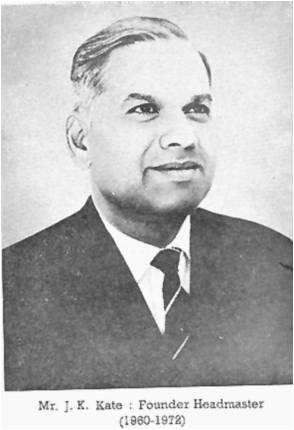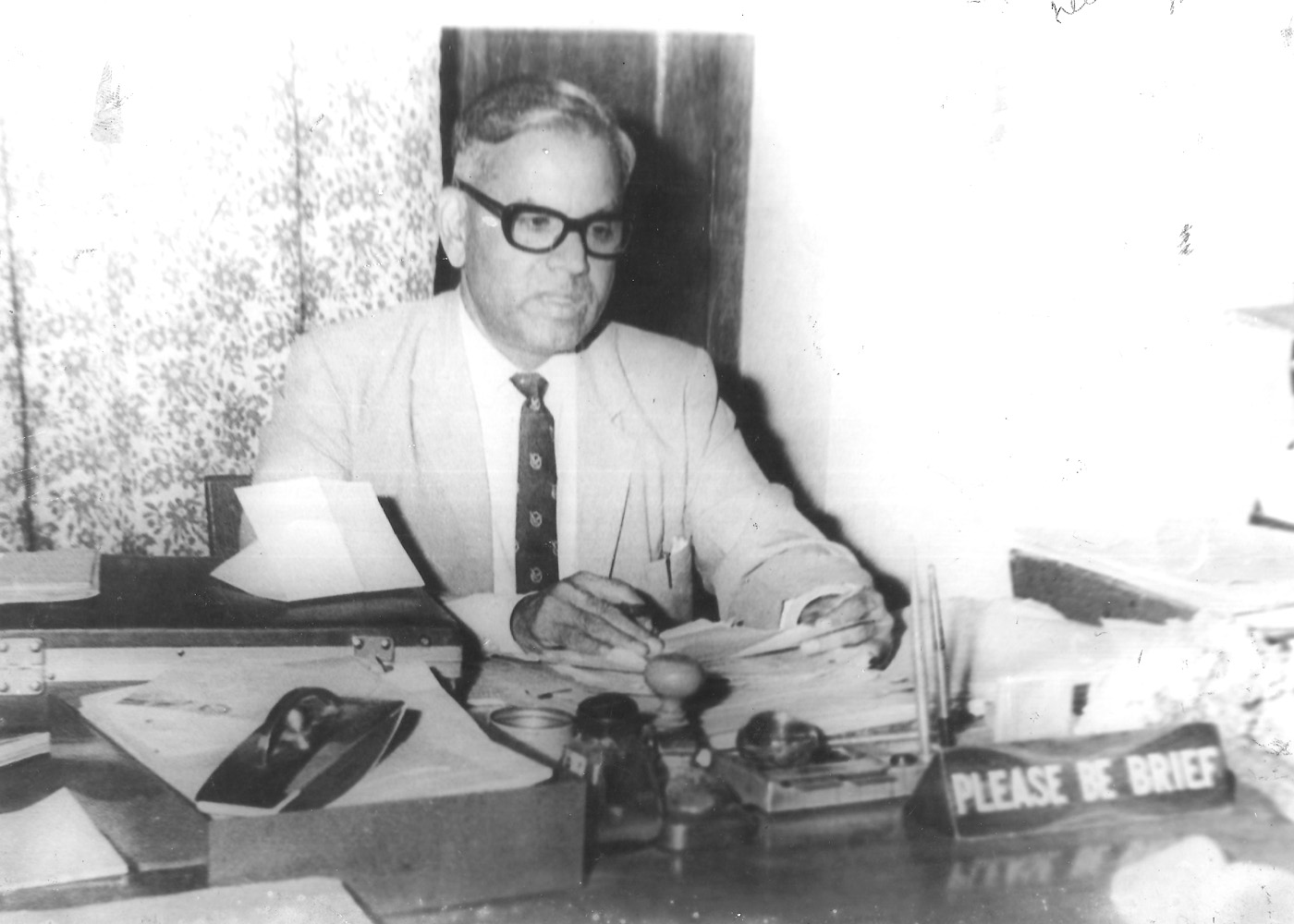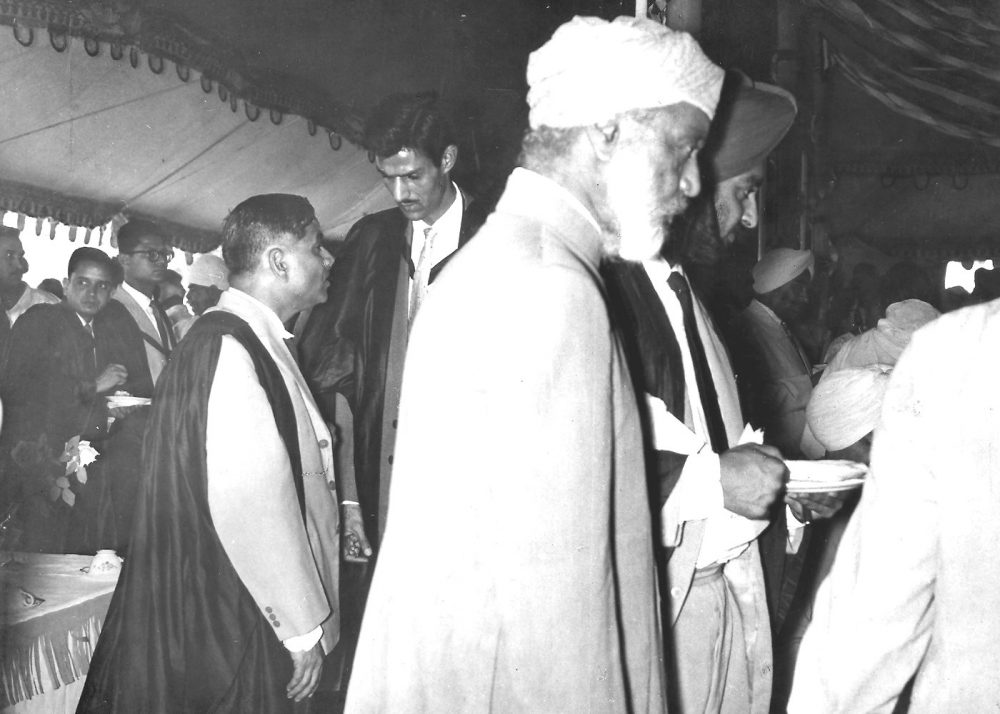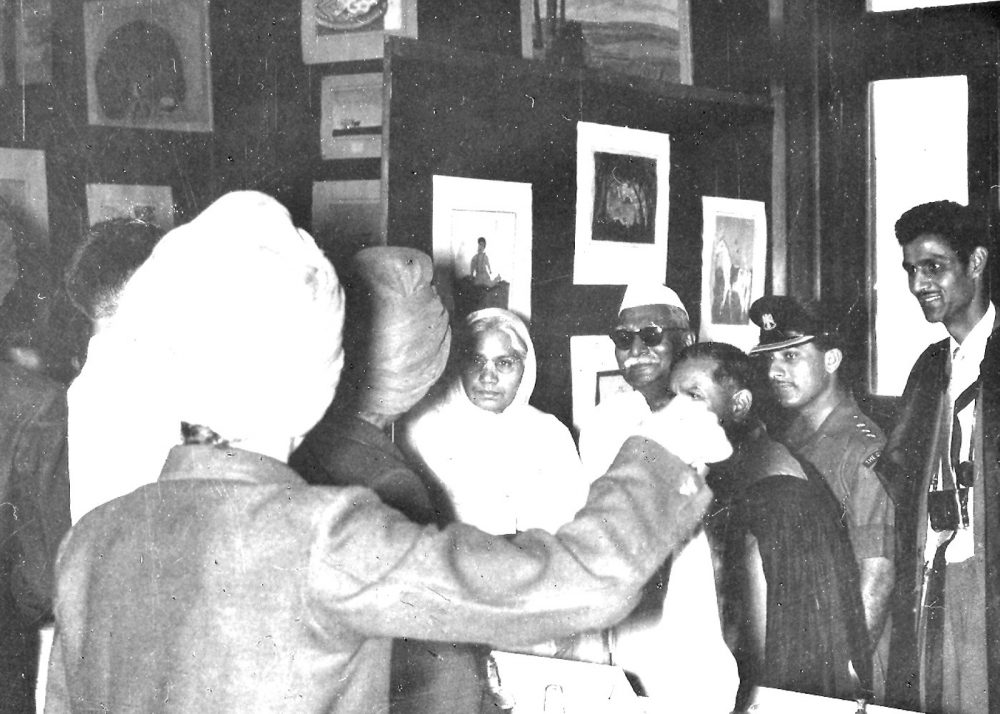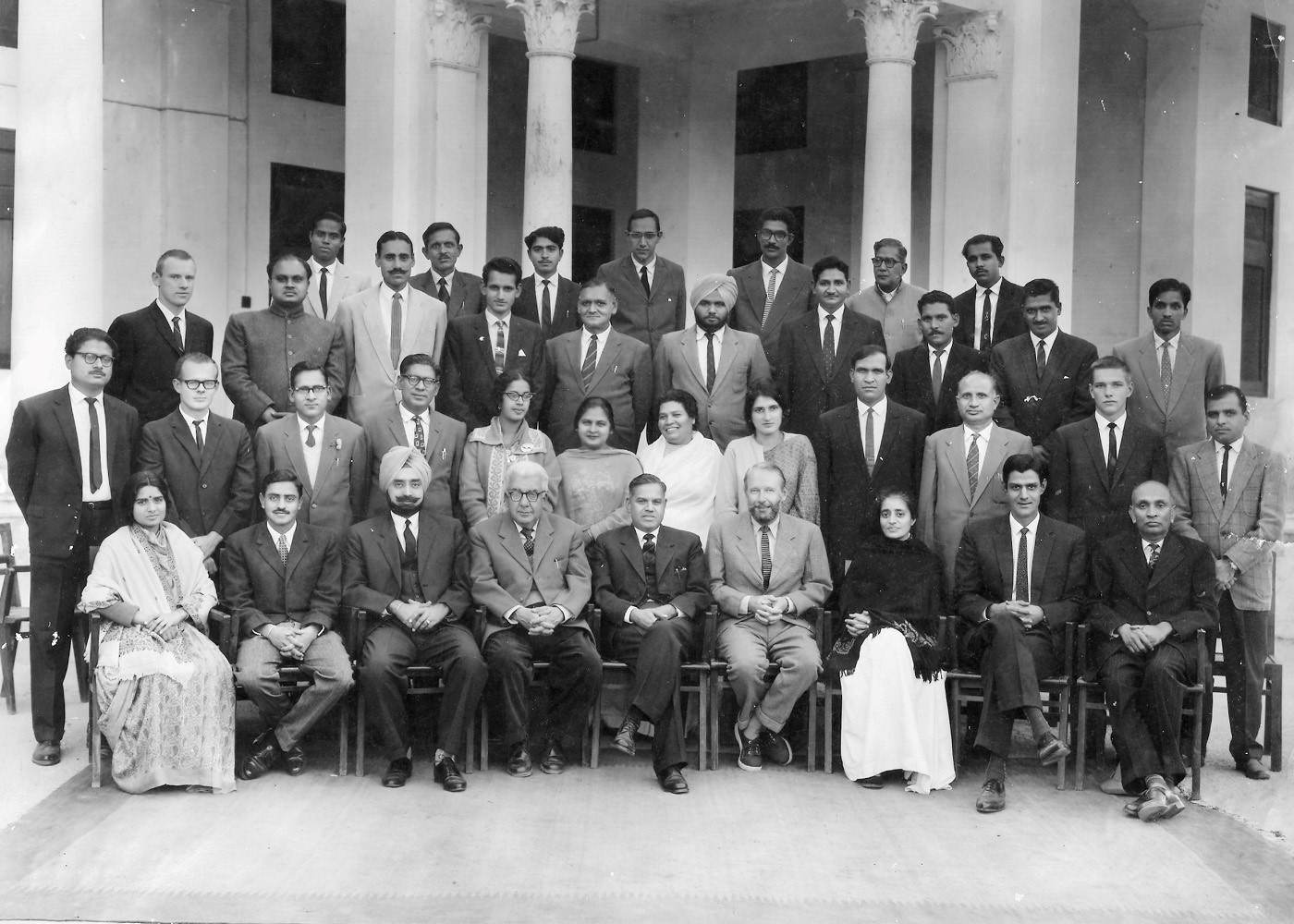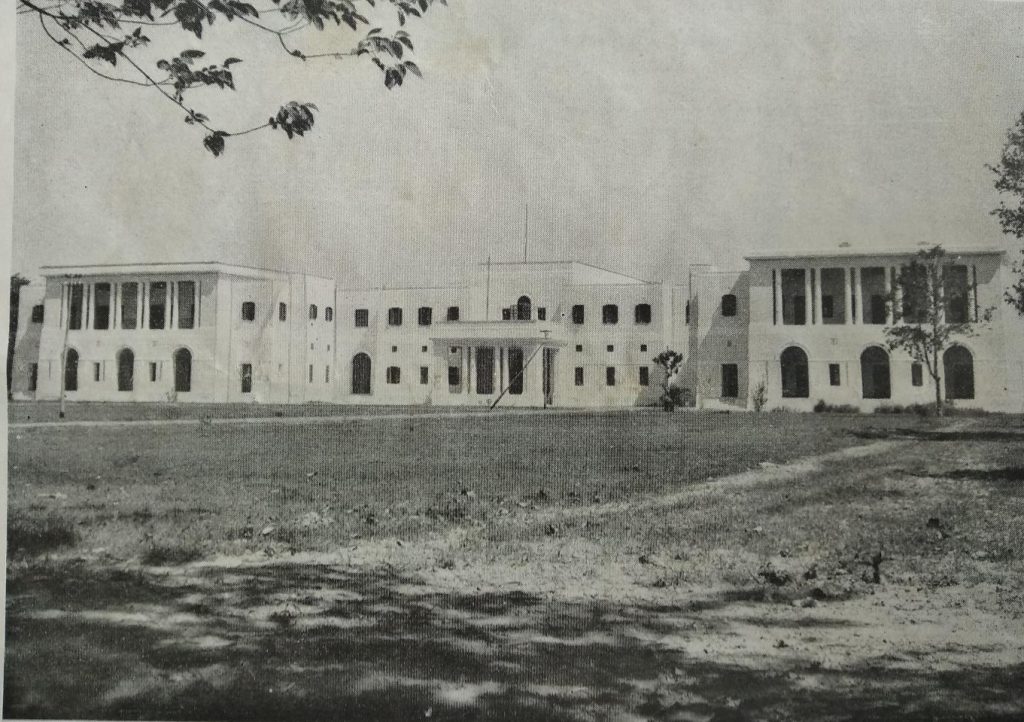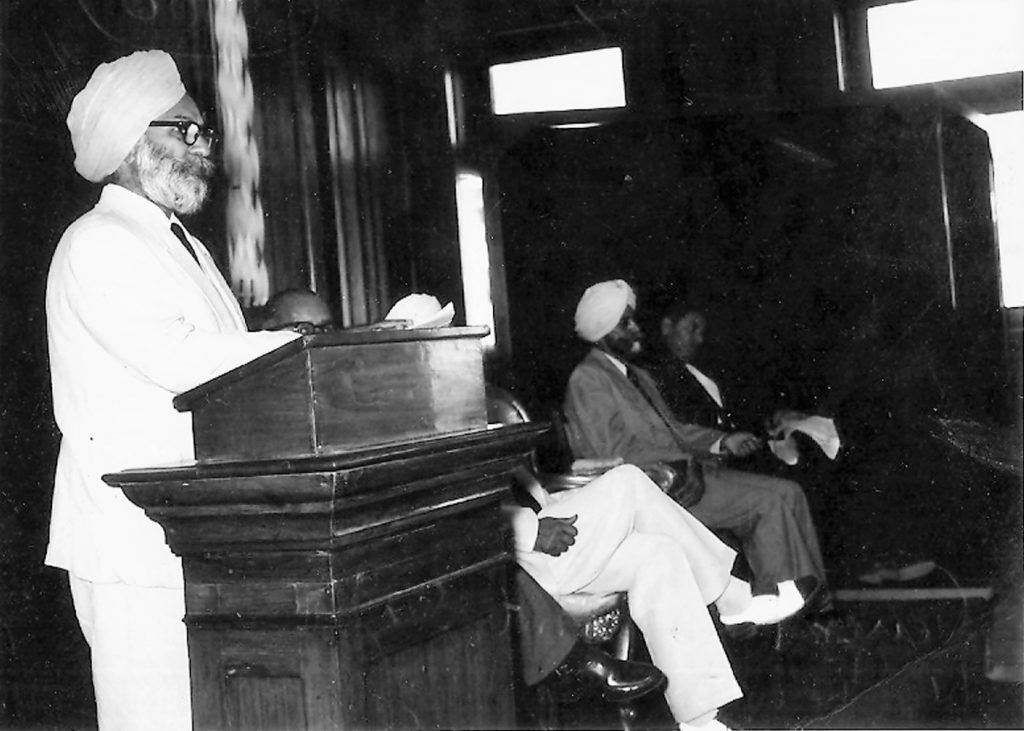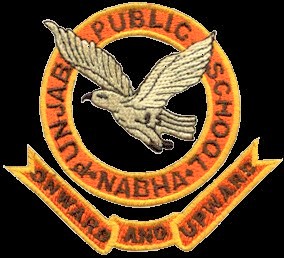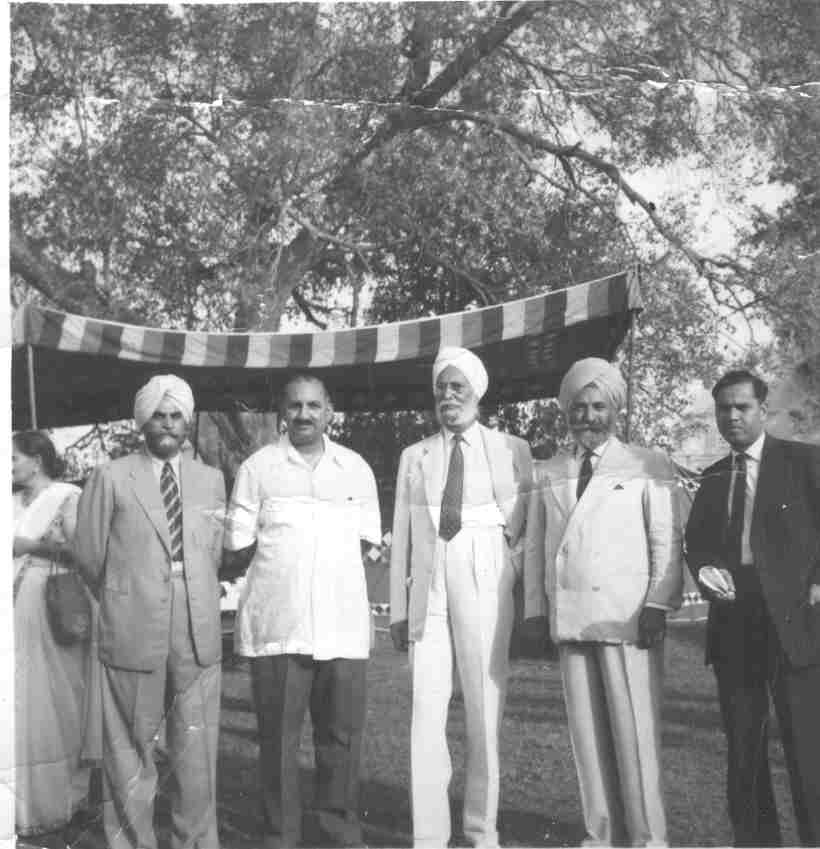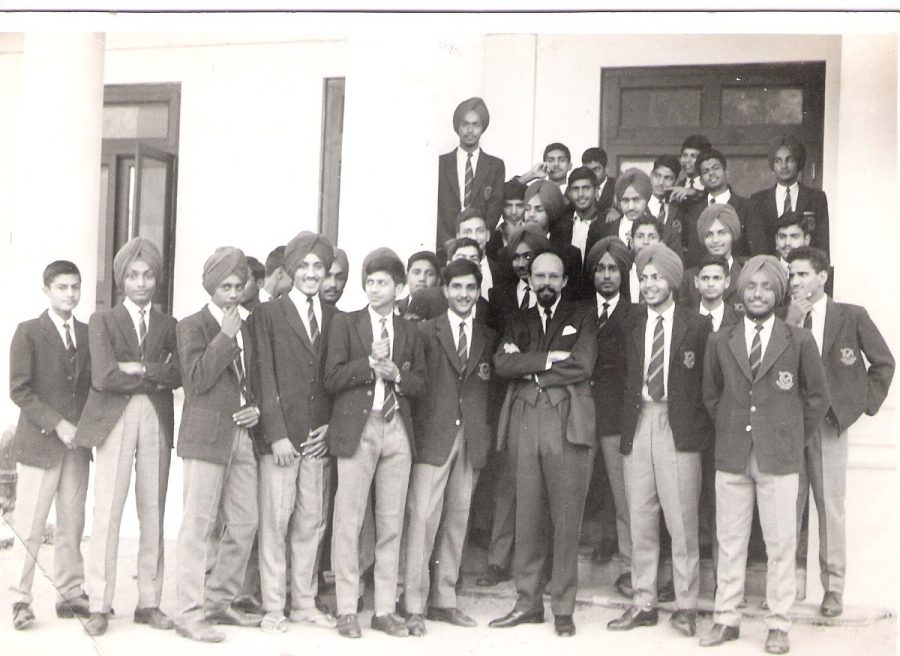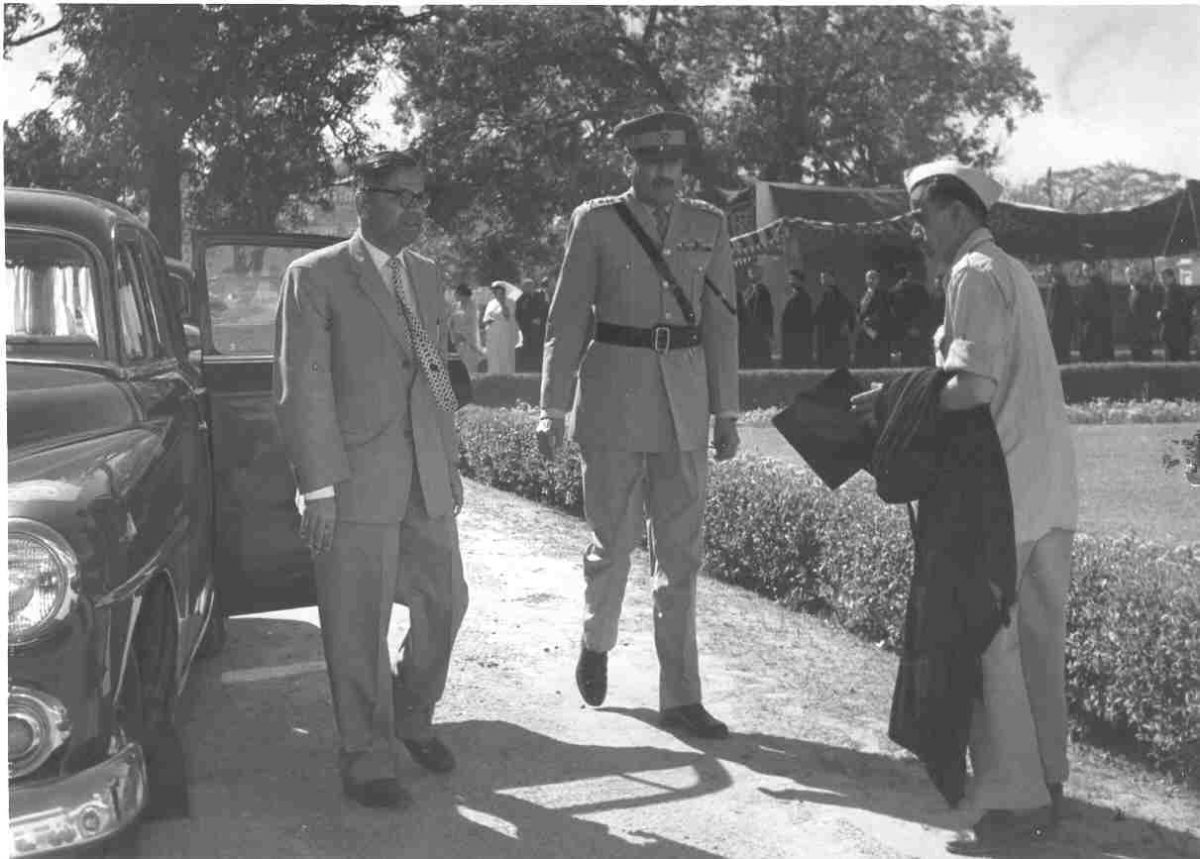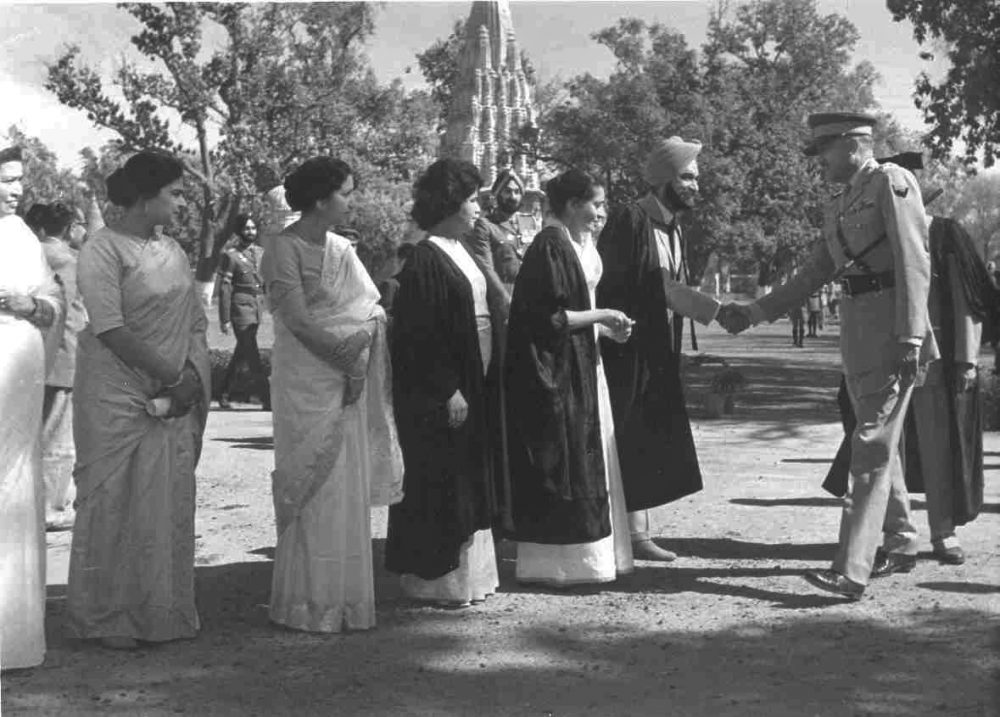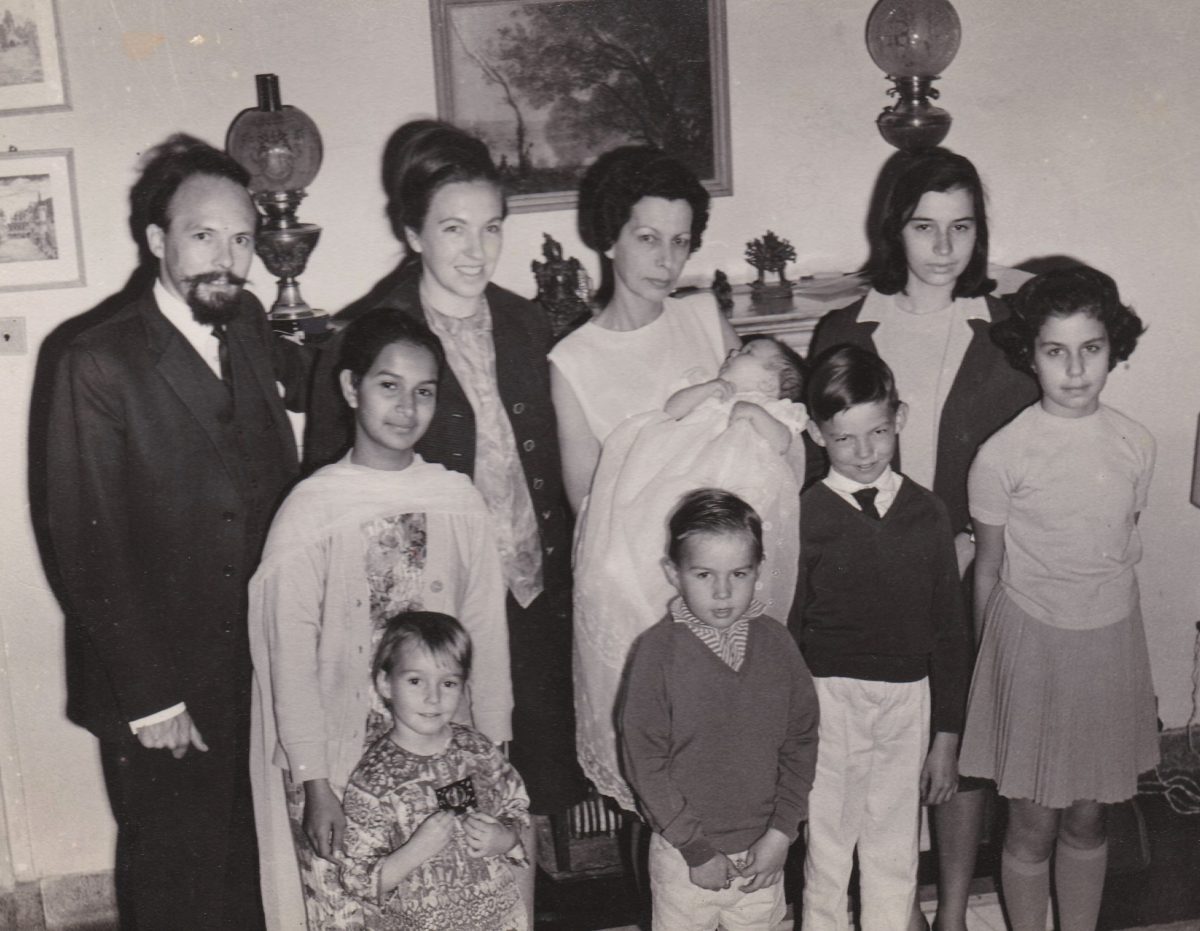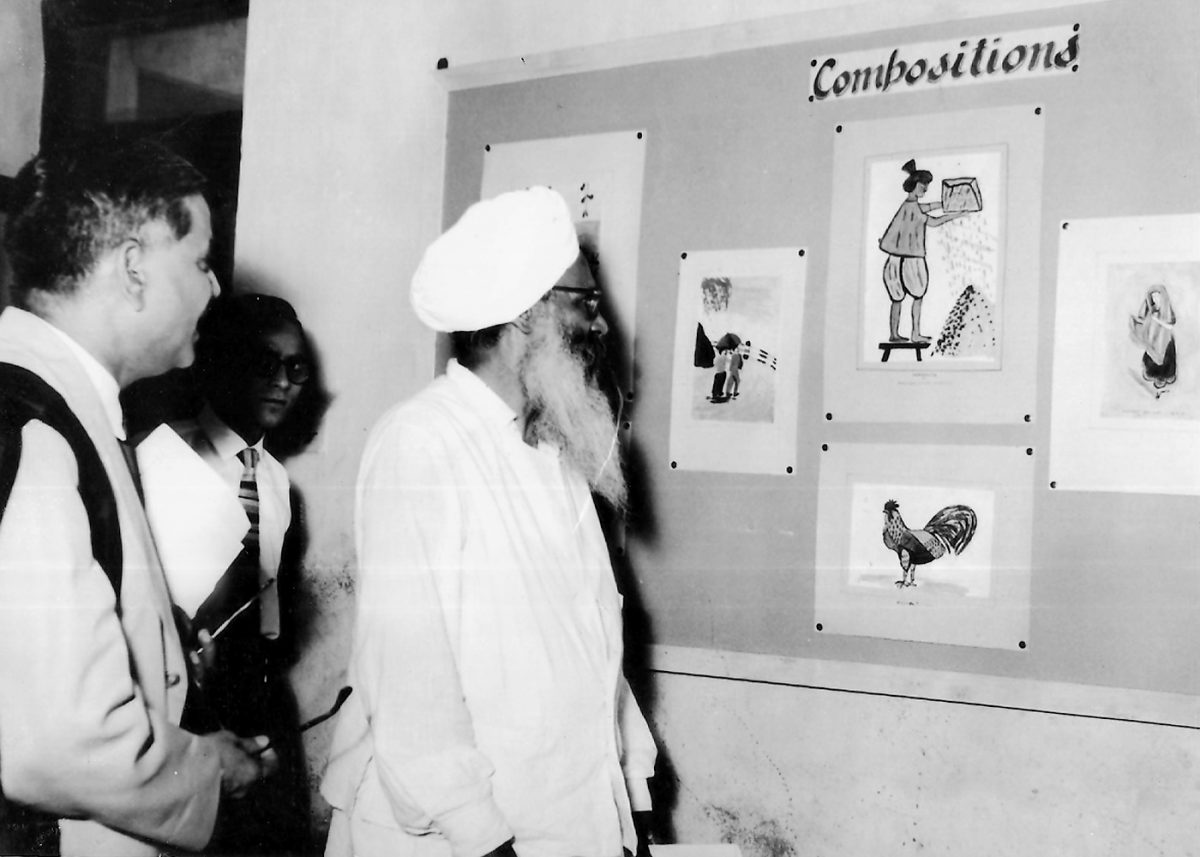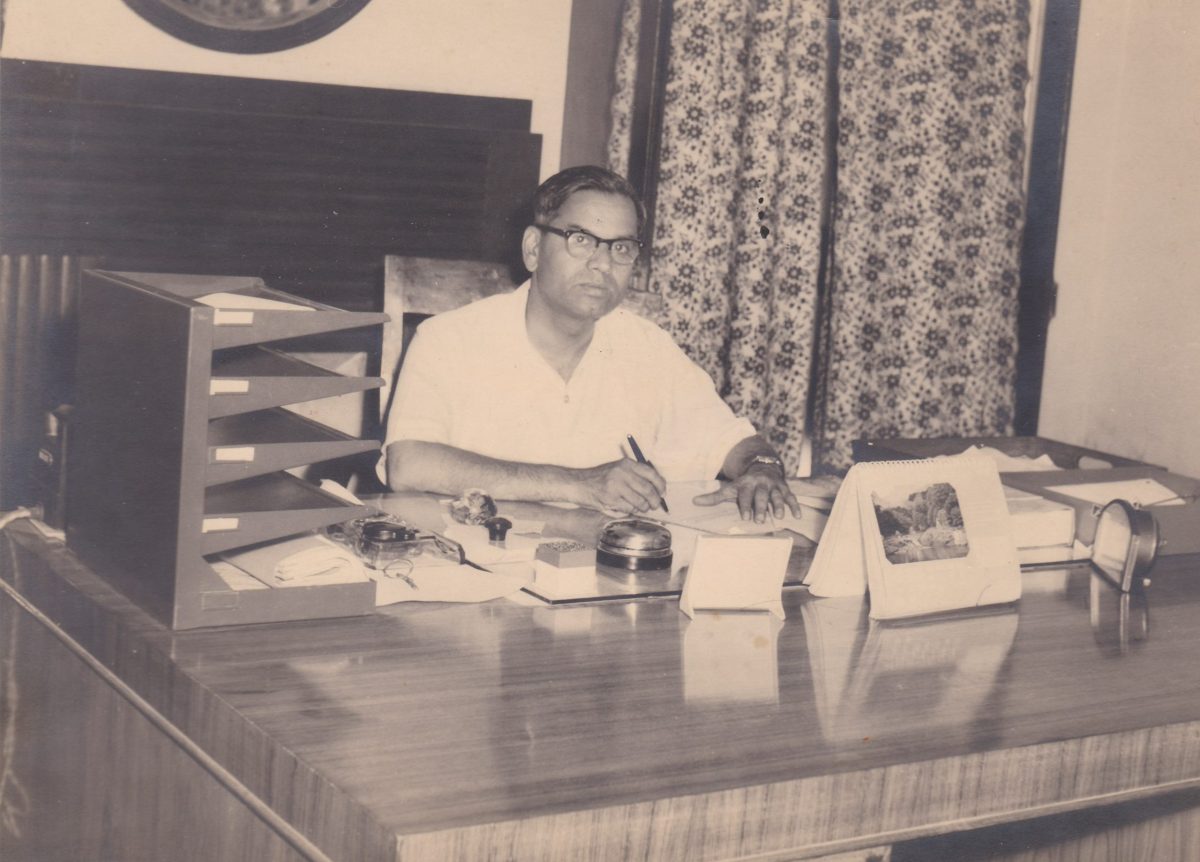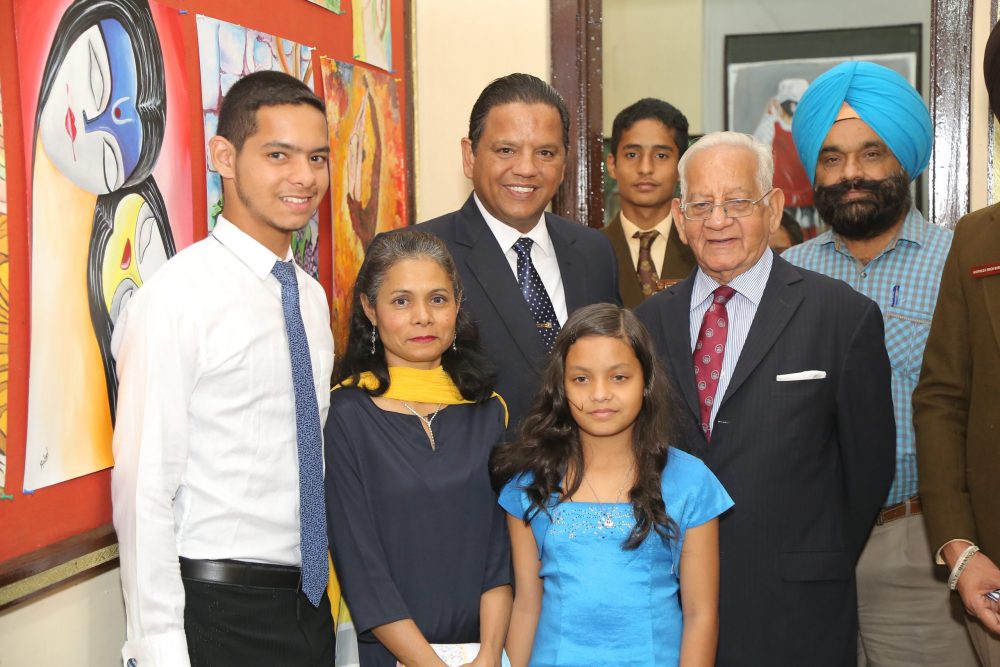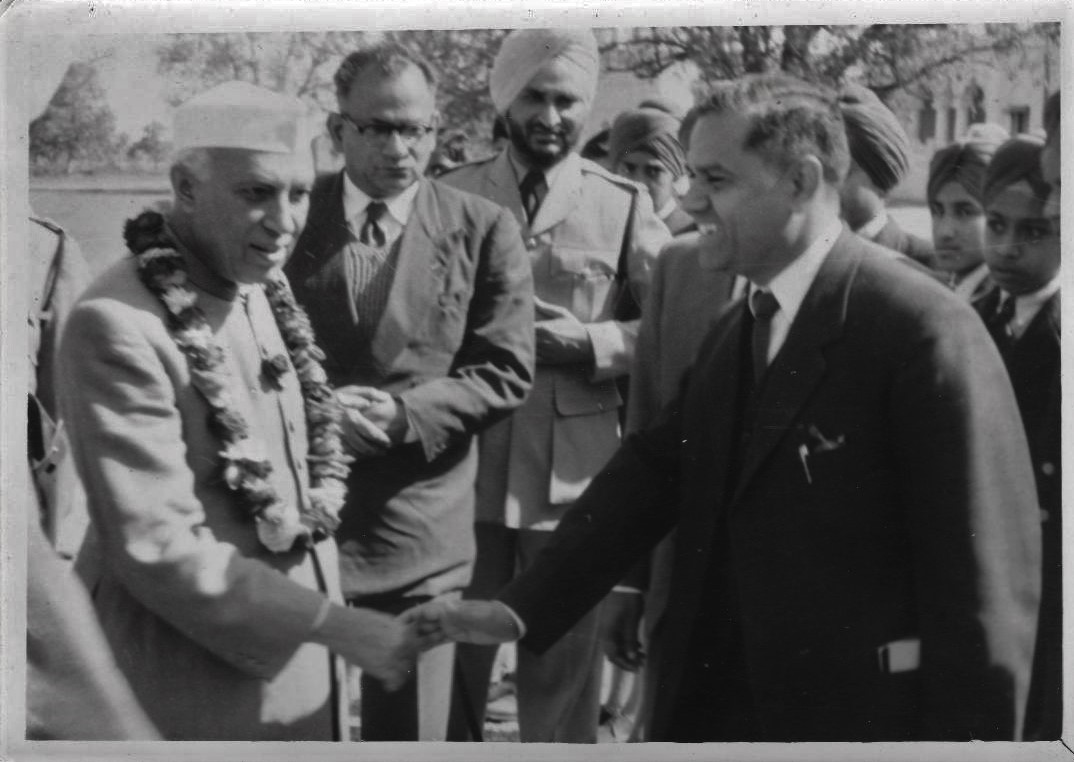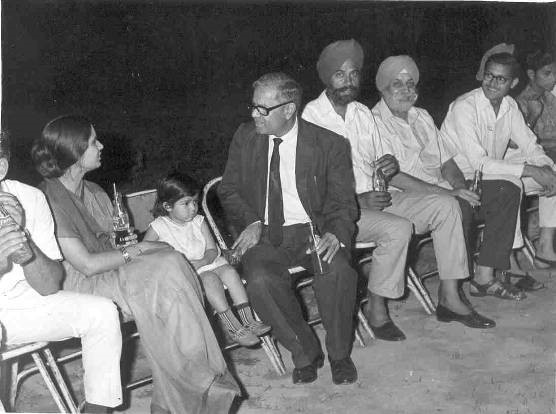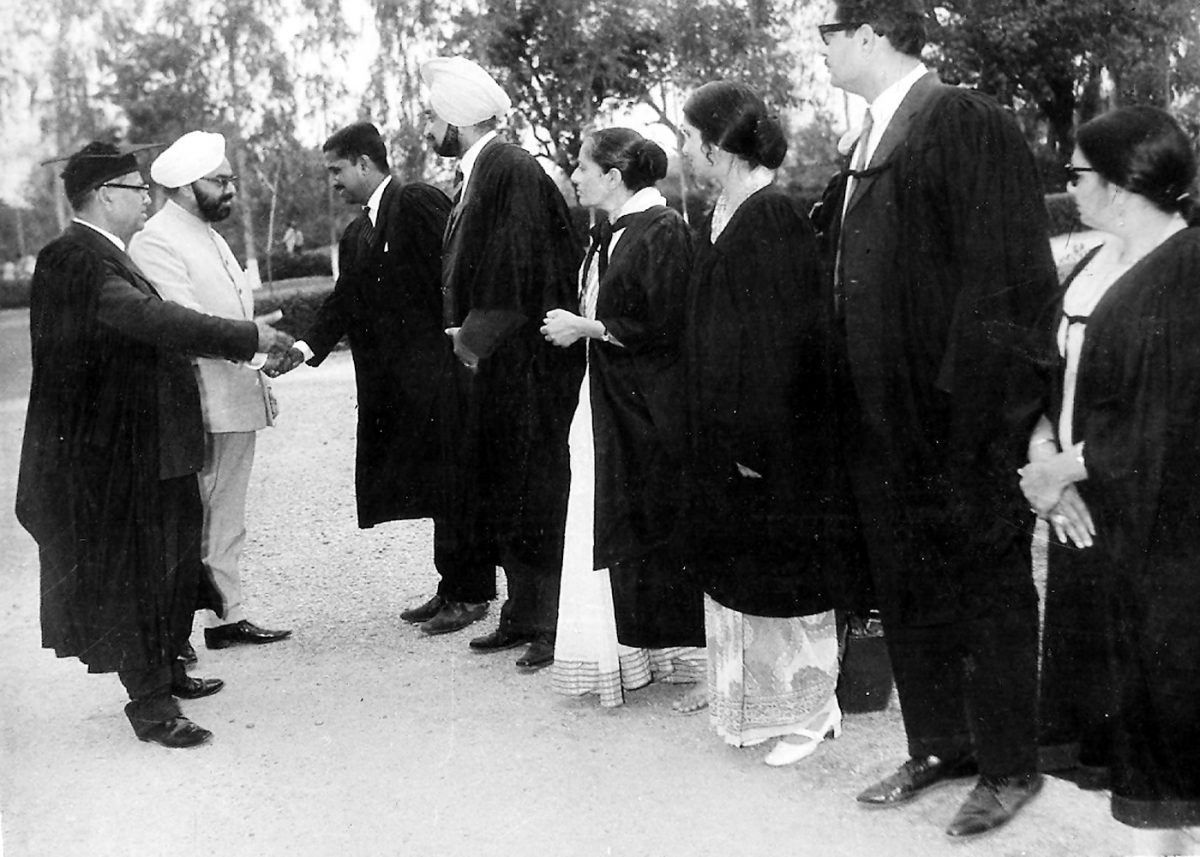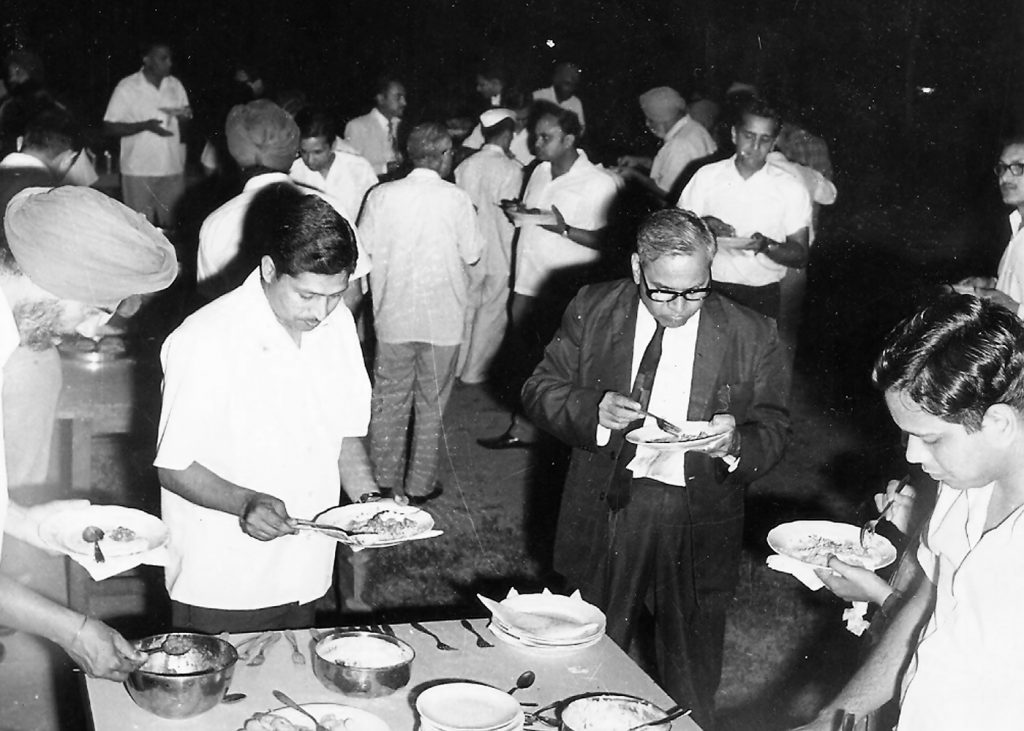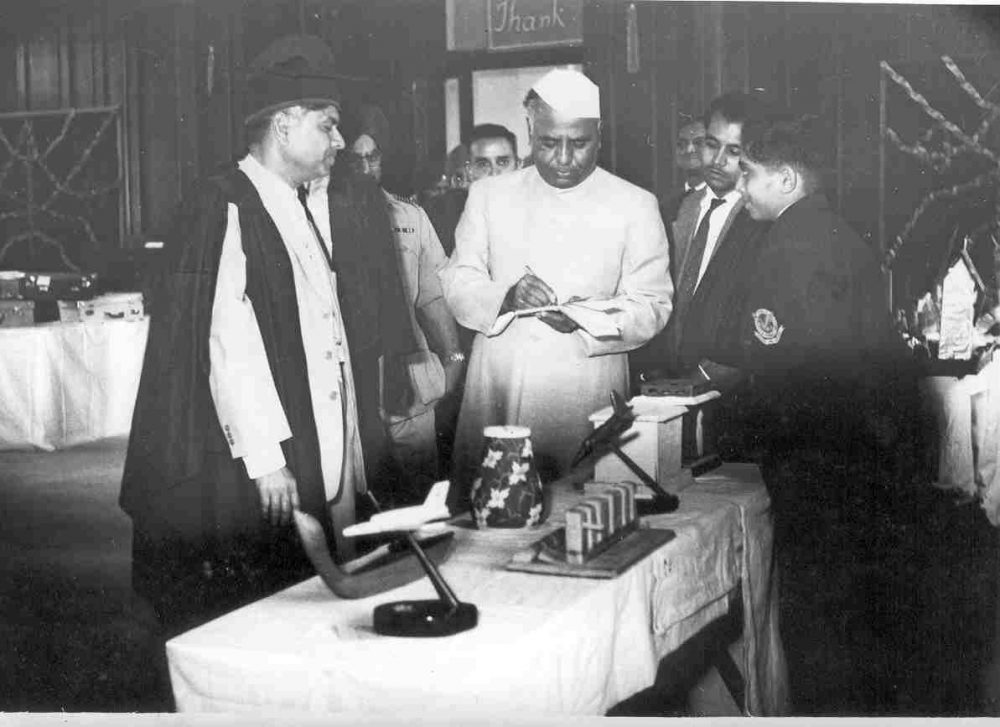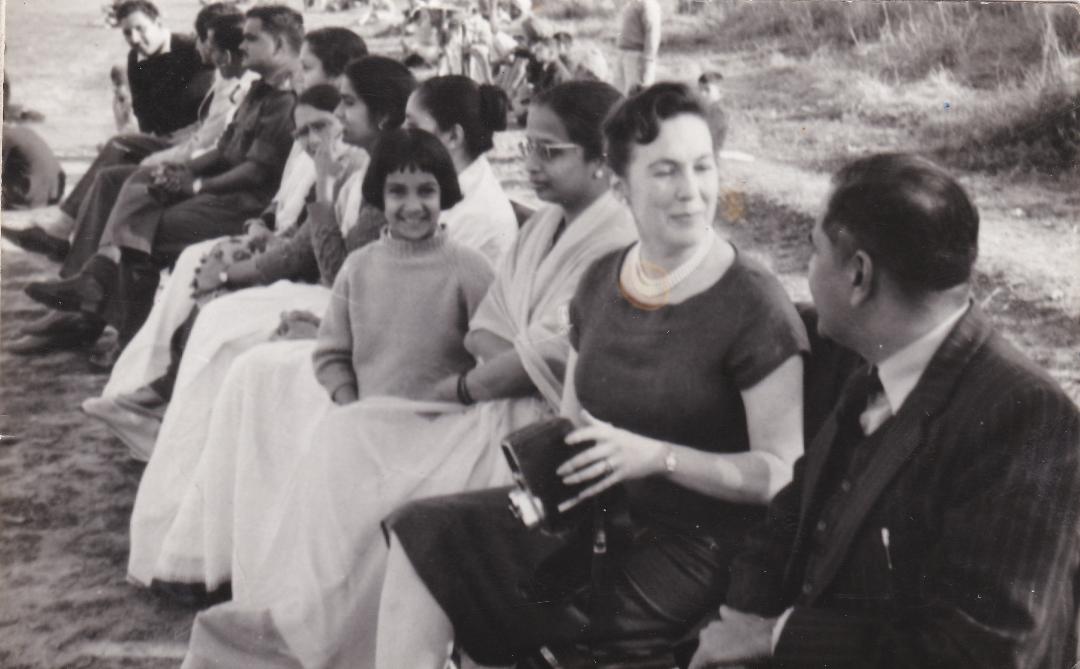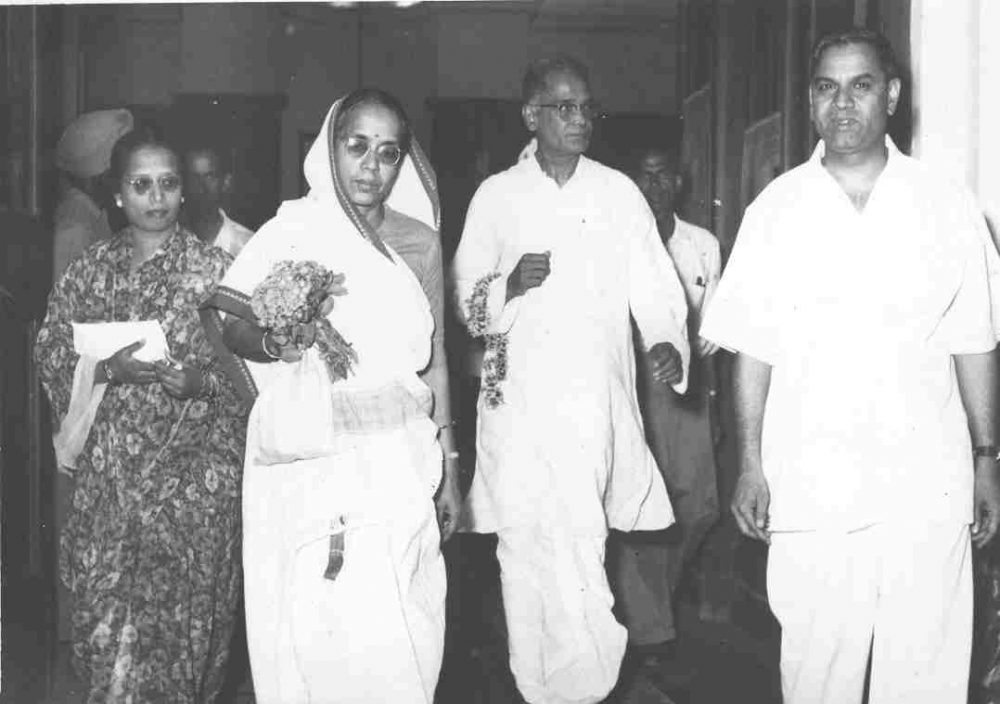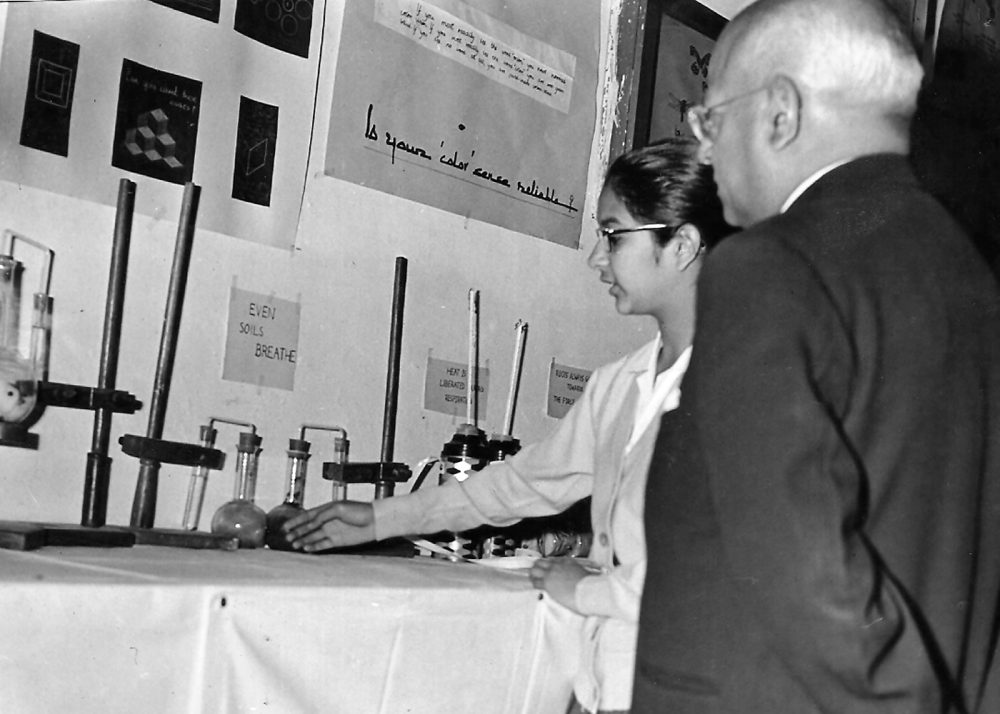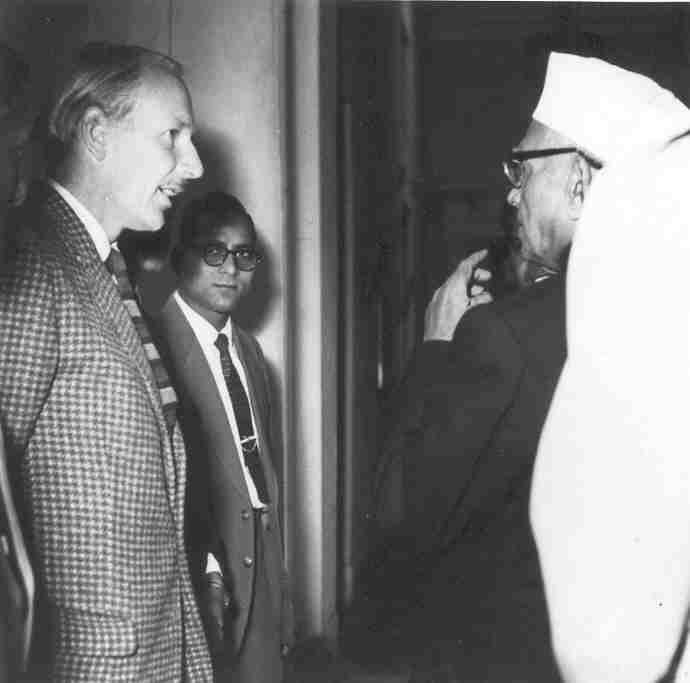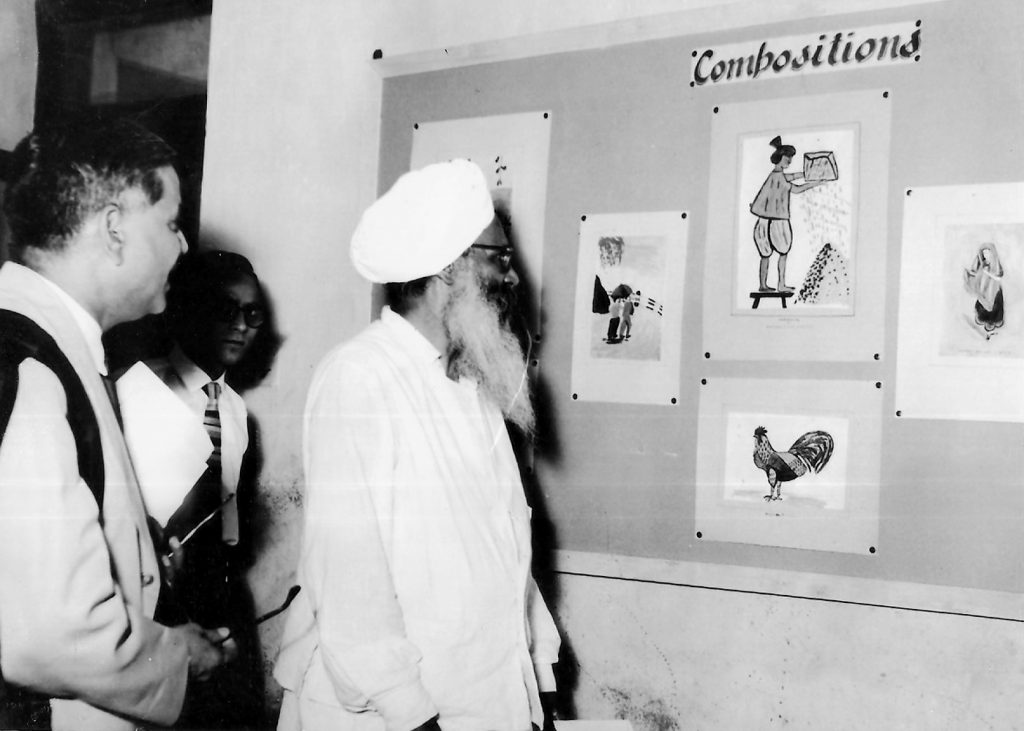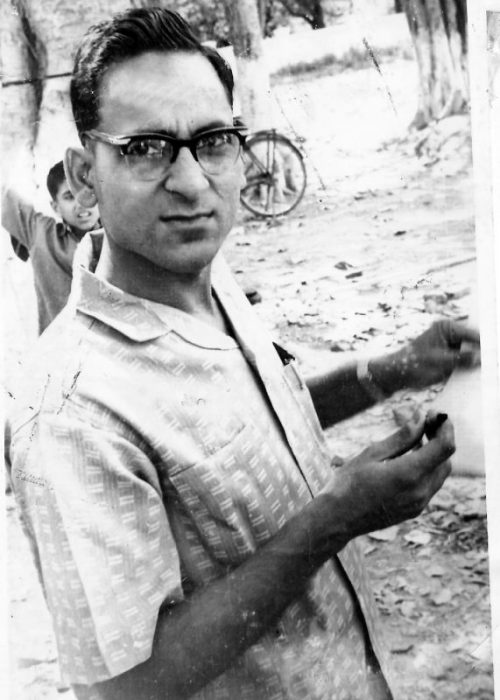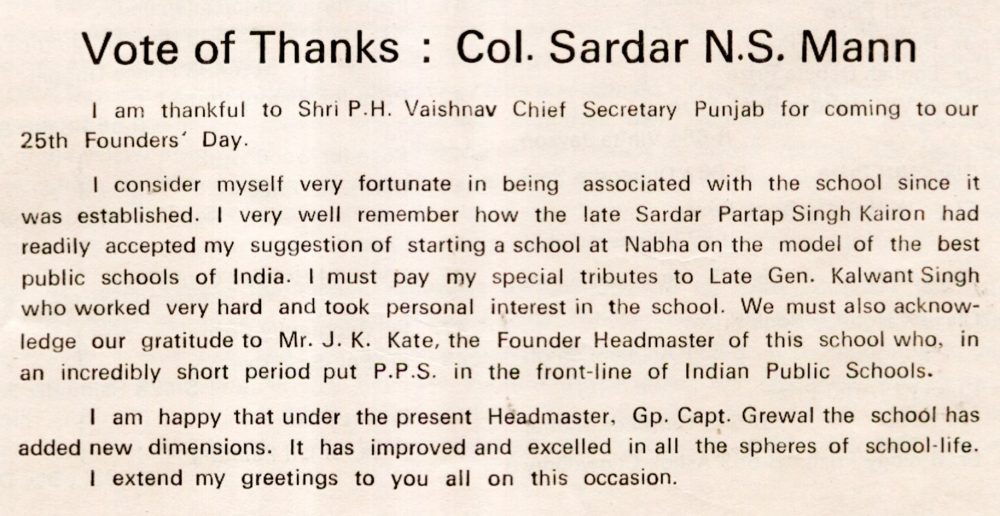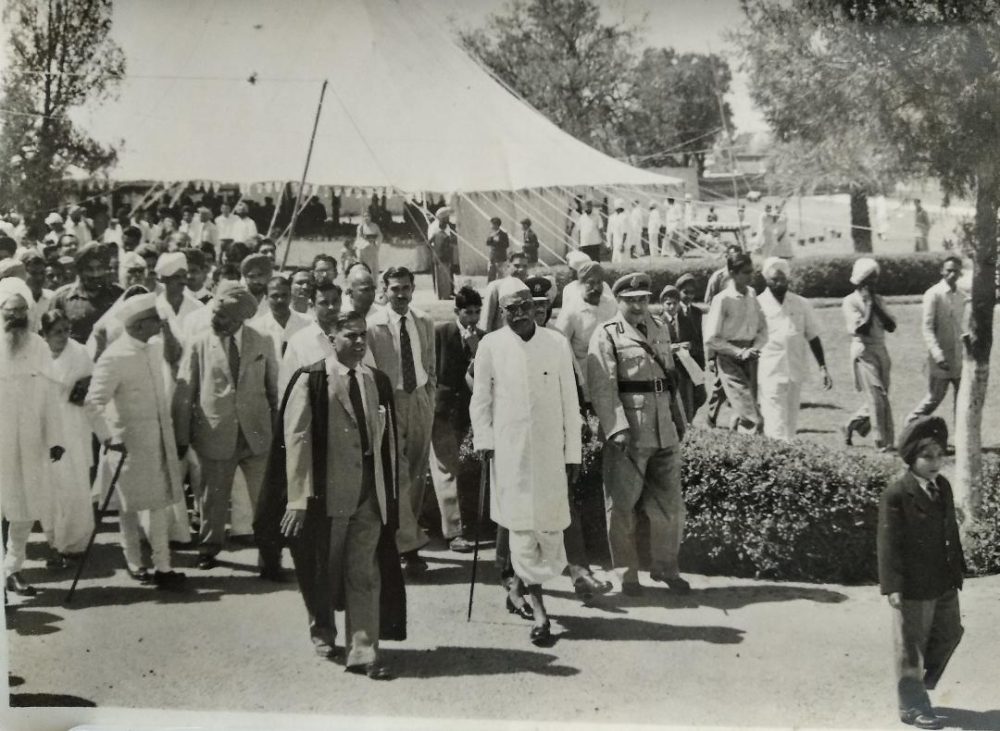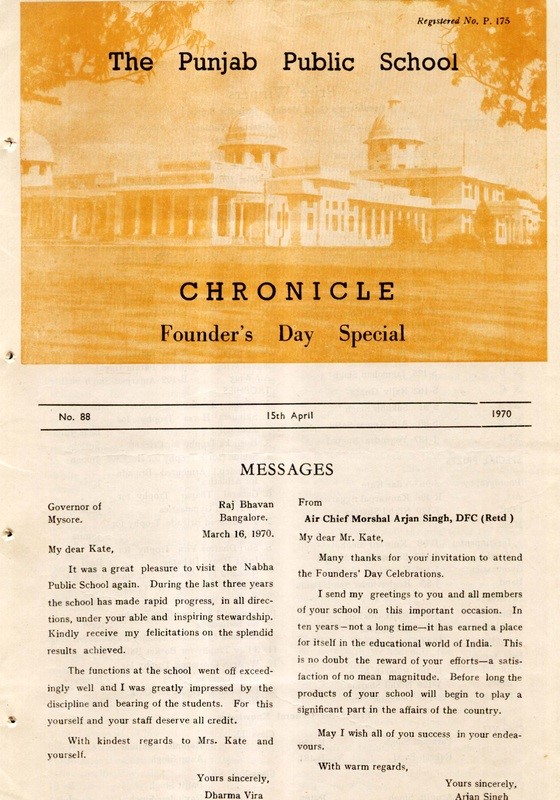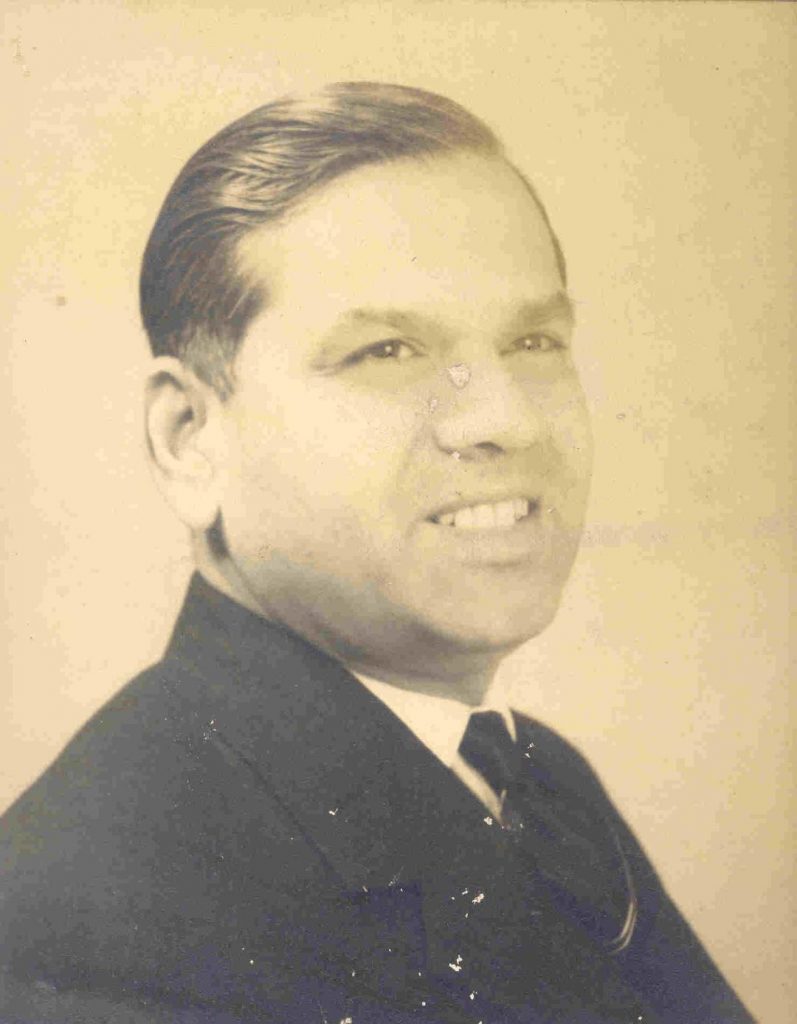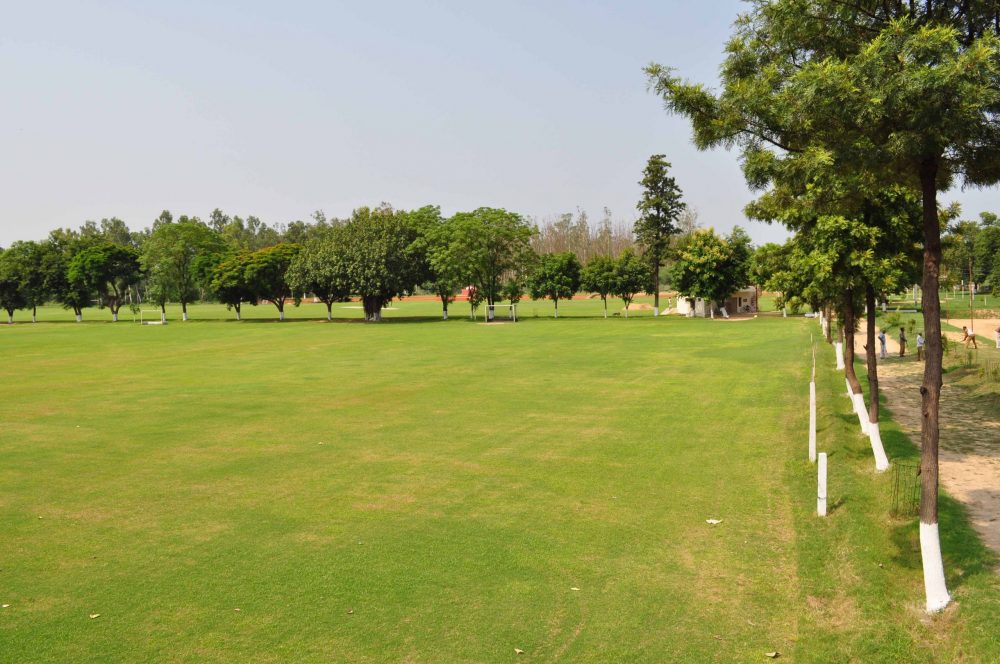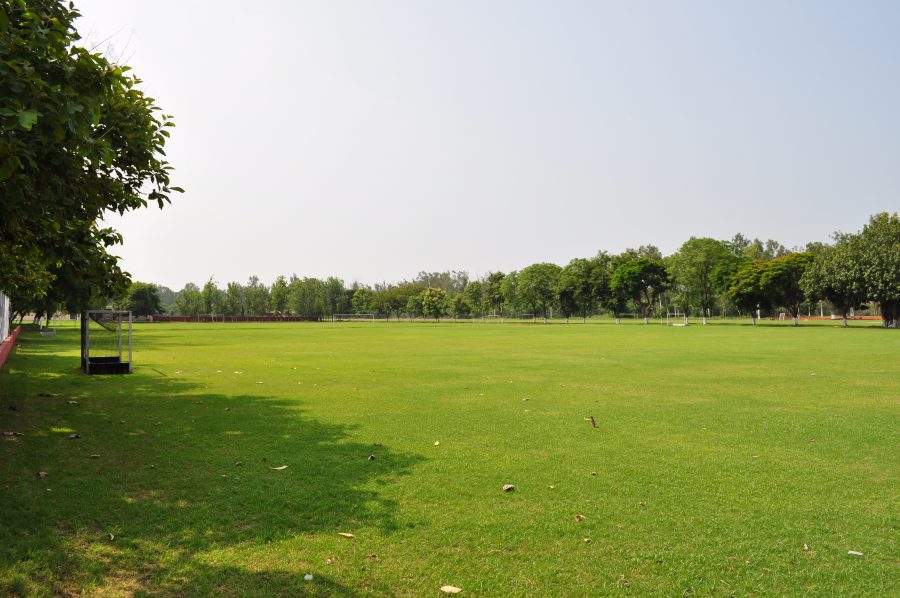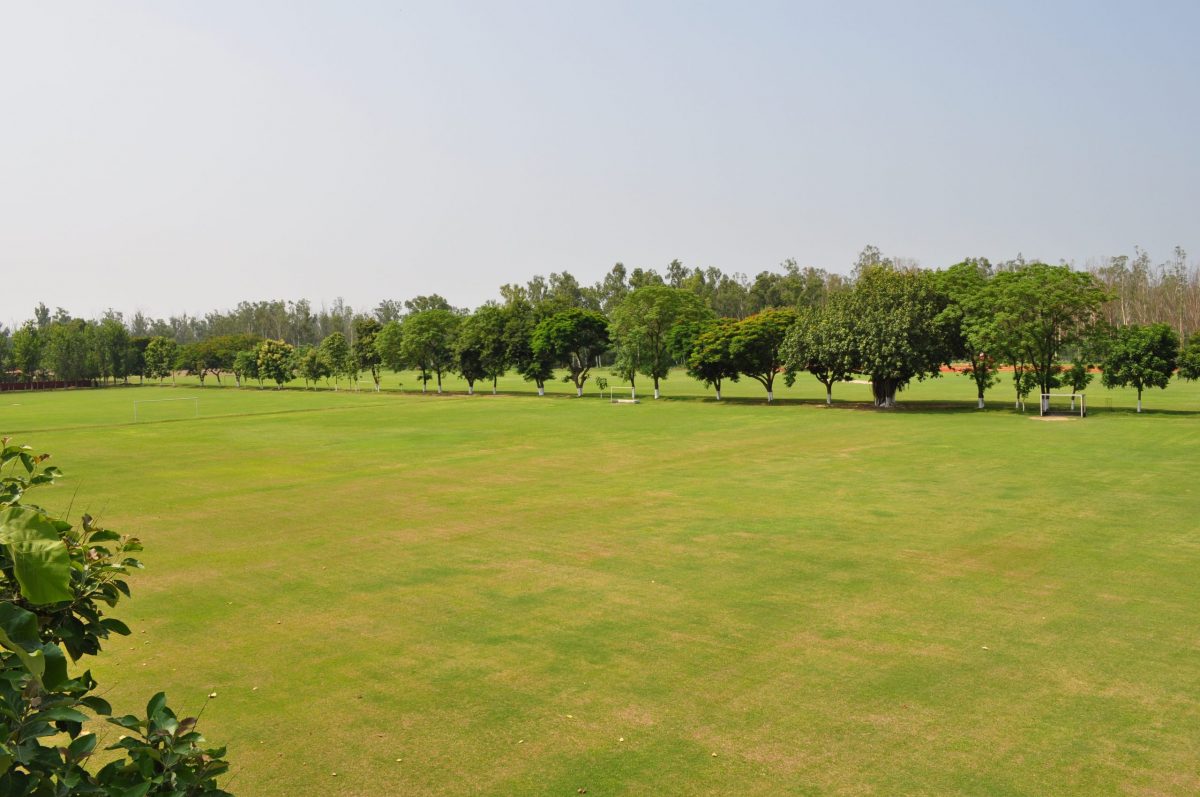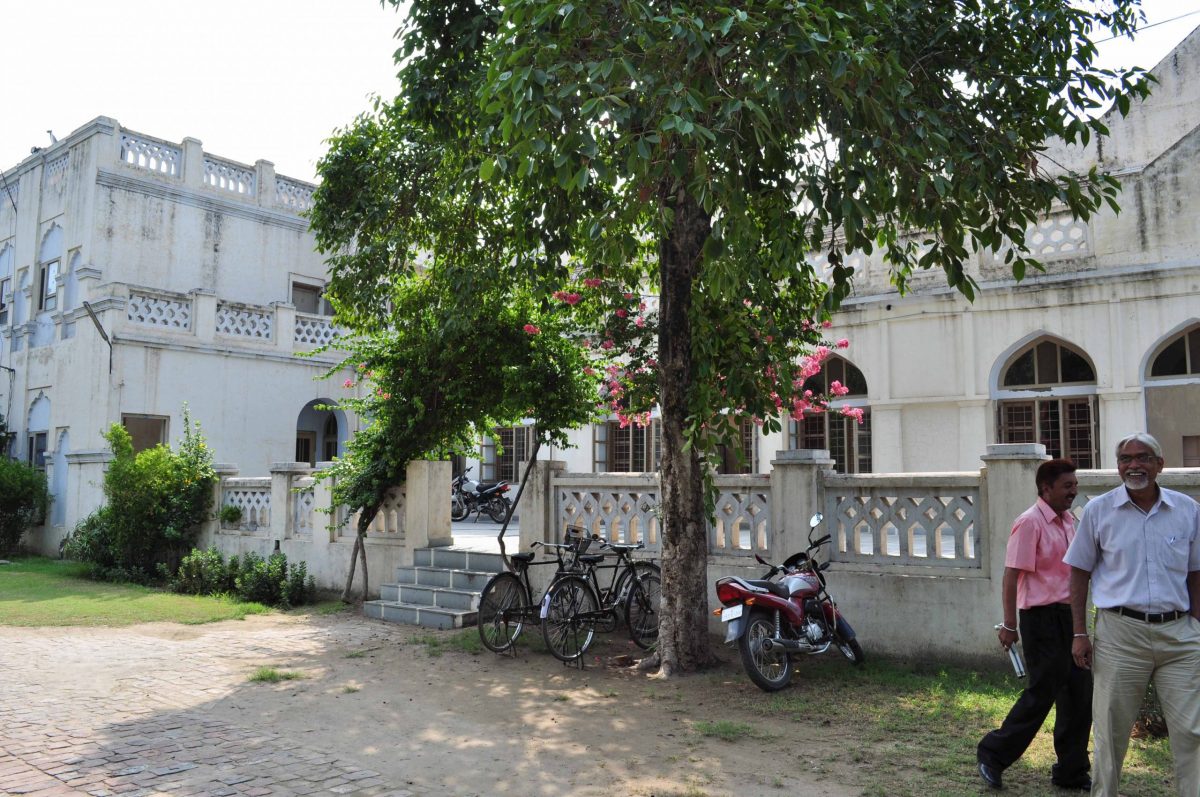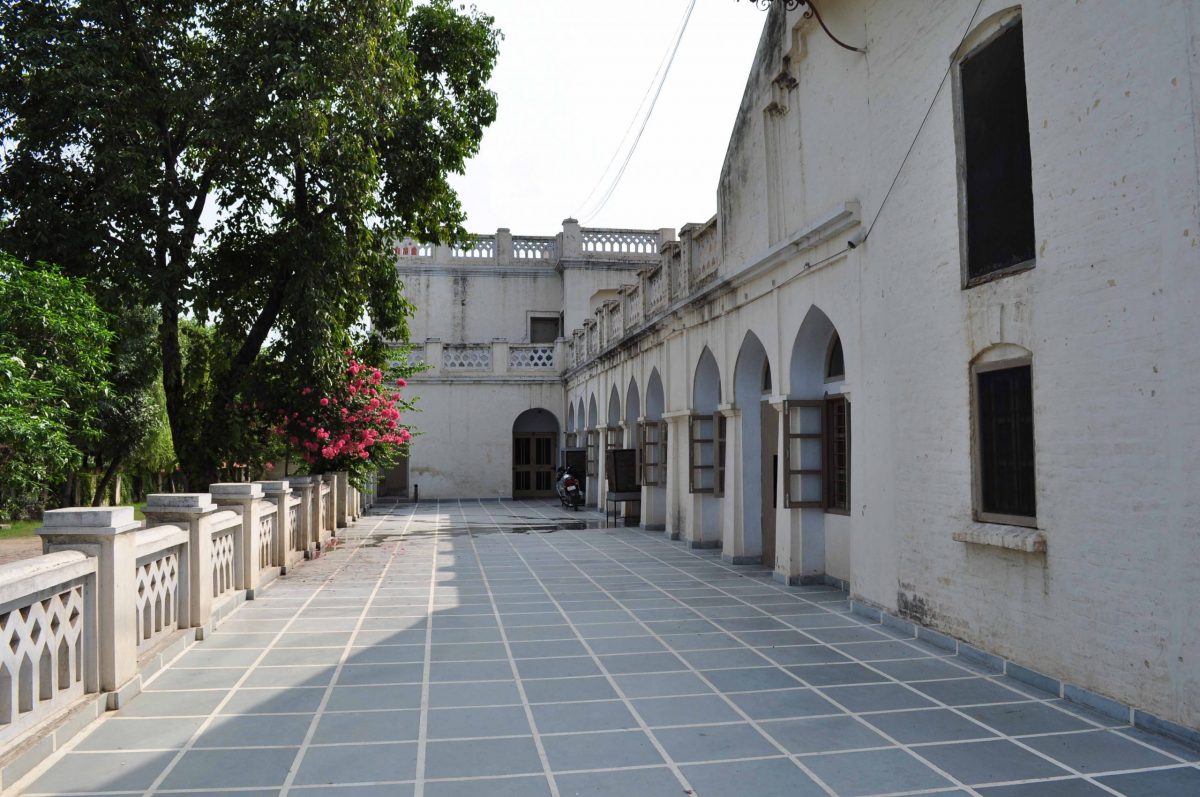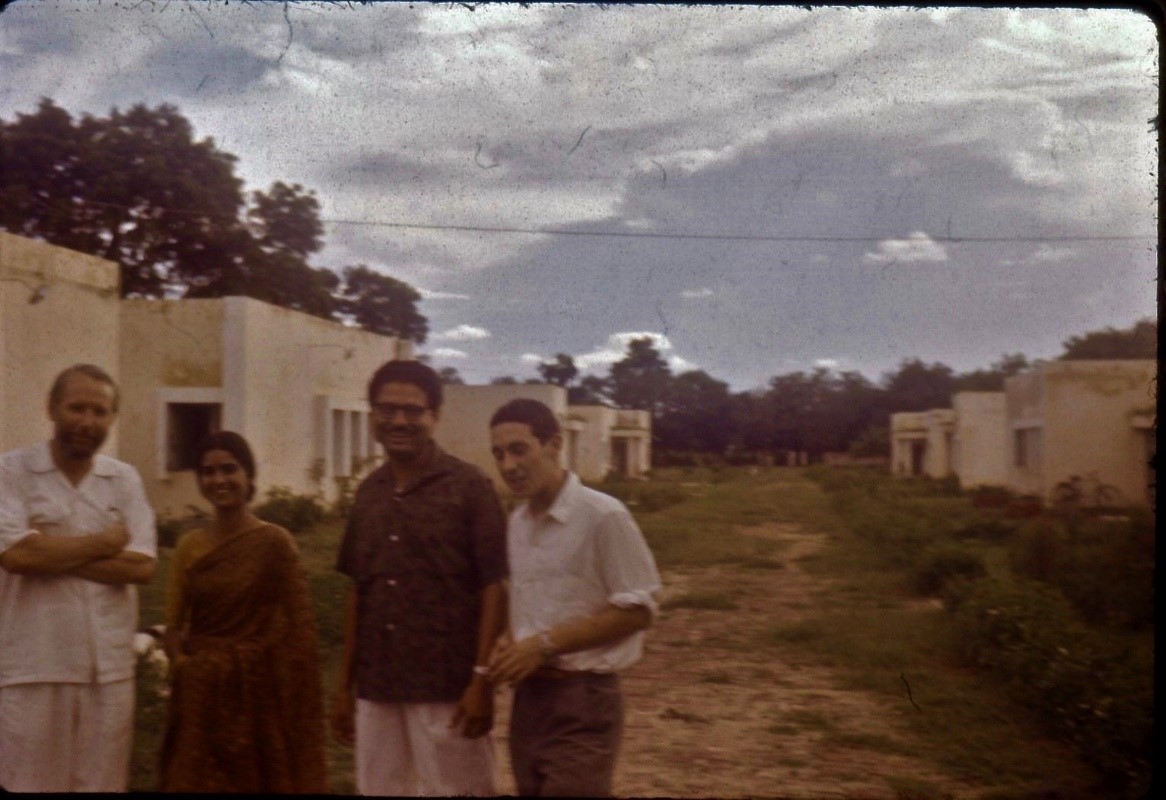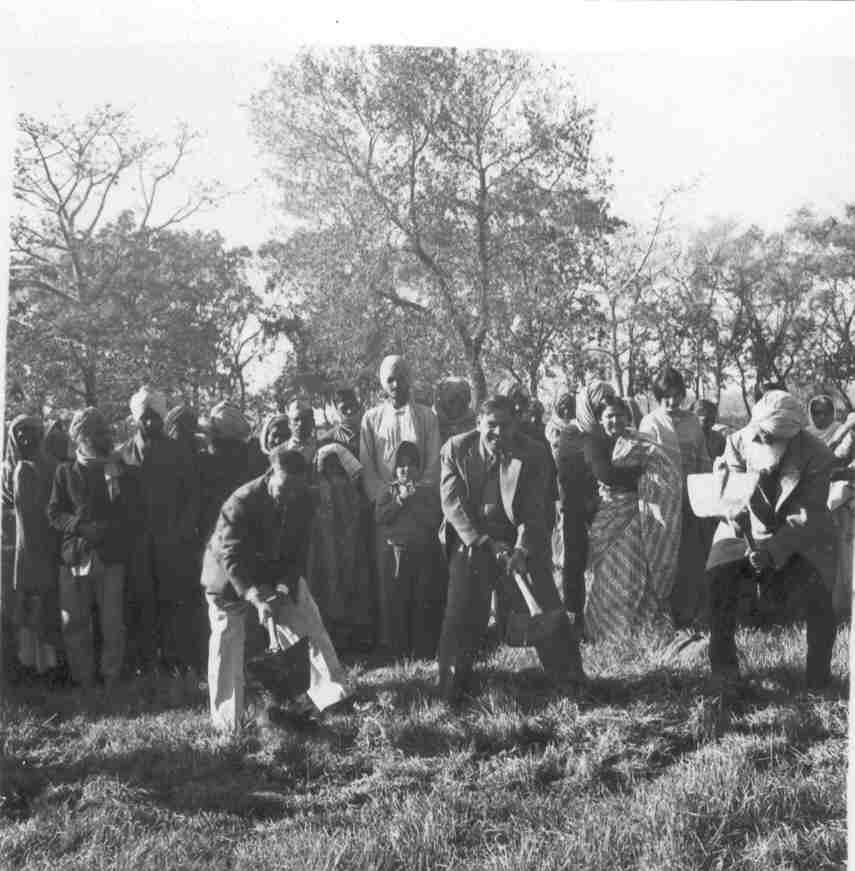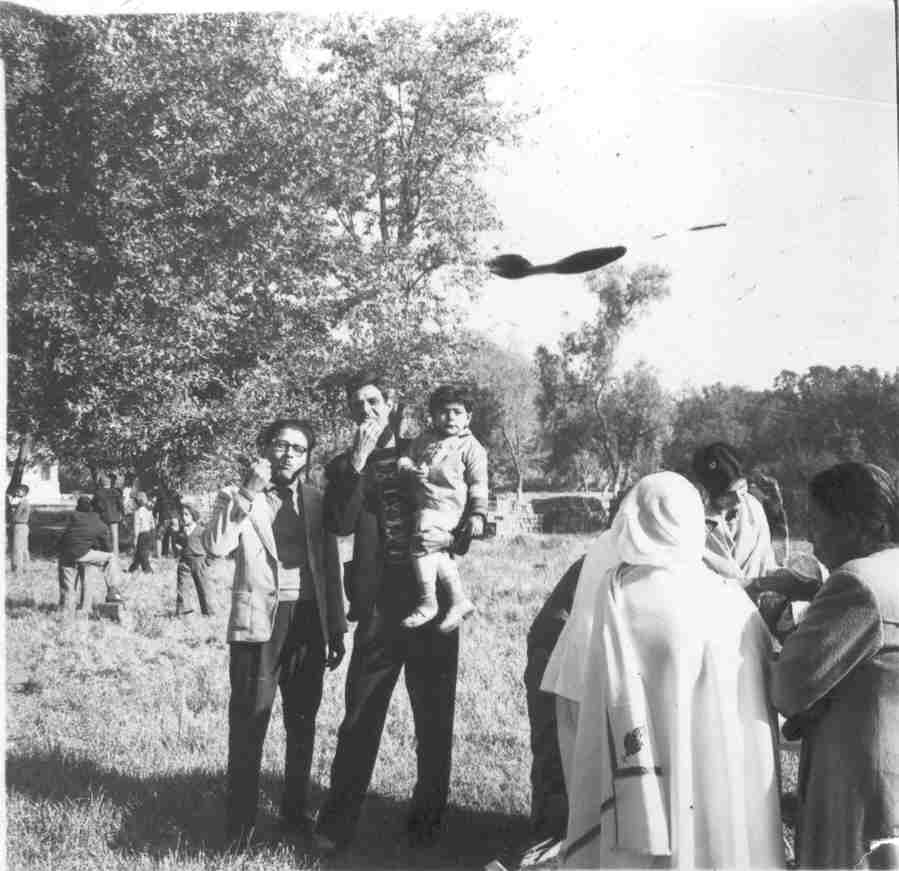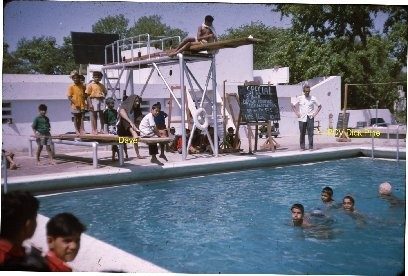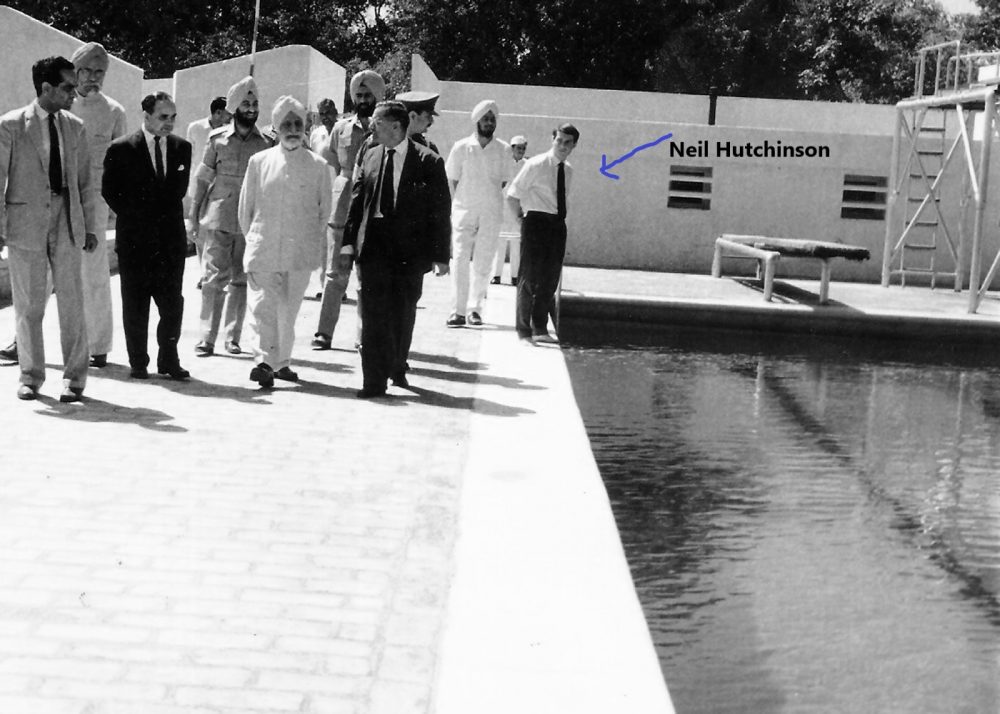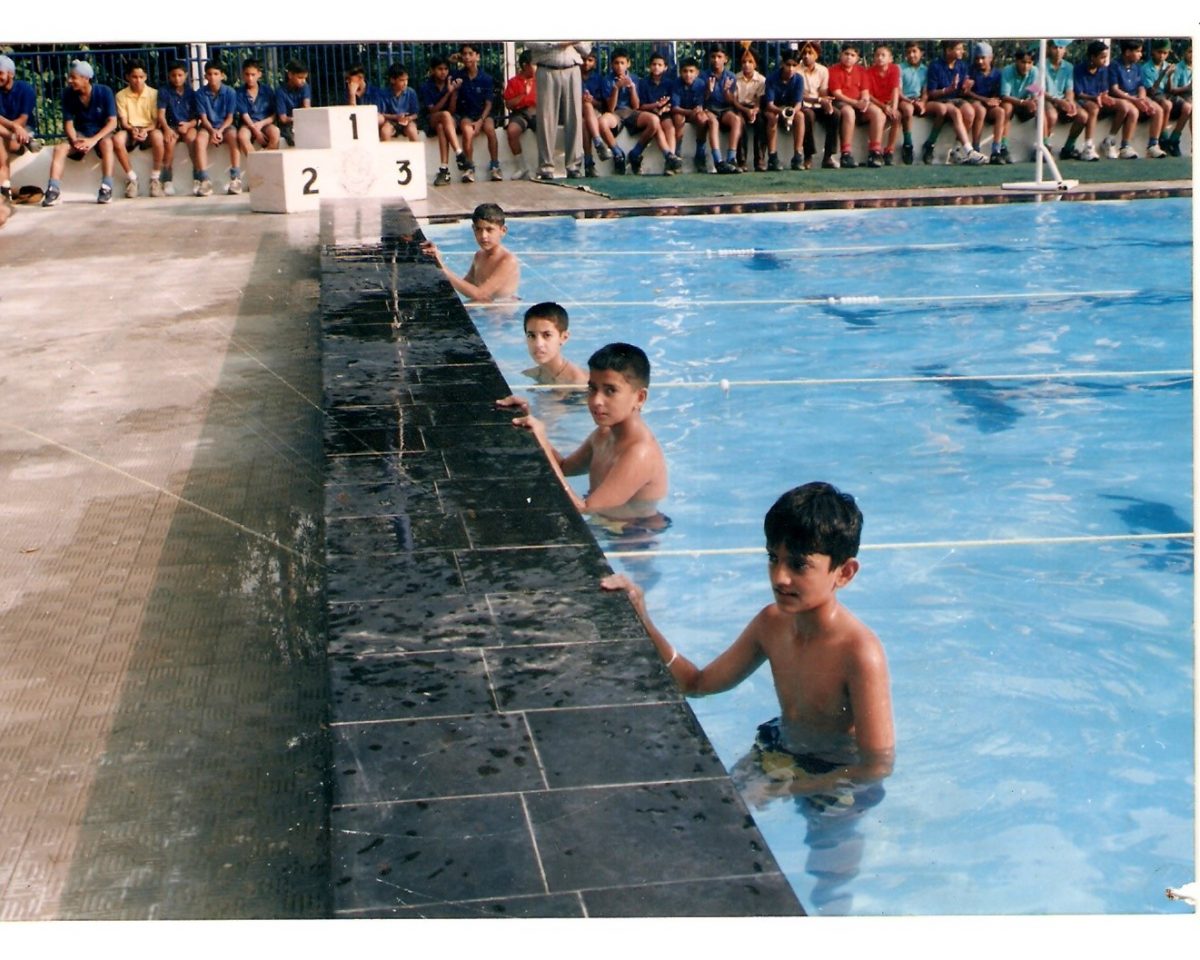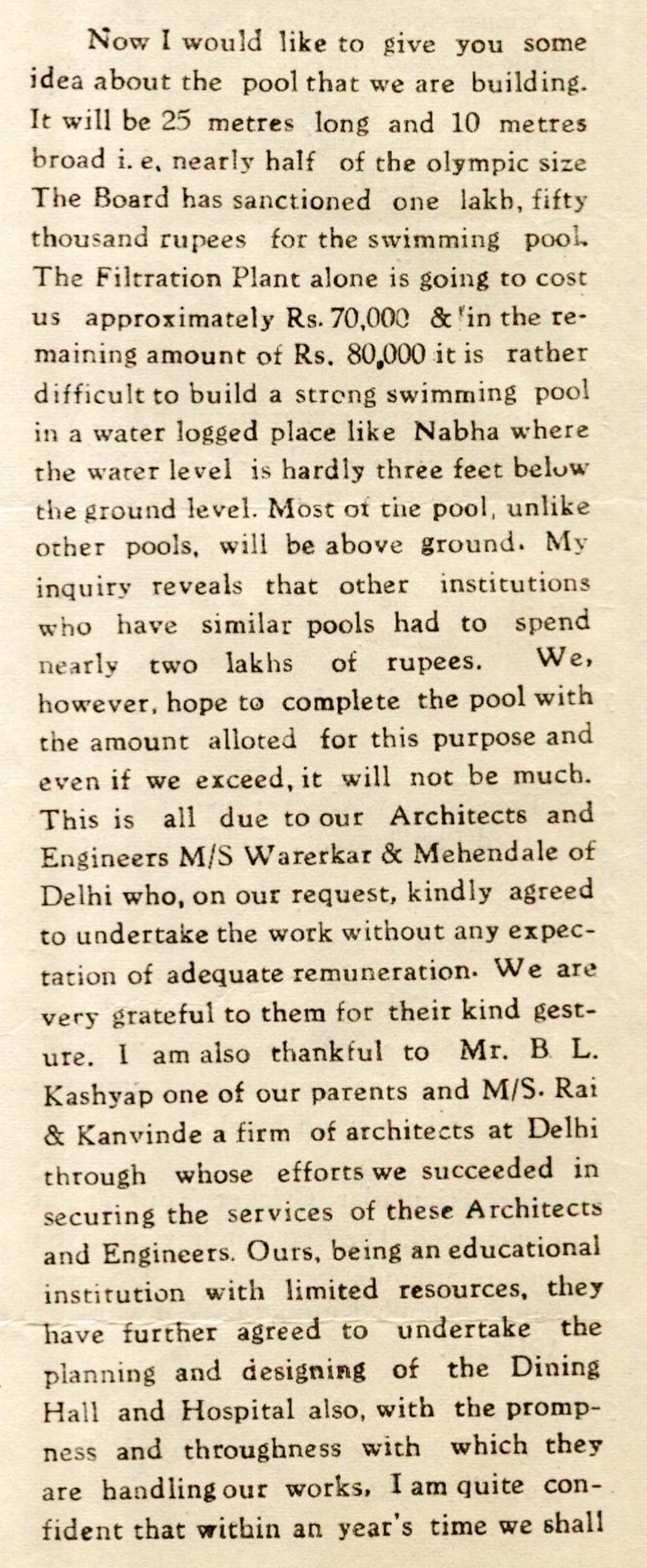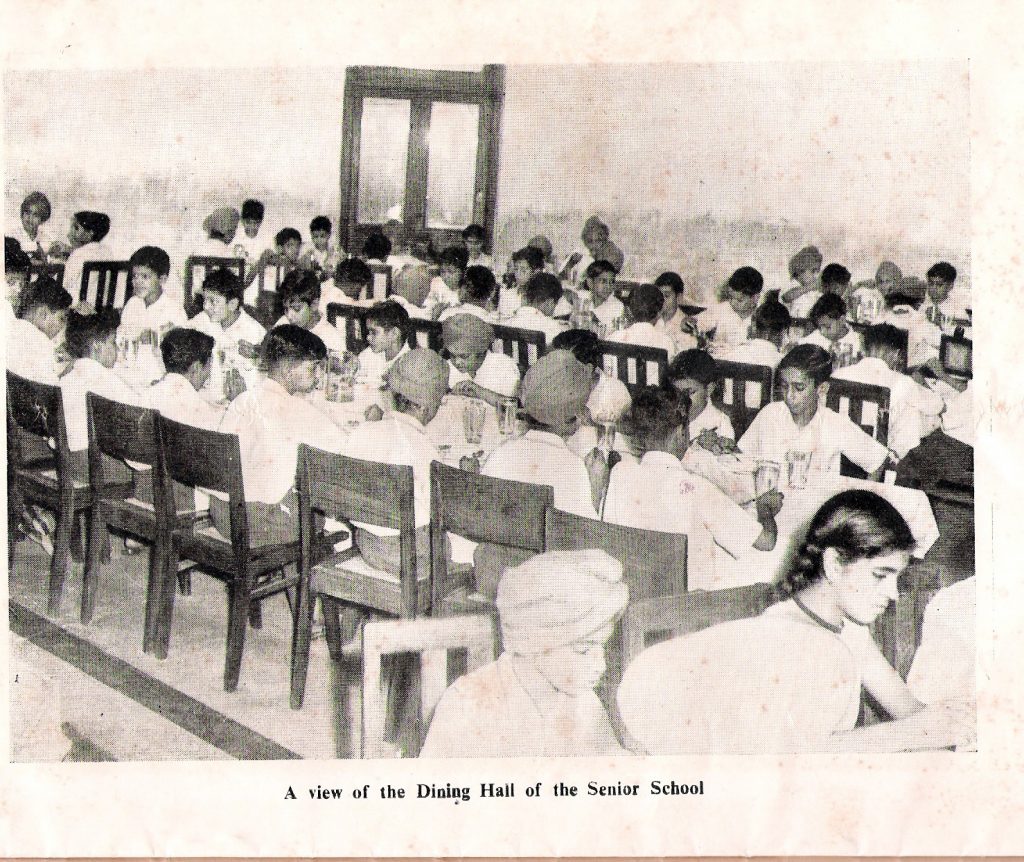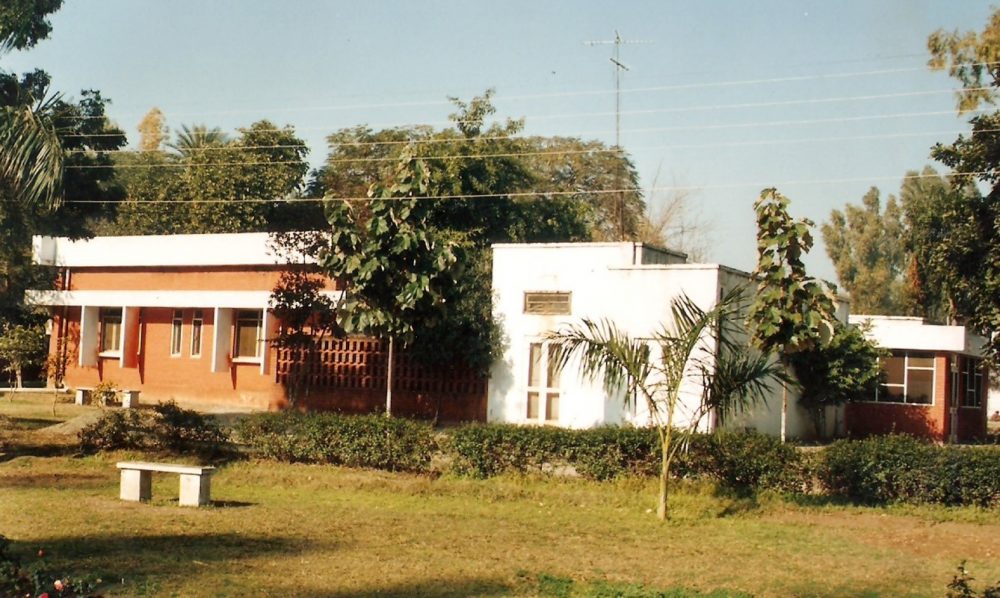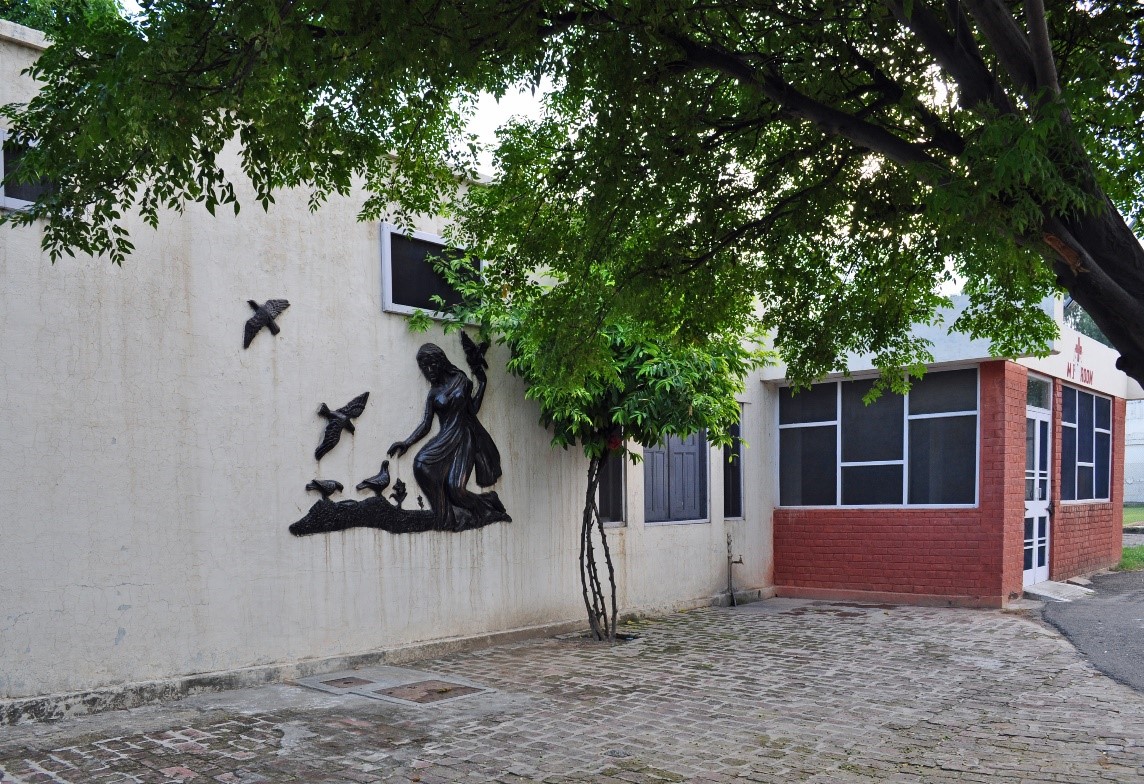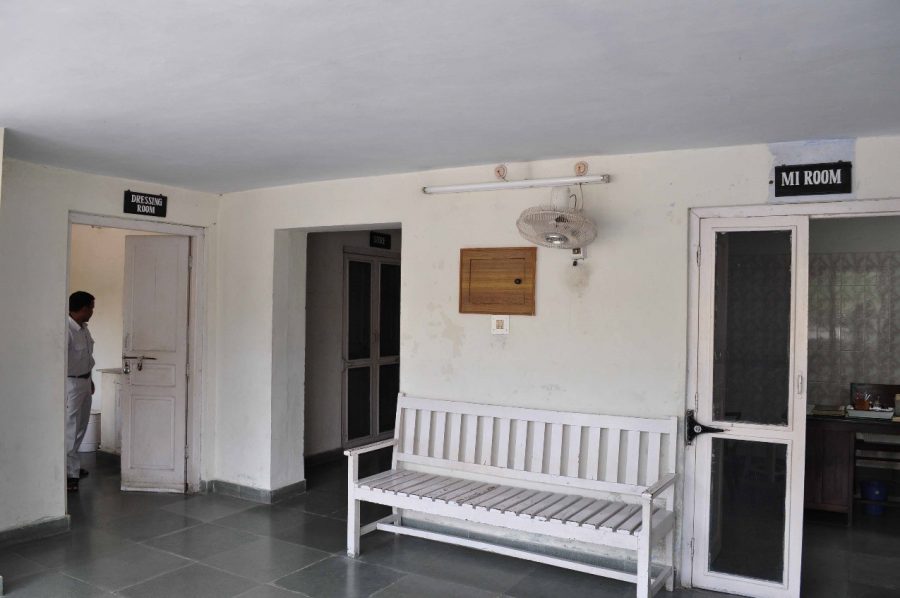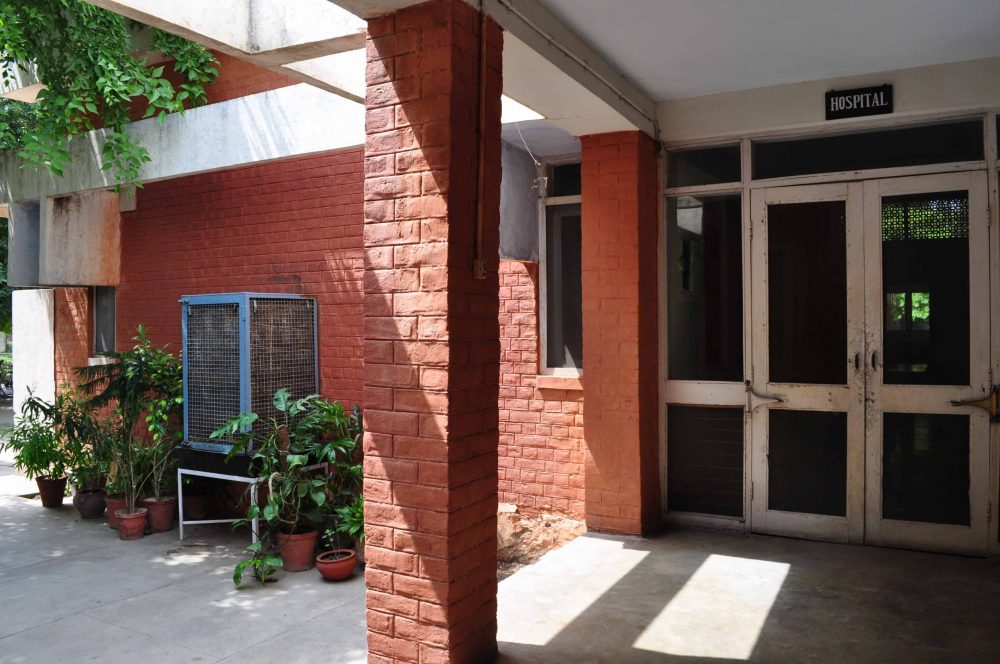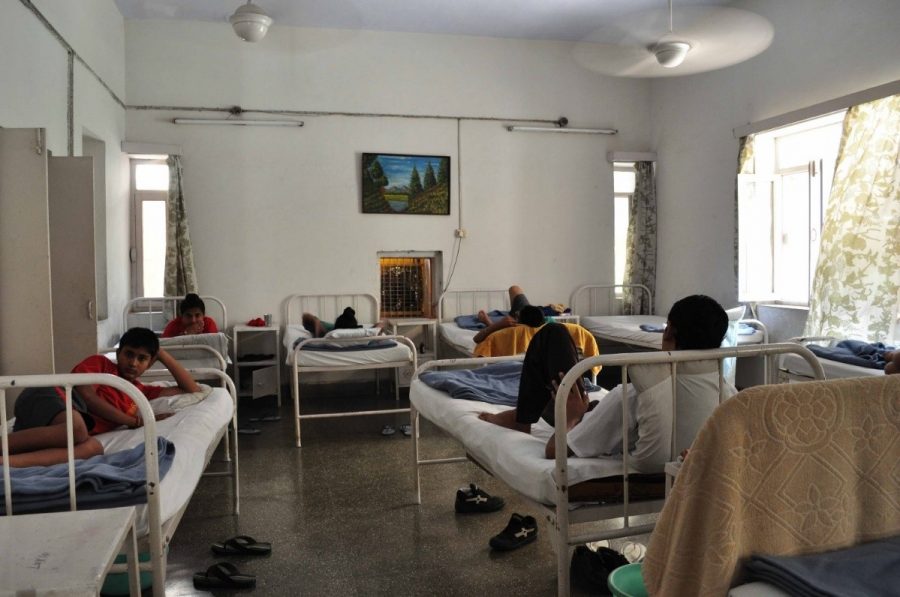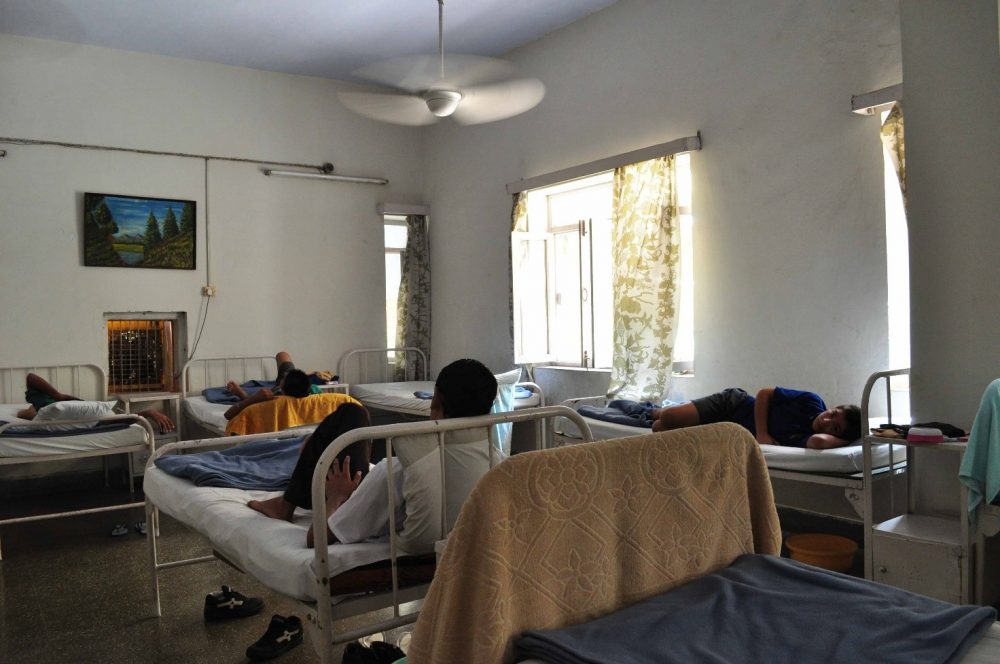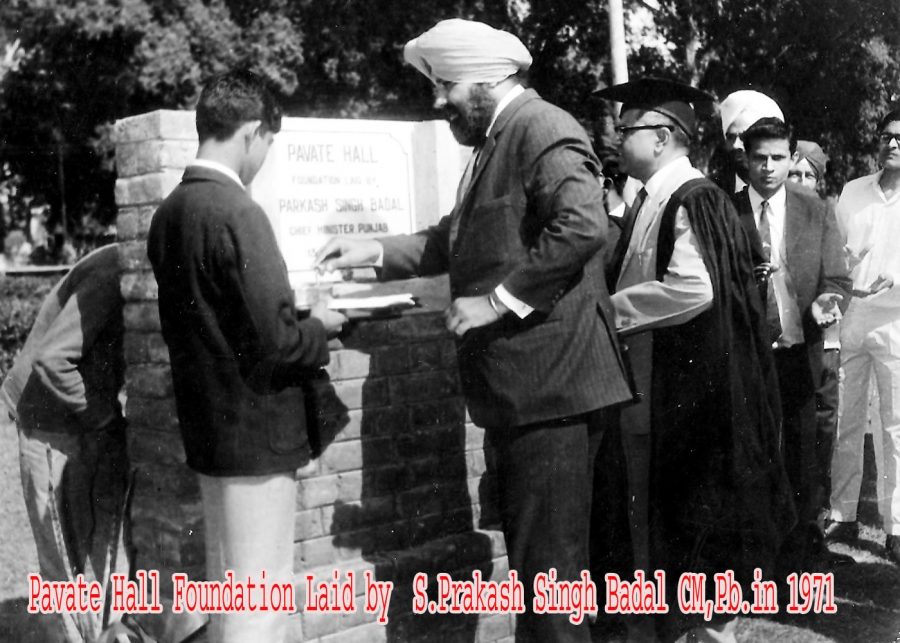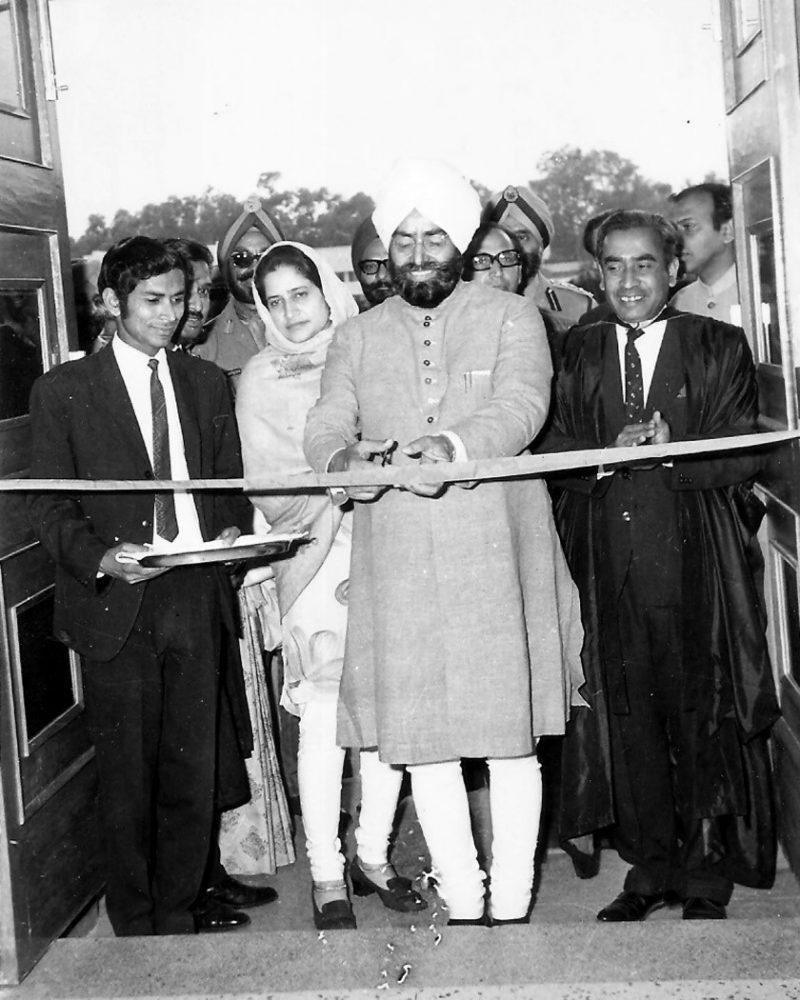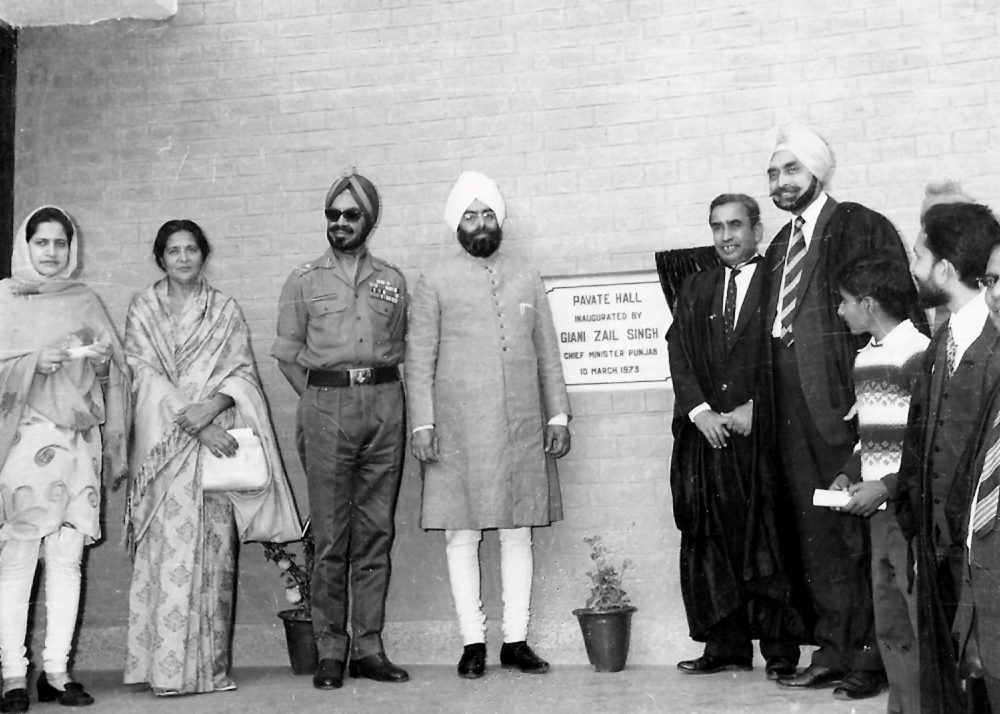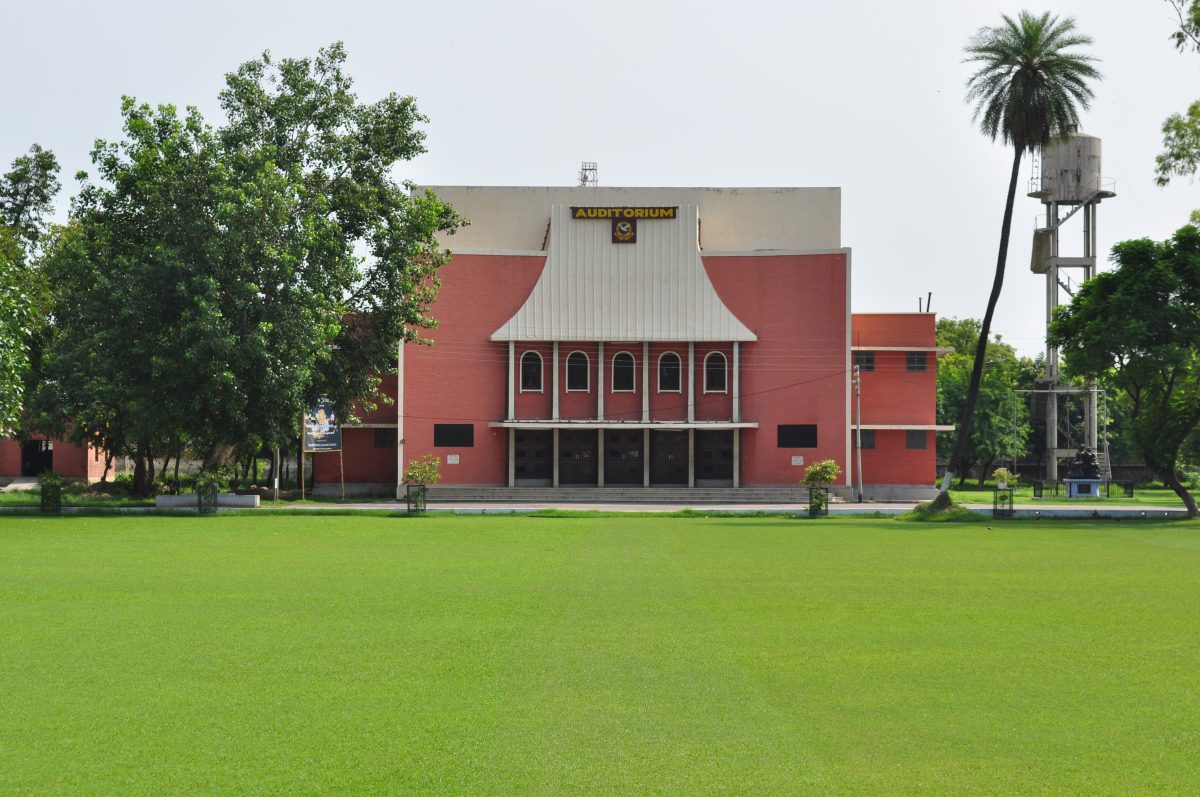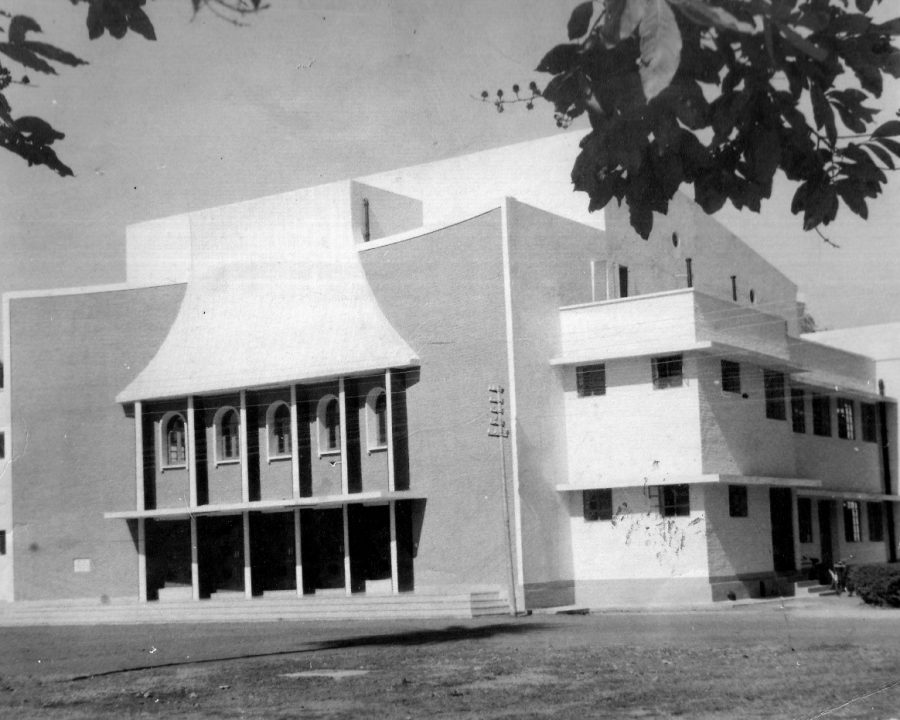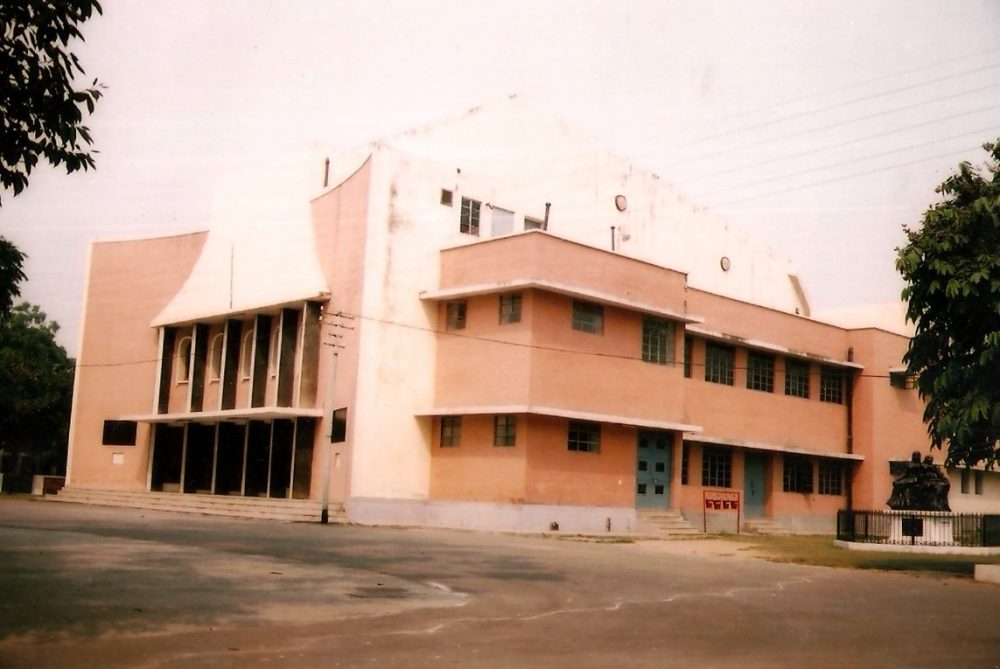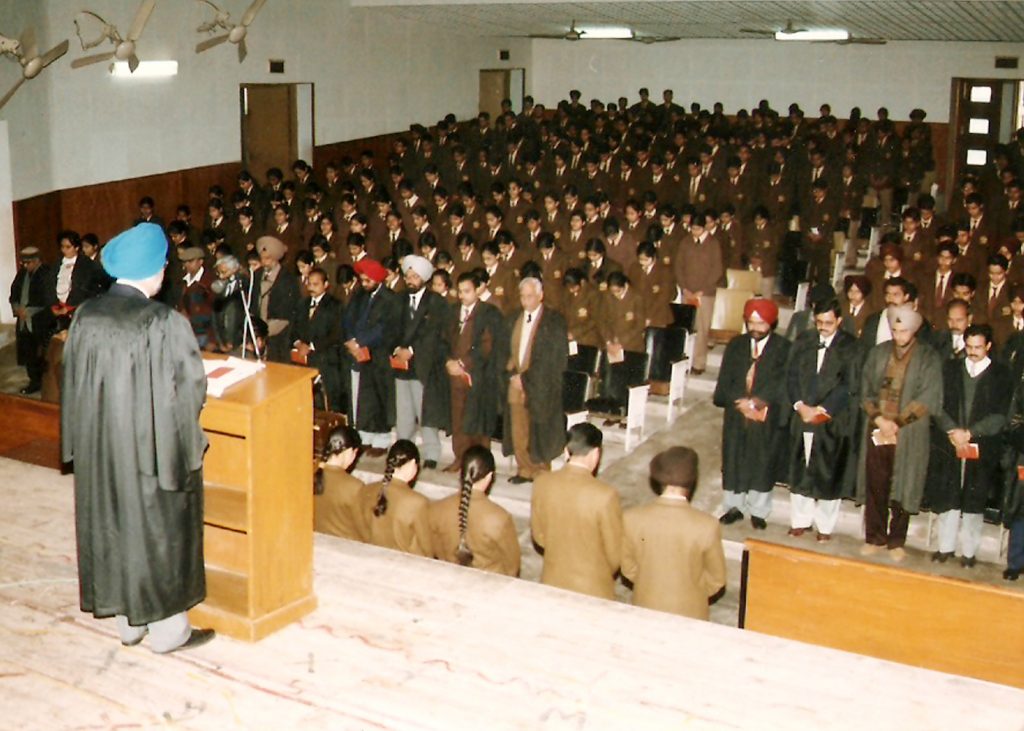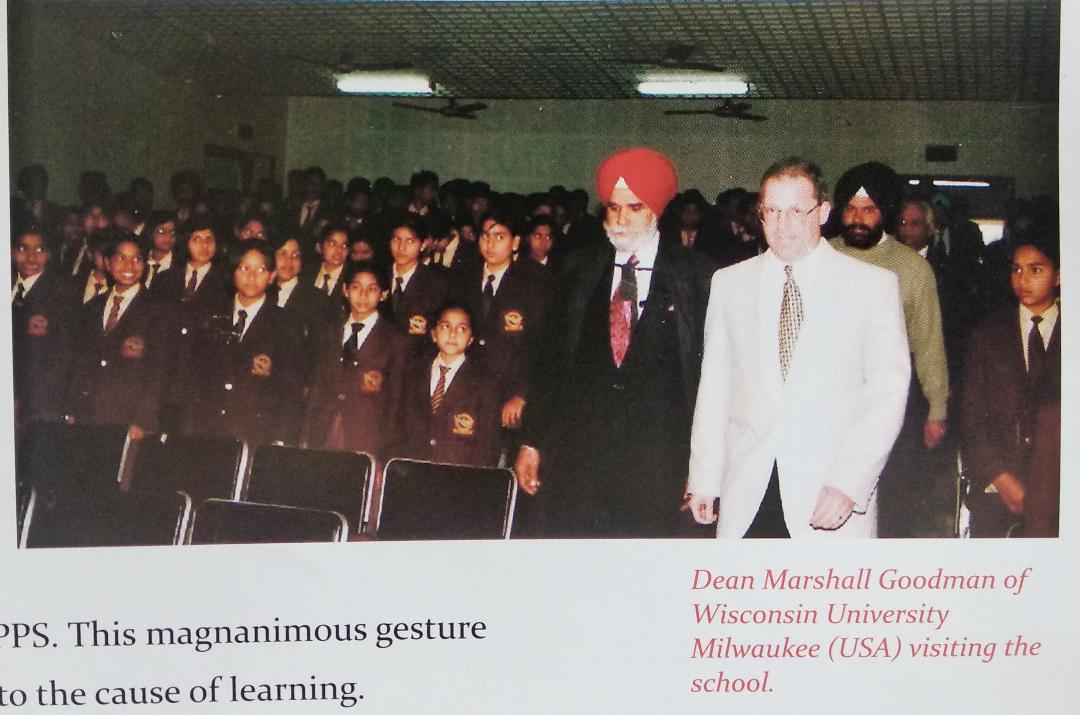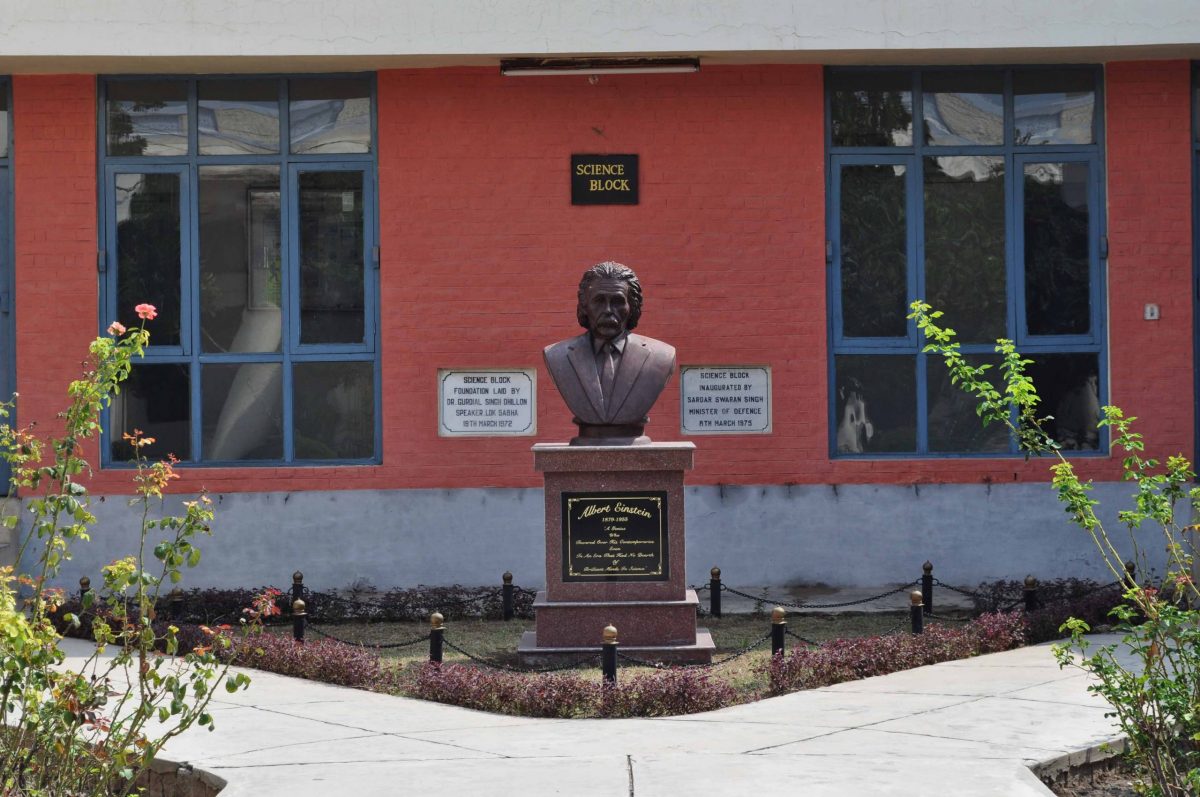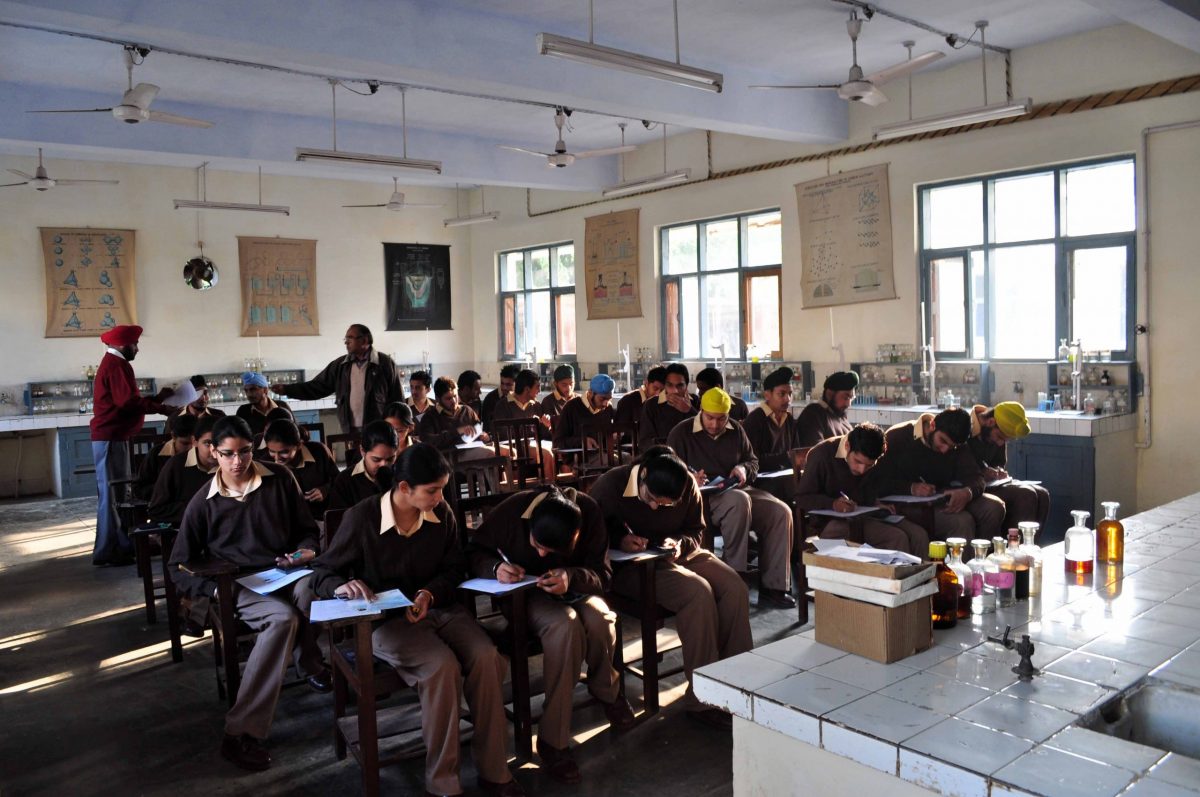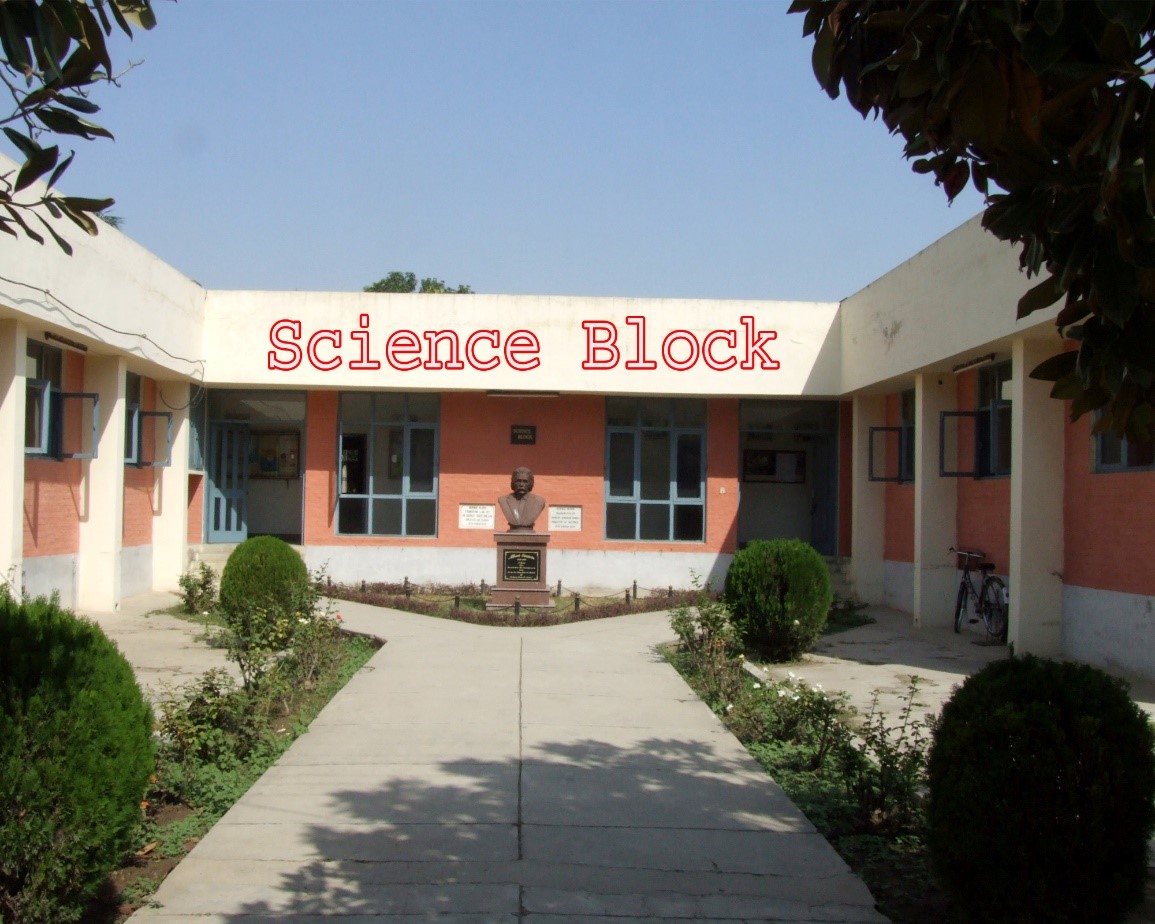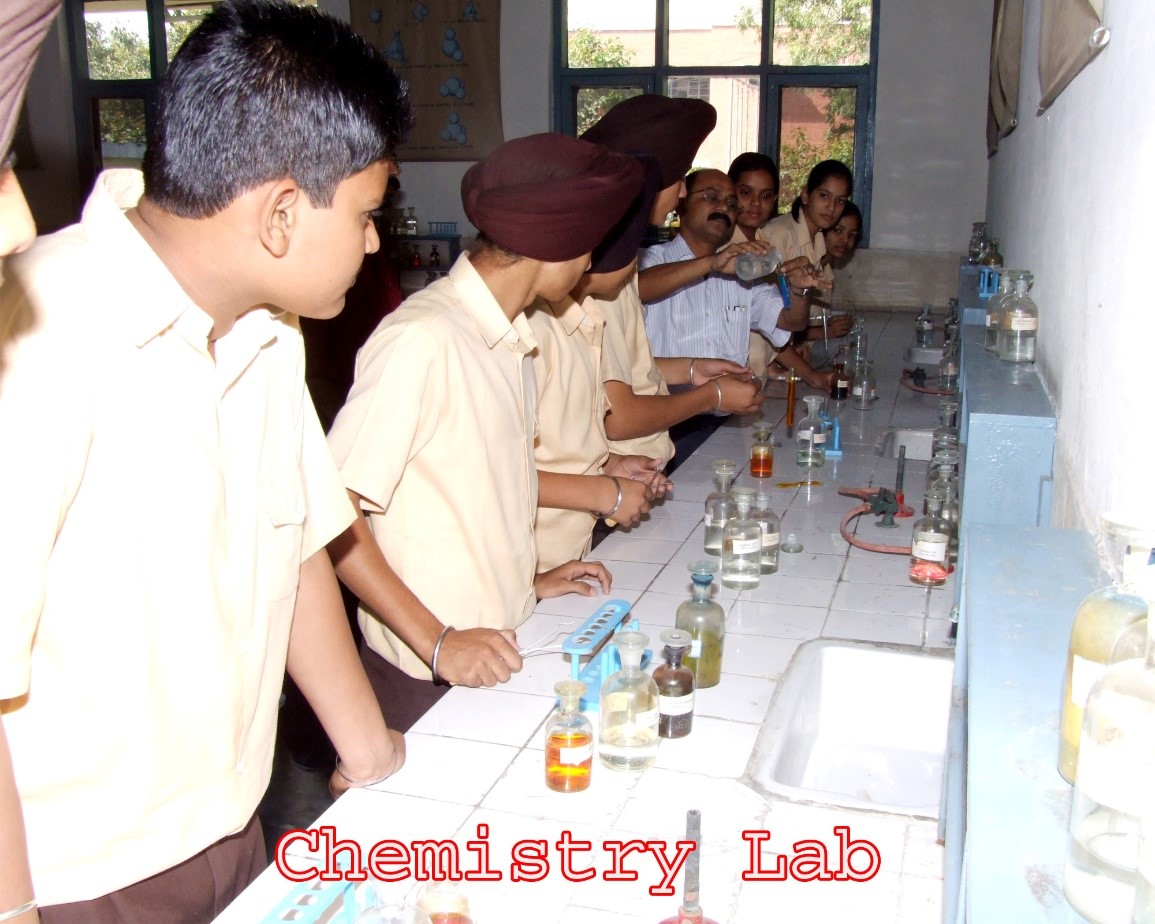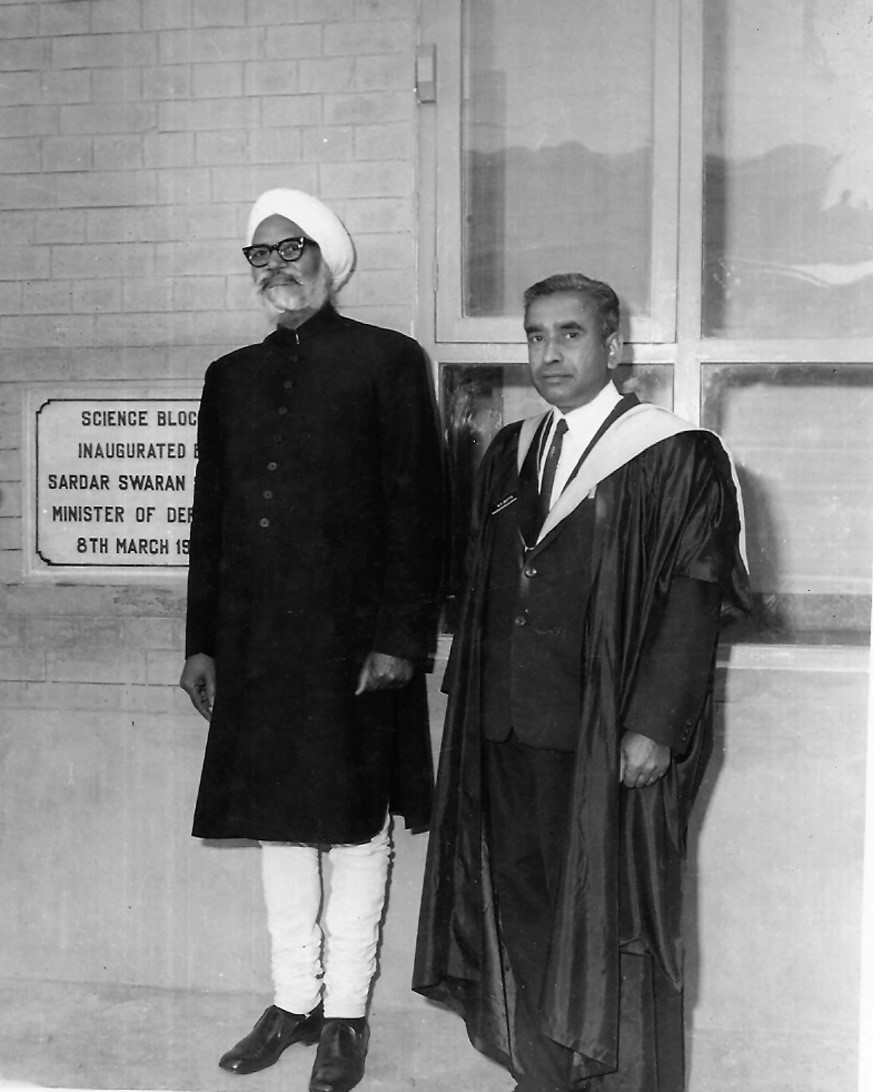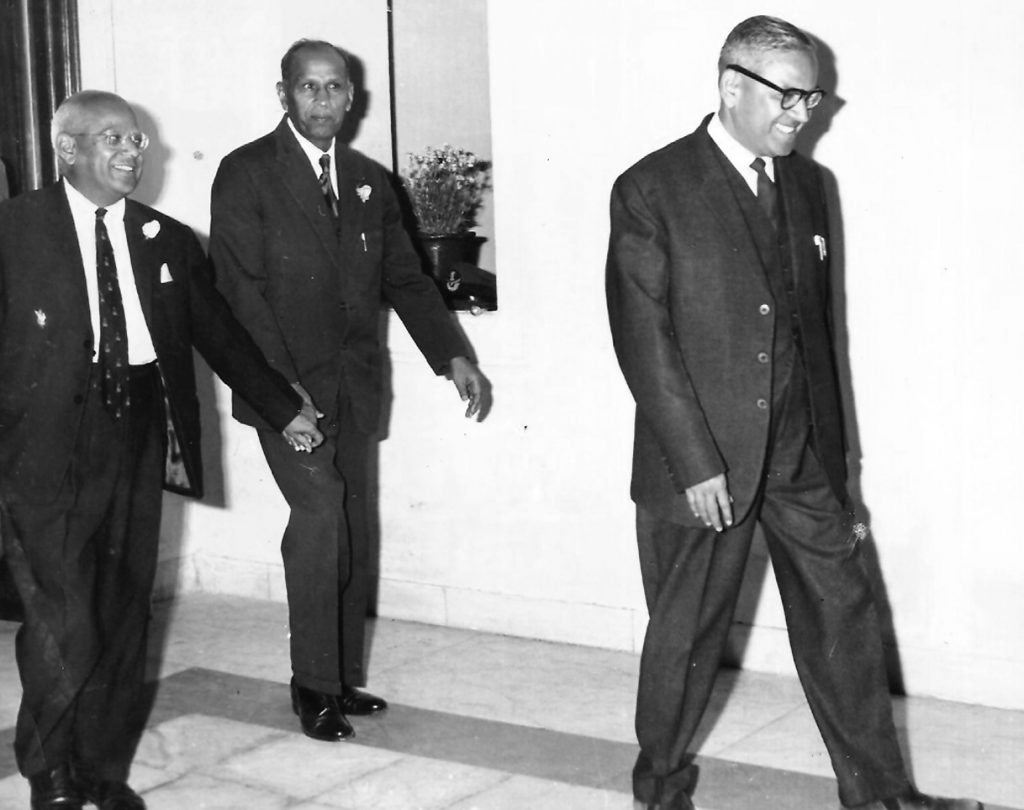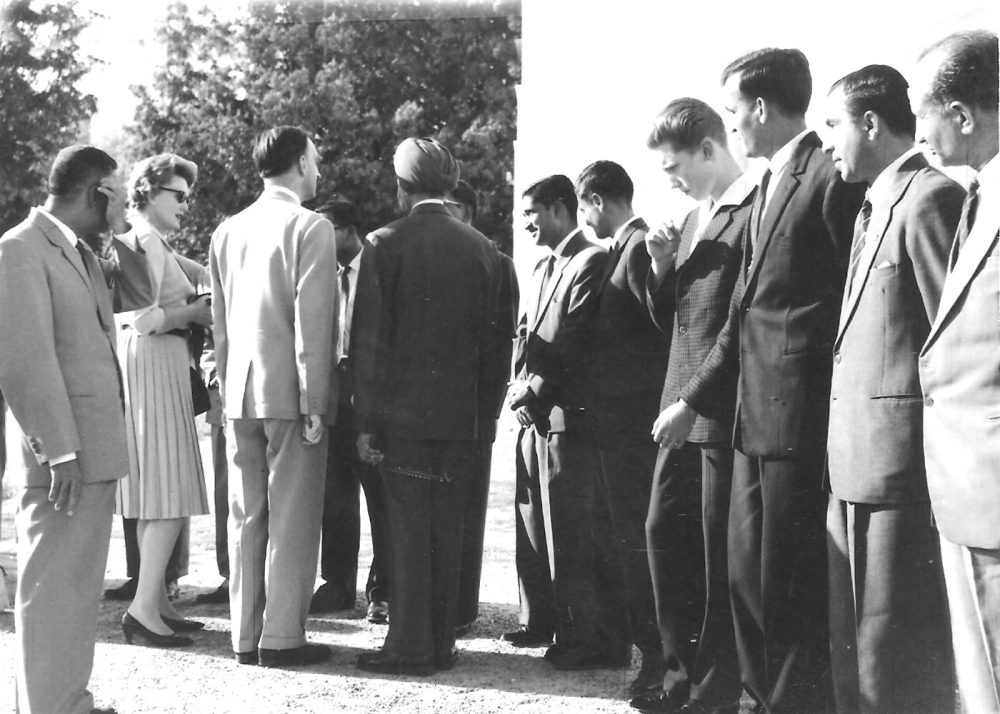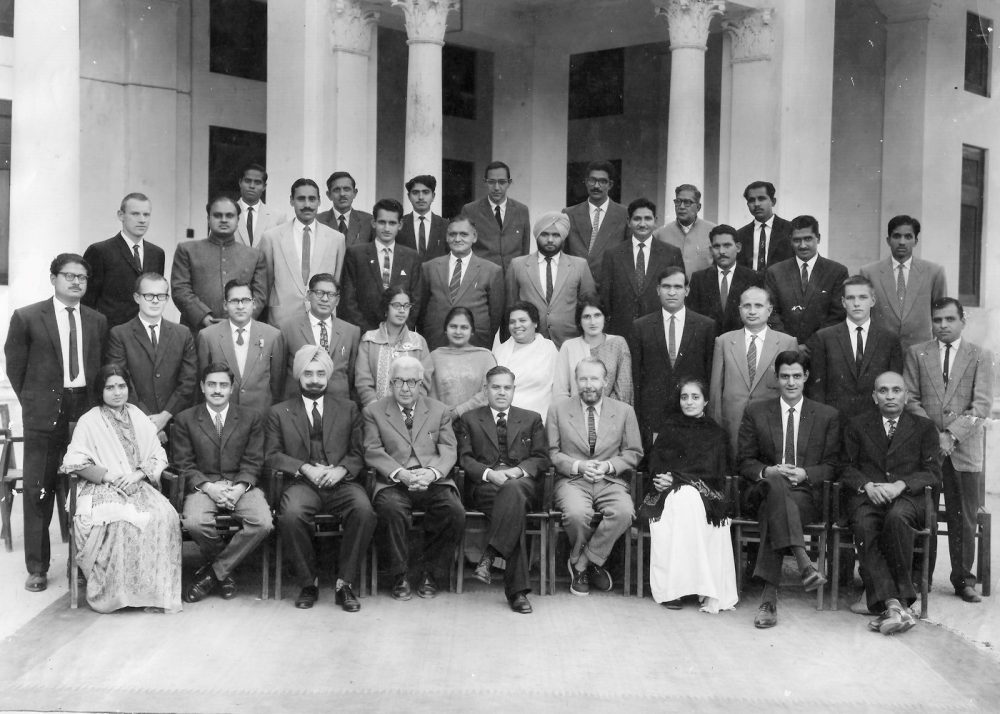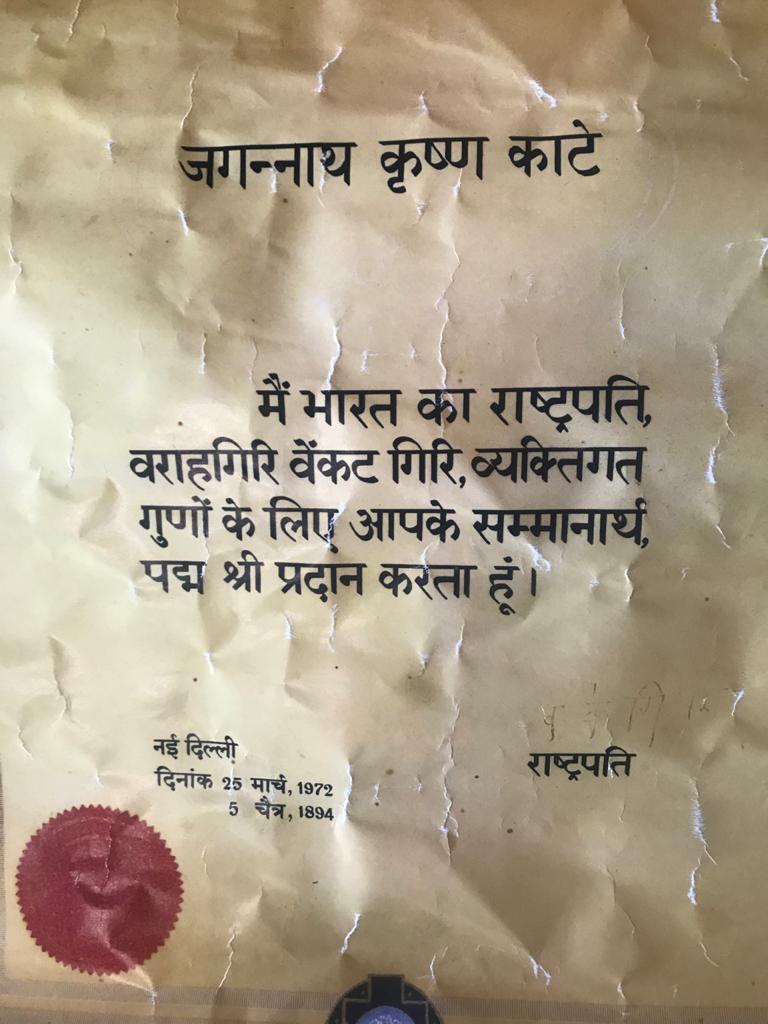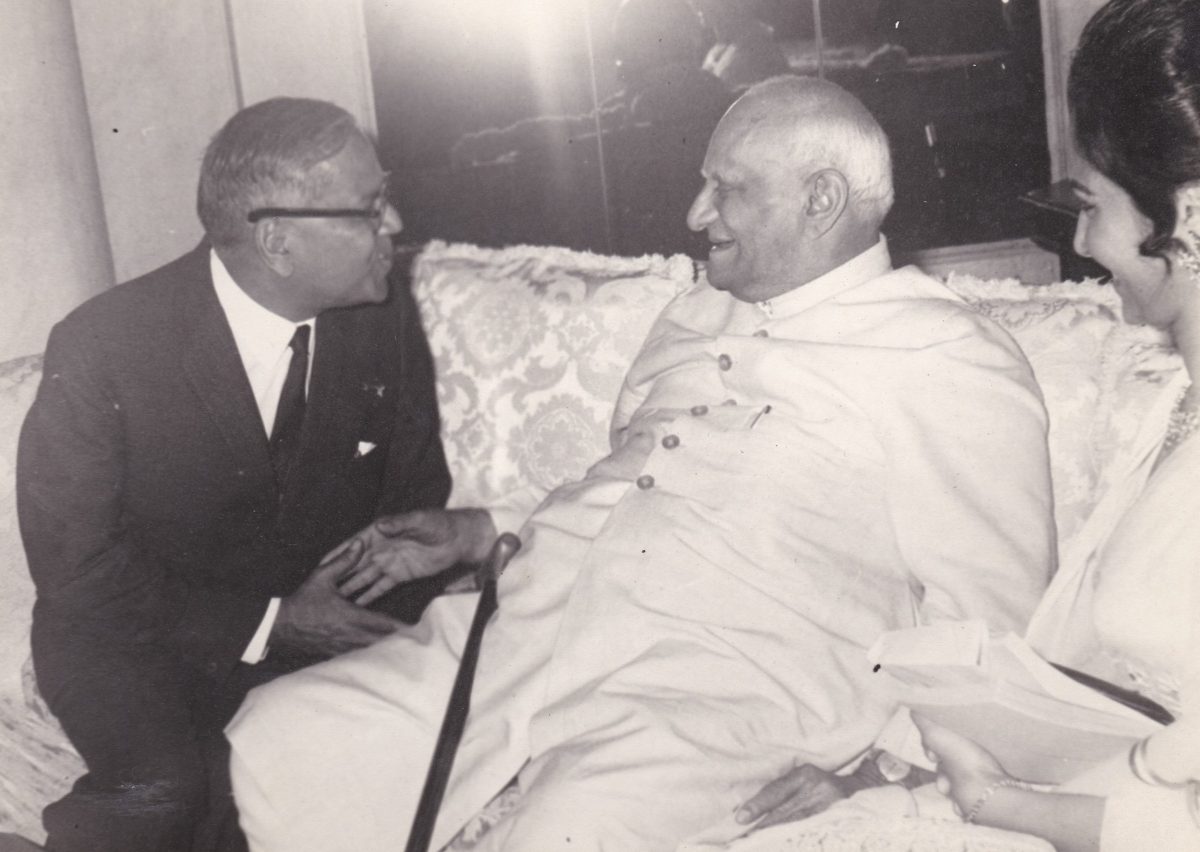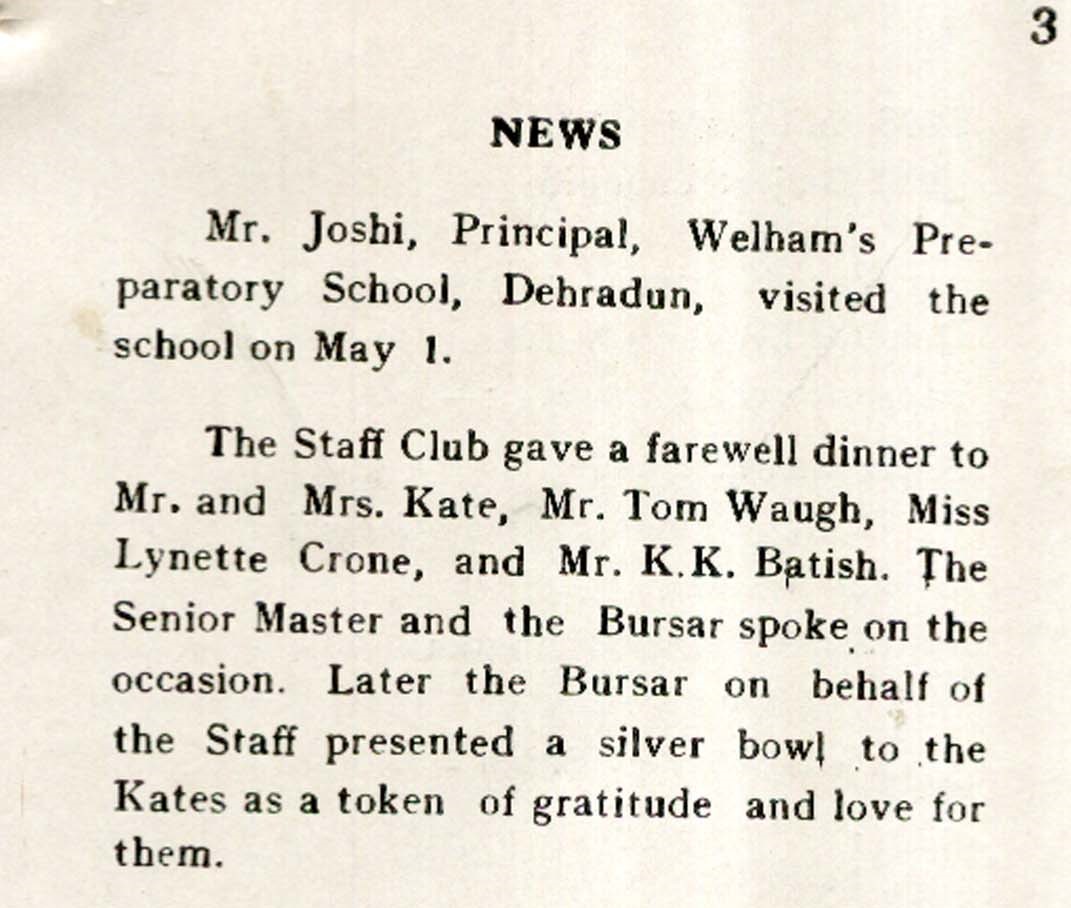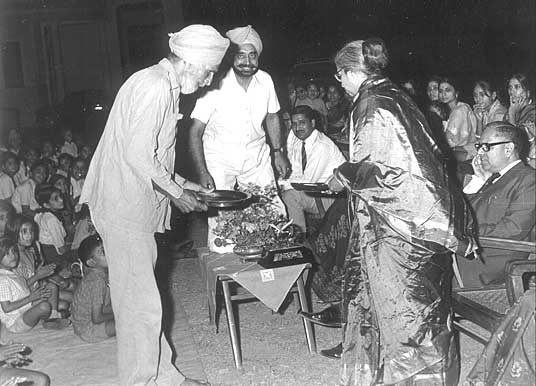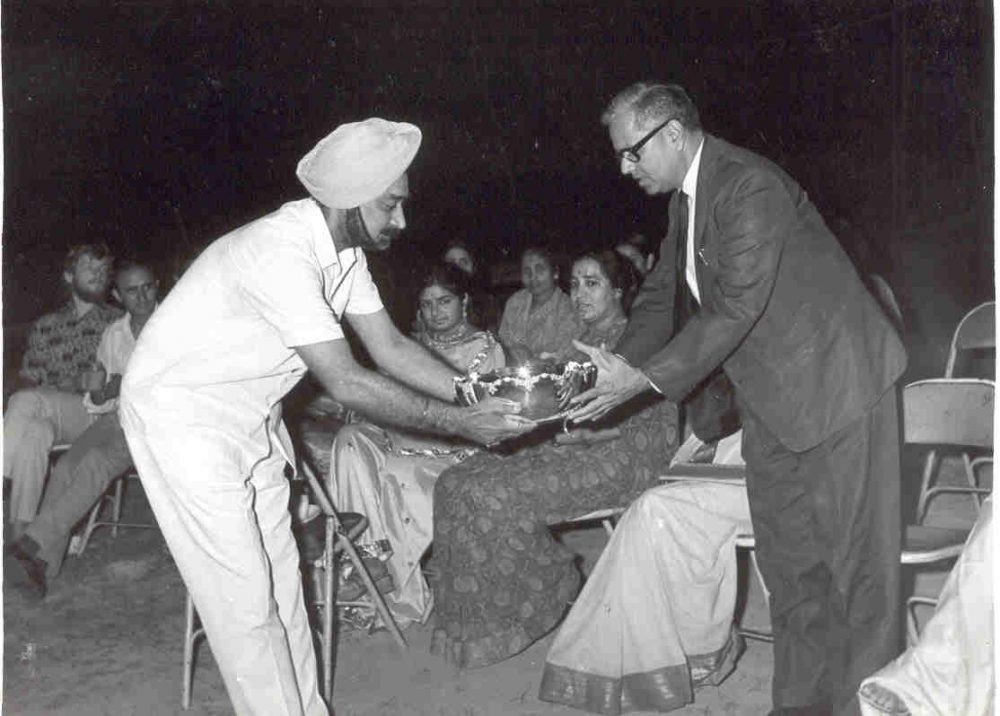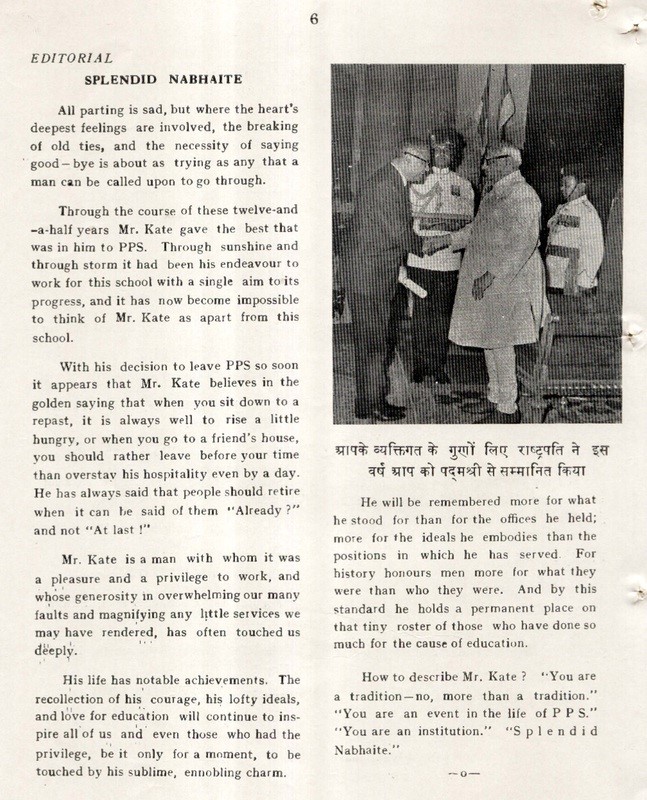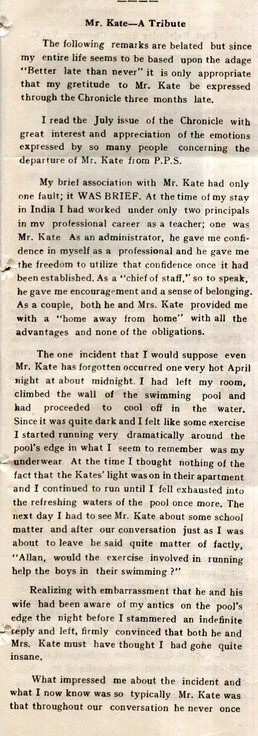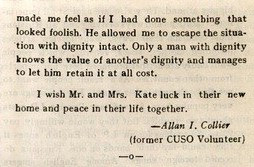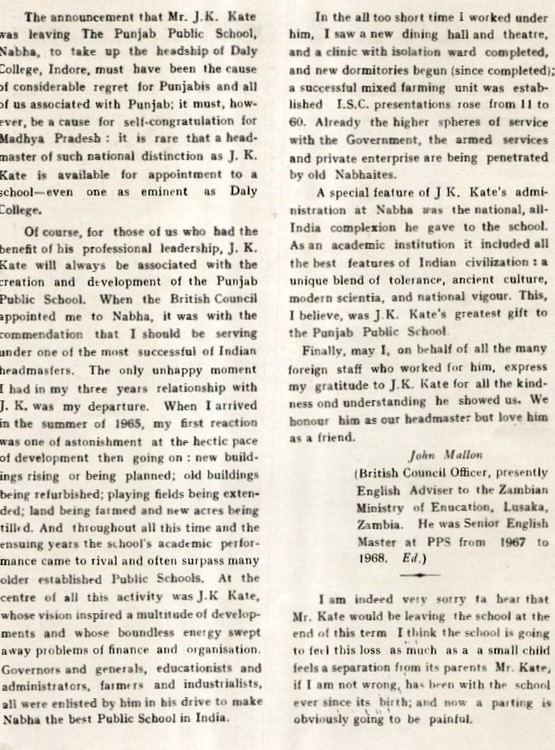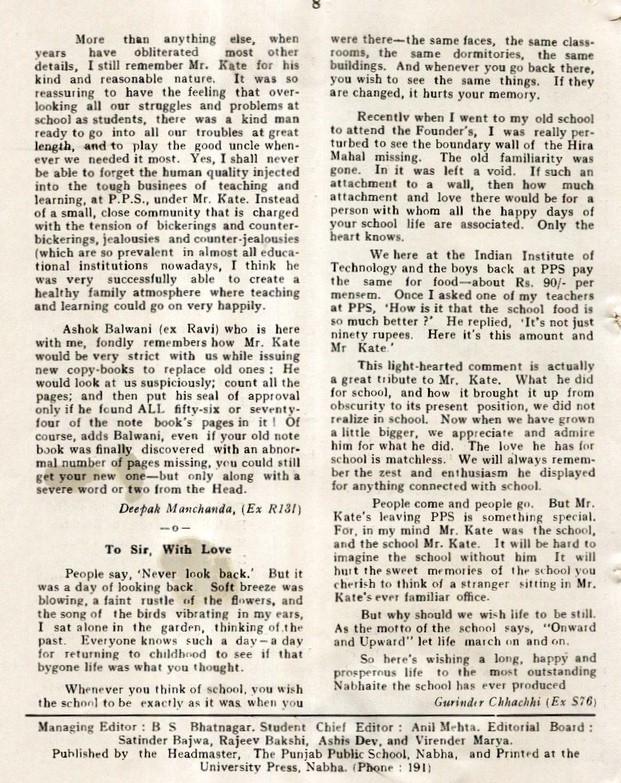Mr. Jagannath Krishna Kate, Padma Shri
(The Architect of The Punjab Public School, Nabha)
(when I visualised the history of The PPS, I used ‘A fine Monument’ as a metaphor for The Punjab Public School, Nabha. ‘The Foundations’ would be Founding Members, The Founding Headmaster as the ‘Architect’ and ‘The Pillars’ as the Teachers of 1960s who built and gave strength to this fine monument.- Dr Jashanjot Singh (S-52,1967))
____________________________________________________________________________________________________________________________________________________________________
The appointment letter which set the ball of The Sainik School, Nabha (later The PPS) rolling:
20th November, 1959 Mr. J.K. Kate Appointment
From:-
Shri H.S. Achreja, IAS,
Secretary to Governor and
Honorary Secretary, Committee of Administration,
Punjab Post War Services Reconstruction Fund.
To
Major R.Som Dutt, ABC, M.A. (Cantab),
Headmaster, Lawrence School,
Sanawar (Simla Hills).
Dated Chandigarh, the 20th November, 1959.
Subject: Headmaster Sainik School.
Dear Sir,
With reference to your letter dated the 22nd October 1959, forwarding application of Shir J.K. Kate, for the post of Headmaster, Sainik School, I am desired to inform you that the Committee of Administration of the Punjab Post War Services Reconstruction Fund, on recommendation of the Sainik School Sub Committee, have decided to appoint the applicant as the first Headmaster at a salary of Rs. 1300/- in the grade of Rs. 800-40-1000/50- with free furnished residential accommodation. It was further decided that Shri Kate should be asked to take charge of his office from the 1st of January 1960, and to arrange to draw up the prospectus and the connected literature of the School by the 31st January, 1960, as also to take further steps for the renovation and equipment of buildings, recruitment of staff, etc., so as to start the School from April, 1960. I am, therefore, desired to request you kindly to obtain his release / deputation and make his services available to the Sainik School Sub Committee on the 1st January, 1960, so that the programme laid down by the Committee is carried out without any delay. Shri Kate may be asked to report for duty to the undersigned at Chandigarh, where his Headquarters will be located for a few days before shifting to Nabha which has been selected as the site for the School.
Yours faithfully,
Secretary to Governor and
Honorary Secretary, Punjab
Post War Services Reconstruction Fund.
No. : PWF/954 dated 20.11.1959
____________________________________________________________________________________________________________________________________________________________________
Finally, Mr Kate accepted the challenge and signed a one-year probation contract offered to him by the Sub-Committee.
Mr JK Kate joins and history begins:
Mr JK Kate formally joined as Headmaster on 30th December, 1959, and reported to the Governor’s Secretary. Same evening he rushed to Nabha to take charge of the buildings (pride of Punjab by JK Kate). He then returned to Sanawar and drafted the rules, regulations, prospectus and advertisements for various posts.
29th January, 1960 First Meeting of the Committee Appointed to take Preparatory Steps to Start the Sainik School :-
The following were present at the meeting held at 11 a.m. on 29th January 1960 at the Chairman’s House.
- General Kalwant Singh.
- Shri H.S. Achreja
- Shri J.K. Kate.
_________________________________________________________________________________________________________________________________________________________
THE SCHOOL TAKES ROOTS
Board Structure:
Meanwhile, the government of Punjab formally constituted a Board to preside over the functioning of the School. The Board retained most of the members of the Sub-Committee involved in selecting the buildings at Nabha and appointing Mr. Kate as Headmaster. His excellency, the Governor of Punjab was to be the chairman thus giving some autonomy to The PPS from the Govt.
FOUNDER MEMBERS OF PPS NABHA
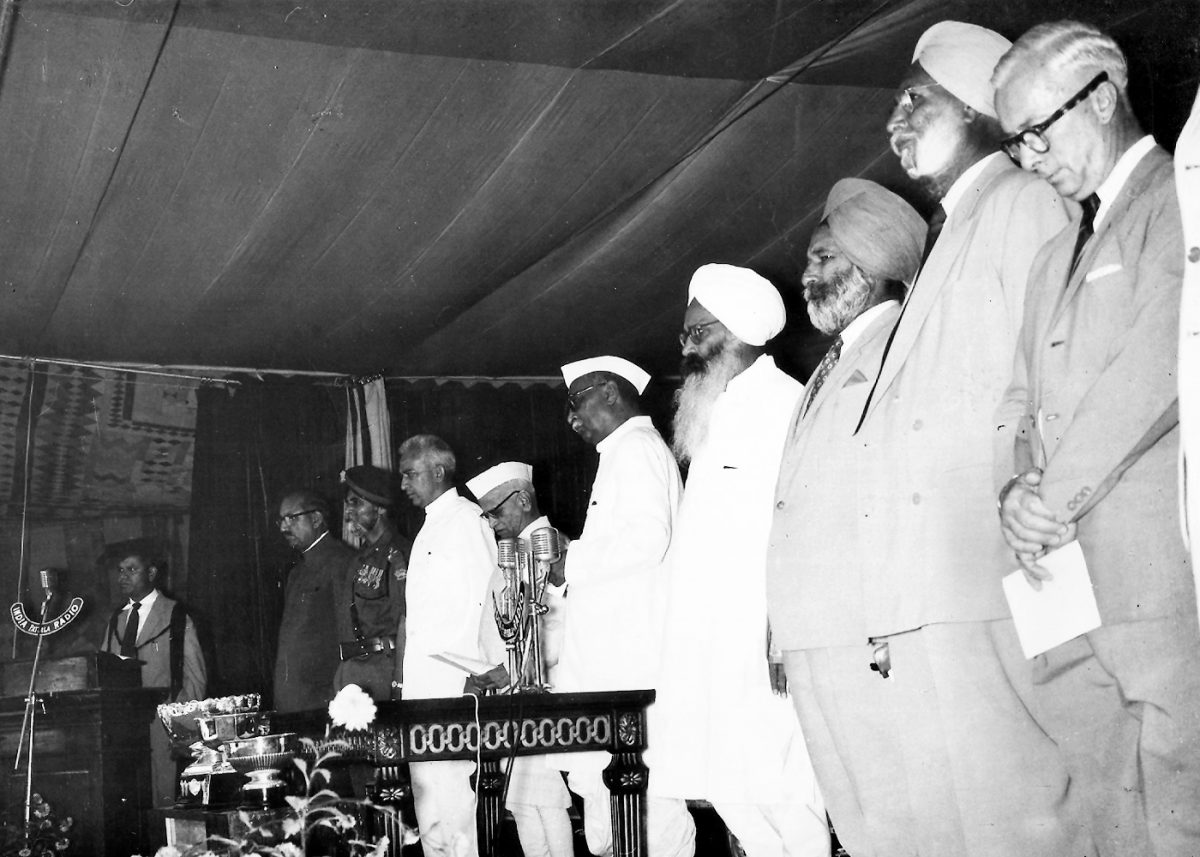 From left Mr JK Kate, Chowdhary Raghuvender, Area Commander, CS of Punjab Mangat Rai, Chairman VN Gadgil, The President, CM of Punjab S.PS Kairon, Lt Gen Kalwant Singh and S. Col Naunihal Singh Mann. and Lt.Col Frank Von Goldstein, HM of YPS.
From left Mr JK Kate, Chowdhary Raghuvender, Area Commander, CS of Punjab Mangat Rai, Chairman VN Gadgil, The President, CM of Punjab S.PS Kairon, Lt Gen Kalwant Singh and S. Col Naunihal Singh Mann. and Lt.Col Frank Von Goldstein, HM of YPS.
CHAIRMAN
H.E. V N Gadgil, Honourable Governor of Punjab
MEMBERS
Sardar Partap Singh Kairon, Chief Minister, Punjab
Shri E.N. Mangat Rai, ICS, Chief Secretary, Punjab
Lt Gen Kalwant Singh, GOC-in-C, Western Command
Chaudhary Raghuvendera Singh, Member, PWSR Fund
Brig Gurkirpal Singh, Sub Area Commander, Punjab
Col Naunihal Singh Mann, Member, PWSR Fund
MEMBER SECRETARY
Shri J K Kate, Headmaster
___________________________________________
The starting Trio:
As is well known about him, Mr Kate selected the right persons to help him start the School. Though, Mr Samuel Collins Cowell colleague of Mr JK Kate, at The Lawrence School, Sanawar had promised to join PPS, the credit for officially reporting first on duty goes to Mr Mukut Narain Tankha who had started his career as a Geography teacher at Modern School, New Delhi. Though the exact dates are unknown, both Mr Cowell and Mr Tankha joined The PPS in the month of March, 1960. It was the trio of Mr Kate, Mr Cowell and Mr Tankha that prepared the blueprint for functioning of the school.
 Mr SC Cowell, who after retirement from Lawrence School, Sanawar came to Nabha to help his friend and colleague Mr JK Kate help start the school. Here he is seen on the left with first history teacher of PPS, YP Bhardwaj.
Mr SC Cowell, who after retirement from Lawrence School, Sanawar came to Nabha to help his friend and colleague Mr JK Kate help start the school. Here he is seen on the left with first history teacher of PPS, YP Bhardwaj.
When Mr Kate returned to Nabha to take charge, all he found were two large, vacant and untidy buildings. He borrowed a chair from the Sub Divisional Officer and started his office in the porch of the Guest House. Since furniture was not available at the time they joined, the legend has it that they would sit on the marble staircase in the Guest House and chalk out the details. Brown and yellow were the prominent colours in the New Secretariat building, so the school dress was envisaged on the same pattern. It was decided that Sikh boys should be encouraged to wear turbans so they could master the art of tying a turban at a young age. Sainik School, Nabha, being a residential public school in character, an important decision had to be taken regarding ‘Houses’. Both Mr Kate and Mr Cowell had come from Lawrence School Sanawar, and it was quite natural that Sanawar was the source of inspiration for this crucial decision. Sanawar has four houses – Himalaya, Vindhya, Nilagiri and Siwalik representing prominent north Indian mountain ranges. For Sainik School Nabha, Mr Kate hit upon the idea of four main rivers of Punjab i.e. Beas, Jumna , Ravi and Sutlej.
HOUSE COLOUR
BEAS Blue
JUMNA Yellow
RAVI Red
SUTLEJ Green
To identify boys from different houses, it was proposed that the boys shall use under-turban of their respective house colour. However, since this method did not work for non-sikh boys, an additional house colour stripe was added to the school tie to address the problem later. Though it is noteworthy here that presently students wear a uniform school tie irrespective of their house.
Mr Cowell, being an academician, planned the curriculum and time table. Mr Tankha, on the other hand was a versatile genius. A passionate and lively geography teacher, a trained mountaineer, a good artist, photographer, and an excellent all-round sportsman, who could play the harmonium and sing, he played a vital role in the early years. He would mark the fields meticulously and later on organize the athletic meets almost single-handedly. His six feet four-inch frame and good looks endeared him to the students and everybody in the school looked up to him, quite literally.
Mr Tankha and Mr Kate having serious exchange, during an important function.
Rajender Parsad taking round of the exhibitions escorted by Mr. JK Kate accompanied by the tall Mr.Tankha.
To start a new school with no staff, no infrastructure, and no students demanded vision, intelligence and the co-operation of a dedicated team. He began to build one with Mr. Samuel Charles Cowell, an English teacher, who had recently retired from Sanawar. On Mr. Kate’s request to join him at Nabha and help him in kickstarting the new venture, Mr. Cowell came out of his retirement to lend a helping hand to his former colleague. Mr. Cowell had the reputation of being a strict disciplinarian at Sanawar and he brought every bit of it to Nabha.
Mr Kate had already prepared the Prospectus. Advertisements were placed for admissions and recruitment of staff in the media.
Teachers and staff appointed:
Interviews were also conducted for the post of Senior Master, teachers, administrative staff, matrons, nursing sister and other ancillary staff.
Mr Kate’s unique ability to spot and nurture talent ensured recruitment of promising and passionate teachers. Under the leadership of Mr Kate, these very teachers were to make ‘The PPS’, Nabha, the envy of all leading public schools in the country. The English Department was spearheaded by Mr Cowell and he was ably assisted by Mr Joginder Singh. For Commerce it was Mr Mathu while Miss Jasbir Lamba (later Mrs. Butalia) and Mr OP Sharma handled Punjabi and Hindi respectively. Mr Tankha as mentioned earlier taught Geography and Mr YP Bhardwaj was the first history teacher at the school. Mr S C Vishnoi took charge of the Physics department. It ought to be mentioned here that in those early days, teachers taught not only their own subjects but a few more as well.
One thing that ran common to all selections was the ability to speak fluent English. Even Hindi and Punjabi teachers, matrons, administrative and ancillary staff were eloquent in the language. This was keeping in mind that intake of the school was to be mostly of boys from homes that were non-English speaking.
The Pillars of 1960s, handpicked by Mr. JK Kate, who were the strength of the school. Photograph show him with his teaching staff in from mid nineteen sixties. Mr.SC Cowell is on the right of Mr Kate in the centre and British Council Teacher and Senior Master and English Head, Michael Vodden is on his left. Then Ms Malkani and Mr. MN Tankha.
Buildings’ plan:
Mr Kate decided to use the New Secretariat building as the academic block and boys’ hostel, and the Guest House as staff quarters. Gradually, the equipment and furniture arrived and the school machinery was set in motion. The Refractory, clothing store, and Infirmary were set up, electrical fittings were installed by an able electrician, Suraj Bhan, who worked round the clock to have the work finished on time for the start of the first academic year.
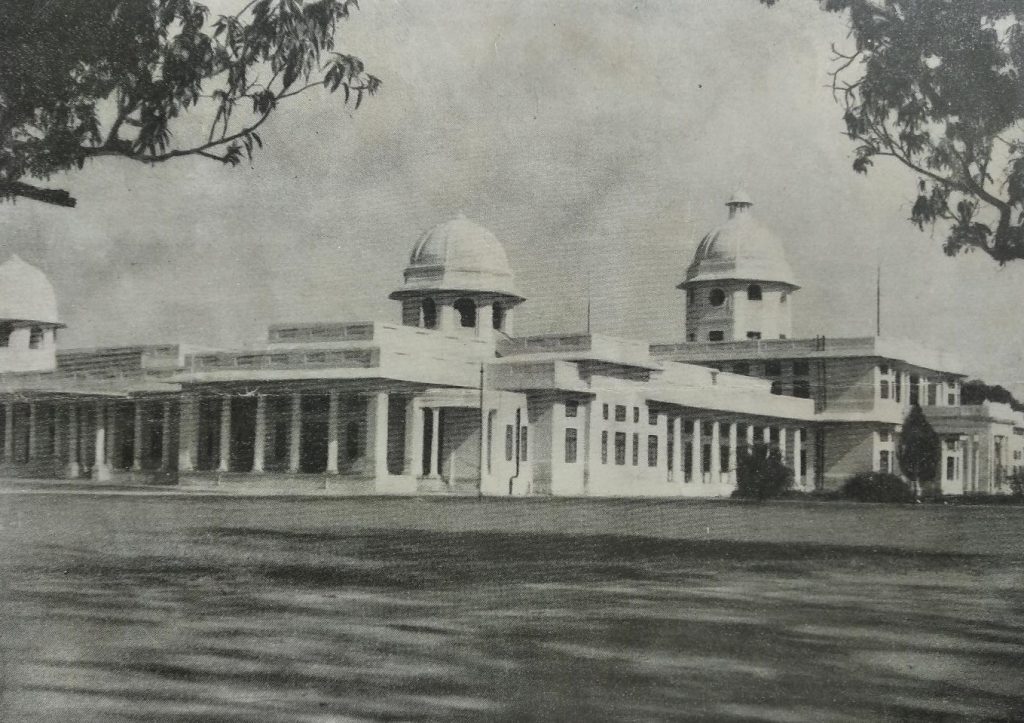 The New Secretariat (Senior School) above, as in 1960.
The New Secretariat (Senior School) above, as in 1960.
The Junior School (guest House ) in 1960
This plan was however changed after the floods in second term (1960), dividing the school into Senior (New Secretariat) and Junior wing (Guest House).Junior School or Guest House as received by Mr.Kate in 1960.
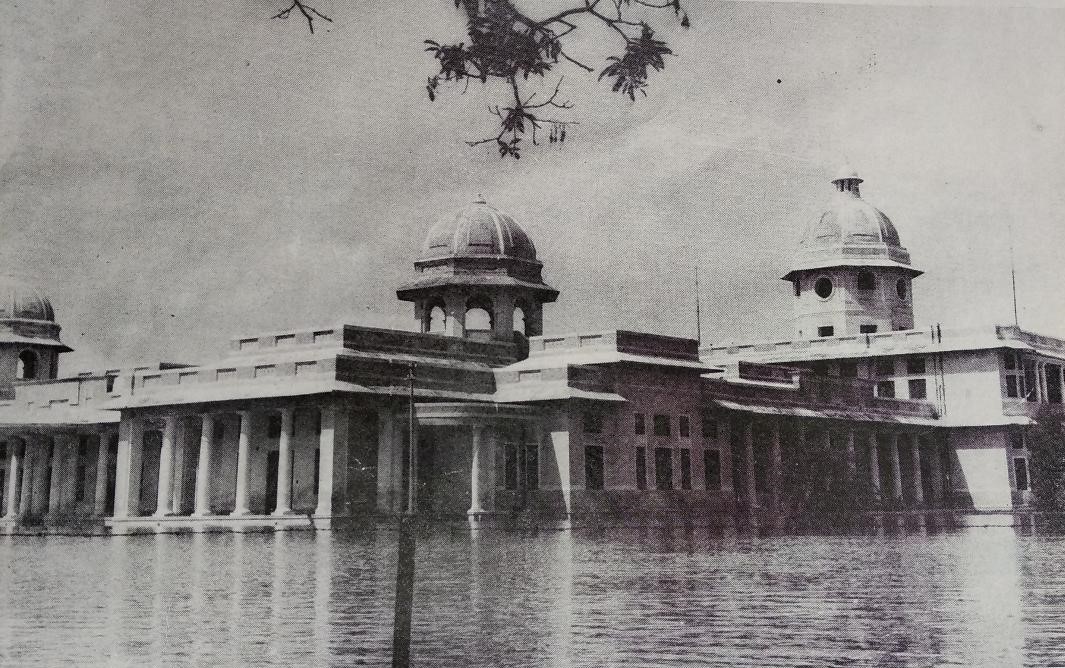 The great Flood of 1960 when senior school became ‘Lake Palace’
The great Flood of 1960 when senior school became ‘Lake Palace’
The floods in second term of 1960 made the whole school to shift to Junior School. The classes and residence were both in Junior School. Some single teachers had to double up. This incident convinced Mr. Kate that Guest House could be used for Junior School.
Admissions:
Meanwhile, the response for admission was overwhelming and applications came pouring in large numbers since the Sainik School, Nabha, was the first school of its kind in the state of undivided Punjab (including present Haryana and a part of Himachal Pradesh). To accommodate the majority of applicants, 130 seats were offered in classes 5 to 8 in the first year, though the original plan, was to allot only 80 seats in three classes, i.e., 5 to 7.
Special interviews were conducted for the children of Ex-servicemen and defence personnel to identify the deserving candidates eligible for scholarship. In the very first year, 29 full scholarships of Rs.1, 500 per annum and six half scholarships of Rs. 750 each were awarded
Students trickle in:
The boys arrived in batches on the 6th,7th ,8th & 9th April, 1960 starting with those destined for class VIII and brothers. The next few days were given over to the sorting out and distributing of clothes and to the sundry other activities for the process of settling down.
On 7th April, 1960, the students gradually began to trickle in. B-4, Rajinder Singh Dhillon was the first student to report in school. Though according to Manjit Grewal R-4, he was the first to pay the school fee.
Houses were allotted at random basis at the time of admission and the following students without realizing that they had booked their place in PPS history by officially being the first students in their respective houses.
B-1 Om Prakash Nandrajog
J-1 Surinder Gupta
R-1 Pritpal Singh
S-1 Parminder Singh Nagra
14th April,1960:
The First Official Day of The Punjab Public School (Sainik School), Nabha
Regular classes got underway. A great day in the annals of the School History to be commemorated as a holiday through all the years to come. Lt-Gen, Kalwant Singh, representing the Chairman of the Board with Mrs.Kalwant Singh were with us, as were four other members of the Board, Sardar Col. N.S. Mann, Raghuvender Singh Choudhry, Brigadier Gurkirpal Singh and Mr VP Gautum, Secretary to the Governor of Punjab. Gen. Kalwant Singh addressed the Assembly.
After Assembly the Headmaster took the distinguished guests are around the school, who were justifiably amazed at the rapid transformation brought about in so short a time, by Mr JK Kate. This was followed by Lunch hosted by the Headmaster in the Guest House.After Lunch there were speeches in the Hall and later after tea in the lawns in front of the school, the guests were treated to a quickly prepared variety entertainment by the students.(The details of the speeches etc are given elsewhere as First Day of School).
Formal start to the School with address by General Kalwant Singh on behalf of the Governor, the Chairman of the School Board.
On Baisakhi Day 14th April,1960, The School began with an address by the Lt Gen Kalwant Singh on behalf of the governor who could not make it that day.
“I am here today, at the request of and on behalf of the Chairman, Board of Governors of the School – The Governor of the Punjab to preside at the beginning of this term – which is really the start of this School.”
Lt Gen Kalwant Singh and Mrs Kalwant Singh, Col Naunihal Singh Mann, Major Raghuvinder Singh Chaudhary, Brig Gurkirpal Singh and Mr Y P Gautam, Secretary to the Governor of Punjab, were present to grace the occasion.
Mr Kate, after extending a warm welcome to the distinguished guests lauded Sardap Partap Singh Kairon for his zeal and untiring efforts to establish the school. He also thanked the Punjab Government and the managing committee of the Post War Services Reconstruction Fund for the palatial buildings and financial assistance. He then outlined the aims of the School.
- To prepare boys for either the School Certificate (Senior Cambridge) or the Higher Secondary Examination
- To render all possible assistance and training to boys, whose parents wished them to appear in the entrance examination for the National Defence Academy, Kharakvasla.
- To incorporate all the good features of a public School such as inculcation of leadership and character and the all-round development of personality by means of a well-organised house system, as well as through various co-curricular activities and hobbies which would serve to bring out the latent talents and creative ability of the individual.
The boys put up a variety entertainment programme for the guests in the evening. Considering the fact that students had arrived just four days before, they managed to stage a praiseworthy performance. Mr Kate had asked Miss Pannu to help the boys in preparing a Bhangra performance. The convent educated Miss Pannu found herself wanting on account of never even having seen a live Bhangra performance before, but Parminder Nagra (S-1) inspired other boys to come up with a scintillating display and Mahesh Kumar spiced up the performance with his creative vocal interludes (bolis) such as:
Bari barsi khatan gaya si khat ke layande tare
Ajj sade ghar aye, gernel kernel sare
The other memorable item of the evening was an English play “A Fable of Baghdad”. Under the able direction of Mr S C Cowell, the participants comprising Deepak Kapoor (J-2), Provin Jaidka (B-5) , Pradip Dhir (B-10), Pritpal Singh (R-1), Jagjit Bedi (J-3) and Surinder Gupta (J-1) came out with flying colours and a self-assured performance. It would be appropriate to mention here that Surinder Gupta (J-1) was the eldest of four Gupta brothers who had taken admission in PPS in classes 5, 6, 7 and 8 respectively! The others were Joginder (J-12) Narinder (J-25) and Rajinder (J-7). Identical in appearance and the closely bonded Guptas were the envy of many a lonely and homesick boy in those early days.
THE SCHOOL LOGO
Within a couple of months, there was a general sentiment in the campus that the school must have a logo, and a motto of its own. Mr. O.P. Bhatnagar, though a Hindi teacher, was an artist of very high calibre in his own right. He was entrusted with the historic opportunity of designing the school logo. Putting his imagination and skills to good use, Mr.Bhatnagar came up with three different designs for the school logo. Mr. Kate presented them to the General Kalwant Singh, and he immediately approved the “soaring eagle” design. It encircled an eagle in flight representing high ideals and lofty aims, with a delightfully designed ribbon at the bottom bearing the school motto “Onward and Upward”. Whether it was Lt.Gen. Kalwant Singh or Mr. Kate who came up with this inspiring logo is not known for certain. Over a period of time, some changes were made to the original logo, especially the shape of the eagle. Fortunately, it is back to its original design and flamboyance.
THE CHRONICLE
In June, the School came out with the first issue of its official newsletter –The Chronicle. It was printed by Krishan Chander at the National Printing Press at Nabha and covered the full details of School activities since the inauguration by Gen. Kalwant Singh. To compensate for the late start, it was decided to extend the first term by a month till the end of June. By the time the first term was drawing to a close, the School had already made a tremendous start and begun to blossom.
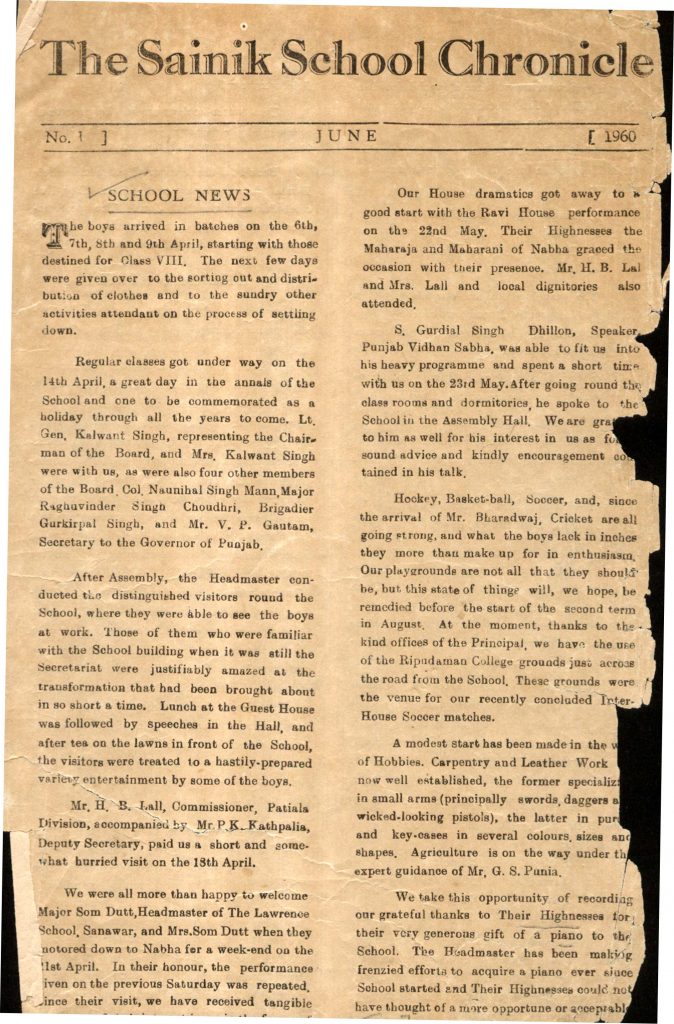 The First Chronicle of the School, June 1960, No 1
The First Chronicle of the School, June 1960, No 1
CHANGE OF THE SCHOOL’S NAME:
No sooner had the school started, the Board of Governors approached the Ministry of Defence for a school doctor and an N.C.O. for providing preliminary military training to the students. Late Shri Krishna Menon, the then Defence minister, liked the scheme of our school at Nabha and had adopted it for The Sainik Schools scheme all over India. He set the condition that if the School intended to continue as a Sainik School, it should be handed over to the Central Government (defence ministry) and civilian headmaster be replaced by officers from the defence services to act as Principal, Headmaster and Registrar, with the Principal being the rank of a Lieutenant Colonel and the other two being Majors. Sardar Partap Singh Kairon rejected the offer of handing it over to the Central Government and renamed it as THE PUNJAB PUBLIC SCHOOL NABHA. His reason was that Punjab government had spent lot of money on the school, provided the buildings and he did not want to lose Mr. JK Kate as a headmaster. As a token of regard for the Defence Minister, he magnanimously provided land for two new Sainik schools in the state, at Kapurthala and Kunjpura (undivided Punjab) respectively.
The Decision: Minutes of the meeting of the Board of Governors, The Sainik School, Nabha held at 12:00 noon on 19th July 1960 at Raj Bhawan, Chandigarh.
The following were present.
- Shri N.V. Gadgil Chairman
- Gurdian Singh Dhillon
- General Kalwant Singh
- General P.N. Thapar
- Shri E.N. Mangat Rai, ICS
- A.C. Joshi
- Brig. Gurkirpal Singh
- Col. Naunihal Singh Mann
- Col. F.A. Von Goldstein
- Rao Bahadur Choudhary Lal Chand
- Shri V.P. Gautama, IAS
- Shri J.K. Kate Secretary
The following main decision was taken in the meeting: –
Vide Item 8: The Board decided to charge non-refundable registration fee of Rs. 5/- per boy.
Vide Item 9: The Board considered the scholarship scheme submitted by the Headmaster, and appointed a Sub Committee consisting of the following members to finalise the scheme: –
- General Kalwant Singh
- E.N. Mangat Rai
- A.C. Joshi
- Shri J.K. Kate
Vide Item 11: The Board decided to appoint M/s A. Ferguson & Co. as School Auditors provided, they did not charge more than Rs. 1000/- as Audit fees.
Vide Item 12: The Board Decided to Change the name of the School from “The Sainik School” to “The Punjab Public School”.
Sd/- J.K. Kate Sd/ N.V. Gadgil
Secretary Chairman
_________________________________________________________________________________
The way it was in August, 1960: The School Letter Head:
Below is a scanned copy of an admission form printed for The Sainik School, Nabha in 1960. Though it carries later date entries on top. The name was changed to “THE PUNJAB PUBLIC SCHOOL” in July, 1960.
The original letter head then started carrying a rubber stamp of new name on top of old letter head ( Mr Kate would not have wasted anything). If anyone ever has a doubt about School name please refer to this document. Note both names were written in capital letters and the word “THE” included.
____________________________________________________________________________________________________________________________________________________
Mr. J.K. Kate, a life sketch
The board members of 1960, Brig Gurkirpal, Chowdhary Raguvender Singh, Col Naunihal Singh Mann and Lt. Gen Kalwant Singh.
Mr Kate was born in a small town in the Ahmednagar district of Maharashtra on12th August 1914.He moved to Pune at an early age and then moved to Baroda where he passed his matriculation. He studied in the well known Baroda High School and started his teaching career in the same school. Right from an early age he was interested in literature and poetry and wrote many poems ,which were published and started ’Sharadutsav ‘a poetry meet for poets .He wrote a poem detailing the history of the Gaikwads on the birth of Sangram Singh Gaikwad the son of Pratap Singh Gaikwad H.H of Baroda State .and thus came in close contact with the royal family of Baroda.
He would take tuitions even when he was studying The Patwa coaching classes where he taught were a cause of jealousy among the other teachers as his class was always full!
After completing his masters in Pali and his B.T. he started his teaching career at Baroda High School.He was full of energy and enthusiasm and soon established a reputation of being an excellent teacher. In 1953 he joined The Daly College, Indore as a teacher. There too he started many new schemes including a House System for day scholars, which was much appreciated by the parents. He started a tuck shop for the school; this was also highly praised as everyone lived on campus, and would have to go a good five kilometers to get even a packet of biscuits! Thus his administrative skills got a fillip. By the time he left Daly College for Sanawar he was a House Master.
In1953 Mr. Kate joined The Lawerence School, Sanawar, as a bursar Apart from teaching he took over the administrative reins of the school. He introduced new ideas and brought about many changes in the school, whether it was replacing the western diet for an Indian one or hiring tailors to stitch
uniforms or going to Bhakra Nangal to ensure the school got electricity (it got electricity for a few hours each day).In a short span of time he earned the respect of the teaching fraternity not only in Sanawar but in other public schools as well. In1958 he was selected by The British Council to study the public Schools in England.
In1959 he was selected as Headmaster, to start the first Sainik School in India in Nabha,as was envisaged by Sardar Pratap Singh Kairon,the then chief minister of Punjab. In1961 it became known as The Punjab Public School. With his vision and dogged determination he brought the school on par with other well established public schools in India.In1972 he was conferred the Padmashri for his contribution to education When I asked him how he felt when he met the President he replied, that what gave him greater happiness was to see that the three aides who escorted him to the President were his ex students!
In the same year his old school, Daly College called him to take over as Headmaster and to reestablish its former glory .For Mr. Kate it was like going back to his roots and he brought about sweeping changes which helped the school establish some of its credentials.
In1978, the government of Haryana beckoned him to head their prestigious Sports Institute at Rai.He always loved the North and decided to join. Soon he joined the Motilal Nehru School of Sports Rai,as Director. Not one to take things easy he worked as hard as ever, in spite of his ill health.In1981 he retired and set up residence in Pune with his family.
This life sketch would be incomplete if I didn’t mention Mrs. Nirmala Kate who stood by him through thick and thin and by her presence helped his dreams come to reality. By her calm and helpful nature she lent grace and dignity to whichever post Mr. Kate held. And worked as hard for the benefit of the school.
As was his nature he kept in touch with his old schools and school boys. There was a steady stream of visitors it was then that he was in his element. As I sit typing on the laptop, I cannot but imagine how happy he would have been with one of these gadgets. The people of Nabha were close to his heart, his face would light up if they called or came and in the end it was they who took care of his heart with their care, magnanimity and love for him, for his boys and his teachers life had come full circle.
The end came on 5th August 1990.I’m sure if he could live his life again he would still love to go back to Nabha and serve the boys he loved and cared for so much.
_________________________________________________________________________________________________________________________________________________________
 Mr JK Kate delivering his speech at the inauguration of The Punjab Public School, Nabha. Standing in center is the President of the Union, Dr Rajendra Prasad, on his right is Governor VN Gadgil, Chief Secretary of Punjab Mangat Rai and on left are S. Partap Singh Kairon, CM of Punjab, Gen Kalwant Singh, S. Naunihal Singh Mann , Lt Col Frank Von Goldstein board members and other dignitaries.
Mr JK Kate delivering his speech at the inauguration of The Punjab Public School, Nabha. Standing in center is the President of the Union, Dr Rajendra Prasad, on his right is Governor VN Gadgil, Chief Secretary of Punjab Mangat Rai and on left are S. Partap Singh Kairon, CM of Punjab, Gen Kalwant Singh, S. Naunihal Singh Mann , Lt Col Frank Von Goldstein board members and other dignitaries.
In his speech, Mr. JK Kate can be quoted as saying: “If I mistake not, this is the first Public School in independent India to be inaugurated by the First Citizen of the country.”
_______________________________________________________________________________________________________________________________________________________
MEMORIES OF NABHA AND A GREAT HEADMASTER
by John Mallon (from Scotland, Ex-English head and Senior Master, 1965-68)
John Mallon with 1967 ISC Batch. Second on his right is Vijay Kanwar who got motivated by his French lectures to take up writing in French and now lives in Paris. Next to him is Dr Jashanjot
In 1984 The British Council posted me from Caracas as Representative and Director in Portugal, and I decided to take my local leave on a visit to India and to see again JK Kate.
In 1968 I left Nabha to take another degree in Edinburgh. I had wanted to stay on in India and there was a tempting possibity of Mayo where Headmaster Gibson was nearing retirement. But universal advice was that the Indian Public Schools were under threat. It was forecast by our senior officials in Delhi that the Schools would inevitably decline. True, there were anti-foreign demonstrations in the capital and Moraji Desai had set his face against the Public Schools, but I could not go along with such views, coming from the Punjab Public School where a dynamic headmaster, J K Kate, was embarked on expansion in an institution producing young, confident and able students who could lead the development of the largest democracy in the world.
Thus, in my return to India in 1984 to visit JK Kate, I was curious to see how the Indian Public Schools had fared. In the Autumn of that year, I visited the Doon School on my way to Mussoorie, and of course that school was thriving and had greatly expanded. Sadly I could not get back to Nabha, as Punjab was a troubled state after the invasion of the Golden Temple; however, everywhere there was evidence that the Indian Public Schools, far from being in decline, had hugely prospered and were in great demand. By 1984 great changes had already taken place in India, and the population of 500 million I had known in 1968 had now in 1984 grown to 800 million, and the role of the Public Schools in this progress was self-evident, a role to which JK Kate had contributed so much.
In early 1964 I landed at Bombay in transit for Hyderabad where the Public School was an uneasy mixture of old Jagidar traditions and the transition from a British headmaster, Arnold Brown, of the Everest crowd. Mukram Jah, the enlightened heir to the Nizam, was Chairman, but there was a melancholy air of decline which perhaps, influenced the impending withdrawal of British support for the Public Schools. It was decided to transfer me. My new posting to Nabha in 1965 was a revelation. Our Delhi Office had described J K Kate as the most impressive headmaster in India, and the Punjab Public School was bustling with new projects and an enthusiastic student body who represented all the optimism that would take India forward. What was extraordinary was the infallible direction that J K brought to the management of the school. He assembled a talented Indian staff with a minority of British subsidised teachers, and welded them into a cheerful and happy family. The school was housed in old imperial buildings but the whole atmosphere was one of modernity and new ideas. Its Headmaster had innumerable high level contacts and was indefatigable in promoting his school. The strong links with the Punjab State, the Sikh community, and the legal and civil and military institutions, gave the school a prominent and influential position in Punjab and nationally. I visited other Public Schools with J K, among them Mayo and Sanawar which had been long established and successful schools, but the PPS was up with them in all the traditional Public School virtues, and surging ahead with the imaginative leadership of J K.
A new and recent pleasure has been receiving the newsletters from the immensely successful former student association, run by people like Dr Jashanjot Singh Bhangu (S-52,1967). The obvious enthusiasm and evidence of the huge success of the School, and the reminiscences of old Nabhaites brought back my own memories of ’65 and ’68: of Sam Cowell, who used to dine with us frequently to listen to Bach and our music collection, and Miss Malkani and her young staff who lived below our flat in the Primary School and gave such devoted service to young Nabhaites. The senior staff and housemasters were an outstanding and dedicated body of teachers. As a former sixth form master in Britain, I admired the success of my senior students in the Cambridge Certificate, and on the cricket and football fields where they soundly beat me. Reading through the correspondence from old Nabhaites, I was struck by how many of them now occupy prominent positions in India and abroad, and the obvious pride in their old school and its headmaster.
The Indo-Pakistani war was a bizarre interlude when I patrolled as warden with the VSO, Janet Anderman. In 1964 I had travelled over by ship to Bombay with Indian and Pakistani graduates from Sandhurst and the memory of their camaraderie and esprit de corps made me a little sad at the hostilities that were developing during my time in Nabha.
Founders’ Days were always spectacular: in one of them. the India CIC, General Chaudhri, arrived by helicopter and expressed indignation about his namesake’s book, Continent of Circe, until I gave him a copy at his departure.
Gen. JN Choudhary, Chief of Staff , Indian Army as chief guest at the Founders’ of 11th March, 1966 with Mr. JK Kate.
Introducing the staff to the General. In the background in front of the temple is seen Lt. Gen. Harbaksh Singh who was Western Army Commander in 1965 and a school Board member for one of the longest times.
An odd event was a production of Drinkwater’s Robin Hood play, which J K asked me to take over with John Rigby. although I secretly sympathised with the unfortunate students who had to take part. Students of my time will remember the visit of Geoffrey Kendall’s Shakespeare players with the small company running on and off stage in a variety of costumes and parts. We gave them dinner and saw how that extraordinary group was kept alive by the strange enthusiasm of the English medium schools for Shakespeare. As a counterbalance I have to confess to displaying British newspapers and comics in the school entrance hall – younger students lapped up Thunderbirds, but the most vociferous applause was for the Miss World report in the series of British films I got from the High Commission.
The Mallon family life was full of friendship and hospitality, largely due to the Kates. My wife, Ann, developed skills in Indian cuisine, helped by Nirmala Kate and her friends, and I acquired a preference for Indian and vegetarian food. Our third child, Margaret, had been born in Hyderabad, and our fourth, Mairi, in Delhi, while we were at Nabha. The last involved me with J K in my new MG in a collision with a military convoy on the Grand Trunk Road. Predictably, J K’s contacts provided me with a jeep and a complete rebuild of the front of the MG – as a safeguard a Puja was carried out on the car on its return. Mr Oberoi, Sam Cowell’s replacement, became a great friend and tried to revise my written Urdu, while my sons became fluent in Hindi, Punjabi and even Tamil (the last from the ayah). But when we returned to Edinburgh they ran wild at school and their weakest subject was English! We were greatly helped by the Horlick’s management in Nabha, although I declined their invitation to head in convoy at dawn for Delhi during the Indo-Pakistani war.
Mallon family with Jyoti Kate in front of Mr. Mallon and a guest Mrs. Puttney (w/o Horlicks MD) and her daughters.
It was a great delight to meet up again with J K and Nirmala, their family, and all their friends in Poona during my return in 1984. I went on to Goa to visit the Portuguese archives and to meet their daughter, Jyoti Kate (Mrs. Mahajan) and her family. It was a blow to learn in Lisbon later of J K’s death. He had seemed so lively and well in Poona.
There are a host of memories which would need a book to recount.
I have had many fascinating and happy postings. Africa was a culture shock. We went on to Madrid and later South America – a lovely and exasperating land, and most recently Lisbon. There were visits to Singapore, Korea, Ceylon, South Africa, Rhodesia, Greece, Italy, Iran (under the Shah) and Baghdad before its troubles. But the most memorable experience was my all too brief three years in Nabha. It was a privilege to serve under J K Kate in the Punjab Public School, which remains as his enduring legacy.
by John Mallon (Ex English head and Senior Master)
___________________________________________________________________________________________________________________________________________
The great Chief Minister of Punjab, Sardar Partap Singh Kairon whose vision gave birth to The Sainik School, Nabha (later The PPS), on one of his visits. Viewing the art exhibition with Mr. JK Kate escorting. Looking on in between is Mr. OP Bhatnagar the Art teacher at that time.
__________________________________________________________________________________________________________________________________________________________________
MR J K KATE – THE HEADMASTER
by B S BHATNAGAR (Ex English Master and Head, 1967-74)
Obsesed with innovation and efficiency, Mr Kate had the unconscious expectation that great educationalists and administrators always have – that he should be at the centre of any orbit. And he was. He was a visionary whose imagination was fired by grandiose projects, the more seemingly impossible, the better. When he arrived in Nabha in 1959 to establish the Punjab Public School he imposed his own granite discipline over its ‘crew’. Never the curmudgeon of myth, he had a droll, genial personality that made supreme intelligence and formidable self-control.
Few would dispute that he was seen as a demanding, no-nonsense headmaster who aroused a mixture of respect, awe and fear. His intellect and fervour made a strong impression on all of us. “What counts is what you deliver,” he said. He would say, “Yes”. He would say, “No”. But he never said, “Maybe”. He used to say that efficiencies in the educational world were infinite, a faith grounded in the belief that there are no bounds to human creativity. He did it through sheer force of personality, coupled with an unbridled passion for a keen attention to details many heads would often overlook.
He had the gift of presence. When he walked into the Staff Common Room, people straightened their ties and held their breath in anticipation and he dazzled them with effortless command. No one worked harder at his job to prepare more diligently for every challenge. His stellar career, inspiring personal history and reputation for integrity had endowed him with a unique moral stature. He sometimes revelled in a good laugh and took a warm, caring and – there is no other word – paternal interest in the lives of the students and all those worked with him.
When in early 1967 I was interviewed by him in Nabha for a teaching position at PPS what made me fall for him was his excitement and enthusiasm for his seven year old school. He talked with fire and grace and with apparently a profound knowledge of school education but was never didactic and did not at any stage monopolize the conversation. I feel incredibly privileged to have known him, and fortunate to have spent six years under him. Once I joined PPS I found that he could be gentle, kind, humorous and sympathetic, all at the same moment.
He never gave orders, only occasional suggestions and frequent keen insights into school matters. He was an astonishing man – truly a dazzler, brilliant and, when you were able to catch him in a reminiscent mood, an interesting raconteur – filled with restless energy, initiative and passion. He could be our toughest critic, restlessly and relentlessly urging us to examine what we had done and how to do it better next time often leaning in to ask the tough, embarrassing – and central – question the rest of us had been dancing around. He could actually be quite demanding and he expected all of us to not only keep our lockers clean but also to dress well and be supremely punctual and he was not concerned with being liked as much as he was concerned with being ethical and doing the right thing for everyone.
Mr BS Bhatnagar (1967-74) with school children and staff at the Art exhibition when he came to receive the “Life time Teachers Award “in The Punja Public School,Nabha
He was completely down to earth, otherwise, and closer to it than most. This seeming paradox dissolved in the face of admiration and affection all of us felt for him as a person. And, at the same time, somewhat reserve, appreciative of humour, unobtrusively purposeful, never bitter and always brave, matter-of-factly, loyal to his friends and deeply devoted to his family, he ennobled all his human relationships. At the regular meetings wih housemasters we could see that he was a consummate host with the grace and dignity of a statesman. He and Mrs Kate agonized over the smallest details that might affect the happiness and success of others, unaware that they were naturally one of the most delightful and accomplished presence in our lives and those of the thousands of their admirers.
Looking for recognition and appreciation was not one of his preoccupations. He treated his election to the chairmanship of the Indian Public Schools’ Conference and the award of Padma Shree with modesty and humility. He was like those wise men, a rare trait indeed, who remember the good deeds of others and forget their own. I think of him as essentially a man of goodwill, that is someone who wanted life to be worked according to the highest values and truest principles available to us: these were reflected and expressed in his professional life, public engagements and private family home.
He was a man of extraordinary fertility. All was grist to his mental mill. His bright, intelligent and persevering secretary, Pushapraj, would confirm that when he spoke he cut clean through the matter and never wasted words. Although there was a prominent sign, PLEASE BE BRIEF, on his table for the visitor/caller to see he listened with total concentration to what one had to say, a sympathetic grin flickering at the corner of his mouth People stood in awe of his sagacity. I know better than anyone else that he never lost his temper. What he did do, albeit rarely, was to misplace it. He would not suffer fools gladly and he disapproved of inefficiency, tardiness and plain garden-variety stupidity. Most of us who learned the ropes of headmastering from Mr Kate have tried to imbibe from him the value of time, the pleasure of working, the obligation of duty, the courage of convictions, the virtue of patience, the power of kindness, the dignity of simplicity and the strength of character but how much of these, we do not know. Our gratitude to him is exceeded only by his generosity.
How should I describe Mr Jagannath K Kate – the ‘juggernaut’ amongst headmasters? “He was a tradition – no, more than a tradition. He was an event in the lives of hundreds and thousands of Nabhaite students, staff and parents.” A splendid Indian.
There is an old Irish saying that goes something like this: “Take a good long look, my son, for once he’s gone, you’ll not soon see his like again.” Will there be another headmaster like Mr Kate? I wonder.
B S BHATNAGAR
(In chronological order, formerly Ravi Housemaster; Head of English
and Editor-PPS Chronicle; Headmaster, St Paul’s School, Darjeeling;
Principal, Th Daly College, Indore; Headmaster, The Lawrence School,
Lovedale, Ooty; and, Founder-Principal, The Indian School, Al Ghubra,
Muscat, Oman.)
___________________________________________________________________________________________________________________________________________________________
Mr. Nehru the First prime Minister of India shaking hands with Mr. JK Kate when he visited Nabha. The School boys had lined up the route to the Maharaja’s palace where he lunched.
____________________________________________________________________________________________________________________________________________________________
Remembering J.K. …
By Mela Singh (The Accounts officer and Office Superintendent of PPS)
(This article gives an in depth insight into the personality, attitude and character of Mr. JK Kate as an administrator, manager or CEO of a Public School and as an educationist.- Dr Jashanjot)
Mela Singh (Office Superintendent) partly covered and behind Mr JK Kate at latter’s farewell. On his right is young Madam Kirtan Tandon, the child in centre maybe her daughter Puneeta.
It is difficult to sum up my experiences with Mr. Kate in just a few words. I shall, however, try to recollect just a few that have direct bearing on the life of a public school in general and our school in particular. When I joined the school in early sixties as an Office Superintendent, I was rather over-confident that it would be a very easy job to handle office work of such a small school. So far as the office work was concerned, there was no problem and I was often patted on the back by the then, Headmaster who was known for his expert handling and management of finances.
But this was not enough in a public school. I was told by Mr. Kate on more than one occasion, that the office cannot live a life different from the life of the school. Everything, every department of the school has to be public school like. I remember one instance when he virtually pulled me up for not arranging to send some peon to the Post Office for a master who had to send a money-order. He later explained to me that if the master had to run errands for small jobs like that and if he had to teach under tension and anxiety, what good work was he going to do in the class ? He emphasized that if we were doing one small job for the master or anybody else who was on duty, we were helping the school in so many ways.
During Mid-Term treks and tours, it was my duty to send a peon to the residences of all the masters and find out if any service was required. During holidays and vacations we in the office had strict instructions to deliver the personal mail of staff-members at their respective residences, Mr. Kate told me that this served two purposes : one-a sound tradition of family life was established and two-no one could sacrifice school work on the pretext of a pressing domestic work. To me the logic seemed convincing.
The office culture in a public school has to be quite different from the much abused “babu culture” of ordinary offices. Mr. Kate was successful in achieving this right in the beginning. We were involved in almost every aspect of school life. “You must come out of your files and ledgers and live a more varied life,” he would often say. Though membership of the Staff-Club was optional for the office staff, everyone of us became a member and we never thought we were a different class.
Although we did not know most of the boys as closely as the housemasters and masters did, we had to deal with their parents on many occasions and this brought the office people also in the larger picture of the school family.
Now I can realize that strong foundation of human relationship goes a long way in the shaping of a school’s total personality. When it was emphasized that human beings are more important than life-less files and ledgers and that clock-watching of eight hours is not better than honest work of a few hours, we felt proud of ourselves. The sound foundation of work based on this philosophy has paid rich dividends ever since the school started. Our accounts and management of budget have even been envied by well known schools like Doon, Sanawar, and Mayo. In fact all this was the result of teamwork and a strict watch by the people on the top. This practice has lived till now and worked well. Before doing anything, Mr. Kate’s maxim was, ,ask yourself whether it is good for the school and whether we could do without it. If it is good, go ahead.’
The most difficult thing for most of us including masters was to go on casual leave unless it was unavoidable. I do not want to say that the rules were very strict. In fact there was no need for one to go on leave for small domestic work because they were taken care of by the school.
Some people have a remarkable memory about old boys and Mr. Kate is one of them. While sorting out the school mail, I was once unable to trace the house No. of one boy to whom the letter was addressed. As usual I sought Mr. Kate’s help and I was surprised to find that he not only knew his House No. but also his parents, home, and habits. He knew almost everything about all the old boys. Another such person was the late Ms. Malkani whom we often referred to as the school directory.’
Often people talked about Mr. Kate’s miserliness with regard to school expenditure. He was miser about time too. Once I was sent to Shimla to get the scholarship money released. He chalked out my programme himself in such a way that I had to spend two nights in the train and do the work in one day. In this way I was away from duty only for one day. Mr. Gurdial Singh Dhillon, Speaker Lok Sabha once said, “Mr. Kate knows how to create interest in work whether it is teaching, office work or out door work.” After trekking expeditions, he used to call a staff meeting for stock-taking’ as he would call it. He had a word of praise for those who kept the per-capita expenditure minimum and something else for those who exceeded the limit.
Lok Sabha Speaker Sardar GS Dhillon as guest being introduced to staff. Mr. Johri, Mr. Punia, Ms Malkani, Mrs. Tandon, Mr. Tandon and Ms Jasbir Lamba can be seen in that order.
My first duty every morning was to, give him the up to-date financial position. ,”This,” he would say, “helps me in taking decisions that involve money.” The Accounts Section had strict instructions not to spend a single paisa more than the sanctioned limit. Once the Board asked him to bring down expenditure including the salaries by ten per cent. Without touching our salaries, he managed the accounts so skillfully that the Board in its next meeting called him a wizard of accounts.’
At the half yearly get-together, the entire teaching and office staff used to be the personal guests of the Headmaster and the Bursar. Mr. Kate had established personal relationship with everyone and while he drew strength from this relationship, the staff in the bargain got a constant stream of inspiration from him.
Half Yearly dinner: from left Mela Singh, Mr. SML Nigam, Mr.JK Kate. Staff in the background. Mr Katyal can be seen.
____________________________________________________________________________________________________________________________________________________________________
With Chief Guest YB Chavan, Union Defence Minister of India visiting the exhibition. Founders’ Day 14th March ,1964. Mr. Ghan the Crafts teacher is on the left of the guest.(1964). Mr Jain Office Supdt is behind him.
___________________________________________________________________________________________________________________________________________________________________
My Father
(by Mr. JK Kate’s daughter, Jyoti Kate R-52,1967)
Picture of early years (12th March, 1962) taken during a cricket match between School XI and Horlicks XI (led by Sir John Horlicks). Mr. JK Kate is on extreme right talking to Mrs. John Horlicks the owner of Glaxo-SKB milk food at that time (known as Horlicks). Next to her is Mrs. Nirmala Kate with Jyoti as the small girl standing next to her. In the distance are lady staff Miss GB Malkani, Miss KPK Pannu, Jasbir Lamba and Mrs. J Singh. Looking at the end is Mr. H Kumar , PT, Gymnastics and Games Instructor. Sir John Horlicks donated the Horlicks Trophy for cricket.
My father loved PPS with his heart and soul. For him going to work was a pleasure. If he had his way, he would have gone to office on Sundays too! As far as I can remember he was always working. If he was not working, he felt he was wasting his time. Very often prefects and teachers would be invited home on Sundays for breakfast and School Council meetings!
His Values
For him character was an integral part of life. He took a lot of personal interest in the boys of the school. If he felt had some boy had done something wrong, he would be invited to our home and after a hearty breakfast, my father would have a long chat with him. There would be follow ups too. He was very particular about the discipline in the school too, whether it was the boys or the staff members. That was one thing he couldn’t tolerate. He never broke the rules for anyone. Once a minister’s grandson didn’t clear the entrance test for admission. He did not pass him but instead he agreed to keep the boy at home so that he could study under proper guidance and reappear for the entrance test. He was a stickler as far as rules were concerned.
I remember parents would come to ask for leave for a relative’s wedding, but he never complied. For him academics were important and going on leave wasn’t entertained.
He hated dishonesty and cheating. If he discovered that someone was dishonest the person was asked to leave. I remember once I asked him why I couldn’t eat my lunch in school like Basanti did. He told me meals were not free for the administrative staff. I ate my lunch in school only on Saturdays when we had class tests. On other days I walked home for lunch and walked back for hobbies and prep.
He was extremely frank too. If something bothered him, he would not keep quiet until he got to the bottom of it. If a teacher or his wife didn’t come for a school function he would go to the teacher’s house and see what the reason was. Nothing escaped him. If a boy got low marks in a subject or very high marks that too was investigated.
He was a good administrator and hated cheating and dishonesty. He was very vigilant whenever there was a construction in progress and we would often find him making rounds at odd times to the construction site. I would often accompany him. If there was no driver around, he would drive himself and then I would act as navigator to prevent him from driving into some hedges as he was always so preoccupied.
Mr. and Mrs. Kate flanking Mr. and Mrs. Jayparkash Naraynan, the activist, who led a movement which shook Indira Gandhi and led her to declaring Emergency in India.
My father was quite a disciplinarian at home too. Both my mother and he insisted that we do our own work. The fact that we sneakily kept our shoes for polishing was another matter.
Although I was not a boarder, I wasn’t allowed the liberties of a day-scholar. I stayed at home while my parents went visiting. I had to go to school on my own; he never took me to school although we went to the same place. God help me if my cycle was punctured and I was late. I usually didn’t get punished as I found my own means of reaching school before the bell rang. There was Mr. Mallon who always gave me a lift. He would drive his car at breakneck speed and we would be in time for assembly. On other days I would hop onto Mr. Tandon’s bike who would be going to Senior School for morning assembly. (As Mr. Tandon was the only Music teacher, he took assembly in Junior School first and then went to Senior School.)
He was quite a visionary and had a lot of ideas for the school. It was fortunate that he could implement a lot of his ideas whether it was regarding academics or co -curricular activities or some other sphere. We often had principals and teachers from other schools visiting the school. In1968 the IPSC (Indian Public Schools Conference) was held in our school. It was a big event and we had a lot of guests staying in PPS. To have an IPSC conference at such an early stage in when the school so new, was considered a great accomplishment.
By nature he was extremely helpful. He would go to any lengths to be of help whether it was to get a scholarship for a boy or get a better job for a teacher. He even made Jung Singh our first driver join Horlicks as he would get a better salary. Poor Jung Singh left very reluctantly. He recommended Pushpraj (his personal assistant) too but knowing Pushpraj, he came back and told my father “I’d rather work for you”.
Another thing he was extremely fond of was people. In today’s parlance, he would be called a ‘people person’. Visitors to PPS was a norm more than an exception. He always wanted the visitors to contribute to the school in some way. That is how the ‘Wednesday talks’ started. If my father was busy, I ended up showing the guests around the school. I knew the place backwards. The many playing fields we had, was the strength of the school. How many boys had passed out in which division, who started the poultry farm etc. etc. Every visitor was welcome and treated with courtesy and respect. He had a genuine interest in people and remembered boys’ names and their families even after years. If he saw an old boy at Delhi railway station or any other place, he would call out to him and go and meet him. He was always proud of their achievements. More like a father taking pride in his son’s achievements.
Jyoti Kate ,1967 Science Exhibition. Chief Guest Governor Dharamvira is looking on.
__________________________________________________________________________________________________________________________________________________________________
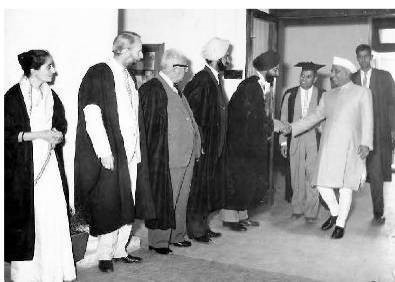 Mr. JK Kate introducing his top staff of the school to YB Chavan the Union Defence Minister. Surjit Singh Bedi, Senior Master, Mr. GS Punia, Bursar, Mr. SC Cowell, English and Discipline guru, Mr. Michael Vodden, Head of English and Ms. Malkani Head of Junior School. The Tall, Mr. Tankha is escorting the guest and Mr. Kate. (1964)
Mr. JK Kate introducing his top staff of the school to YB Chavan the Union Defence Minister. Surjit Singh Bedi, Senior Master, Mr. GS Punia, Bursar, Mr. SC Cowell, English and Discipline guru, Mr. Michael Vodden, Head of English and Ms. Malkani Head of Junior School. The Tall, Mr. Tankha is escorting the guest and Mr. Kate. (1964)
__________________________________________________________________________________________________________________________________________________________________
My Mentor, Mr JK Kate
By Mr. O. P. Bhatnagar (1961-1970) Ex-Hindi and Arts Teacher
Chief guest talking to Mr Vodden while Mr. OP Bhatnagar, Ex-Hindi & Arts Teacher and a versatile all-rounder, in the center looks on. Mr. Kate ‘s face is hidden behind the guest.
The picture shows the two great personalities behind the School’s establishment. Sardar Pratap Singh Kairon, CM of Punjab and Mr. JK Kate the Headmaster on the left. In between partly shadowed in Mr. OP Bhatnagar
I have been enthusiastic and dedicated. Both these virtues were there in Nabha’s atmosphere. It was because of Mr Kate’s polite and humane approach. We were never ordered about. Neither the HM nor the SM was bossy. So, we all worked with dignity and freedom. That was the secret of unmatched success of PPS.
When Mr Kate landed up in Sanawar, there was no free residence and furniture for staff. He controlled the finances so well that he was able to get these facilities for staff. He was always able to get the best results with minimum expenditure. He was a giant of accounts. His Kindness was conducive to good work.
There are several styles of management. I followed his style when I was principal. It worked. I give credit to my success to my mentor, Mr. Kate. I always had very strong emotions to PPS.
A candid outdoor picture of Mr. OP Bhatnagar the Hindi Teacher, doing sketching/painting which also he taught apart from many other roles he played in School.
___________________________________________________________________________________________________________________________________________________________
Special acknowledgment of the contribution of Mr. Kate by the long serving Board member, Col Sardar Naunihal Singh Mann, while proposing the vote of thanks at the Silver Jubilee Celebrations of The Punjab Public School, Nabha in 1985.
In step with the President, (1961),the inaugural yea. Governor VN Gadgil and Gen Kalwant Singh are a step behind (on their way to the porch to unveil the inauguration plaque). The small boy walking in front is Bhupinder Singh (B-20,1966) who later became a urologist in USA.
Founders’ Day October, 1981 (chronicle):
Dr.Karan Singh, Member Parliament and a leading political thinker and orator was the Chief Guest at the Annual Founders’ Day in 1981.
The headmaster Gp. Capt Grewal in his speech thanked Mr. Kate for his long association with the School, first as the Founders Headmaster and then as a member of the Board of Governors. Mr.Kate had settled at Pune after retiring as the Principal of Motilal Nehru School of Sports at Rai and member of the Board of Governors.
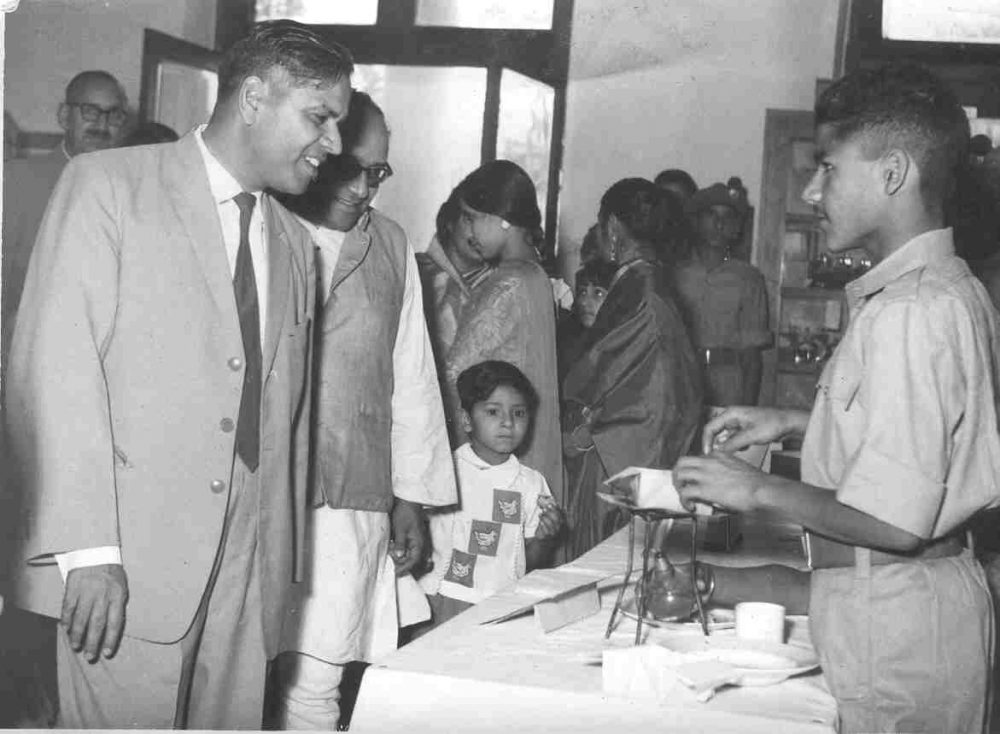
13th March, 1965 : Fifth Founders’ Day . Mr. JK Kate with the Chief Guest Shri Ram Kishan, the Chief Minister of Punjab. who presided over the function watching with interest and and admiration an experiment conducted by Surinder Gupta (J-1)at the exhibition.
________________________________________________________________________________________________________________________________________________________
ANNUAL Mr.J.K.KATE MEMORIAL INTER-PUBLIC SCHOOL ENGLISH DEBATE
In 2001, The Punjab Public School started an annual Mr.J.K.Kate Memorial Inter-Public School English Debate hosted by the School. It was started by Mr. Kate’s student Manjitinder Singh Bedi (J-82,1969), who was now the Headmaster of the School.
In 2005, the Dr. Harish Dhillon ,Principal, YPS , Mohali was the chief guest at conclusion of the Debate. In the write up below, in the school souvenir that year , he acknowledged and recogonised the contribution of Mr JK Kate to the School. Below are the main page and a cutting from it.
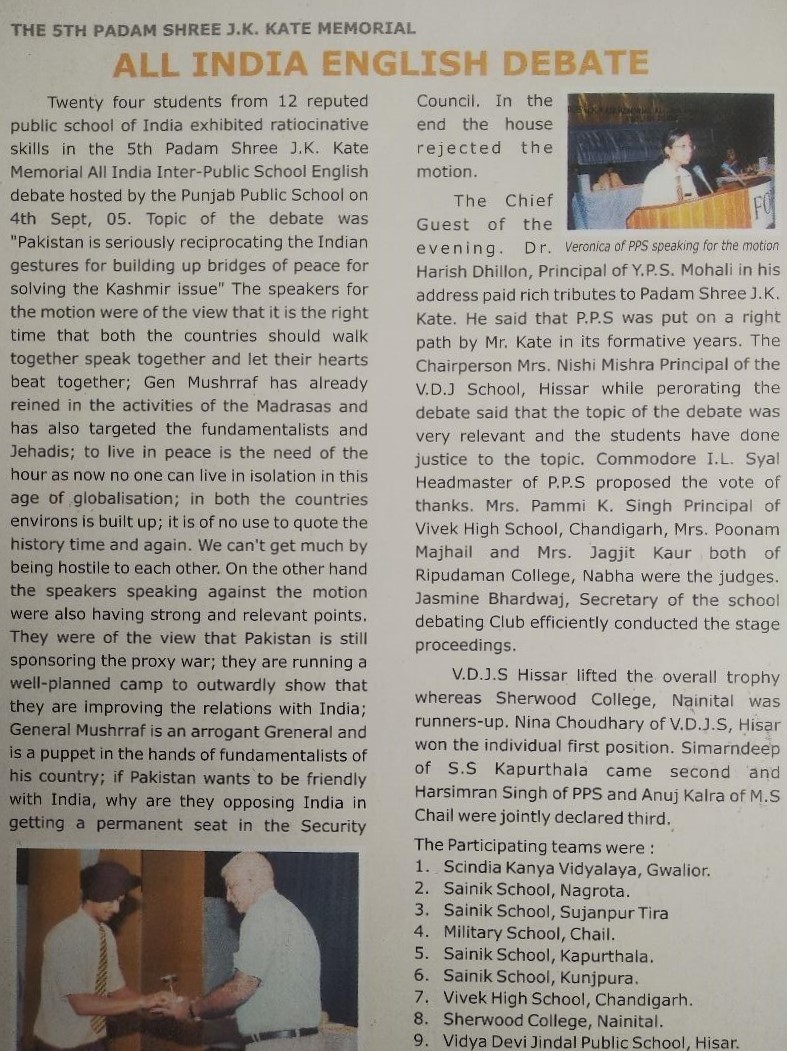
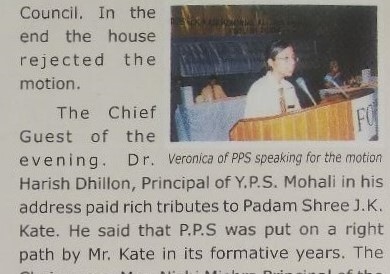
____________________________________________________________________________________________________________________________________________________________________
Reproducing just two of the many Compliments from dignitaries on completion of ten years of school, these two were published in the April, 1970 issue of the Chronicle.
______________________________________________________________________________________________________________________________________________________________________
Additions to the School brought about by Mr. JK Kate during his tenure as Headmaster.
Mr. JK Kate Padma Shri
Maximum progress and expansion of the school, including buildings and facilities was carried out or started by Mr. JK Kate in the first twelve years of the school. When he left, The School had one of the finest facilities and modern buildings among all the Public Schools of India. In fact, at a very young age the school was able to host the meeting of Indian Public Schools Conference on its campus with stay arrangements for all.
All this was possible because of the vision and leadership of Mr. JK Kate. It was because of his vision, astute planning and financial strictness, strengthened by his resolve, dedication, sincerity, honesty, dynamism and great liaison with those in power that he succeeded in achieving so much in such short a time. The Governors, CMs, Ministers, Bureaucrats and Parents were endeared to him because of his impeccable qualities.
These important additions carried out by him, are outlined below. There is an interesting story behind each project for roping in dignitaries, officers, Ministers, the government of Punjab and raising of finances to see them through.
1.The Playgrounds
The School did not have playgrounds when it started. It just had New Secretariat or Senior School (about 14acres) and Guest House or Junior School (about 16 acres). The playgrounds were made available by the forest department on strong persuasion of Mr. JK Kate. These were ready by second term of 1960, when the school started using them. The first chronicle of June,1960 mentions, “Our playgrounds are not all that they should be. This will be taken care of, hopefully, by start of second term. At the moment we are grateful to the Principal, Ripudaman College for providing their playgrounds across the road”.
To sum up, this is what Mr .Kate has written in his article “Pride of Punjab’:-
“When the strength crossed 200, we realised, that we did not have enough playgrounds. Therefore, we approached Mr. Kairon again suggesting he should give us nearly 100 acres of forest land opposite the Guest House. The Forest Department hesitated to surrender the whole patch of land. However, with the intervention of the Chief Minister, we secured significant land along with four fishing ponds. Thus, we now had more than 90 acres.” (Written in in 1985, this land area is the total area at the time, Mr Kate left.). The land was given to School in three lots in 1960 at the start and later in 1966. Then of course in 1967 when Sham Bagh was handed to School.
2. Addition of The Old Secretariat and the construction of Toilet block for boys in addition to Housemaster’s accommodations.
With growth of School, the accommodation in school was becoming insufficient. Mr Kate kept asking for more from the government.
In Mr. Kate’s words: – “The pressure for admission was increasing, and we soon realised, that even these two buildings were inadequate. 1, therefore, thought of taking over the old Secretariat building also. The Government officers who were staying in the Guest House were shifted to the old Secretariat by now. One of them who scented this move remarked that “this was not a school but, Cancer” which would spread all over Nabha”.
On 1st January, 1961
As usual, Mr. Pratap Singh Kairon came to our help and ordered the construction of a few bungalows behind the old Secretariat for Government officers and handing over the old secretariat to us. Punjab Government also handed over the Old Secretariat building to the school (1 acre and 14marla).
With the increase in the strength, the number of staff also increased. Therefore, old secretariat was converted into staff quarters, by making some additions and alterations. This solved, though temporarily, the problem of accommodation. In January, 1963, Ravi house was shifted to part of Old Secretariat as accommodation was falling short.
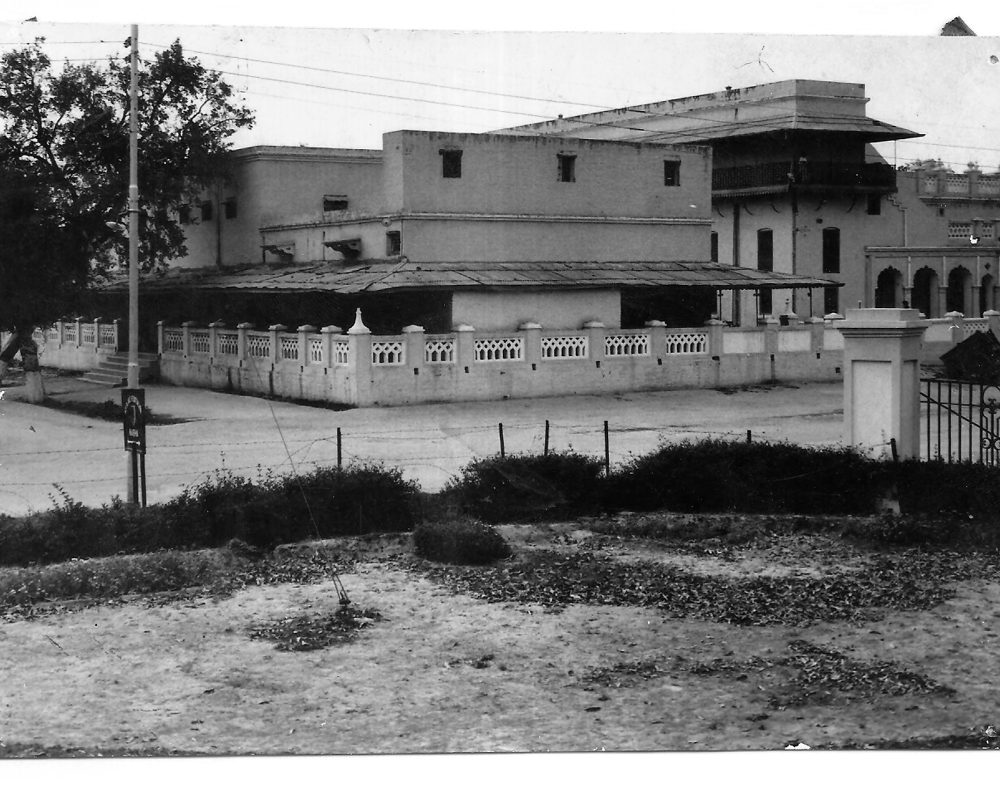
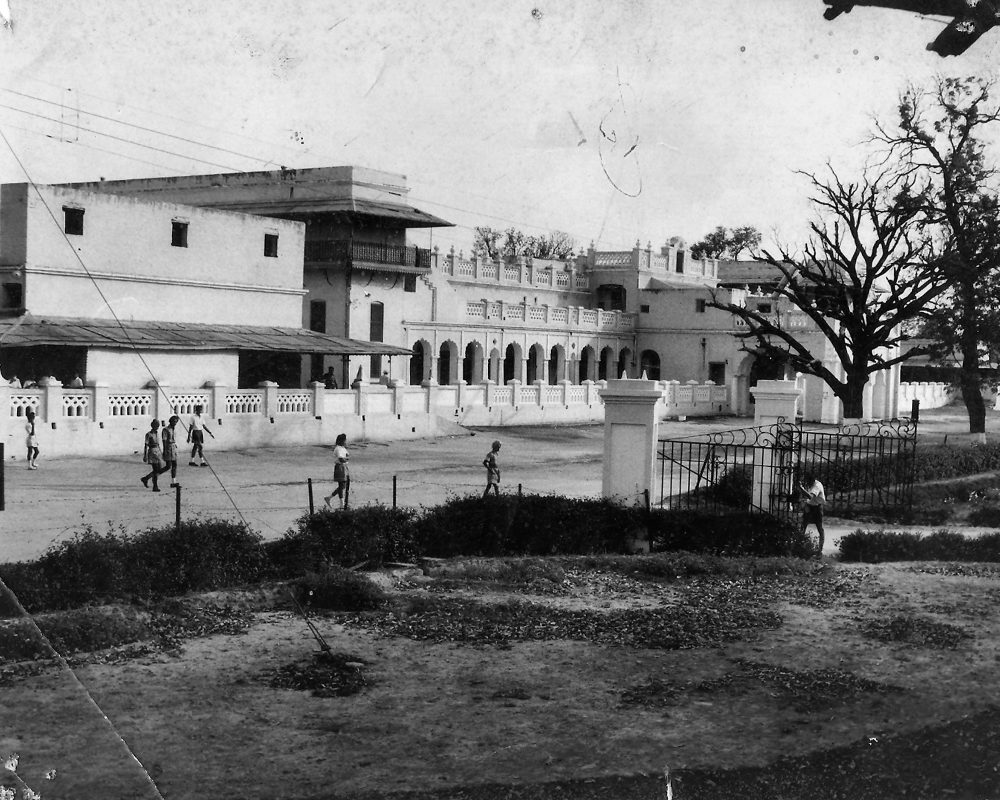 Old pictures of Old Secretariat. From inside the gate of Senior School facing Ripudaman College side.
Old pictures of Old Secretariat. From inside the gate of Senior School facing Ripudaman College side.
Present day (2010)Old Secretariat from the Guest House side
By February 1964 Ravi and Sutlej houses were residing in this building. For this purpose, a new toilets and baths complex were constructed in the center at the back of the building and including houses for Housemasters at the back facing the side roads.
Much later it came to be known as Middle House.
3. The Poultry Farm
In 1962, Mr Roger Miall, a VSO (volunteer Services Overseas) from UK (1962-63), sent by British Council, had started the flourishing “Poultry Farm” which grew from 300 chicks to many years later, couple of thousands of chicks at one time. Mr Kate wanted the school to have its own eggs supply plus the children who helped in the poultry learnt a lot.
In January, 1967, (February, chronicle) 1200 chicks were further added.
According to Mr Roger Miall (VSO 1962-63), “With the help of some nearby Peace Corp workers, my new VI class and I started a poultry farm outside the Junior School with 300 one day old chicks. Soon the boys learnt best practise for keeping chickens and we kept graphs of feed costs and egg production. I visited the school, some nine years later, and I was amazed to find that the poultry farm had been greatly expanded. Not only was the school diet improved, but the chickens had become a source of outside income”.
Many years later (around end of 1970s) , this poultry farm gradually fizzled out and does not exist anymore.
4.The Staff Colony (January 1963)
Mr JK Kate wrote in his article on school (1985), “The portion of the land adjoining the road and what they called “Horlicks Canal” was earmarked for the staff colony. At that time the wastewater from Horlicks was not put into that canal or it was so small in quantity that it did not stink at all. Having read the Potpourri in the recent issue of P.P.S. Chronicle, I realise how the staff at present living there must be cursing me-, but my main idea was that the staff colony should be between junior and Senior School”.
The construction of the staff colony started at full throttle in January,1963, between the Main Grounds and the small Horlicks canal. It was across the main road as it turned from along the canal towards Junior School gate.
In fact, it was opposite to the Junior school. On its completion it solved to a large extent the problem of standard accommodation for the teaching staff. The Staff quarters were very well planned. The Colony soon became a beehive of activity. (Chronicle, Feb, 1963). Lot of social activities took place. With intermixing of staff kids, it became one big Family.
One end of the colony was towards the Junior School, the other end was towards the kutcha approach road from Senior School to play grounds. Across this kutcha road was a PWD building which too was handed over to school. This served as Staff Club which existed then. It had badminton courts. Staff dinners and tea for guests were regularly held here. It was a venue for many ‘welcomes and farewells. Thus, the staff had busy social life too.
In August,1966 (from the Chronicle): Two more staff quarters have been completed.
The Staff Colony in 1964, Mr. Michael Vodden, Mrs. and Mr. Tandon and Mr. Roger Burridge (VSO after Roger Miall), who sent this photo.
October, 1963:
5.The Fisheries.
(In the initial years there were fishing ponds too, in school. They were behind the Staff colony and opposite to the Junior School across the road. These lasted about three years. They were difficult to maintain and were closed down. Later, they have been used for different purposes as sunken grounds including horse riding and training and now, I believe for parking).
6. The Aviary, January,1964 (from Feb Chronicle)
Roger Burridge (VSO from UK) and Dick Pine (Peace Corps worker, USA) have started an aviary in the Junior School. They already have pigeons, parrots, and babblers and they are hoping to catch rare birds soon.
7.The Swimming Pool, 25th February 1964
According to Mr. JK Kate, “Lt. Gen. Kalwant Singh was very keen on the construction of a swimming pool. The question arose where to locate it. As juniors also needed swimming and the playgrounds were already in front of the Guest House, we decided to locate it in the Guest House compound”.
26th January ,1964 Mr. Kate digging the foundation of the Swimming Pool with help from Office Superintendent Mr. NK Jain.
Time for ladoos! Mr. Tandon and Mr. MN Tankha with son Monty.
Dick Pine, Peace Corps volunteer seen in the corner was the first in charge of the pool. He laid down strict International rules for the Pool. Mr. Goldberg another Peace Corps volunteer took charge after him.
26th January (from the Chronicle):
Republic Day: Post flag hoisting Ceremony in Junior School there was inaugural excavation of the Swimming Pool led by the Headmaster Mr. JK Kate himself. Laddoos were distributed.
25th February (from the Chronicle):
Ever since the School had started, the need for a state of art swimming pool was felt by all and sundry. In the absence of a swimming pool in the School, the students would go to the Rohti canal for a quick dip under the supervision of teachers. Needless to say, it was a risky proposition and Gen. Kalwant Singh was keener, than anybody else that the School must have a pool of its own. So, it was befitting that on 25th February 1964, the foundation stone of the Swimming Pool was laid by none other than Gen. Kalwant Singh himself. Since Nabha at the time had a serious waterlogging problem, the floor of the Pool was constructed on raised ground and its dimensions were 25m long and 10m wide. In his inauguration speech Gen. Kalwant Singh said:
“I maintain that in our climate a swimming pool in a school in the plains is a must. I am of the view that everyone should consider it a duty to learn to swim. Swimming is an art superior to all others in the formation and preservation of health”
Neale Hutchinson a VSO from UK was also sometime in-charge of the pool in 1966. Most foreign volunteers working in school usually took care of the Pool.
By August, Swimming Pool was almost complete. We anxiously await the arrival of the Filter Plant. It became almost ready by end of October 1964 and will became operational by next summer. (as mentioned in the November 1963 chronicle).
On Founders’ Day, 13th March, 1965,
Mr. Kate also announced the completion of Swimming Pool.
In May,1965, the first Inter-House Swimming Competition was held.
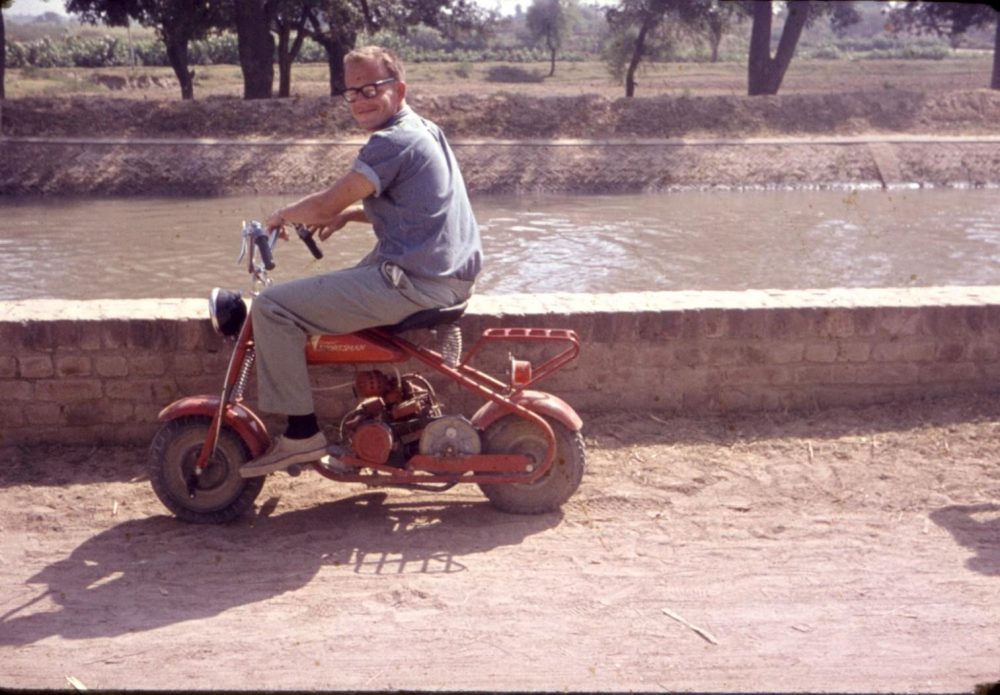 Before the construction of the Swimming Pool, Boys used to go for swimming to Rohti canal near Junior School. Mr Dick Pine (US Peace Corps) and Roger Miall (VSO,UK) overseas volunteers used to take the boys there. Picture shows Mr. Pine with his unique mobike in 1962 at the canal.
Before the construction of the Swimming Pool, Boys used to go for swimming to Rohti canal near Junior School. Mr Dick Pine (US Peace Corps) and Roger Miall (VSO,UK) overseas volunteers used to take the boys there. Picture shows Mr. Pine with his unique mobike in 1962 at the canal.
In January1966 after the passing away of Lt Gen Kalwant Singh, in his chronicle article on Lt. Gen. Kalwant Singh, Mr.Kate recalled the early days when Gen.Kalwant Singh would regularly visit Nabha to inspect the progress being made to get the School ready for inauguration before 14th April 1960. Every time Mr. Kate would go to Chandigarh, Gen.Kalwant Singh would invariably ask him,
“When are you going to have a Swimming Pool in the School?”
Below on next page, is an excerpt from the Speech of Mr. JK Kate on Founders’ Day (March 1964). Giving an idea of the huge cost at that time, incurred for the swimming pool.
However, The Punjab Public School became one of the few Public Schools in India to have a pool in 1965.
It was definitely a very modern pool at that time.
8 & 9. THE NEW DINING HALL (JK Kate Dining Hall) and HOSPITAL
The circular room behind the Main Hall (earlier Assembly Hall later Library) was used as the dining hall when the school started, functioning on 14th April 1960. (Mr. Kate in “Pride of Punjab”).
The first Dining Hall and the lone girl in School, Late Indira Surjit Singh (S-33) daughter of Senior Master Dr Surjit Singh.
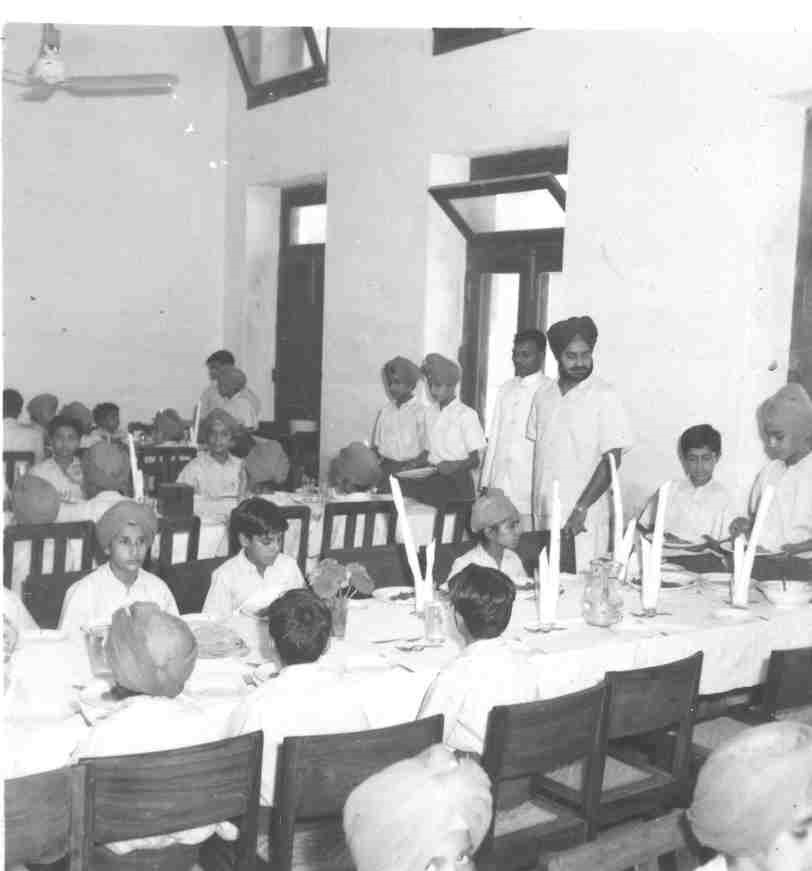 Another view with Head of English at start of the school, Mr. Joginder Singh standing and observing.
Another view with Head of English at start of the school, Mr. Joginder Singh standing and observing.
Later on, the big Central Hall and the big Hall (see below)facing Ripudaman College grounds in the Old Secretariat were used as the dining Halls at one time or the other.
 The stairs on the left under the tree led to the dining hall part of Old secretariat before the new Dining Hall was ready.
The stairs on the left under the tree led to the dining hall part of Old secretariat before the new Dining Hall was ready.
From the Chronicle, August 1964 :Owing to the ever-increasing strength of students in PPS, a dire need was felt for a proper Dining Hall and Hospital. In the month of August, the vacant land to the right of New Secretariat Building was earmarked for these and construction started at full swing. On completion, the new Dining Hall and Hospital proved their utility in no time. The spacious Dining Hall could accommodate the entire school with ease while the need for Hospital cannot be overemphasized in a residential school.
Under Mr. JK Kate ‘s efficiency and keen supervision, multiple projects namely Dining Hall, Hospital and the Swimming Pool were finished within the year, 1964 and made functional by 1965.
On March 13, 1965, The School celebrated the fifth Founders’ Day and the function was presided over by Shri Ram Kishan, the Chief Minister of Punjab.
Mr. Kate also announced the completion of Swimming Pool, Dining Hall and the new Hospital, which incidentally happened to be fully occupied at the time with more than 40 students down with flu.
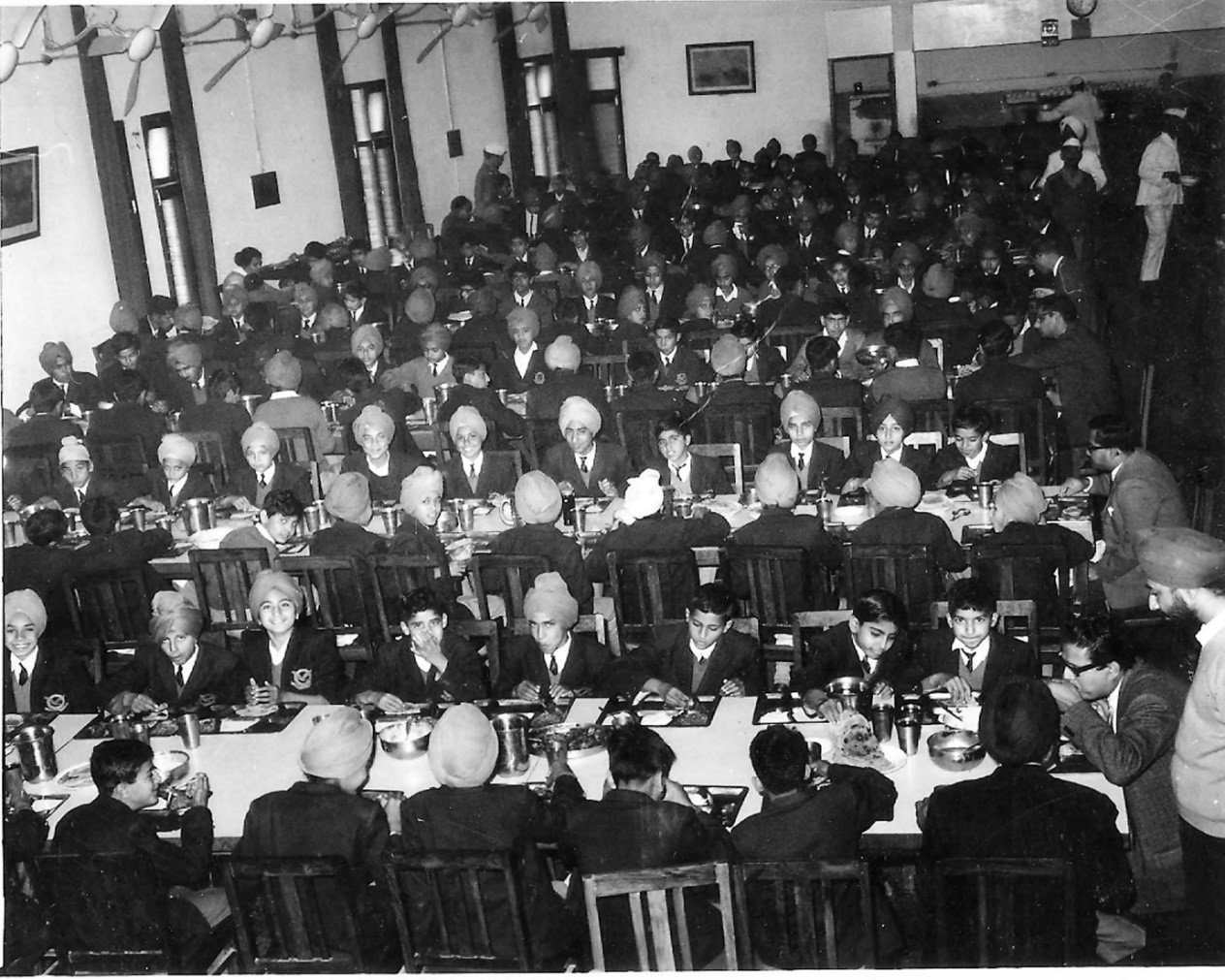
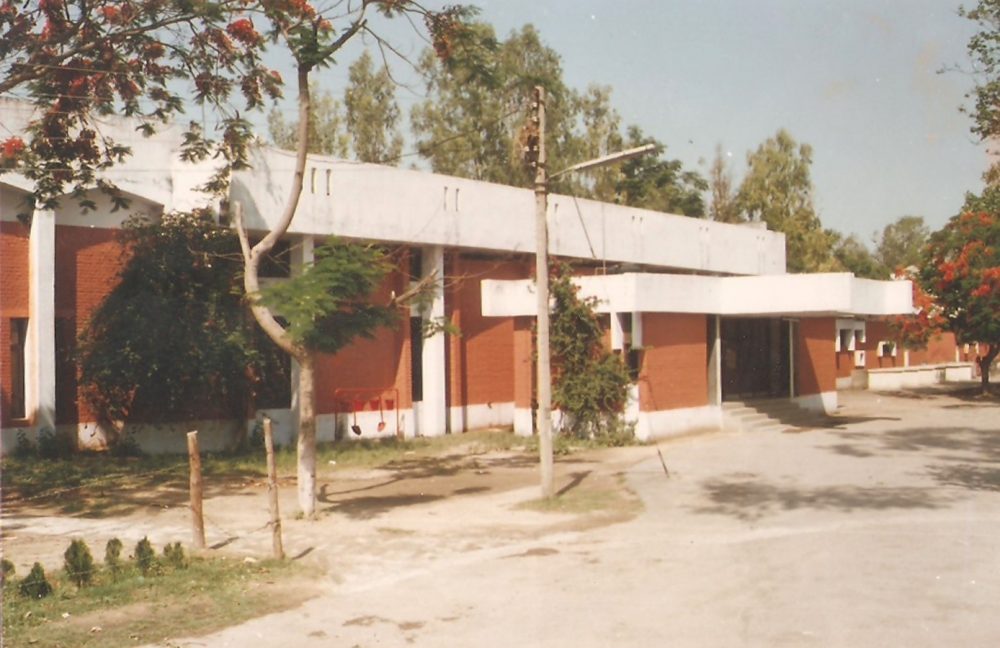
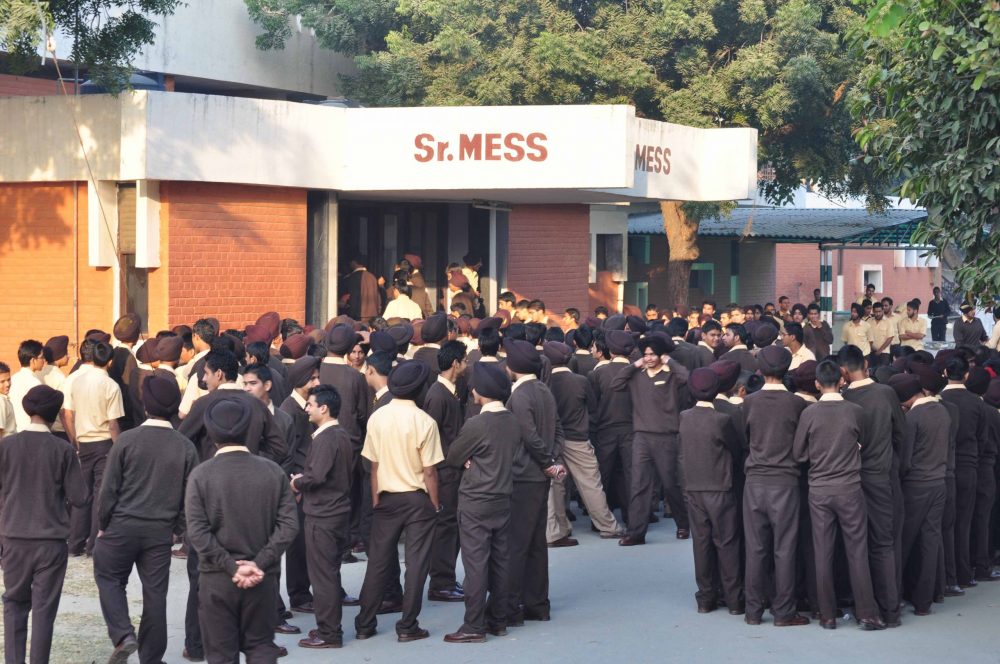
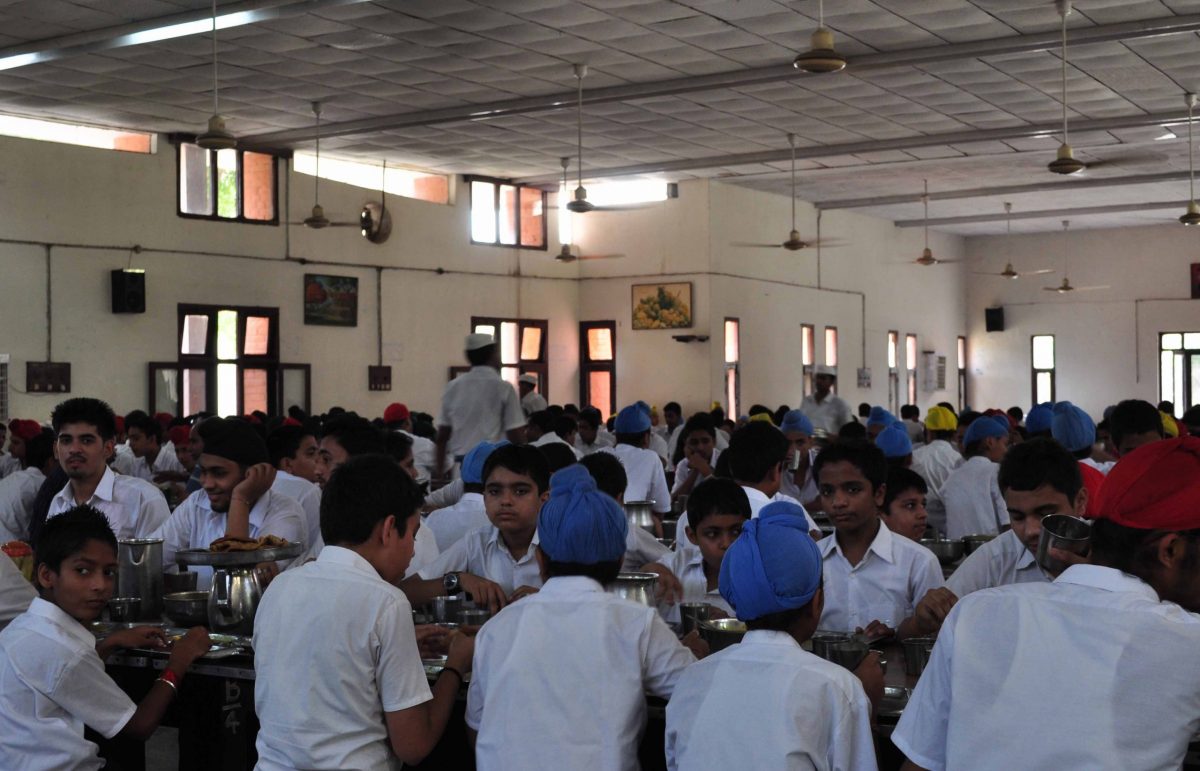 The New Dining Hall after completion
The New Dining Hall after completion
The Stage in the Dining Hall
Initially, we were staging plays on an improvised stage in the hall of the main building or in the circular lawn in front of senior school, but it had no proper Green Room and other facilities. So, according to Mr. Kate “ we decided to extend the dining hall by adding a stage and property room. So, the dining hall served as a theatre for stage shows as well as screening of films”. (This was to be used for the first time on the Founders’ day of 1967–February, chronicle). In addition, a bakery was also added to the kitchen.
August,1966 from the Chronicle: work on for the Stage and Green room in Dining Hall and for Bakery is on and should be ready by a month.
The Hospital
10.Agriculture
January, 1966 (from the chronicle)
As a part of ‘grow more food’, a plot of land next to playgrounds is being used to grow wheat. Groundmen, have tough time keeping Neelgai and stray animals away. Mr GS Punia, the Bursar used to supervise Agriculture. School was now producing its own grain to some extent.
But agriculture was given up after the experiment. It was not sustainable for long because of wild neelgahi and other animals.
April, 1969 Chronicle: Headmaster’s speech: The School poultry is producing excess of 600 eggs daily. Agriculture farm of 12 acres is producing 200quintals of wheat. This year we intend to concentrate on our fisheries.
11.Quest for more land continues:
Founders’ Day March 1967:
Mr JK Kate felt that even these were not sufficient. His persuasion for more land continued. With the result a meeting was held on 28th September, 1965.
The Committee of Shri Dharampal Singh, Chief Conservator of Forests, Sh. Mukhtiar Singh, Deputy Director of Agriculture, Dr Tejwant Singh , Principal, Gram Sewak Training Center and the Headmaster met at his residence. Lt Col Choudhury Raghuvender Singh, a member of the Board was also present and participated in the discussion on question of additional land required by the School. (from the chronicle)
This bore result, by 1967, further addition was made to the playgrounds as mentioned by the headmaster, in his speech while thanking the Punjab Government on the Founders’ Day, 1967. Another proposal of Mr Kate was also approved by the board to increase the scholarship amount as costs had risen.
From the Chronicle: “Shri Dharam Vira, the honourable Governor of Punjab was the Chief Guest of the Founders Day in 1967. It was one of those rare occasions that both the Governor and the Chief Minister (Mr. Justice Gurnam Singh) were present at the function. In his speech, Mr. Kate thanked the Punjab Government for increasing the Scholarship amount from Rs.1,500 to Rs.1,900, and for allotment of 30 acres of land to the School near the Junior School, thus paving the way for bigger and better playgrounds for the children.”
The land had handed over by Forest department was after cutting the trees. The School had no way to remove the stumps. It would have taken over a year by labour alone. So, what did MR JK Kate do? According to him, “When the forest Department handed over the forest land opposite the Guest House to us, they cut all the trees leaving thousands of stumps all over the place and we found it an extremely difficult and costly proposition to dig out these stumps and level the land to make suitable playgrounds. When I mentioned this difficulty to the then Army Commander Lt. General Harbaksh Singh of Western Command, he promptly solved my problem by making it as one of the exercises for an Army unit. With army bulldozers and other equipment, they uprooted the stumps and levelled the whole area within a week.”
12.Fishery ponds and additions to Staff Colony and a new tube well
In the month of January 1967,
The Staff Colony near the Junior School saw a lot of activity as new construction continued and the work on fishery pond project was also going on in full swing adjacent to the colony. Mr. Kate wanted the school to produce its own grain, eggs and protein rich fish.
August 1966 chronicle: A new tube well was dug up to supply water to the Staff Colony and the Fisheries.
(Fishery ponds were not very successful; in later years it became training ground for horse riding, today in 2021 it is being used for parking).
13. SHAM BAGH
Mr. JK Kte felt that the new Secretariat Building would not be able to accommodate classes and hostel for too long and ideas were being floated for shifting the hostel to some other place. These efforts would later culminate in the form of a new residential complex at Sham Bagh.
According to Mr. JK Kate, “We were still short of accommodation as we had come to realise, that strength of the School should be raised to 500 to make it an economic unit.
The Maharaja of Nabha was keen to sell his palace Hira Mahal. As it stood between the junior and Senior schools, I thought if we purchased it, it would give us a continuous piece of land, and bring the junior and Senior schools together. I approached the then Chairman of the Board, Shree Dharma Vira with the suggestion that the Government should buy Hira-Mahal and give it to the school. He immediately visited the palace with Mr. Gyan Singh Kahlon who was then Chief Secretary. Mr. Dharma Vira felt that by purchasing the palace, we would get mainly land as the buildings were old dilapidated and not ideally suitable for the school. He suggested the nursery in Sham Bagh adjoining Senior School.”
The school already had lot of land by then and needed well equipped Houses (Hostels), in the vicinity of the Senior school. Therefore, we thought of acquiring Sham Bagh, which had a government nursery, and we succeeded in getting that too.” (more than 14.5 acres)
(personal note: In hind sight, Mr. Kate’s idea was very sound. The school would have been one entity from Senior School to Junior School ,Staff Colony and playgrounds. In reality later, the Hira Mahal was colonised and a housing came up in huge area between the two wings of the school bifurcating them. It also increased habitation and public traffic in the area. However, Mr. Dharam Vira’s point may have been that government will not give money for purchase of Hira Mahal and later for construction of hostels, but can hand over the Sham Bagh which was a government Nursery. Whereas, loan could be taken for the construction work.- – Dr Jashanjot)
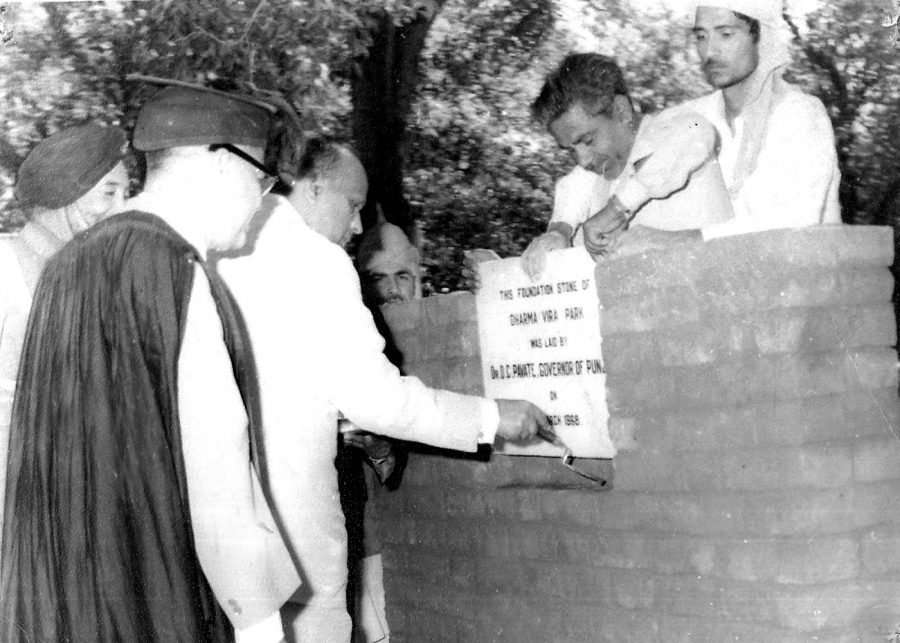 Foundation stone of ‘Dharamvira Park’ laid by Governor Dr DC Pavate Mr Kate looking on. Founders’Day, 1968.
Foundation stone of ‘Dharamvira Park’ laid by Governor Dr DC Pavate Mr Kate looking on. Founders’Day, 1968.
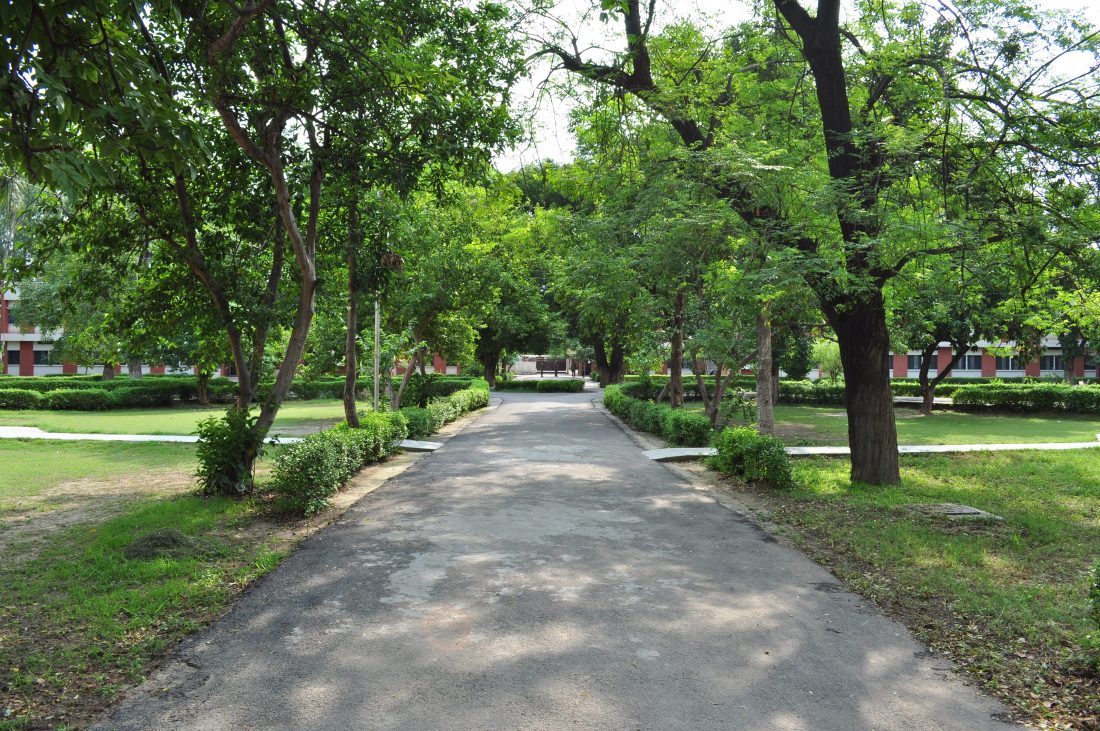
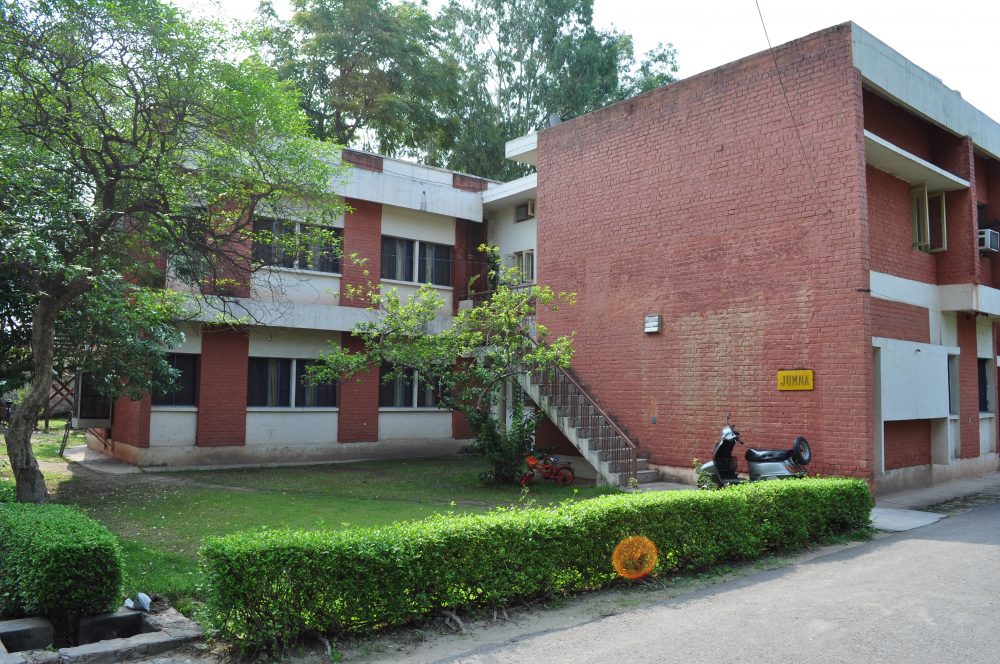
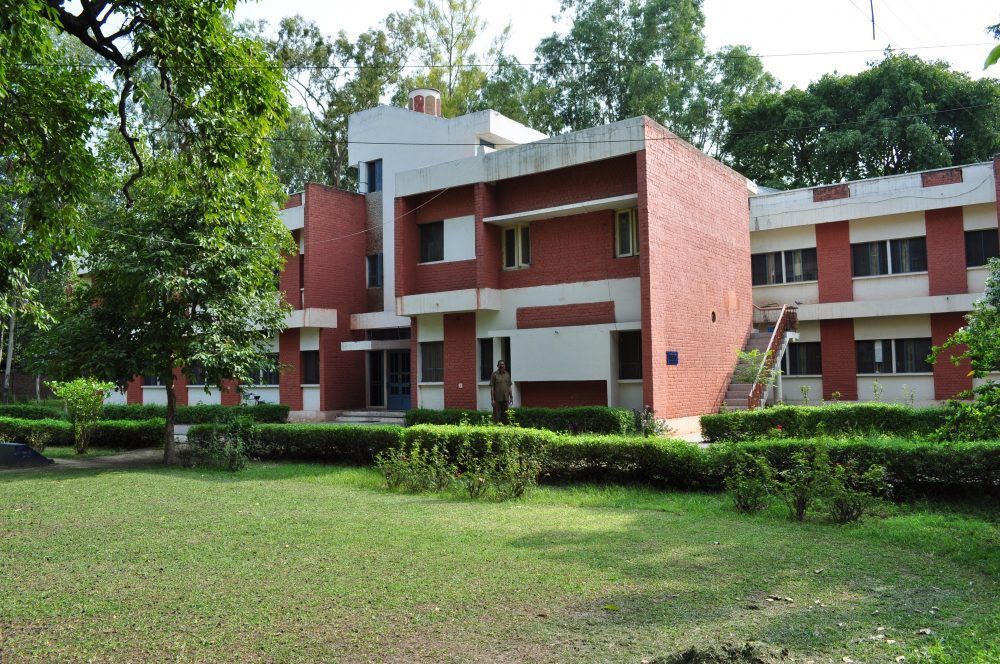
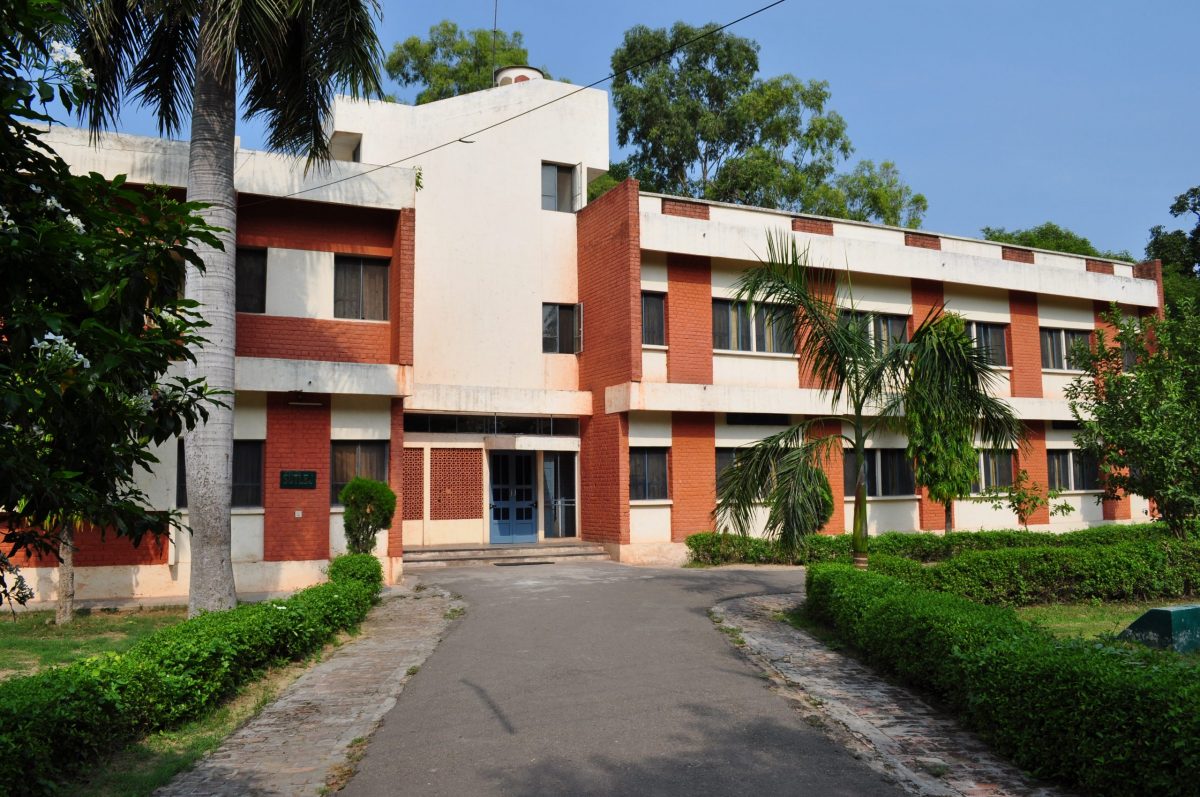

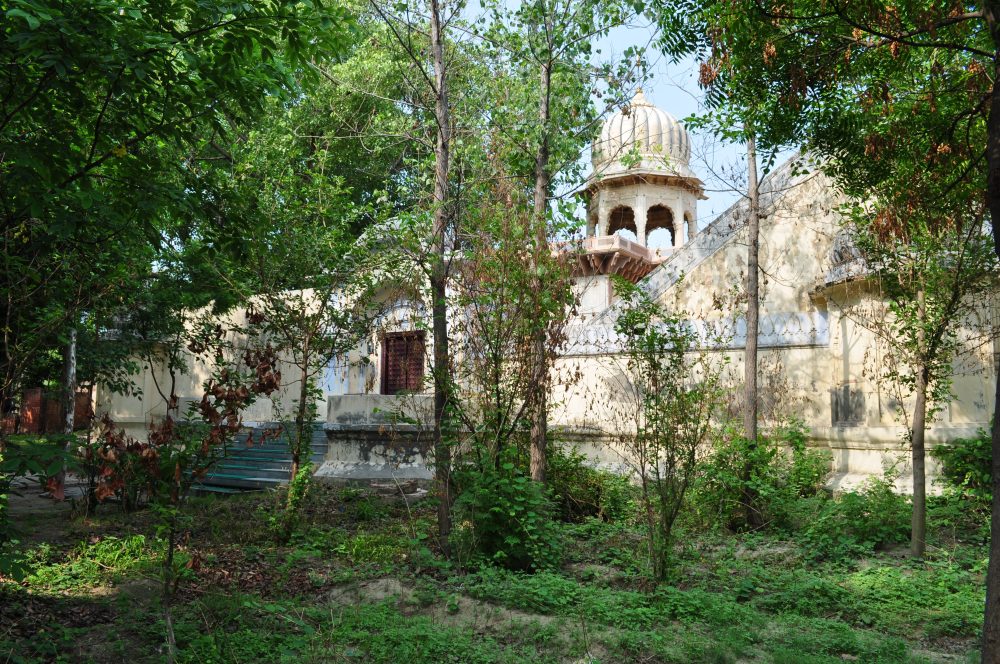 The Sham Bagh Hostels and Shahi Smadhs in side.
The Sham Bagh Hostels and Shahi Smadhs in side.
March 9,1968
Mr. D.C. Pavate, Governor of Punjab and Chief Guest at the Annual Founders’Day laid the foundation stone of the new hostel in Sham Bagh, adjacent to the Senior Mess. A loan had already been sanctioned by the Punjab Government for the same and it was decided to name the new hostel block as “DHARMA VIRA PARK” as a tribute to the former Governor of Punjab who had used his influence to get the loan sanctioned from the Government of Punjab. Initially, the headmaster Mr. JK Kate was hesitant to accept the loan, but Shri Dharma Vira had assured him, “In case you are unable to pay all the installments, the Government would not take away the buildings and would be compelled to write off the amount”
In February 1969, from news in the chronicle: Actual strength of School is 506 (323 in senior and 185 in Junior school). Beas is happy to have moved to new building in Dharamvira Park. Jumna will shift in March. Ravi and Sutlej will hopefully, shift next term.
However, by July 1969, next term, Beas, Jumna and Sutlej Boys moved into new imposing buildings of Dharamveera Park. (August chronicle).
29th November, 1969 from the chronicle : A portion of the PWD building near games fields has been transferred to the School. It will be converted as Staff quarters.
In March 1970, At the Founders’ Day , Dharam Vira now as Governor of Mysore and Dr. Pavate, Governor of Punjab were both present.
Dr. Pavate, the Governor of Punjab proposed the vote of thanks in his capacity as the Chairman of Board of Governors and later on Shri Dharma Vira officially inaugurated the Dharma Vira Park in the Sham Bagh.
Within a short time, the school had added ample playgrounds, a spacious dining hall, swimming pool and hospital. With the acquisition of forestland and Sham Bag we had spacious and enough playgrounds to enable the whole school to play games simultaneously.
__________________________________________________________________________________________________________________________________________________________
(Projects undertaken by Mr Kate in1972, before leaving, with generous support from Dr Pavate the Governor of Punjab and chairman of the Board, but completed later in 1973 during Mr Atma Ram Gupta’s tenure as Headmaster)
14.THE AUDITORIUM
Foundation of The Auditorium, March, 1971 (from April, 1971 issue of the Chronicle).
As mentioned earlier the dining hall was extended to have stage performances and screening of films etc. According to Mr. JK Kate, “Later, we found that the noise in the pantry proved a great nuisance when the stage was being used or a film was screened. Therefore, we decided to have an Auditorium. Again, the questions of funds arose. As we were already paying loan installments, we approached the Government for grant of rupees three lakhs, if I am not wrong. At that time Sardar Balwant Singh was the Finance Minister. When I explained to him our financial position he took a more lenient view than the Finance Secretary and agreed to give half the amount as Grant and the remaining, half as loan. This was done when Mr. Pavate was at the helm of affairs as Governor of Punjab. We, therefore, named this auditorium after him.”
Sardar Parkash Singh Badal, the Chief Minister of Punjab, was the Chief Guest at the 11th Annual Founders’ day in 1971. The Headmaster welcomed the new members on the Board and thanked parents, Raja Narinder Singh and the Punjab Government for providing funds for the auditorium that was aptly christened “Pavate Hall” in the honour of Punjab Governor Dr. Pavate. It was to be built at a cost of Rs 5 lacs. Sardar Parkash Singh Badal laid the foundation stone of the Auditorium.
As the construction of auditorium is in progress. The extension of the pantry and kitchen in Senior School was completed last month. This will give more room to the cooks and kitchen attendants to work there. (July issue of chronicle, 1971).
By December ,1972 (after Mr. JK Kate had left): The new auditorium was ready. In terms of designing and architecture, it was a masterpiece. Acoustically designed with a graceful balcony, it could accommodate the entire school with ease. (January, chronicle of 1973).
10th March 1973 ,13th Founders’ Day: It was formally inaugurated by Giani Zail Singh, the Chief Minister of Punjab on this Day. Mr Atma Ram Gupta was the Headmaster, then. (From different issues of Chronicles)
Inauguration of the Auditorium by CM of Punjab, Gian Zail Singh on the right is Headmaster of school. in 1973, Mr. Atma Ram Gupta , who took over after Mr. Kate had left.
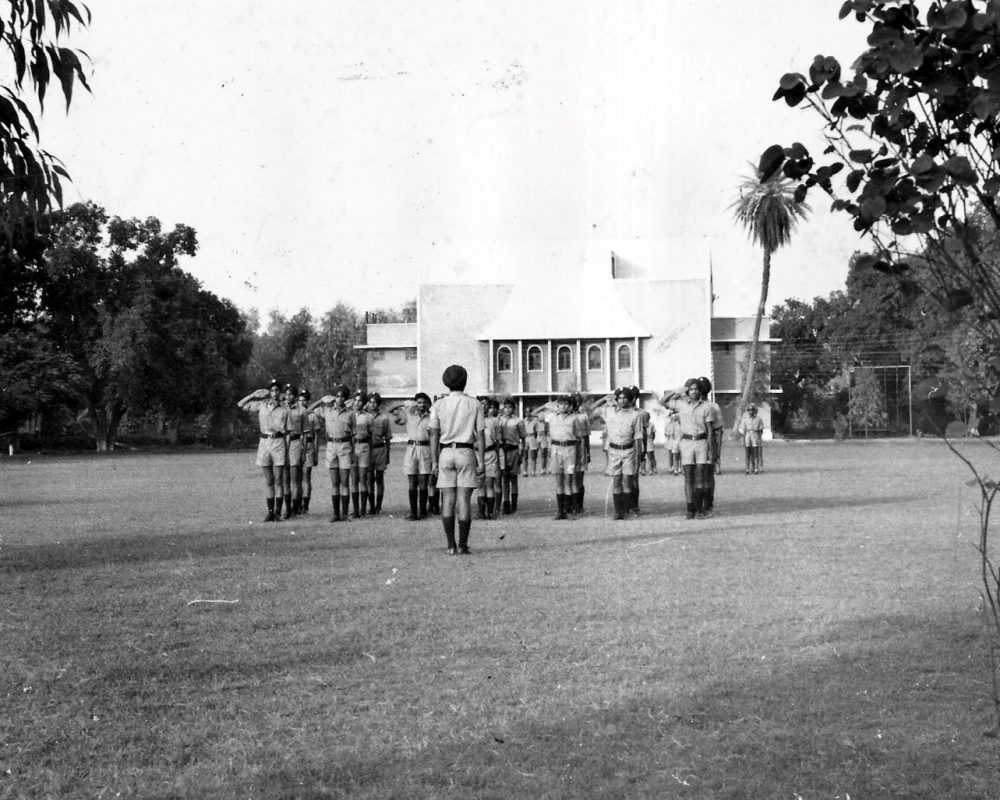
An old picture
15.Foundation of The Science Block and Founders’1972
According to Mr JK Kate: “On one occasion Mr. Bagla, the then Secretary to the Governor, visited the school. When we were walking through the corridors of the Senior School, he noticed that the floor had sunk in many places. When he advised me to get it repaired, I regretted my inability to do so due to paucity of funds. He immediately suggested that I approach the P.W.R.S. Fund for some grant. I said to him, If you are prepared to give us financial help for repairing floor, please give us bigger grant to enable us to have a Science Block with well-equipped laboratories, instead of repaired floor.” We received I think a couple of lakhs of rupees for this project also. This was the last building planned by me.”
The Science Block
Dr. G.S.Dhillon, Speaker Lok Sabha was the guest of honour at the Annual Founders Day in March 1972. In his speech, the Headmaster expressed great satisfaction at the growth of the School during the last twelve years. In the year 1971 PPS had won the quadrangular championships in hockey, football and cricket.
The Chief Guest shared his long association with the School ever since it began and expressed happiness at its phenomenal growth.
“I remember that every time I came here, he showed me new plans and new schemes – he had his eye on His Highness’s buildings and neighbouring property and land. I see today that my conviction has not gone wrong. When I came here today, I was amused to see that all those are now property of the School. It is a big achievement. I really wonder how the Maharaja’s palace and the site around it was ignored or overlooked or how the Maharaja escaped.”
The Chief Guest also laid the foundation stone of the new Science Block that would later house fully equipped, state of the art Physics and Chemistry Laboratories.
Views of the Labs.
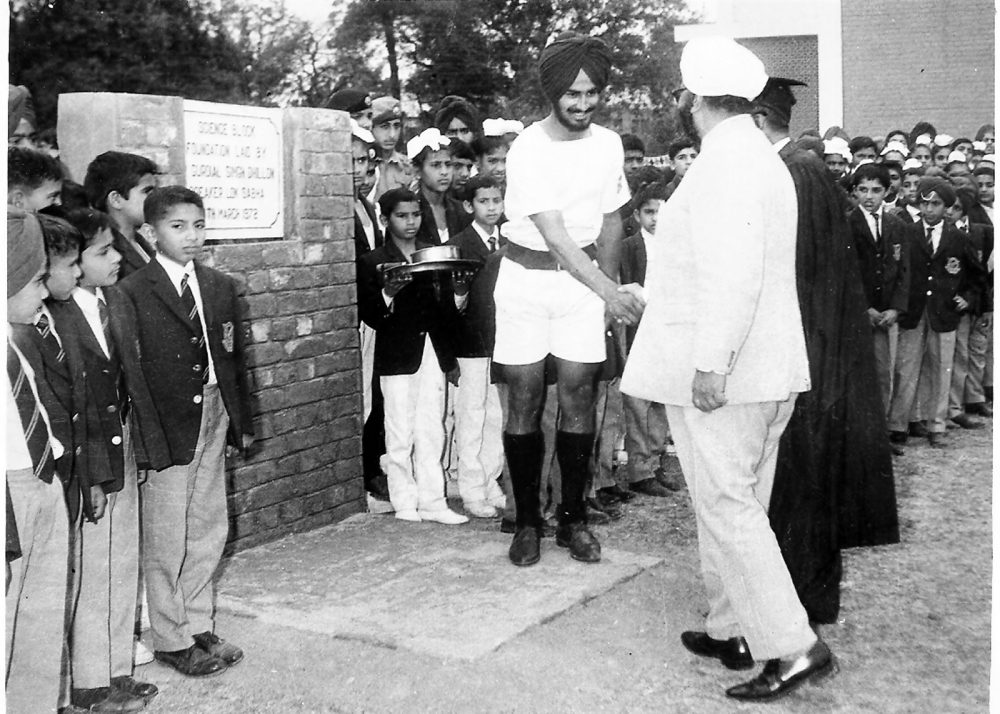 Lok Sabha Speaker Sardar GS Dhillon laid the foundation stone of the Science Block. Mr. Kate is hidden behind him in ceremonial cloak and cap.
Lok Sabha Speaker Sardar GS Dhillon laid the foundation stone of the Science Block. Mr. Kate is hidden behind him in ceremonial cloak and cap.
Science Block inauguration by Sardar Swaran Singh, Defence Minister of India with the headmaster Mr. Atmaram Gupta.
The following speech next year after the Auditorium and Science Block had been completed, in the School Assembly, shows how much Mr. JK Kate was able to extract from the powers that be and the backing they gave him. Also why, the Auditorium was named after Dr. DC Pavate.
May 8, 1973: In the Assembly held on May 8 , 1973, the then Headmaster, Mr. Atma Ram Gupta, praised the contribution of Mr. D.C. Pavate, the outgoing Governor of Punjab and Chairman of the Board of Governors, Ever since assuming office in 1967, Mr. Pavate had taken a keen personal interest in the growth of PPS. He was instrumental in getting a grant of Rs.2,50,000 sanctioned from the Punjab Government for the construction of the Auditorium, a grant of Rs.2,50,000 from the Post War Services Reconstruction Fund for the construction of Science Block and a grant of Rs.78,000 for new staff quarters. (from the School Chronicle).
All this happened because of the relentless pursuit of these projects by Mr. JK Kate.
Mr. JK Kate in his historic article “Pride of Punjab” has not failed to complement the men behind all this expansion in School and the construction work carried out during his tenure. These professionals went a long way in keeping the costs down and finishing projects on time. He states:
“It would be worthwhile to mention here, that all our building plans except the Auditorium were prepared by our architects, M/s. Warerkar and Associates at a lower rate than usual. Our labour contractor Shri Pyarelal was almost illiterate but had great insight in construction work, He could foresee the problems and difficulties in executing the plans and would also be able to suggest solutions which sometimes engineers were unable to find, That was, why we carried out all the new construction works departmentally. Mr. Bansal our Estate Officer works hard by looking after both maintenance of old and construction of new buildings.”
(According to Mr. Pushapraj Arora, PA to Mr. Kate:: Mr. GS Punia, who oversaw all the construction and was so impressed with Pyarelal, that he gave him the contract to build his house which even to this present day stands unique and impressive in Nabha).
A unique picture of 1970 Founders’ Day. Mr JK Kate leads the two excellencies Governor Dr. DC Pavate in the middle and Ex-Governor Dharamveera (who had shifted to Karnataka). We have ‘Pavate Hall’ the auditorium and ‘Dharamveera Park’ the boys hostels.
__________________________________________________________________________________________________________________________________________________________
The Headmaster, who mentored many a Headmaster
Mr. JK Kate had handpicked his staff from all over India. He had a knack of recruiting the best. His very efficient administration of the School with vision, compassion, approach to education and strict financial management rubbed off on the staff that served under him. He became a natural mentor to all the teachers who worked under him as a team. They tried to outperform each other in a friendly competition. Each teacher was expected to perform multiple duties as well as teach more than one subject. The Staff and their family’s needs were well looked after. They did not have to waste time on personal errands, office staff took care of that. They only concentrated on students and teaching. They had a club for socialisation and sports. The staff had regular Home-Day or term dinners with the Headmaster for informal interaction and feedback.
Mr. JK Kate gave ample opportunity to teachers to improve and learn the latest methods of teaching their subjects. According to him:
“I am also happy to learn that P.P.S. results in English have also improved considerably over the years. The competence of the P.P.S, Staff can be proved by one more fact that as many as fourteen teachers were selected for Bursaries in U.K. and Exchange Programme in U.S.A. within a span of first ten years.
There was hardly any year when somebody from the staff did not go either to U.K. or the U.S.A. for further training. One year when U.S.A. offered twenty seats to the whole of India under its Exchange Programme, our teachers bagged four seats.
Therefore, it was a statement of fact when Mr. K. I. Thomas Ex-Headmaster of Lovedale remarked during one of his visits to Nabha that the P.P.S. had the best staff of all public schools in India. If, I am not wrong nearly fifteen teachers who joined the P.P.S. in the early sixties are now Principals or Vice Principals of reputed schools run on public school lines all over India (witten in 1985).”
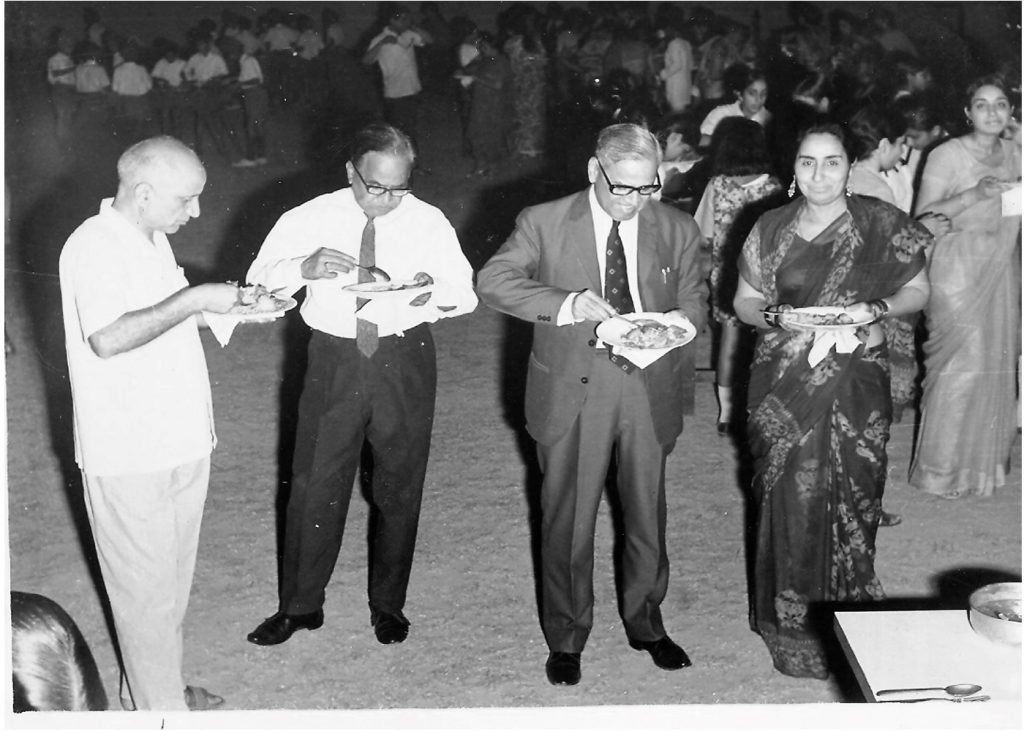 Half Yearly, Home- Day Dinner. Mr JK Kate in the foreground with Mrs. Punia w/o Bursar GS Punia and Mr PN Mathu on the left (Geography &Commerce)
Half Yearly, Home- Day Dinner. Mr JK Kate in the foreground with Mrs. Punia w/o Bursar GS Punia and Mr PN Mathu on the left (Geography &Commerce)
According to Mela Singh, the very able Accountant and Office Superintendent, “At the half yearly get-together, the entire teaching and office staff used to be the personal guests of the Headmaster and the Bursar. Mr. Kate had established personal relationship with everyone and while he drew strength from this relationship, the staff in the bargain got a constant stream of inspiration from him.”
The whole staff worked as a team, led by a very able captain. Many of these teachers imbibed the leadership and administrative qualities of Mr. JK Kate. They later went on to become very successful headmasters of well-known schools across India. He turned them from teachers to educationists with a purpose. All of them have acknowledged his influence and indebtedness to him. They may have spent more time in other schools but their basic attachment to The PPS remained strong. It was the place where Mr. Kate groomed them during their internship.
According to Mr. BS Bhatnagar the English Head and master:
“He had the gift of presence. When he walked into the Staff Common Room, people straightened their ties and held their breath in anticipation and he dazzled them with effortless command. No one worked harder at his job to prepare more diligently for each challenge. His stellar career, inspiring personal history and reputation for integrity had endowed him with a unique moral stature. He sometimes revelled in a good laugh and took a warm, caring and – there is no other word – paternal interest in the lives of the students and all those who worked with him”.
It is no wonder that many of his staff members tried to emulate him later in life as heads of their respective Schools.
According Mr. OP Bhatnagar, Hindi and Arts Teacher:
“There are several styles of management. I followed his style when I was Principal. It worked. I give credit of my success to my mentor, Mr. Kate. I always had very strong emotions towards PPS”
.
Below is a list of Teachers who worked under Mr. JK Kate and later headed other Institutes:
1.Mr. YP Bharadwaj, (left in 1966) – Army Public School, New Delhi; Motilal Nehru School of Sports, Rai; and the Indian School, Muscat, Sultanate of Oman.
2. Mr. B S Bhatnagar, (left in 1974) St Paul’s School, Darjeeling; The Daly College, Indore; The Lawrence School, Lovedale, Ooty; and, the Indian School,
Al Ghubra, Sultanate of Oman.
3. Mr. OP Bhatnagar, (left in1970)- Military School, Dholpur; Ajmer Military School, Ajmer; and, The Indian School, Nizwa, Sultanate of Oman.
4. Mr. VN Bhave, (left in 1975) – Vikas Vidyalaya, Ranchi.
5. Mr. Kailash Dar, (1974)- Sri Dasmesh Academy, Anandpur Sahib, Diamond Cements School, Narsingarh, MP, and, Cambridge School and Salwan Public School, both in New Delhi.
6. Mr. YP Johri, (1986) – Colvin Talkudars’ College, Lucknow.
7. Mr. IB Kakar, (1977) – Navyug School, and Army Public School, both in New Delhi.
8. Mr. K K Katyal, (1981) – Mussoorie Public School, Mussoorie.
9. Mr. R S Mehta, (1981) – Montgomery Guru Nanak Public School, Jalandhar.
10. Mr. K S Nijjar, (1980) -Guru Harkrishan Public School, New Delhi.
11. Mr. M R Oberoi, (1971) – Vikas Vidyalaya, Ranchi.
12. Mr. R K Sharma,(1986) Wajra Army School, Jalandhar Cantt.
13. Mr. Rajinder Sibal, (1968) – Gulmohar School, Jamshedpur, Bihar (now Jharkhand).
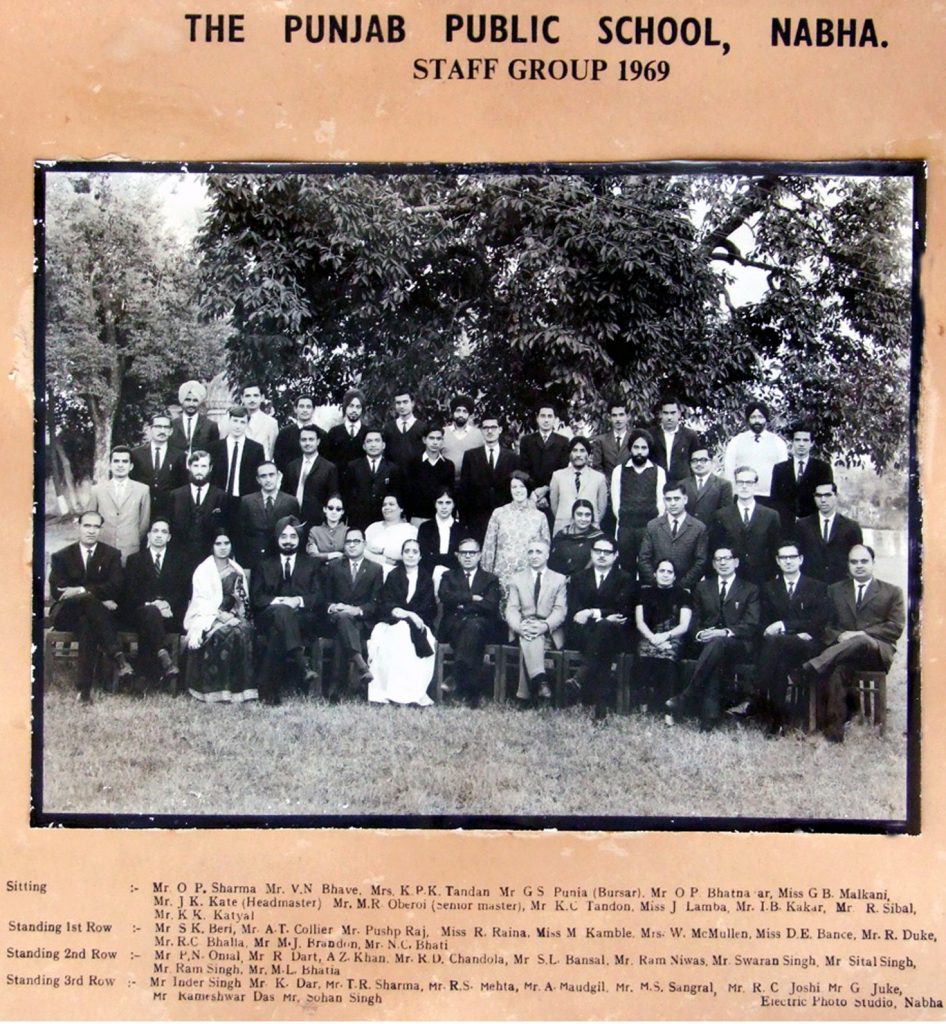 14.Dr Joginder Singh,(1962) his services were requested by- Dagshai Public School, Dagshai (HP). He joined there as Headmaster.
14.Dr Joginder Singh,(1962) his services were requested by- Dagshai Public School, Dagshai (HP). He joined there as Headmaster.
15. Dr Surjit Singh,(1974), on deputation from Punjab Government, went back to Punjab, retired as Principal, Sports College, Jallandhar.
16. Mr. Kamlesh Tandon, (1980) -ICL School, Rajpura, and established a couple of other schools.
17. Mr. Mukut Nath Tankha, (1970)- The Assam Rifles Public School, Lairkor, Shillong, Meghalaya. 18. Mr PC Onial, (1991)- Riverdale School, Dehardun.
18. Mr. RD Chandola, (1987)- DAV centenary School, Haldwani.
19. Miss Mohini Kamble, (1970) -SD Public School, Muzafarnagar.
20.Mr. SC Sharma, (1986) -Kendirya Vidyalaya , Kangra.
21. Mr. SP Chopra (1986)-DAV Centenary Public School, Jaipur.
22. Miss Rajni Raina, (1970)- Housemistress Welham’s Girls’ School.
(Prepared by Dr Jashanjot (S-52) with help from CTB and Mr. BS Bhatnagar)
__________________________________________________________________________________________________________________________________________________________
The two men who mattered the most
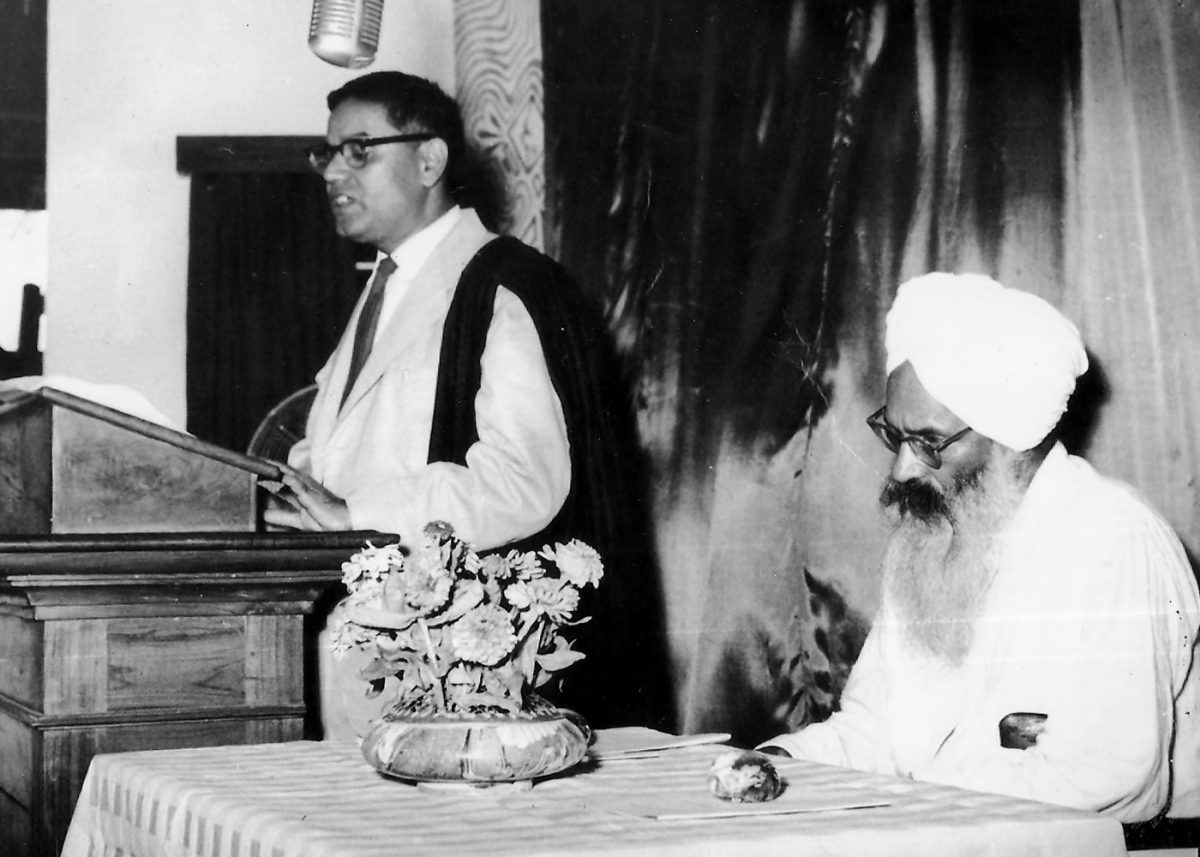 The two great personalities who played the major role in setting up of The Punjab Public School, Nabha. Punjab Chief Minister, Sardar Partap Singh Kairon, who was responsible for conceiving and sanctioning the School (Foundation) and Mr. JK Kate, , who planned and executed the establishment of the fine School which can be likened to a fine monument (The Architect).
The two great personalities who played the major role in setting up of The Punjab Public School, Nabha. Punjab Chief Minister, Sardar Partap Singh Kairon, who was responsible for conceiving and sanctioning the School (Foundation) and Mr. JK Kate, , who planned and executed the establishment of the fine School which can be likened to a fine monument (The Architect).
______________________________________________________________________________________________________________________________________________________
The involvement of British Council, VSO, Peace Corps and CUSO in establishment of The School
In the Founding years of The Punjab Public School, especially in the years between 1960-72, the British gave more than just a helping hand to the newly launched School. This helped the school in making a place for itself among the established Public Schools of the country. This help came through the UK High Commission, The British Council and Voluntary Service Overseas. Thus, they played an important role in the school taking strong roots and making rapid ascent. All this happened due to the vision and drive of Mr. JK Kate who got them involved in the school.
Picture shows Senior Master Dr. Surjit Singh introducing Lady and Sir Paul Gore Booth (high Commissioner of UK to India) to the staff while Mr. Kate looks on. The boy fourth from right is Roger Miall who was the first VSO to come to School in 1963.
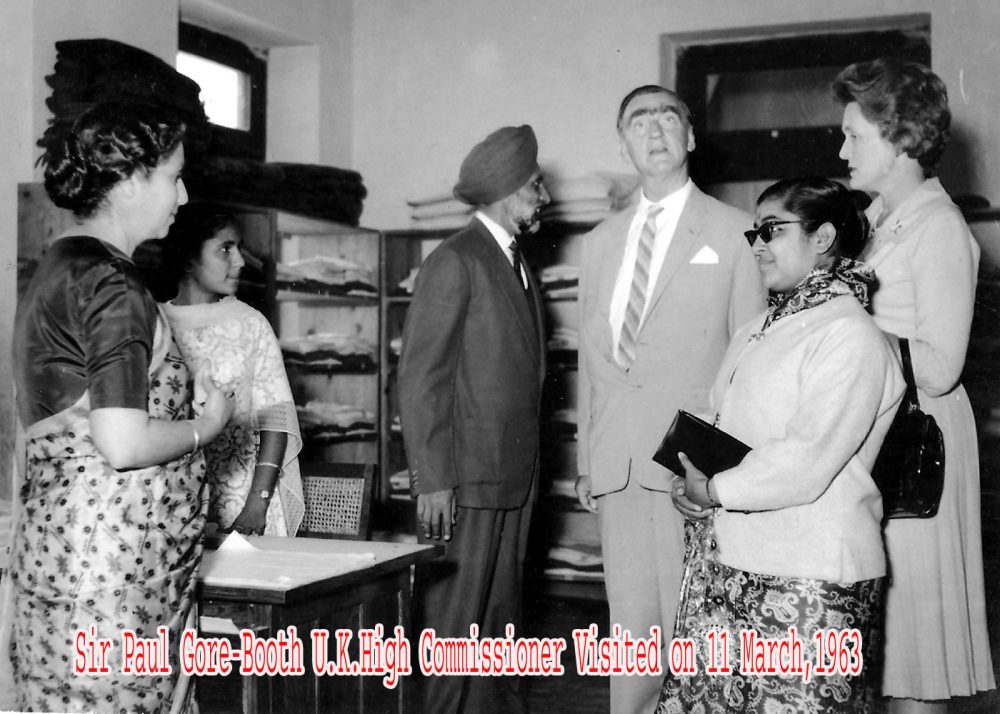 Lady and Sir Paul Gore-Booth, the UK High Commissioner to India in the clothes room with Mrs. J Singh on the left, who was clothes matron. They visited the School on 1st March 1963 and were deeply impressed with what they saw. Such visits continued to strengthen the school ties with the British Council and facilitated the arrival of many British volunteers that would make a significant contribution towards the ascent of the school.
Lady and Sir Paul Gore-Booth, the UK High Commissioner to India in the clothes room with Mrs. J Singh on the left, who was clothes matron. They visited the School on 1st March 1963 and were deeply impressed with what they saw. Such visits continued to strengthen the school ties with the British Council and facilitated the arrival of many British volunteers that would make a significant contribution towards the ascent of the school.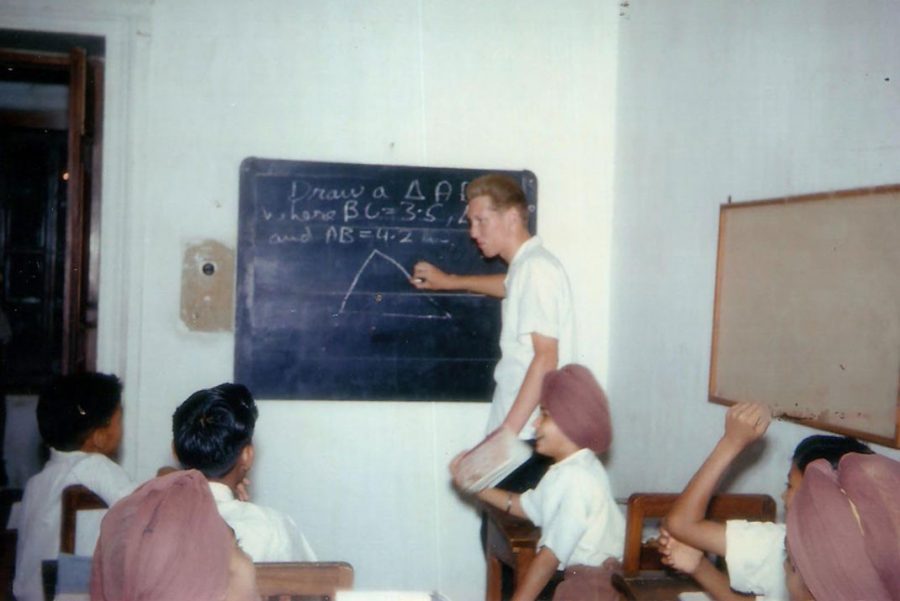 Mr. Roger Miall is teaching Maths to class VI A.
Mr. Roger Miall is teaching Maths to class VI A.
Below, In 2010, he came back to attend the golden Jubilee celebrations of the School and was honoured by the ONA. (46 years later). He visited school twice in between. Presenting him the Coffe Table Book are Gen. Vinay Sharma and Dr. Jashanjot (S-52) who was his student in 1962.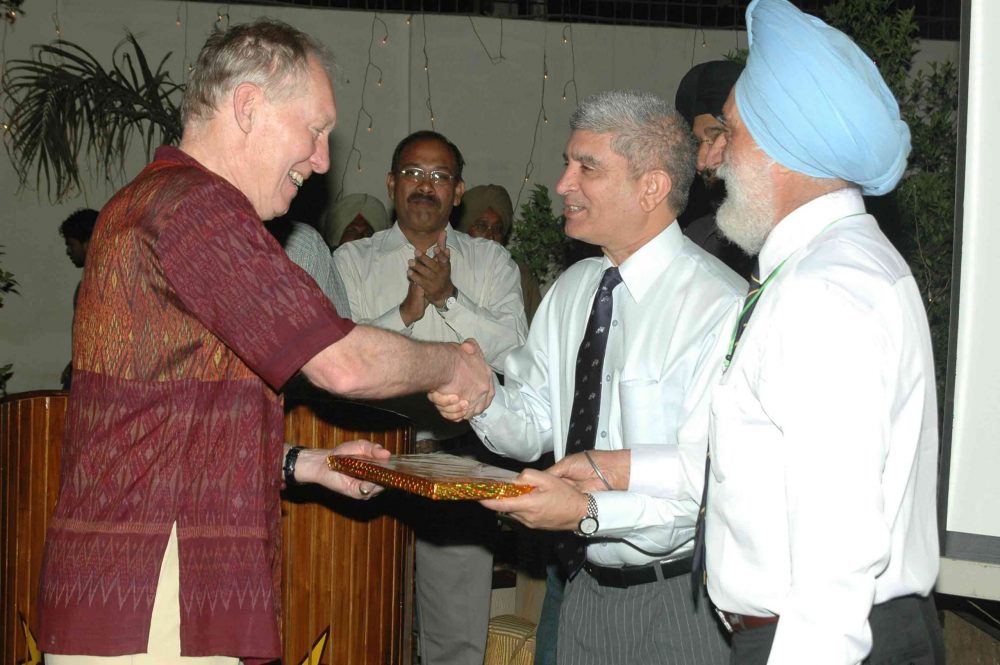
At the request of the Founding Headmaster, Mr. JK Kate, the British Council sent Mr. Michael Vodden (1962-1964) to teach in the School. He was a gifted teacher with an expertise in teaching English to children whose mother tongue was not English. He loved two things, teaching English and India. He found both in The PPS. The students in those years came mostly from village backgrounds without knowing a single word of English. Apart from teaching English, he exerted a great influence on Mr. Kate’s thought processes in the running of a Public School. Mr. Kate, in his article ‘Pride of Punjab’ has called Mr. Vodden’s coming to School (1962-1964) as one of the two most important points in the history of the School; the other being the visit of the President of India, Dr. Rajendra Prasad to inaugurate the School in 1961. Mr. Vodden not only set a pattern for teaching of English and running of the School but also left a permanent mark on the School by writing the ‘School Song’ of The Punjab Public School, Nabha (1963).
Soon after Michael Vodden came to the school in March 1962, the possibility of using a VSO volunteer was discussed with the headmaster and it was agreed that the start of the next term in August would be ideal.
When Mr. Vodden left in December 1964, the British Council loaned the services of Mr. John Mallon (1965-1968) from Scotland to teach English in the School. He was not only head of English department but also the Senior Master of The School. Mr. Mallon started the trend of having information/educational films to be screened in School almost every week (usually Wednesday) on different subjects ranging from sports to cars to science etc. In the absence of any TV or computers those days, these films not only kept the students well informed and aware of the world but also made them think in different directions, thus broadening their vision and horizon.
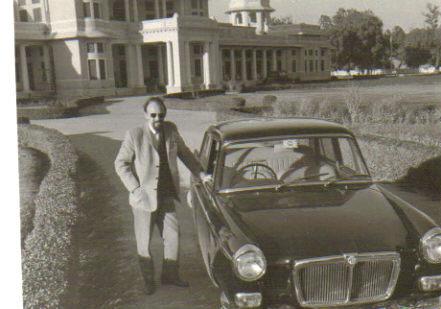 Mr John Mallon with his famous green MG car which he brought from UK.
Mr John Mallon with his famous green MG car which he brought from UK.
The British also provided services of the ‘Voluntary Service Overseas’ organisation of UK. Under this, almost every year at least one and sometimes two and even three young men and women from UK came to work and teach in the School, for more than a decade. These young teachers influenced the school children greatly. They also took part in many activities and jobs for the benefit of the school like swimming, treks, outings, setting up a poultry farm, an aviary and even staging of English plays etc. Their speaking to Junior School students only in English facilitated the raw students to learn spoken English better and faster. These foreign teachers were honest, sincere, dedicated down to earth and very friendly.
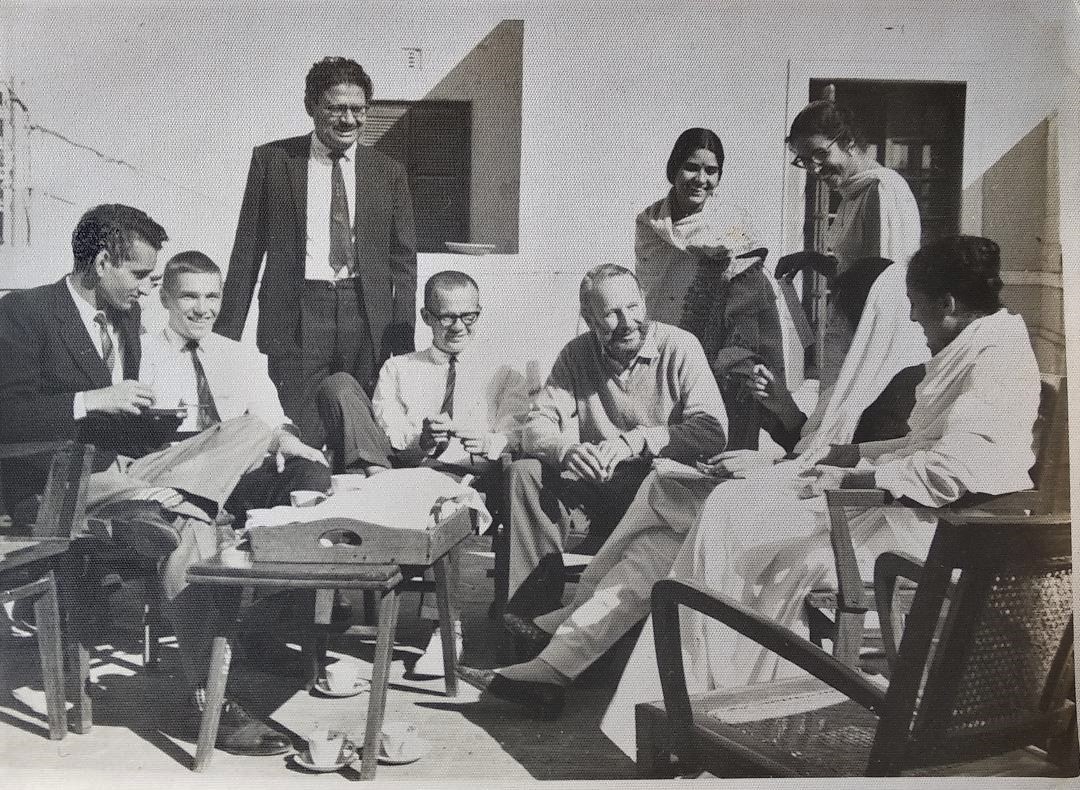
A great picture from Junior School roof on a sunny day in winter (1963-4). From left Naresh Verma , Art teacher, Bernard Clarke VSO, Mr Tandon standing, Dick Pine (peace Corps), Mr. Vodden (British Council), Mrs Tandon standing, Ms Sarangal, Ms Lila kak and Ms Malkani.
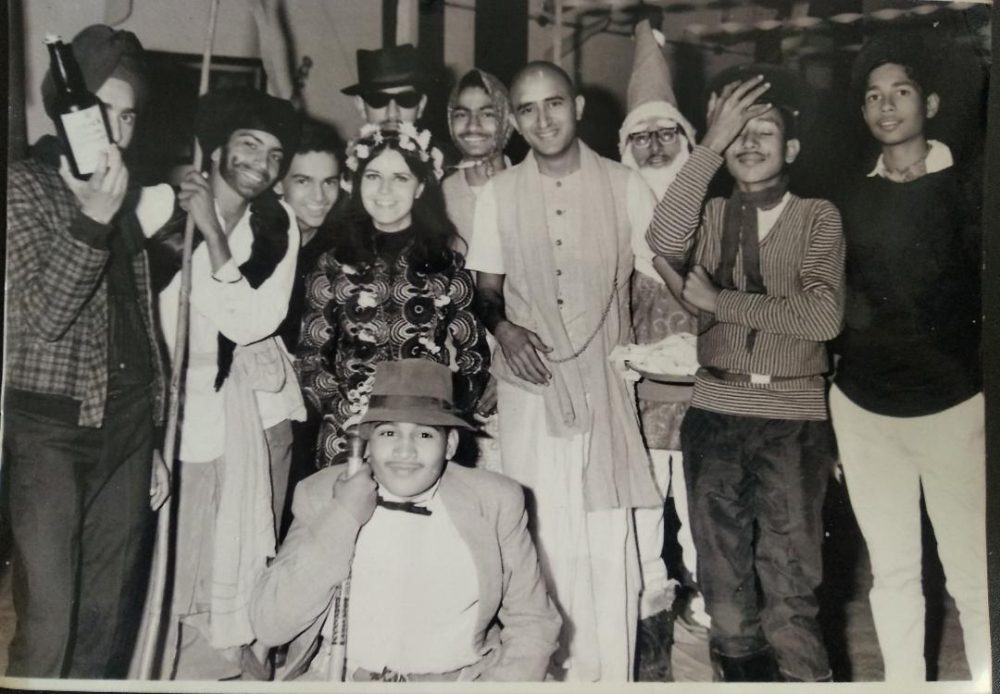 Anita Williams, who arrived in 1967 and left in 1969 is one of the few was in school for over two years. Here she is, as flower girl in the late nineteen sixties in a farewell fancy dress party for passing out class.
Anita Williams, who arrived in 1967 and left in 1969 is one of the few was in school for over two years. Here she is, as flower girl in the late nineteen sixties in a farewell fancy dress party for passing out class.
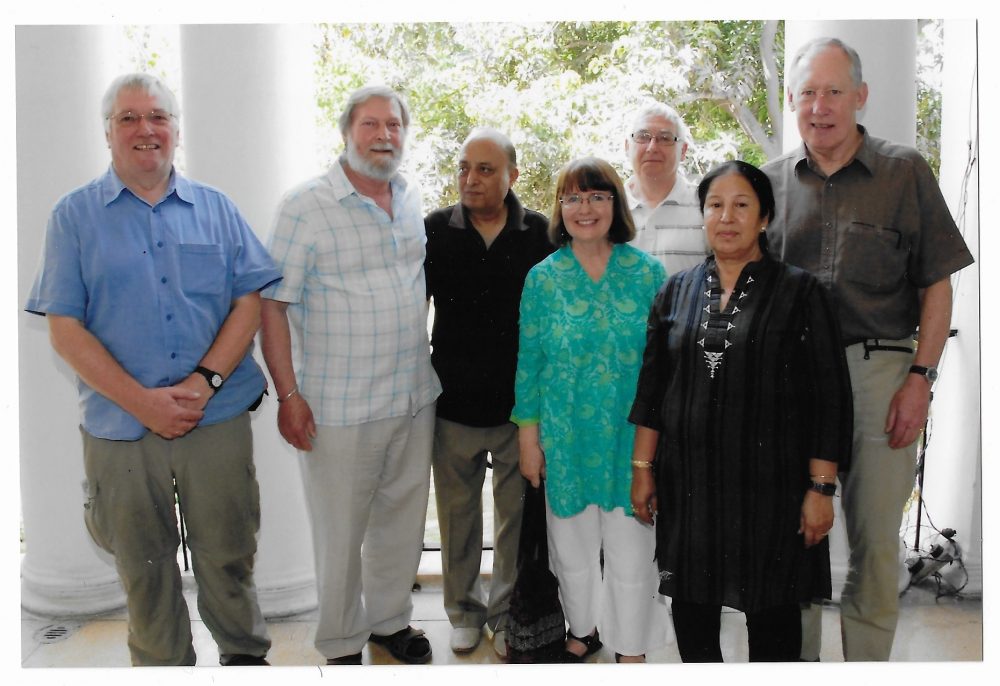 The Volunteers who cam back to school in 2010 for the Golden Jubilee Celebrations of the School. From left Bernard Clarke (1964-65), A. John Rigby (1966-67), HM Comde. IL Syal, Anita Williams(1967-69), Roger Burridge (1963-64), Mrs. Syal and Roger Miall (1962-63).
The Volunteers who cam back to school in 2010 for the Golden Jubilee Celebrations of the School. From left Bernard Clarke (1964-65), A. John Rigby (1966-67), HM Comde. IL Syal, Anita Williams(1967-69), Roger Burridge (1963-64), Mrs. Syal and Roger Miall (1962-63).
On active push by Mr. JK Kate, The British Council also provided bursaries and scholarships for the teachers of this School for attachments to different schools in the UK. This gave them a unique opportunity to go and study the newer innovative approaches to teaching of different subjects in the UK, thereby not only enriching the teachers but also the staff and students of The Punjab Public School, Nabha. It goes to the large heartedness, vision and greatness of Mr. JK Kate that he allowed these great teachers to absent from School for long trainings abroad.Many times the British Council donated hundreds of books to the School Library.
Despite the fact that long absence of staff did affect the academic routine, Mr.Kate was firm in his conviction that in the longer run, the pros far outweighed the cons. Mr.K.I.Thomas, ex-headmaster of Lovedale had once remarked during one of his many Nabha visits that PPS had the best staff of all public schools in India.
They even donated audio recordings for English classes. For example, on 14th September, 1963 alone, the British Council donated 100 books to The Junior School and 30 speech records to School. At times, recordings of famous plays of William Shakespeare were provided.
Thus, British Council’s contribution to the School in its early years was enormous and needs to be recorded for posterity. This generous help from the British Council went a long way, in the early meteoric rise of the School in 1960s.
There was not a month or term when someone from one of the above organisations did not pay a visit to the School. Mr. JK Kate invited them to school and played host to them.
Apart from the VSO the Mr. Kate also got help from the American peace Corps and Canadian University Service Overseas (CUSO). According to Mr. Kate,“We were also fortunate in getting similar response from the American Peace Corps and Canadian Volunteers. Most of these young teachers worked in the junior School and shouldered many responsibilities. The credit for starting the school poultry goes to Roger Mile, the first V.S.O. Richard Pine took charge of the Swimming Pool. David Goldberg organised the Library and looked after the pool after Richard’s departure. He was very strict in enforcing the rules framed by him for the users of swimming pool. Lowell Edward set the textbooks store in order and made the whole system of lending textbooks to the boys more methodical.”
The Peace Corps workers Dick Pine is second from left in first row standing. Mr Lowell Edwards is on extreme left in second row standing. Mr. David Golberg is in the center last row (1964). VSO , Bernard Clarke is second from right in first row standing. Mr. Michael Vodden, the first English head who wrote the School Song and was sent by British Council is seated to left of Mr. JK Kate in the center.
 Mr. Richard Dick Pine (March 1963, -May 1965) , the first Peace Corps worker in school took kids to this Rohti canal, to teach them swimming.
Mr. Richard Dick Pine (March 1963, -May 1965) , the first Peace Corps worker in school took kids to this Rohti canal, to teach them swimming.
____________________________________________________________________________________________________________________________________________________________
The Starting of the School Band
There was yet to be another contribution by Mr. JK Kate to the School for all times to come. In 1965, Mr. JK Kate decided to have a school band and selected a very able Bandmaster retired Jamadar Sohan Singh Kooner. He belonged to a village near Adampur in Jalandhar district. He had been in the army band for many years. He would tell his trainees how he had marched in the band in front of the Queen in England on a ceremonial parade in UK , where he had taken part.
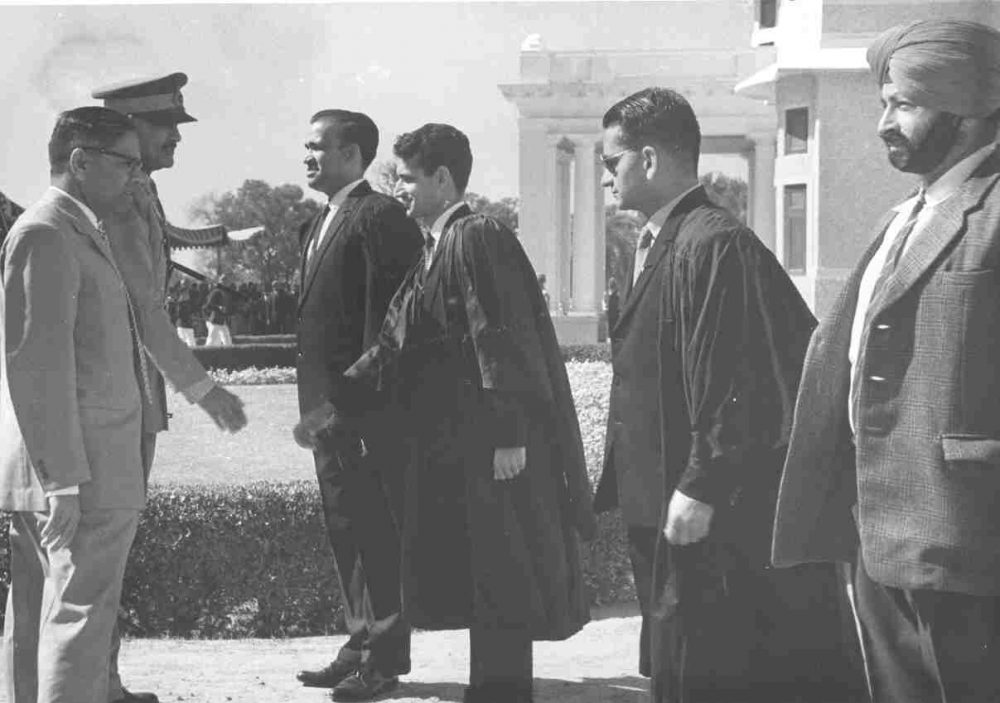
On 1966, Founders’ Day, Gen JN Choudhary COAS of India was Chief guest, here being introduced to staff. Mr. Sohan Singh Band master in on extreme right.
Soon Regular practices started in the afternoon. Sohan Singh was hard task master and often drove his point home in chaste rustic Punjabi. By the end of the year the band was playing many tunes and became presentable.
In 1966, on Founders ‘Day the band for the first time took part in the guard of Honour to be presented before the Chief guest Gen. JN Chowdhary the COAS of India. Gradually Band became an important option for students to choose as an activity like crafts, music, photography and debates etc. in school.
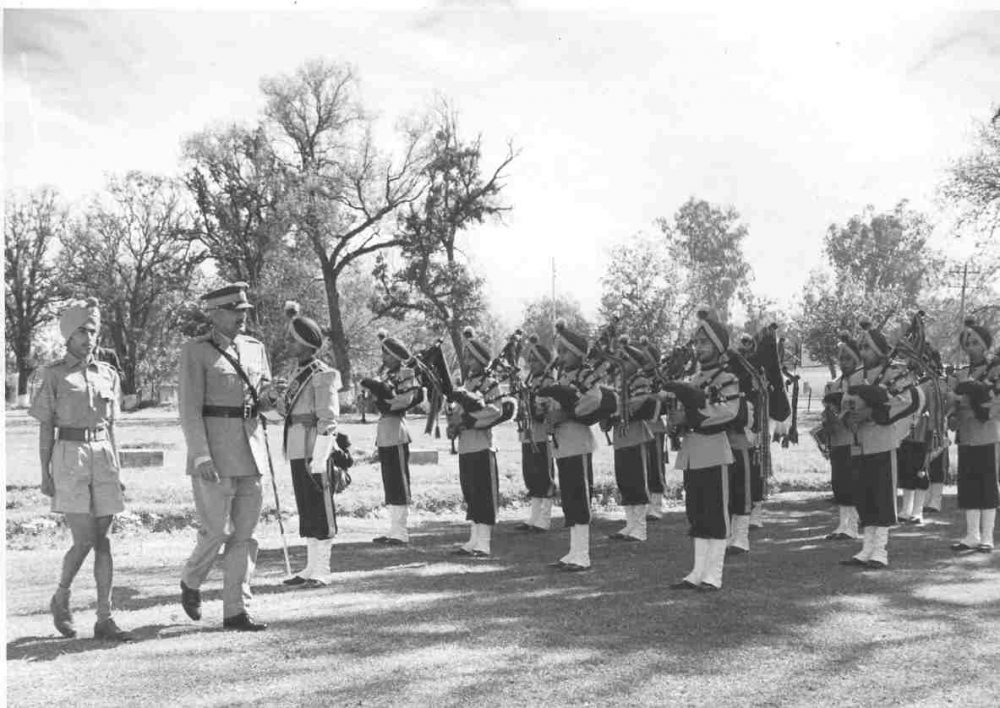
The First Band: In March,1966, on Founders’ Day, Gen. JN Chaudhari Chief of Army staff inspects guard of honour. The first Band in attendance. Your truly is extreme right in second row with bagpipe.
In September 1967 : The school Band played at the National School games and at the National Solidarity Day at Patiala.
We are pleased to know Our School Band has been selected to participate in Republic Day Parade next year. Credit goes to Mr Sohan Singh our Bandmaster. (from October, 1967 chronicle )
From then on, there was no looking back. The band progressed by leaps and bounds. It was selected to be presented at many state ceremonies and The Republic Day parades at the national level. Perhaps the only School Band at that time represented on the Rajpath. There used to be only a Girls band from Birla Public School, Pilani.
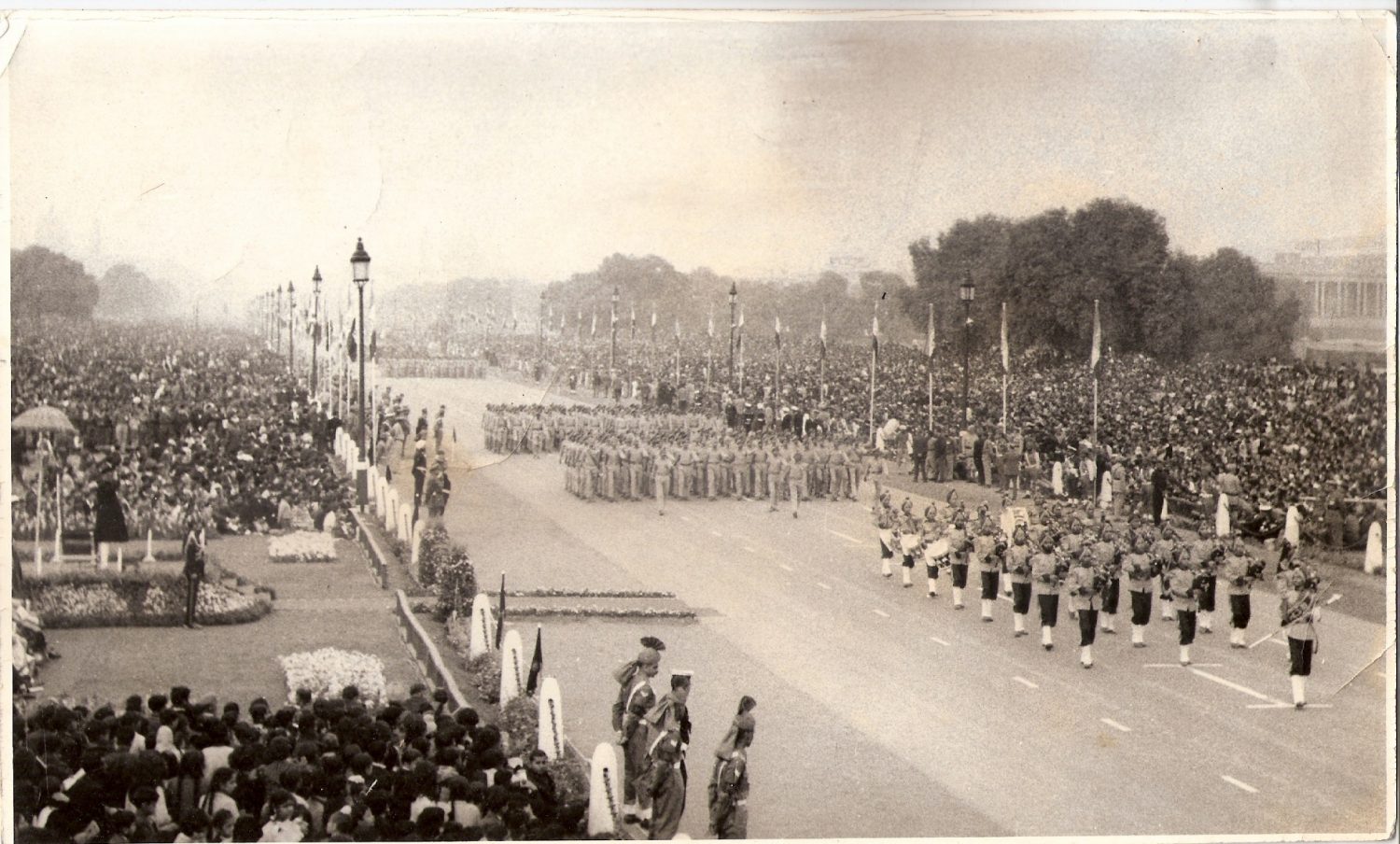 The first time The School Band marched down the Rajpath on Republic Day in 1969.
The first time The School Band marched down the Rajpath on Republic Day in 1969.
Following excerpts like those above are taken from school chronicles.
September 1969 chronicle: The NCC issue of August of The Cadet carries a coloured photograph of the School Band marching down Raj Path on the Republic Day. The band was filmed in action.
February issue 1970 : The School Band participated in 26th January Republic Day parade and from all accounts they were outstanding.
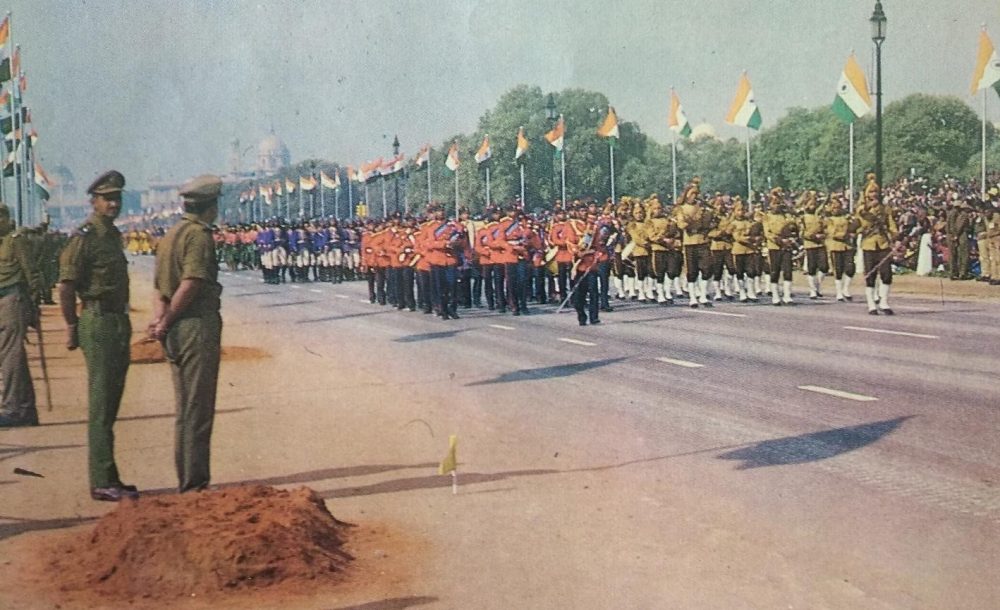
In Jan, 1972 : The School Band has been again selected to represent Punjab at the Republic Day Parade at Delhi, this year.
August, 1974: We paid homage to Martyr Udham singh and offered floral wreaths to his mortal remains. The procession carrying them was escorted by the School Band as it passed through the School in Nabha.
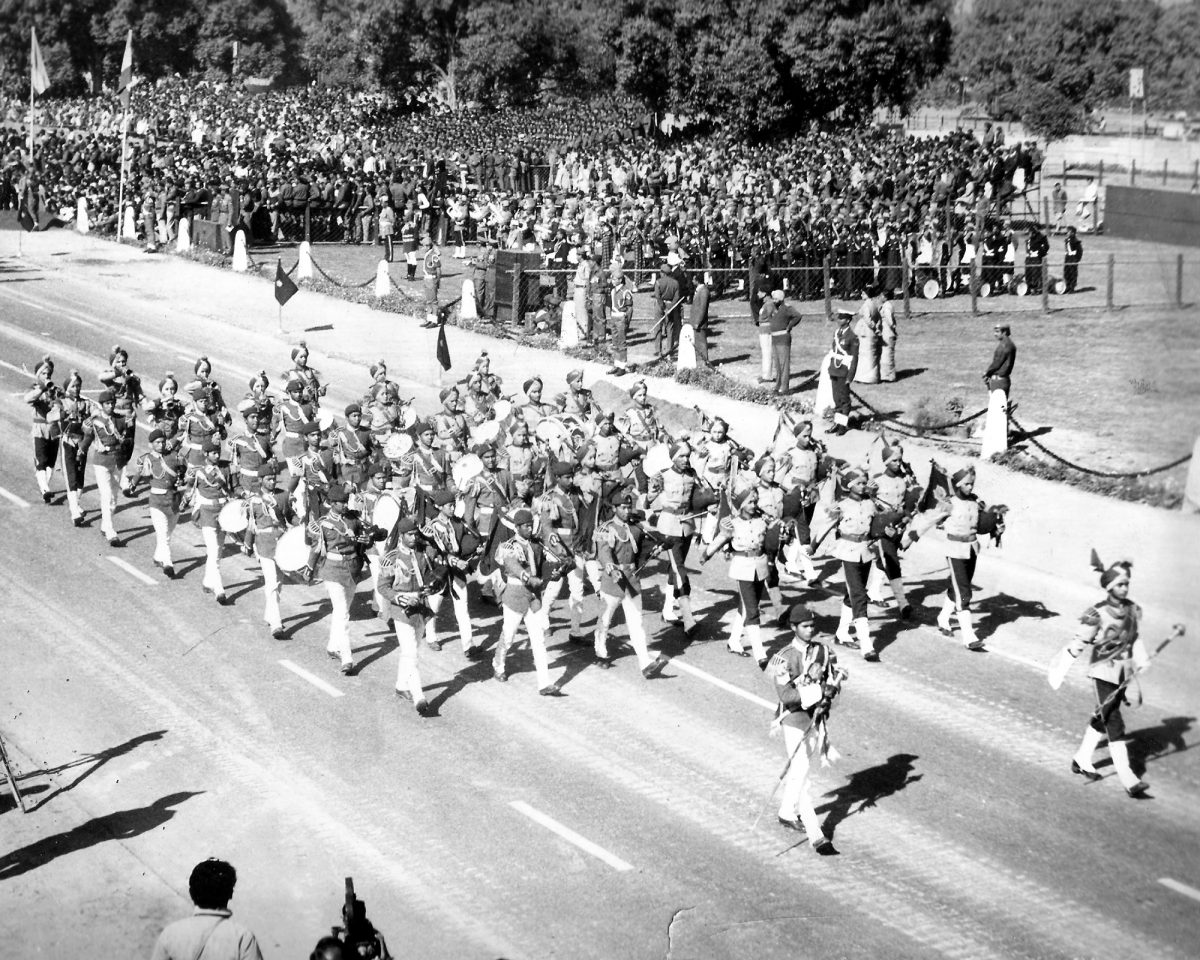
The performance of the band continued to get appreciated and get accolades even after Mr. JK Kate had left the School.
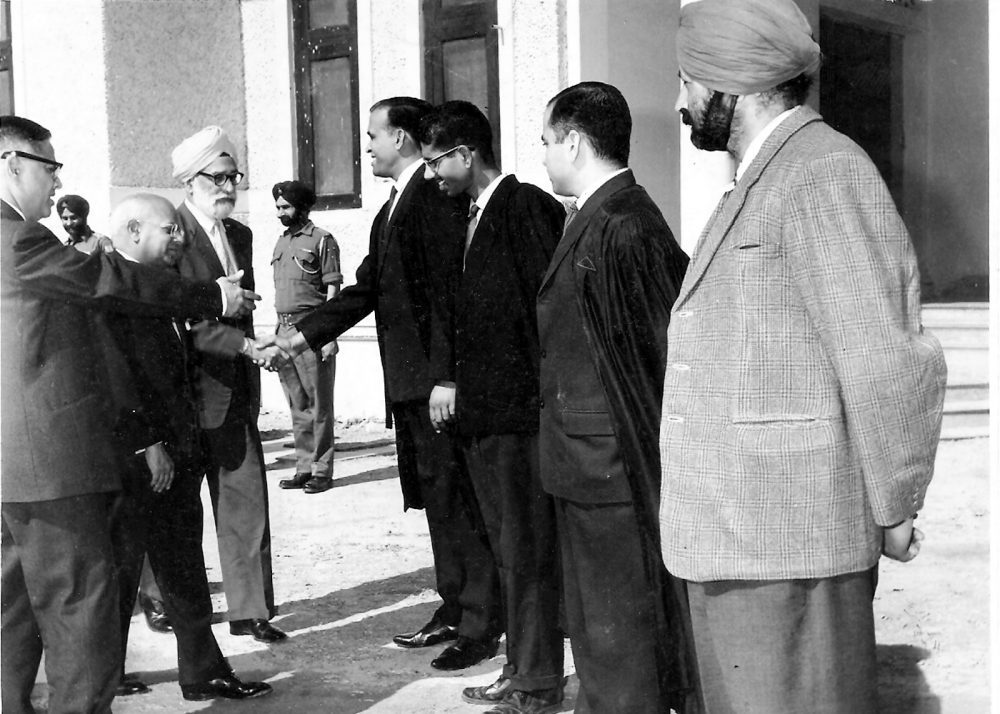 March 1967, Founders’ Day. Two Guests, His Excellency the Governor Dharamveera and Chief Minister of Punjab , Justice Gurnam Singh being introduced to the staff. Sohan Singh, Band master is on extreme right with military style tied beard.
March 1967, Founders’ Day. Two Guests, His Excellency the Governor Dharamveera and Chief Minister of Punjab , Justice Gurnam Singh being introduced to the staff. Sohan Singh, Band master is on extreme right with military style tied beard.
Jan 1979: The School Band once again participated in the Republic Day parade in Delhi. The cadets gave a good account of themselves and were awarded prizes for their performance.
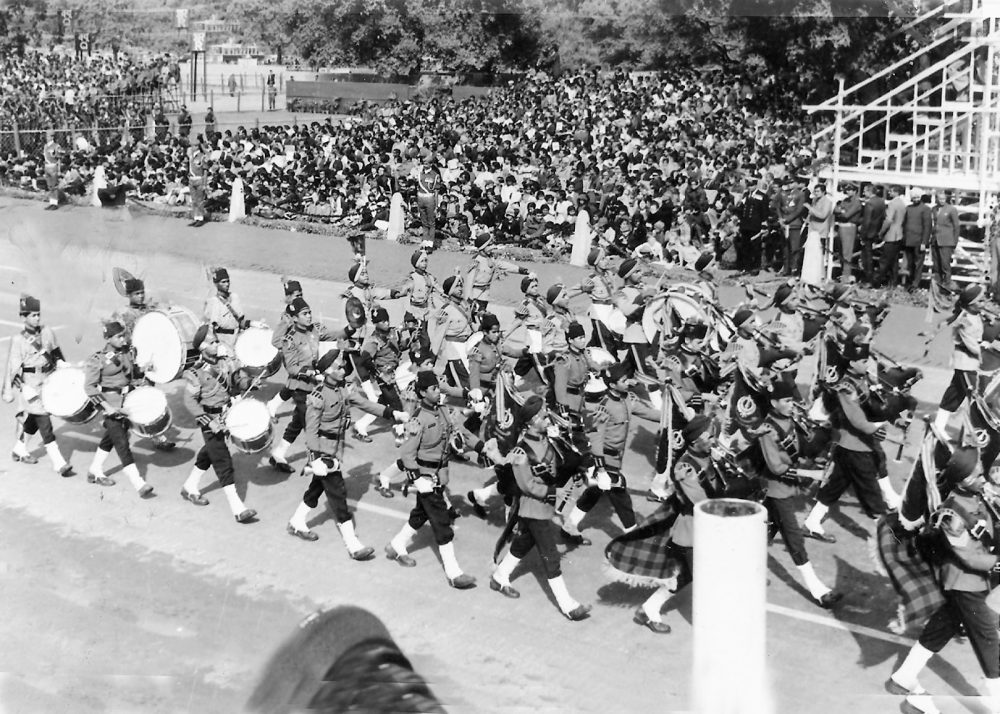
Jan ,1980: The School Band participated in the Republic Day parade in New Delhi and once again they made themselves and the school proud with their performance.
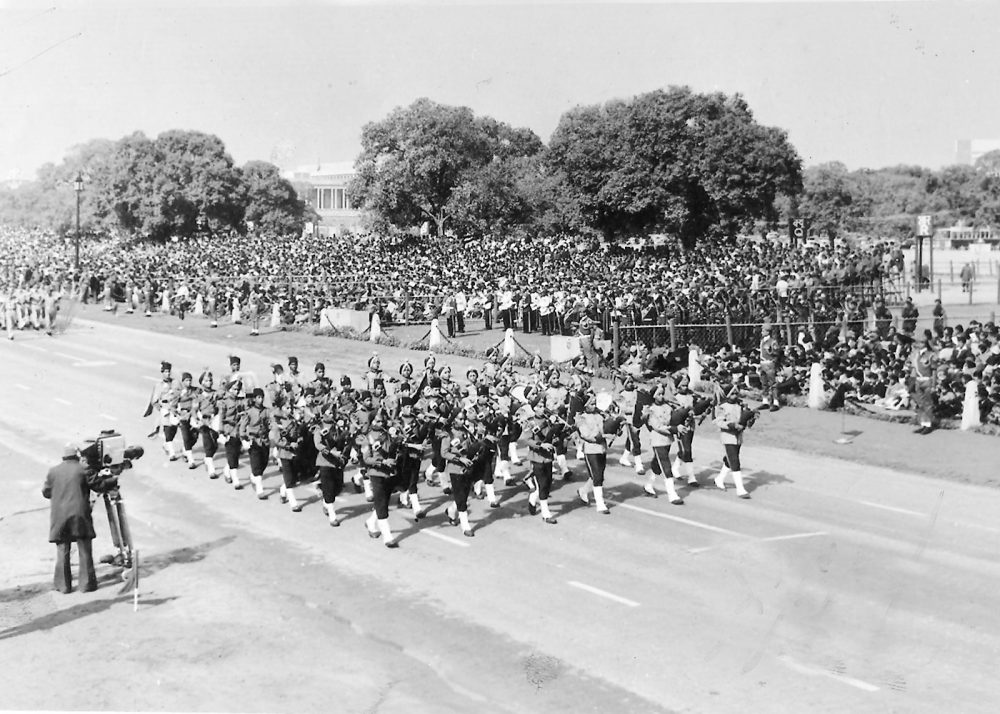
Initially the band used to be marching alone but some times for harmony and completing the contingent another band was clubbed to march with our school band.
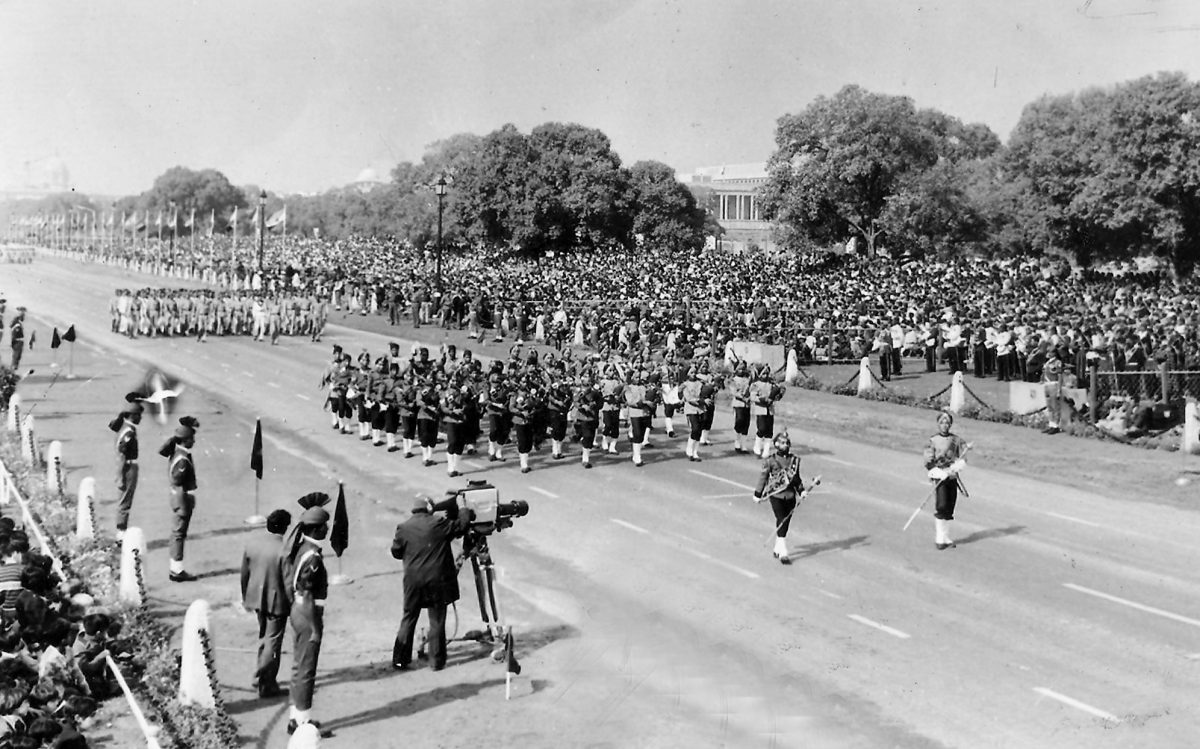
Photo Taken from the stands
In 1982, PPS Band team was adjudged as the best band on Republic Day Parade at New Delhi. It was not for the first time that the School band team had participated in the Republic day parade. It had been a regular feature barring a few gaps, but to be adjudged as the best band performance on a national platform was a glorious achievement.
The school band leader J-473 Sarbjit Singh had breakfast with the Prime Minister, Mrs. Indira Gandhi after the Parade along with other guests, and on January 27th, the entire band team was invited at the Rashtrapati Bhavan to meet the President, Mr. N. Sanjeeva Reddy.
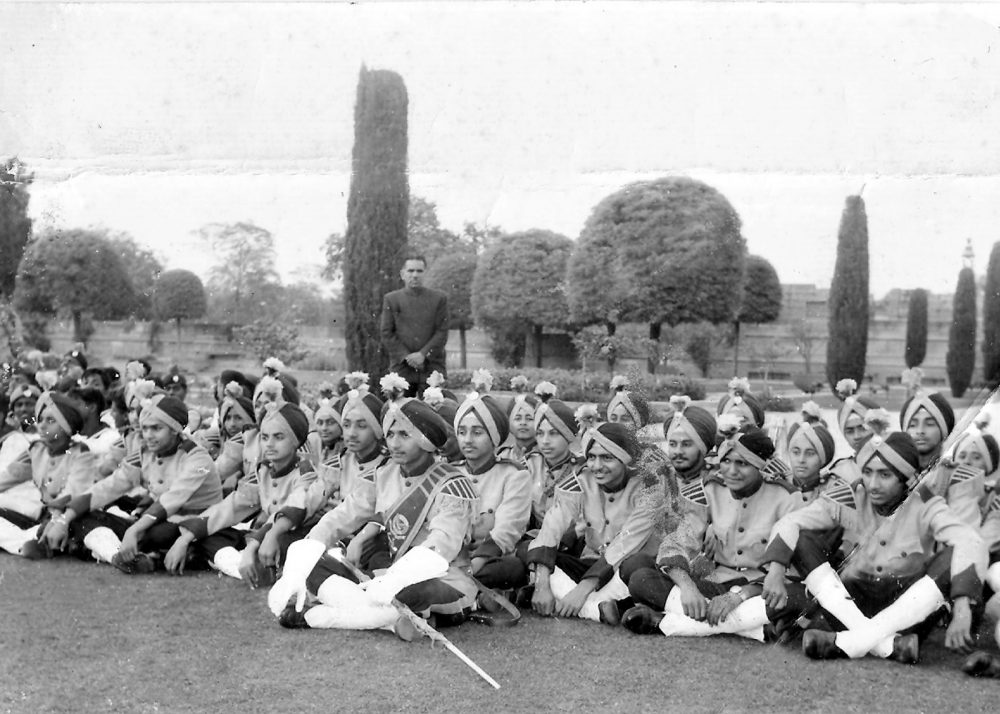
1982, The Band at Rashtarpati Bhavan. Moment of great pride.
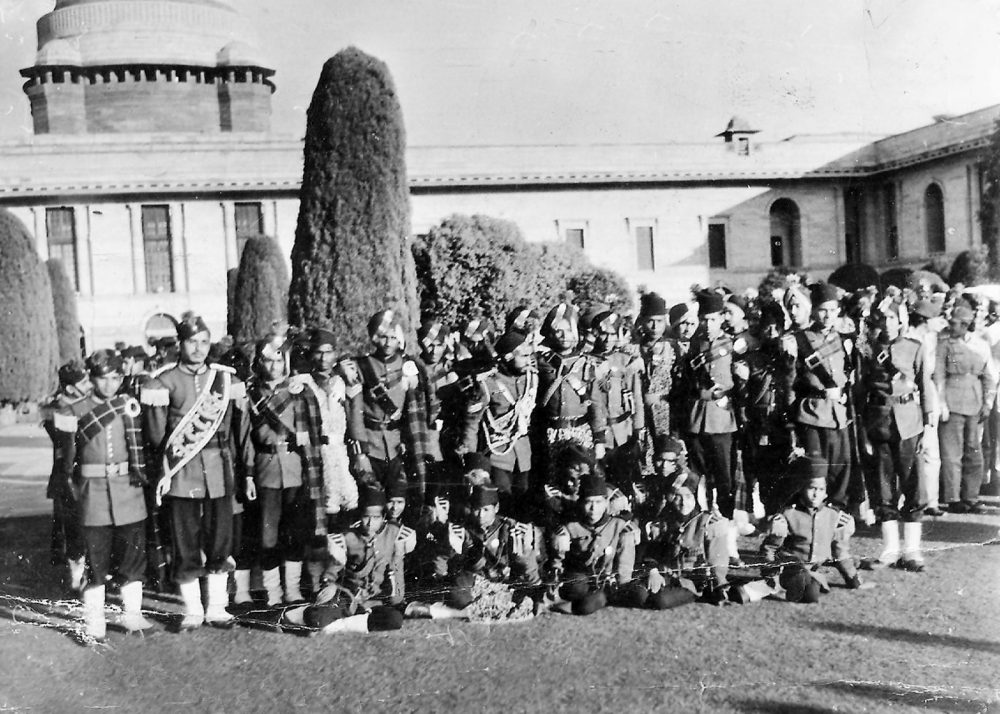 The best Band of Republic Day, 1982 . What an achievement! In company of another band who marched with them.
The best Band of Republic Day, 1982 . What an achievement! In company of another band who marched with them.
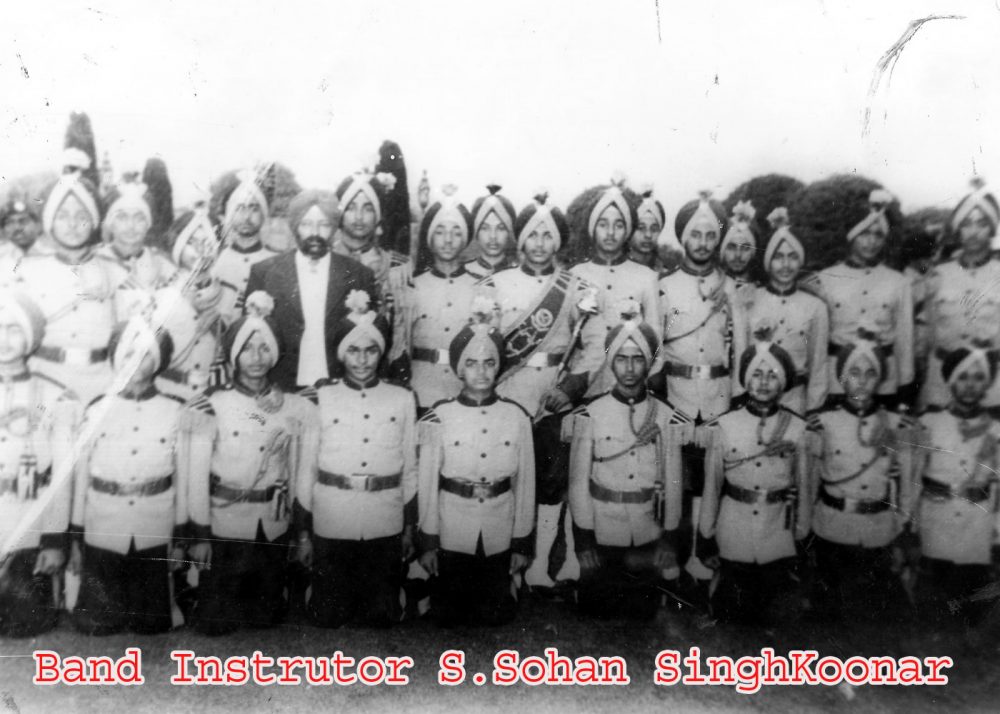
The Bandmaster with his excellent young members of the school ‘ Bagpipes and Drums’ band.
Ever since the early years when Mr. Kate took the initiative of starting the School band, it has performed at all school functions like Founders’Day, Athletics Day, Horse show and at home with governors of Punjab at Raj Bhawan, State functions etc.
Later when the girls joined school a separate Girls band was also added to the school. They too have been performing very well.
__________________________________________________________________________________________________________________________________________________________-
Honoured with the Award of Padam Shri
March 1972
It was a matter of immense pride for the School when the Headmaster Mr.J.K.Kate was conferred upon with the prestigious Padma Shri Award by the Government of India on 25th March 1972 for his services in the field of education.
When Mr. JK Kate came back to school receiving the award, it was announced in the Assembly. The students, keen to make the most of this golden opportunity, clamoured for a holiday during the assembly. Much to their delight, the nod came from Mr. Y.P.Johri, Mr. Kate being too overwhelmed by the occasion.
The Citation
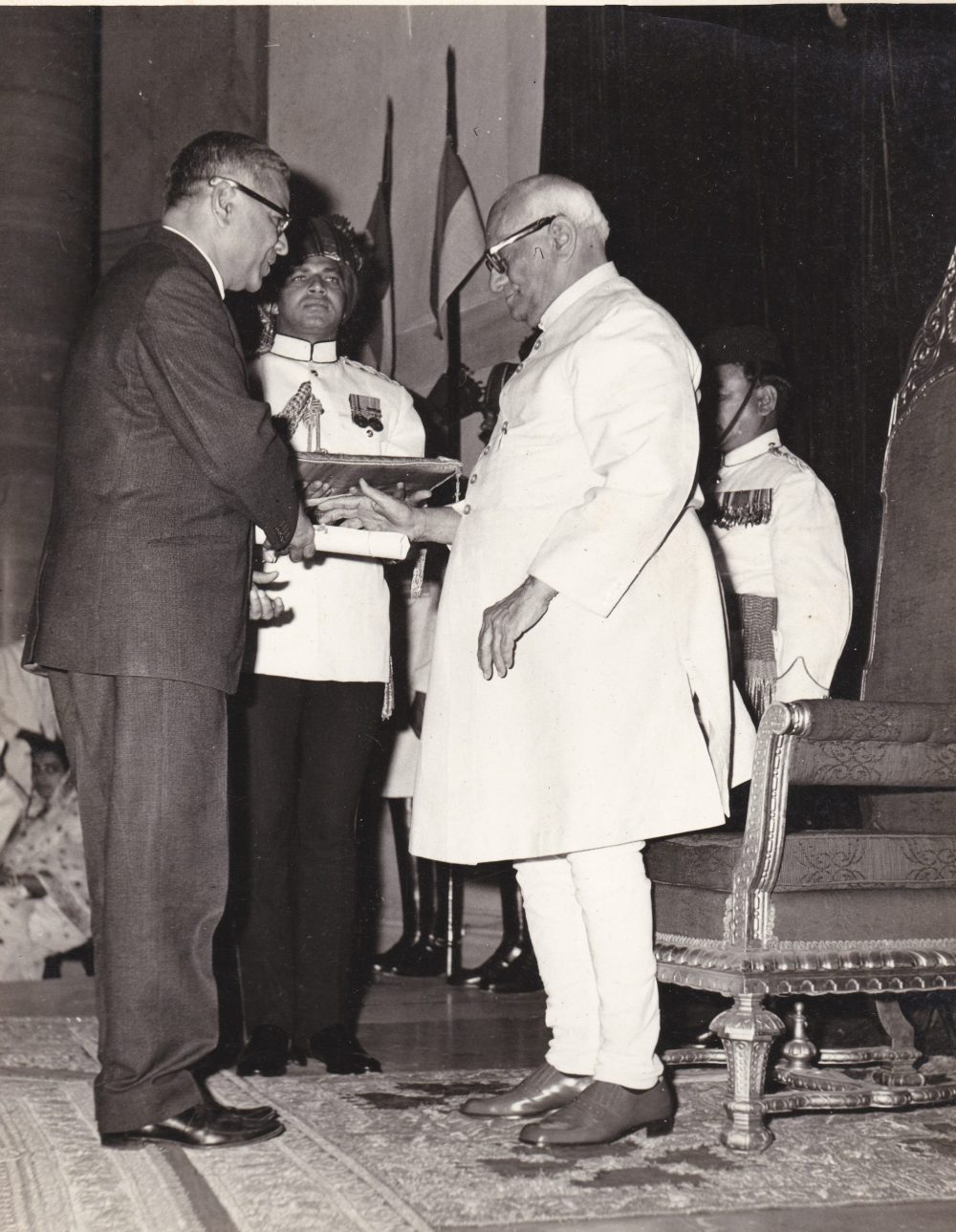 Receiving the Honour from the President Mr. VV Giri, 1972.
Receiving the Honour from the President Mr. VV Giri, 1972.
A personal moment with the President while actress Waheeda Rehman another awardee looks on. He would joke in his family That President was more interested in talking to me rather than Waheeda Rehman, The top heroine of Hindi films at that time.
_____________________________________________________________________________________________________________________________________________________________________
Finally, time to leave The Punjab Public School, Nabha
SHRI J.K.KATE decides to retire from The PPS
In his speech on the Founders’ Day in 1972, the chief guest Lok Sabha Speaker, Sardar Dr. G.S. Dhillon, had already shared the sad news of Mr. Kate’s decision to retire as the Headmaster of The PPS Nabha. He had decided to take over the post of Headmaster at the Daly College Indore – a premier institute in M.P. where he had started his teaching career as a young graduate (from the Chronicle).
Mr. Kate was presented a School crest and the class IV employees gifted a silver salver to the Kate family. In a grand fashion his car was pulled by the Staff and students till the main gate, with the School Band in attendance. On June 1, 1972, he left for Indore. To honour his selfless and dedicated service to the school, he was nominated to the Board of Governors.
Farewell given by Staff Club to Mr Kate and Mr Tom Waugh and Mr KK Batish from Page 3 of the June, 1972 Chronicle.
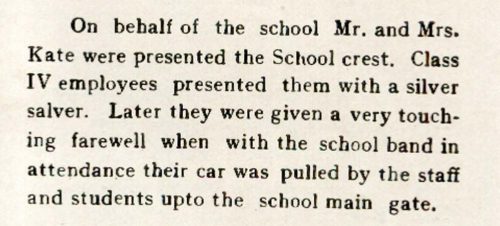
School bids farewell, June 1972 chronicle P3
It is not sure what made Mr JK Kate leave PPS but he in his own words felt that school needed a change of Headmasters to progress. Some felt that he had been hit by the death of his elder son Jeevan Kate (Satluj, S-34) in IMA at a promising age. The School where Jeevan grew up, kept reminding him of his son.
Another reason could be the longing for roots in the last phase of life–for he went back as Principal to Daly College, Indore, where he had started his Public Schools career—True to the words of its English Principal under whom he had taught earlier,When he had earlier served in the Daly College for ten years, the Principal of that College, Mr Jack, had later written from England to tell Mr Kate, “One day you will be Principal of this college.”
The Farewell Party at the staff Club. Seen are Balbir Singh the Junior School peon who served through out his tenure, Mrs Nirmla Kate, Mr Punia, Mr YP Johri, Staff and Staff kids.
A parting gift from Mr GS Punia, the Bursar on behalf of the school. Farewell party by staff in the Staff Club.
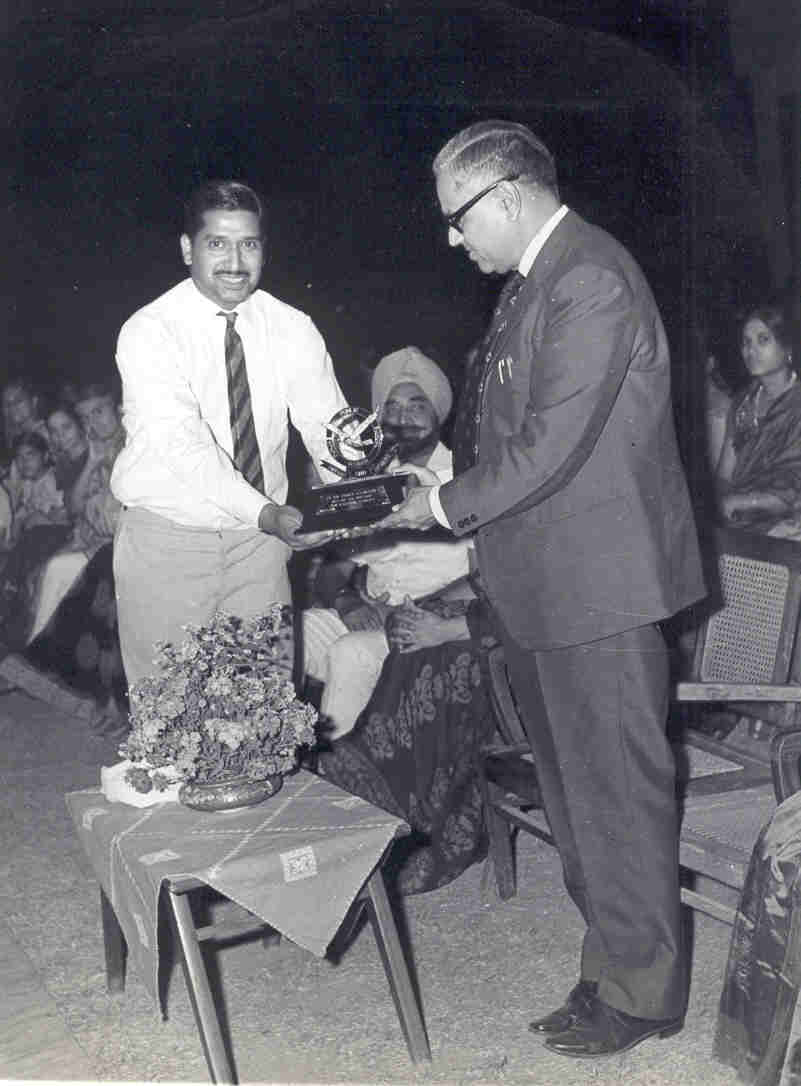 A memento of the School Logo being given by Senior Master MR. YP Johri.
A memento of the School Logo being given by Senior Master MR. YP Johri.
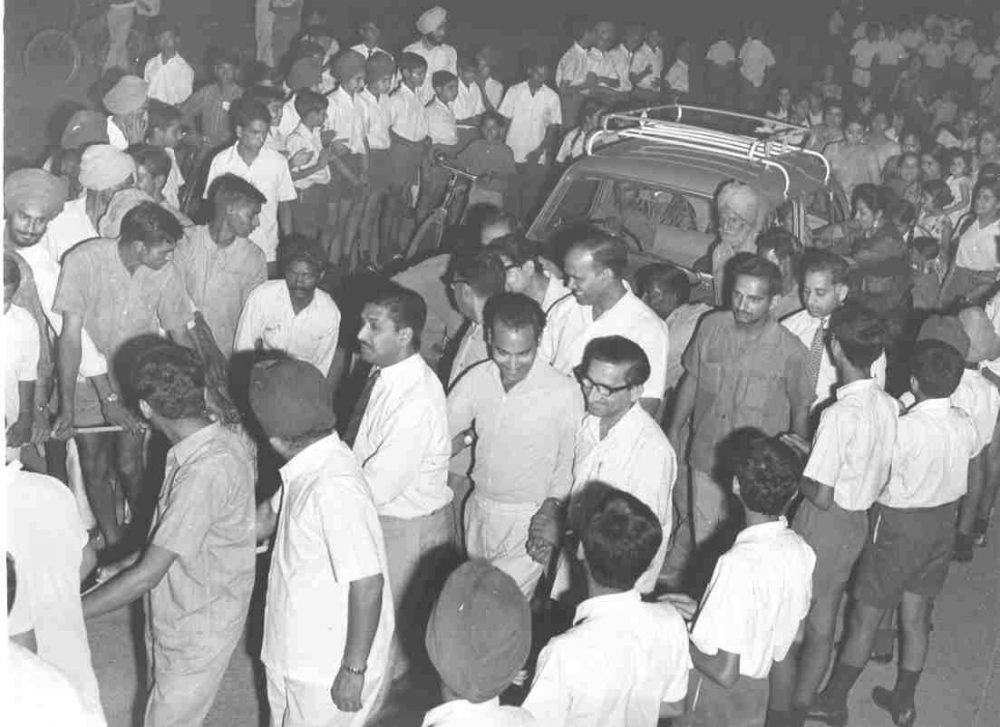 Before rolling the car out of the gates of the school. Mr YP Johri, OP Sharma and Mr. Onial students and staff can be seen surrounding the car of the popular headmaster. The ever faithful Balbir Singh, peon of Junior school can be seen just in front of the car on right
Before rolling the car out of the gates of the school. Mr YP Johri, OP Sharma and Mr. Onial students and staff can be seen surrounding the car of the popular headmaster. The ever faithful Balbir Singh, peon of Junior school can be seen just in front of the car on right
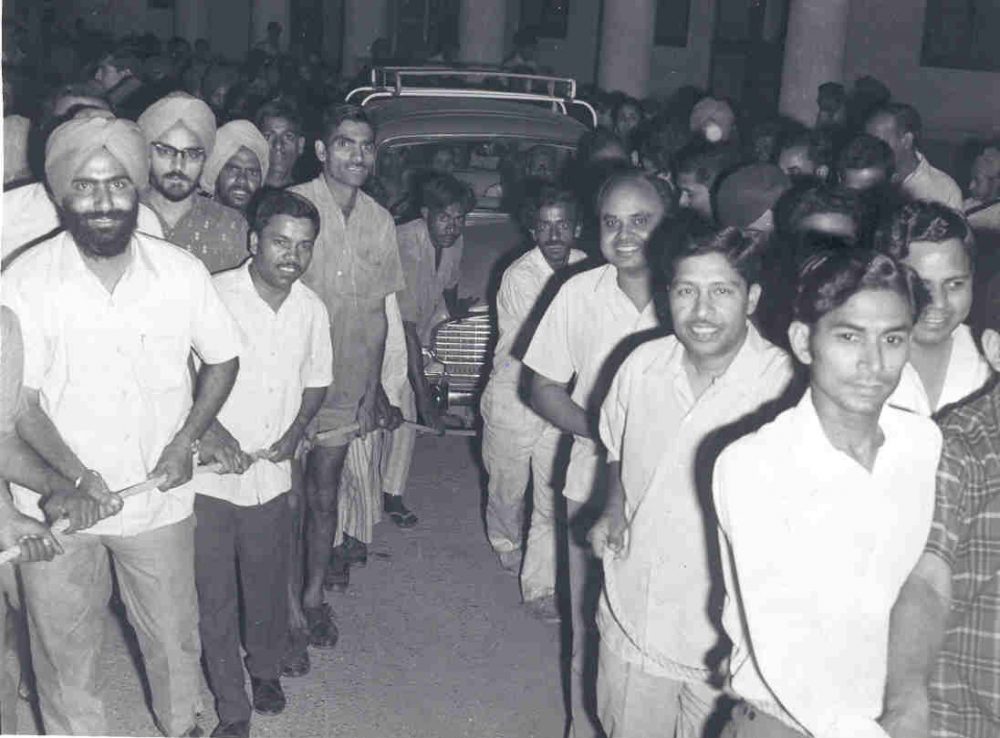 The final pull through gates of the PPS by staff and students of the School while leaving the school, before the car hitting the road. Mr. Katyal and Mr. Nigam are on the right holding one side of the rope.
The final pull through gates of the PPS by staff and students of the School while leaving the school, before the car hitting the road. Mr. Katyal and Mr. Nigam are on the right holding one side of the rope.
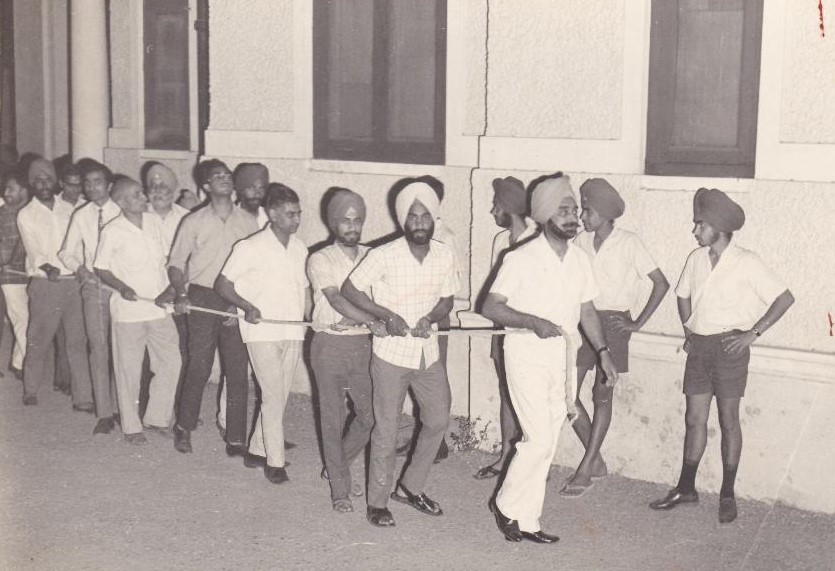 Mr GS Punia, the bursar leads the way.
Mr GS Punia, the bursar leads the way.
__________________________________________________________________________________________________________________________________________________________
What others wrote on his departure
(These excerpts are taken from the chronicle issues of 1972.)
The Editorial of the June,1972, issue of the Chronicle.
( I asked Mr BS Bhatnagar the English Teacher, if he had written this editorial in the Chronicle, as he was in charge of it then. Below is his reply:
“SATSRIAKAL, dear Dr Jashanjot. Yes, I did, after he got the Padma Award or just before he was leaving PPS for The Daly College? Indore. I don’t remember, though. I do remember, however, that he gently reprimanded me for it as he did not like to be praised I’m his own school’s newsletter or otherwise.)
Below is a tribute to Mr. JK Kate published in the Chronicle issue of Novemeber,1972. It is written by Mr Allen Colliers, a Canadian University services overseas volunteer who served in the School during 1969-70. (In April,1969 Allan Collier, a graduate for Manitoba, Canada joined as a volunteer at PPS. He was keen sportsman and played basketball, Ice Hockey, Soccer and Rugby- from 1969 Chronicle).
Following messages appeared in the Chronicle on the departure of the Great Headmaster from The Punjab Public School, Nabha. These were by the former British Council Teacher ,Head of English, Mr. John Mallon (Edinburgh, Scotland), Deepak Manchanda (R-131,1966) and Gurinder Bir Singh Chhachhi (S-76,1976):-
_______________________________________________________________________________________________________________________________________________________________________
The ONA and Mr. J.K. Kate
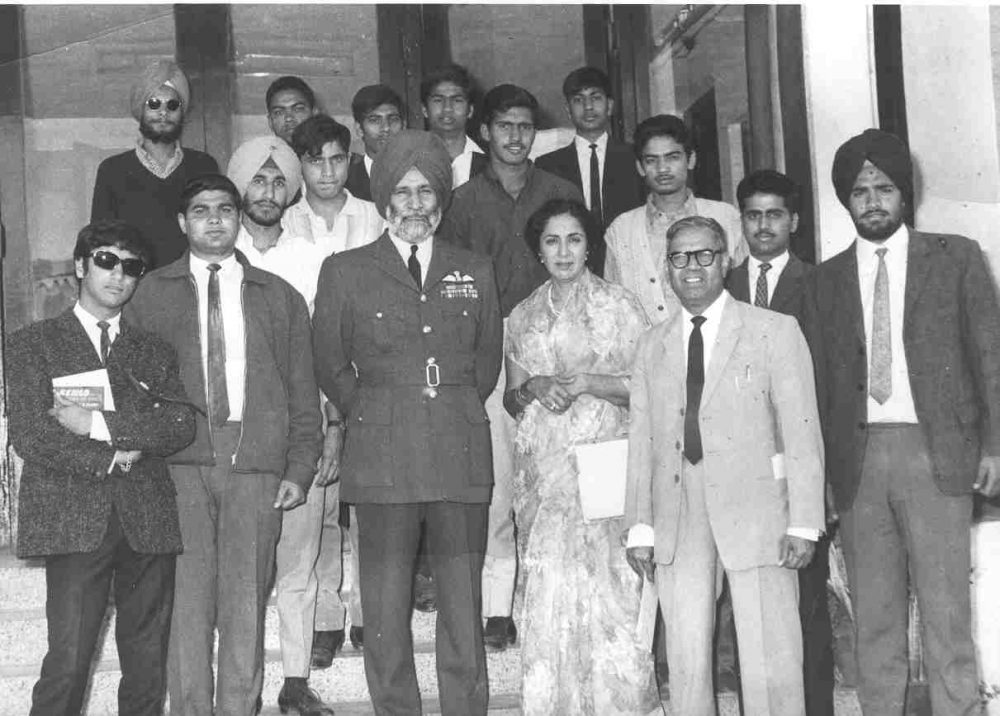
Mr JK Kate with Air Chief Marshal Arjan Singh and wife with some Old Nabhaites at Founders’ Day, 1969.
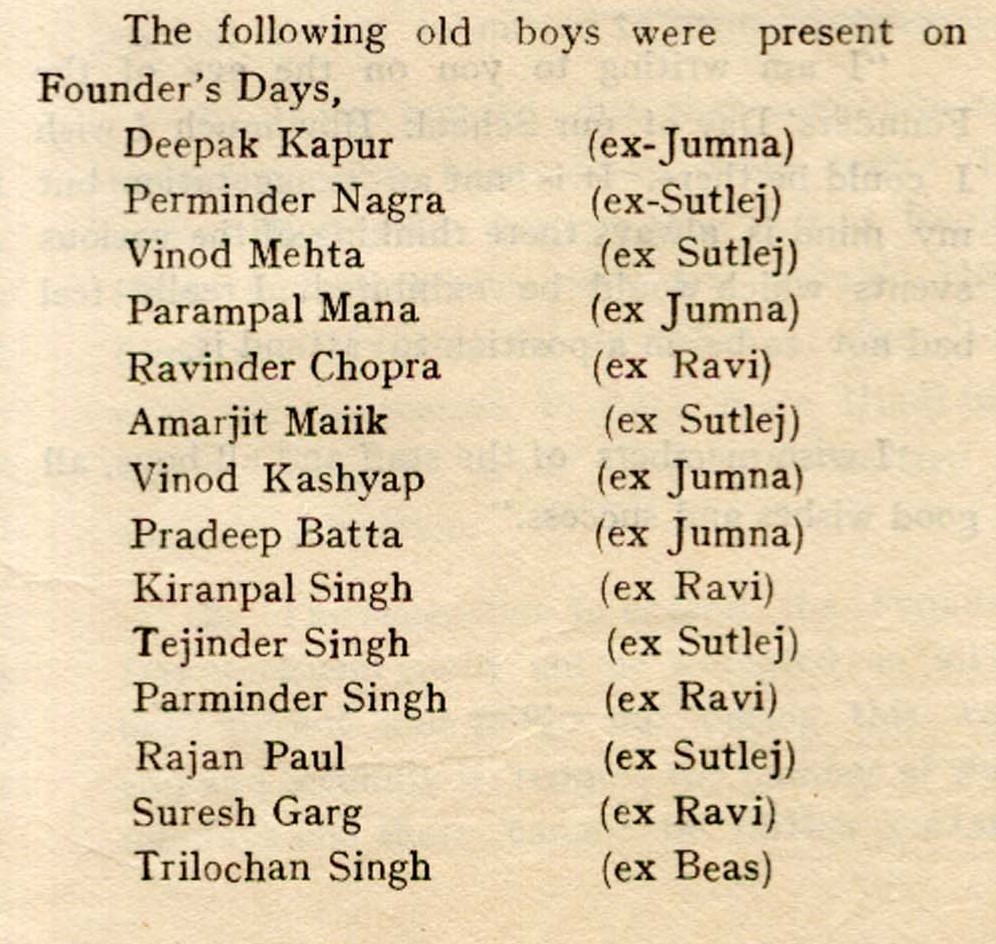
Mr JK Kate had a flair for doing everything that was required in a Public School. He got the ONA started in his time, on 14th March, 1965 as the first batches passed out (1963 &1964). Mr. OP Bhatnagar was appointed Staff Secretary for it. The words Nabhaite and The Old Nabhaites Association took root from that day. Below are the minutes of the first ever ONA meeting held.
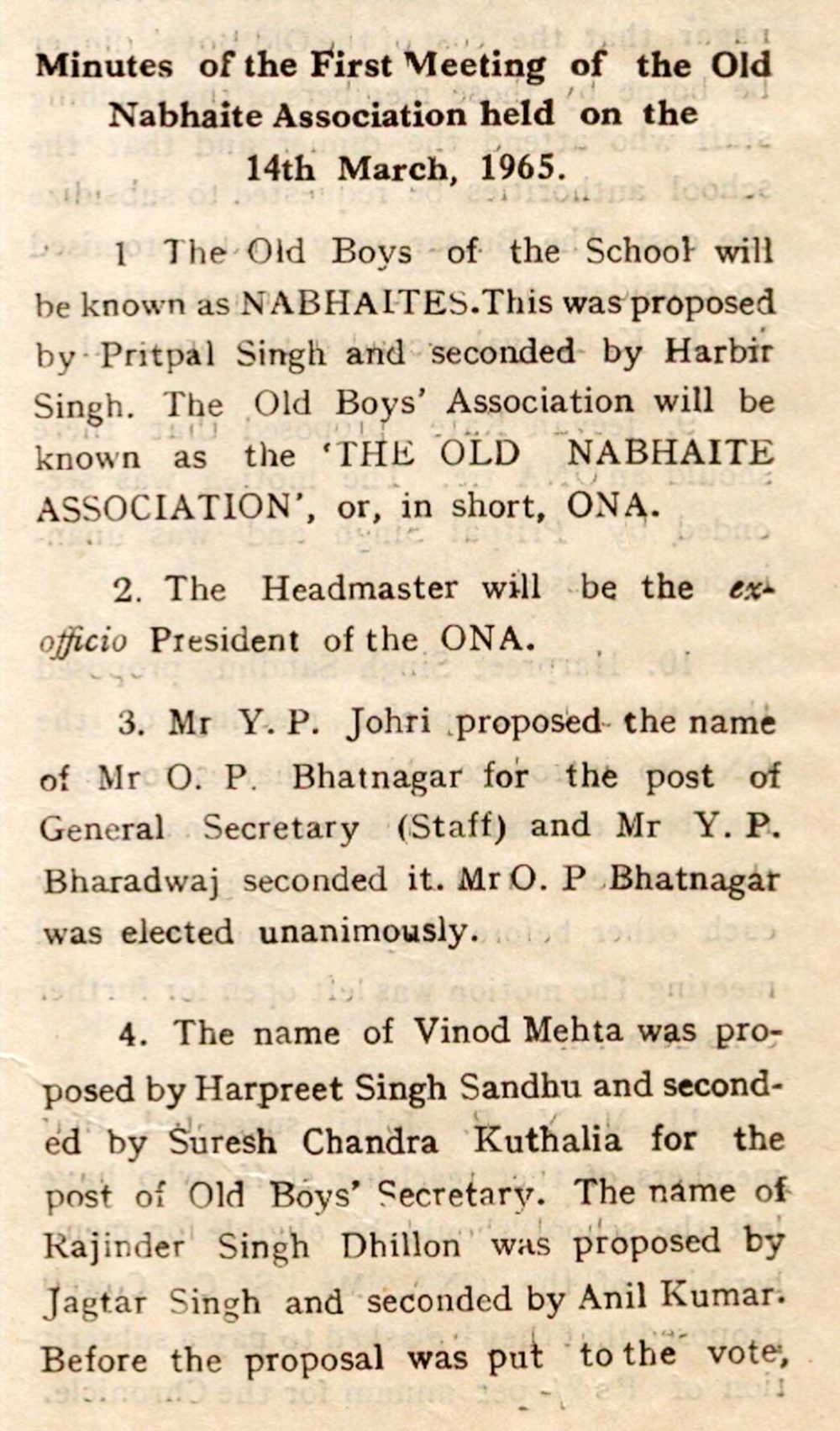
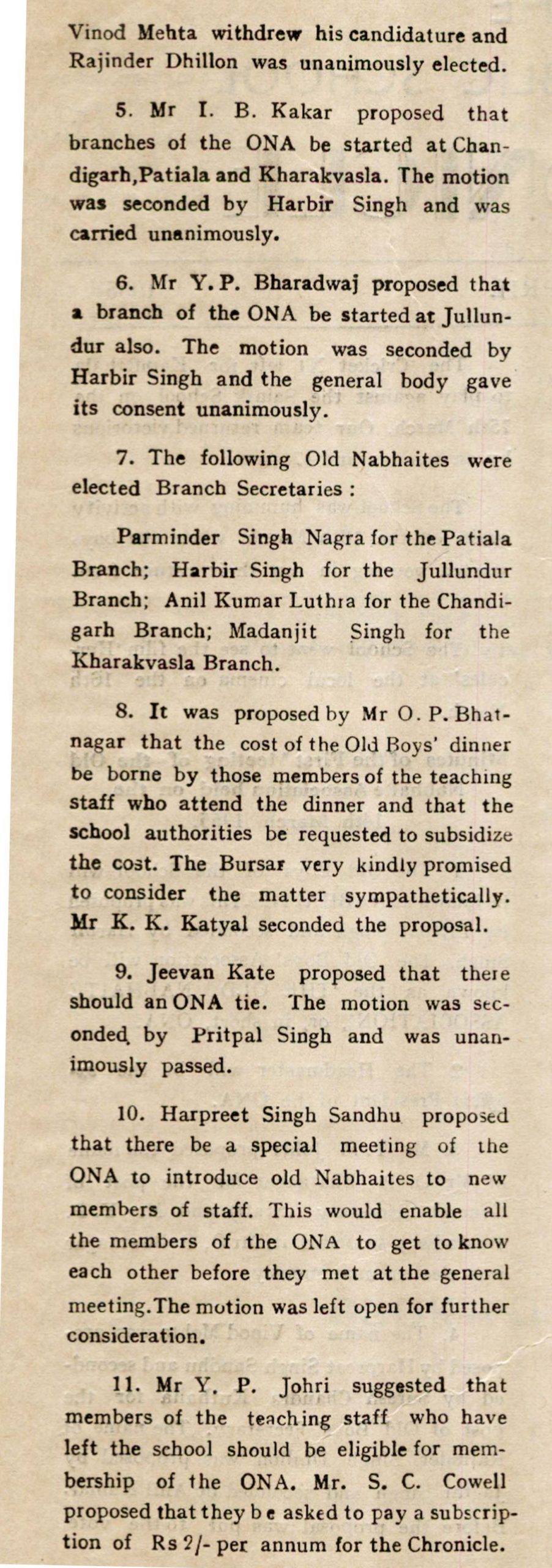
It was signed by Mr. OP Bhatnagar the first Secretary of ONA.
In 1980s when Mr Kate developed a bad Heart condition, namely, triple vessel disease. He was advised to get the bye-pass surgery done in the USA as India had no medical center which was treating such cases. The honest headmaster, from humble background, had no savings from his long years of service to the cause of education to afford this medical trip. Students and staff from the schools where he had served, chipped in to encouraged him to take the trip to USA. The Old Nabhaites who loved him so much collected funds to send him to USA for Surgery. On behalf of ONA, I remember mailing to Kate family, lists of addresses of Old Nabhaites (a hundred at a time) copied from the registers of the Bursar’s office (Mr. GS Punia), at which they used to send School bills every term.
Apart from ONA itself collecting cheques from and making appeals to Old Nabhiates , Mrs Nirmala Kate wrote letters of appeal to the parents of the old Nabhaites on the addresses provided by ONA. The response was huge. I remember when a widowed mother of Old Nabhaite, Harpreet Singh Takkar (S-224), who himself had died in an accident sent her Rs 200/- cheque in those days. She wrote to Mrs. Nirmala Kate , “My son is no more , but I know he would have loved to contribute to Mr. Kate’s cause as he loved his school and the Headmaster, so much.” Mrs. Kate sent back the cheque saying I cannot come to accept this from a widow, who has lost her son. The School under then Headmaster, Gp. Capt. AJS Grewal too contributed with collections from students, staff and school itself. There also came a time when Mrs. Kate returned a cheque, saying they have met their target and they don’t need any more funds.
Thus the great Headmaster who had gathered a wealth of students and colleagues during his journey as an educationist, was able to undergo surgery in 1982.
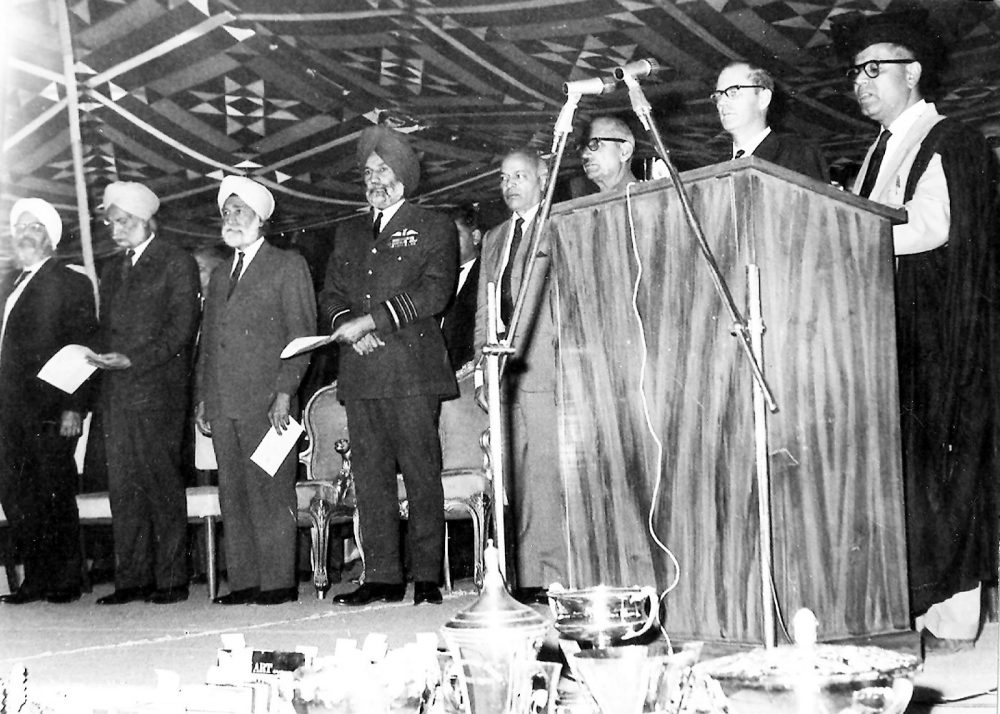
Founders’ Day 1968, with Air Chief Marshall Arjan Singh as Chief guest in the centre, on his right are Justice Gurnam Singh, CM of Punjab and Col S. Naunihal Singh Mann and other Board members on extreme right is Mr Kate at the podium.
After his return, he wrote a long letter to the Old Boys and the PPS which was published in the chronicle and the “ONA NEWS BULLETIN” the then name of “The Eagle”. Below is a scanned copy of it. It mentions how different people came around to help him in his hour of need. Being an honest man, he had no financial reserves when he retired. All he had was a wealth of his ex-students and their love.
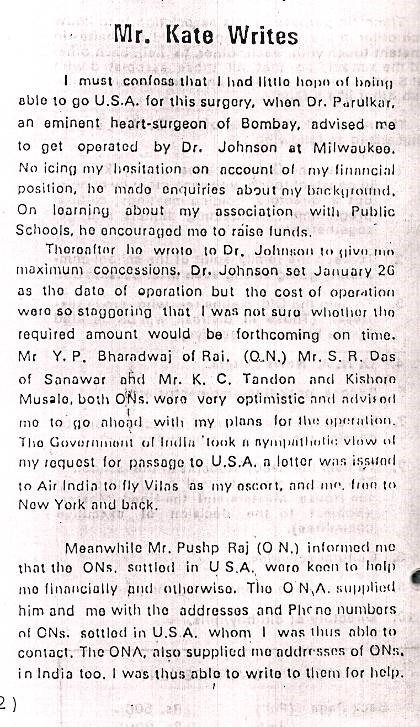
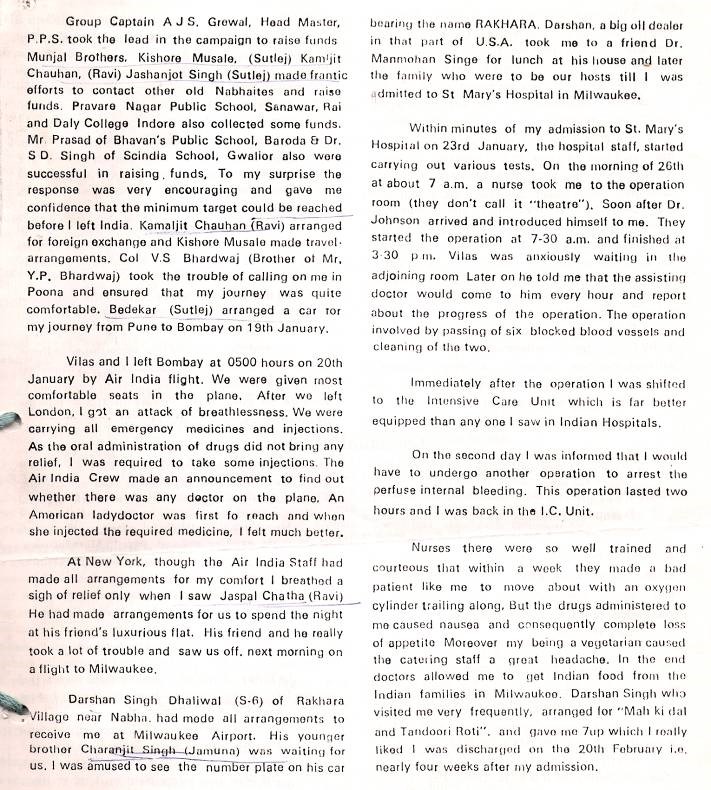
Finally a letter when he returned to India:
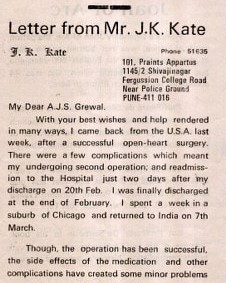
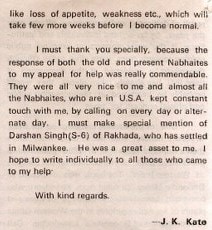
During this period, when ONA was formally formed by Old Nabhaites led by Dr. Jashanjot (S-52,1967) , he wrote a personal letter to Dr Jashanjot advising him on how to run the ONA and how to manage its finances etc. He was very happy to know of the progress being made by The Old Nabhaites Association.
(On a personal note, I would like ONA to be a selfless association giving back to alma mater , the PPS community and Society at large. This is what, Mr JK Kate would have wished.- Dr Jashanjot)
Below are copies of his letter (dated 14-10-84) inside and outside. Note how he has used every inch of space even on the sides. He was hoping to be in Nabha at the Silver Jubilee in 1985.
He talks about ONA finances and advises about Life Membership and fixed deposits and Income Tax exemption etc to keep ONA viable. He has even given calculations on how Rs 300 LM fee will bring Rs 36-45 annual interest and only 50% of this should be used for ONA activities.
Following this advice, in spite of the fact that ONA has passed through several hands, not a single penny of Life Membership has been used .Only part of the interest is used. This has helped ONA build some semblance of a corpus.
Inside page:-
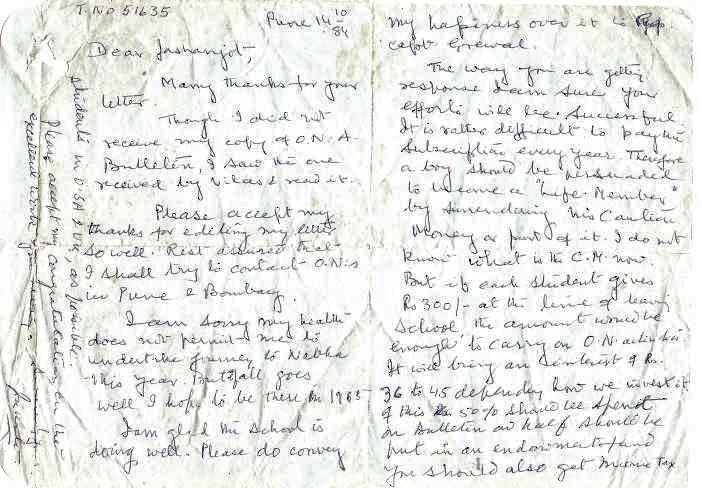
And outside
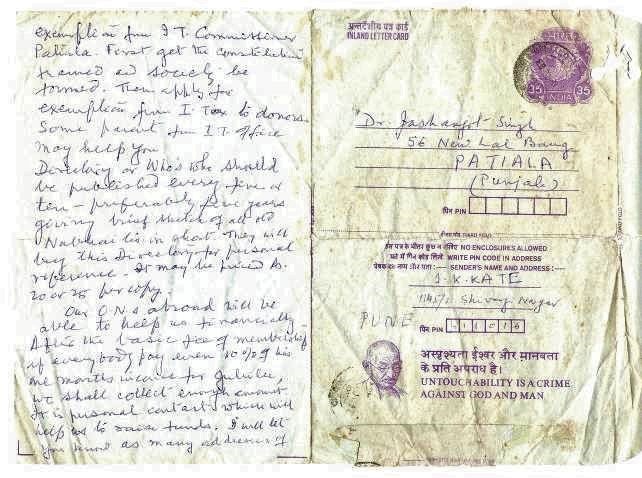
Below is sadly, a half-torn letter (that is left, due to tear along old fold) addressed to Dr Jashanjot by Vilas Kate (S-96,1970) son of Mr JK Kate on 29th Sept, 1990 after “The Great Headmaster of The Punjab Public School, Nabha” passed away.
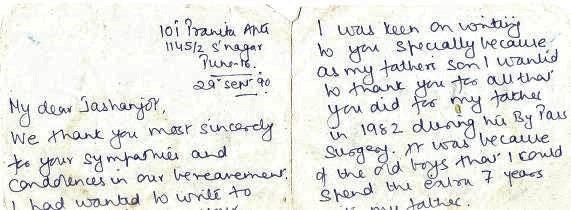
The second half of this letter expresses his gratitude to all Old Boys for helping him spend seven extra years with his father.
If one were to write down all the anecdotes recited by his students and teachers associated with his brilliance as a thinker, leader, educationist, economist, administrator, planner, considerate, visionary, humane and all positive features one can think of, it could fill not a book but an encyclopaedia.
Dr Jashanjot Singh (S-52,1967)
______________________________________________________________________________________________________________________________________________________________________
(This important Article was written by Mr. JK Kate at the time of Silver Jubilee of the School in 1985 and published in the Souvenir that was brought out. It can be taken as hard evidence of the history of the first twelve years of the School from the horse’s mouth as the English phrase goes No pictures have been added to keep the flow of the article.)
PRIDE OF PUNJAB
J.K. Kate
The then British Government of India contributed to the Post War Services Reconstruction Fund Rs. two per month per soldier/seaman/ airman who served the Defence Services, during the Second World War. As quite a large number of Punjabis joined the Army, Navy and Air Force, a huge amount was accumulated in the Punjab Post-war Services Reconstruction Fund. It was laid down by the Government that the amount of the Fund should be fully utilised to rehabilitate ex-servicemen, within twenty years from the end of the war, i.e. by 1965. It was presumed that all ex-servicemen would have been rehabilitated by that time.
The administration of the Fund was entrusted to the committee headed by the Governor of the state and it included the Chief Minister, Army and Area Commanders, Chief Secretary and a few other prominent persons interested in the welfare of ex-servicemen.
The P.W.S.R. Committee had a balance of nearly Rs. Two crores unutilised by 1959, though most of the ex-servicemen were rehabilitated by then. Therefore, Mr. Pratap Singh Kairon, the dynamic Chief Minister of Punjab, suggested to the committee to start a school on the lines of one at Dehra-Dun, (perhaps he meant R.I.M.C.). The proposal was approved and Rs. 39 lakhs, were earmarked for this project. A sub-committee under the Chairmanship of Lt. General Kalwant Singh was appointed. Col. S. Naunihal Singh, who has been a member of the Board of Governors, for the last 25 years, was also a member of that Committee.
The Chief Minister had promised to give land and buildings for the School, free of cost, anywhere in Punjab -The sub-Committee decided to locate the School at Nabha as palatial buildings like, the Secretariat and the Guest House were available along with open land surrounding them. The Chief Minister also promised to give Rs. 10 Lakhs for equipping the school.
I joined as Headmaster of the school on 30th December 1959, by reporting to the Secretary to the Governor. The same evening, I rushed to Nabha to take the charge of the buildings.
After doing so, I returned to Snawar and started the work of framing rules and regulations for the management of the school, preparing the prospectus, advertising posts etc., The Managing Committee was very keen to start the school as early as possible. But there was nothing except two vacant buildings and those too, were in a most untidy condition. I borrowed a chair from S.D.O. and started my office in the porch of the Guest House.
As the school was a baby of the P. W. S. R. F. Committee and its aim was to prepare boys mainly for entry into the National Defence Academy, the school was named as the Sainik School, Nabha. Later on Mr. Krishna Menon, the then Defence Minister who heard the news of the opening of the Sainik School in Punjab, called a meeting of Chief Ministers of all the States and persuaded them to start similar schools in their states. He offered to send three officers from the services to hold the post of Principal, Headmaster and Registrar in each school. The Principal was to be of the rank of Lieutenant Colonel and the other two of Major’s rank. All the Chief Ministers accepted his proposal and a chain of Sainik Schools was started in India, exactly on the pattern of Sainik School at Nabha. During his visit to Chandigarh, Shri Krishna Menon, however, insisted on either changing the name of Sainik School at Nabha or changing the civilian Headmaster like me and appointing a service officer of Lt. Colonel’s rank as its Principal.
Pratap Singh Kairon suggested that not only would he change the name of the School but would also offer Shri Krishna Menon land, buildings and scholarships not for one but two Sainik Schools in Punjab. That is why we had two Sainik Schools in undivided Punjab, one at Kapurthala and the other at Kunjpura (Karnal).
He further told me that though the name of my school was being changed, from Sainik School to Punjab Public School he would continue giving all possible help and support to Nabha school, and I am glad to mention that he kept his promise.
As the Chain of new Sainik Schools was started all over India, the duration of the course, the academic syllabus, the scholarship-scheme prevalent at Nabha were adopted by these Sainik Schools. Quite a few principal-designates from the services were advised to visit P.P.S. and study it’s working. Thus. Nabha School ceased to be a Sainik School in name but it remained as a pioneer in this field.
This change in name from Sainik School to Punjab Public School, later on proved to be a boon in disguise. If all the boys come from economically, socially and educationally backward families, however competent the staff may be, it becomes rather difficult to change the rustic boys into a refined group.
However, if you have half the lot of boys from civilised homes they are a desirable influence on rural boys as far as appearance, dress, manners, code of conduct, values in life etc are concerned. The influence of rural boys who are generally simple, honest, sincere, loyal, willing-workers and not at all conscious of status is equally good on urban or rich boys.
Those parents like doctors, engineers, industrialists, business executives who did not want their sons to join Defence Services, preferred P.P.S. to Sainik Schools as it was run on Public-School lines without a tough undesirable regimentation. Even high ranking Defence Service officers who wanted their sons to follow in their footsteps as far as career was concerned, sent their Children to P.P.S. in preference to Sainik School or other Public Schools as we produced N.D.A. results as good as any other School.
This ultimately resulted in P.P.S. having an ideal mixture of rich and poor boys, and rural and urban crowd. Sainik Schools were patronised only by scholarship-seekers and public schools remained citadels of affluent Society. Sainik Schools had just a sprinkling of Govt. of India Scholars. I think in the present Socialistic trend in the country P.P.S. is an ideal School where there is no place for class consciousness.
It was initially intended that the strength of the School in the first instance, would be restricted to two hundred; out of these 120 seats would be reserved for the Children of ex-servicemen as well as those of serving personnel of the Indian Army, Navy, and Air Force, belonging to Punjab.
As the School was quite new, I was not sure of the response we would get. Therefore, I started registering boys for classes V, VI, and VII only thinking that we would make a beginning with 75 to 80 students including staff-children. At the same time, I was very keen to make the school a viable unit as early as possible. The strength of the school was the most important factor in this respect. Therefore, we further decided to admit all those who sought admission to the school including those rejected by other Public Schools. Thus, strength on the opening day reached 120. In these boys there were some who had completed 12 or 13 years but were willing to join our highest class i.e. VII. In that case they would have been overage for N.D.A. Therefore, we decided to start class VIII with nearly 12 boys, though their English was far below the expected standard. But now, I don’t repent my decision. As these boys were very weak, the staff had to work very hard. This pattern of hard work set by the senior staff was automatically followed in the years to come by teachers who joined later. The spirit of competition among this staff, for producing better results reached such a stage that it was impossible to give extra time for coaching as demanded by the subject teachers. I always found masters taking extra classes, coaching weak students late in the evening or on Sundays and other holidays without any expectation save good results.
The P.W.S.R. Fund Committee decided to utilise only the interest on Rs. 39 lakhs earmarked for this project. This amount yielded an interest of Rs. 1,20,000 yearly. This meant we could give maximum of eighty Scholarships at the rate of Rs. 1500/- per year per student. Later on Govt. of Punjab sanctioned Scholarships for civilians’ children also, provided they signed a bond to join N.D.A., if selected.
I remember two cases of boys who got Punjab Govt. Scholarships, but did not want to join N.D.A. One deliberately failed in the written test and the other did so badly in the interview, that the Chairman of the Selection Board wrote me a letter about the boy’s attempt to give wrong and unexpected answers even to simple questions. I spoke to both the boys saying they were cheating the Govt. in doing so and it was not expected of them. Both of them persuaded their parents to refund the amount of Scholarship they received!
In those days most of the reputed Public Schools and elite parents preferred I. S. C. (popularly known as Senior Cambridge) Examination to H.S.C. of State Boards. However, I.S.C. demanded a very high standard of English. We therefore decided to send only those boys, who attained high proficiency in English to I.S.C. Even these boys who took I.S.C. in December, were made to appear for H.S.C. in the following March, with the rest of the boys. This was done with an intention that if a boy failed in I.S.C. in December, with a further study of three more months and an easier English syllabus, he would pass H.S.C. following March. Later on we sought affiliation to Central Board but they insisted that we take either I.S.C. or C.B.S.E. Examination and not both. Meanwhile we felt that the boys taking H.S.C. Examination developed inferiority complex. Therefore, we gave up the idea of preparing weak boys for H.SC. or C.B.S.C. Examinations and the whole school was geared to I.S.C. Examination.
In those days, approximately four scholarships were awarded every year to Indian students to join British Public Schools, and prepare for, A Level in U.K. These scholarships went mainly to boys from Doon, Mayo, Sanawar and Lovedale. I decided to recommend Nabha boys for this scholarship and if I am not wrong Pritinder Singh Lamba was the First Nabhaite to win this scholarship, though he could not avail of it. Later Rajiv Gupta and Ashish Dey were selected for this scholarship. Even in N.D.A. entrance examinations we started off with a bang. Out of the first batch of nine boys who appeared for the written test, eight qualified for the interview and five finally joined the N.D.A. This strong flow of students to N.D.A. continued year after year and if I am not wrong nearly 200 boys from Nabha were selected for commissioned ranks by 1972. This does not mean that boys interested in other careers and professions were neglected at Nabha. Many of our boys have become efficient doctors, engineers, business executives and administrators.
To start with, we had just two buildings the Secretariat and the Guest House. As the Secretariat was bigger than the Guest House, I decided to locate the school there and use the Guest House as staff quarters.
The front of the Secretariat was used for accommodating classrooms and the offices. The right wing, which is facing the Science Block, accommodated Jamuna House; the Left Wing was allotted to Ravi House. Beas and Sutlej occupied the back of the Secretariat. The circular room behind the main hall was used as the dining hall when the school started, functioning on 14th April 1960.
The first lot of children arrived on 6th April 1960 and the last on 10th. Lt. General Kalwant Singh did an informal opening of the school on 14th April. After the impressive morning assembly in the teak-panelled hall, the regular classes started. In the evening, an English one-act play was produced by Mr. Cowell though he had hardly five or six days to prepare for it.
As we started the school, rather late we decided to cut short summer vacation and prolonged the first term upto the end of June. Because of the reduction in term time from four to two and half months, we reduced fees from Rs. 750- to Rs. 500/- for that term only.
The day the children arrived in August for the second term, it rained so heavily that the whole of the Secretariat was flooded and the water level touched the plinth. I remember a Colonel from Alwar who came to Nabha to get his son admitted could not enter the campus as water was waist deep. He left his son on the road and shouted that he was going back. By that time, we had decided to shift the whole school to the Guest House, which was on a higher level. When we were shifting furniture, beddings etc, through waist-deep water, I saw a radio set floating on water. It came from one of the broken windows of the school stores which then was located in the present M.I. Room. The strength of the school was then nearly 120. All the boys, staff-members and their families were accommodated in the Guest House. All four wings of the ground floor were used for class-rooms and staff quarters. The four wings on the first floor including my residence were allotted to four houses. We went through that ordeal quite cheerfully and carried on the school routine as usual for more than a month or so.
As the Secretariat campus was waterlogged, the water level would not go down and we had to use pumps to throw our water from the campus. This temporary experiment of using Guest House, for class-rooms and dormitories, gave me the idea that if our strength increased, we could divide the school into two sections junior (Classes V and VI and Senior (Classes VII onwards) and shift the junior school to the Guest House.
The pressure for admission was increasing, and we soon realised that even these two buildings were inadequate. 1, therefore, thought of taking over the old Secretariat building also. The Government officers who were staying in the Guest House were shifted to the old Secretariat by now. One of them who scented this move remarked that “this was not a school but, Cancer” which would spread all over Nabha.
As usual, Mr. Pratap Singh Kairon came to our help and ordered the construction of a few bungalows behind the old Secretariat for Government officers and handing over the old secretariat to us. With the increase in the strength, the number of staff also increased. Therefore, old secretariat was converted into staff quarters, by making some additions and alterations. This solved, though temporarily, the problem of accommodation.
When the strength crossed 200, we realised that we did not have enough playgrounds. Therefore, we approached Mr. Kairon again suggesting he should give us nearly 100 acres of forest land opposite the Guest House. The Forest Department hesitated to surrender the whole patch of land. However, with the intervention of the Chief Minister, we secured approximately 65 acres of land along with four fishing ponds. New Secretariat was on a plot of land measuring 16 acres and the Guest House on 11 Acres. Thus, we now had more than 90 acres. The portion of the land adjoining the road and what they call “Horlicks Canal” was earmarked for the staff colony. At that time the wastewater from Horlicks was not put into that canal or it was so small in quantity that it did not stink at all. Having read the Potpourri in the recent issue of P.P.S. Chronicle, I realise how the staff at present living there must be cursing me-, but my main idea was that the staff colony should be between junior and Senior School.
Lt. Gen. Kalwant Singh was very keen on the construction of a swimming pool. The question arose where to locate it. As juniors also needed swimming and the playgrounds were already in front of the Guest House, we decided to locate it in the Guest House compound. With construction of the swimming pool, staff colony, Dining Hall, Hospital, Toilet-block, for the old secretariat which was to be used for accommodating Middle Houses, we had finished Rs. 10 lakhs given to us by the Punjab Government. We were still short of accommodation as we had come to realise that strength of the School should be raised to 500 to make it an economic unit.
The Maharaja of Nabha was keen to sell his palace Hira Mahal. As it stood between the junior and Senior schools, I thought if we purchased it, it would give us a continuous piece of land, and bring the junior and Senior schools together. I approached the then Chairman of the Board, Shree Dharma Vira with the suggestion that the Government should buy Hira-Mahal and give it to the school. He immediately visited the palace with Mr. Gyan Singh Kahlon who was then Chief Secretary. Mr.Dharma Vira felt that by purchasing the palace, we would get mainly land as the buildings were old dilapidated and not ideally suitable for the school.
The school already had more than 90 acres of land by then and needed well equipped Houses (Hostels) in the vicinity of the Senior school.I
Therefore, we thought of acquiring Sham Bagh, which had a government nursery, and we succeeded in getting that too.
It was estimated that the construction of four Houses for 75 boys each, would cost approximately Rupees Four Lakhs, if I remember it correctly, but we had no funds. Somehow with the influence of the Governor Shri DharmaVira, we managed to get that much amount as loan from the Punjab Government, I was hesitant to take this amount as loan because I found it difficult to repay the loan with limited resources of fees only. However, Shri Dharma Vira advised me to go ahead and accept the loan and start the construction of buildings. I remember him saying, “In case you are unable to pay all the installments, the Government would not take away the buildings and would be compelled to write off the amount”. When we completed this project Dharma Vira was the Governor of Karnataka and Mr. Pavate who hailed from Karnataka was the Governor of Punjab. As Mr. Dharma Vira’s contribution was tremendous in this project we decided to name it as, “Dharma Vira Park”.
Initially, we were staging plays on an improvised stage in the hall of the main building, but it had no proper Green Room and other facilities. So, we decided to extend the dining hall by adding a stage and property room. Later, we found that the noise in the pantry proved a great nuisance when the stage was being used. Therefore, we decided to have an Auditorium. Again, the questions of funds arose. As we were already paying loan installments, we approached the Government for grant of rupees three lakhs, if I am not wrong. At that time Sardar Balwant Singh was the Finance Minister. When I explained to him our financial position he took a more lenient view than the Finance Secretary and agreed to give half the amount as Grant and the remaining, half as loan. This was done when Mr. Pavate was at the helm of affairs as Governor of Punjab. We, therefore, named this auditorium after him.
On one occasion Mr. Bagla, the then Secretary to the Governor, visited the school. When we were walking through the corridors of the Senior School, he noticed that the floor had sunk in many places. When he advised me to get it repaired, I regretted my inability to do so due to paucity of funds. He immediately suggested that I approach the P.W.R.S. Fund for some grant. I said to him, If you are prepared to give us financial help for repairing floor, please give us bigger grant to enable us to have a Science Block with well-equipped laboratories, instead of repaired floor.” We received I think a couple of lakhs of rupees for this project also. This was the last building planned by me.
It would be worthwhile to mention here, that all our building plans except the Auditorium were prepared by our architects, M/s. Warerkar and Associates at a lower rate than usual. Our labour contractor Shri Pyarelal was almost illiterate but had great insight in construction work, He could foresee the problems and difficulties in executing the plans and would also be able to suggest solutions which some times engineers were unable to find, That was, why we carried out all the new construction works departmentally. Mr. Bansal our Estate Officer works hard by looking after both maintenance of old and construction of new buildings.
All our academic progress including I.S.C. and N.D.A. results was due to the competent and hard-working staff we had right from the beginning. Miss Malkani in the junior school and Mr. Cowell in the Senior school were great assets, not only to the English faculty but also to the whole school in general. They shouldered many responsibilities outside the class-rooms. Both of them were strict disciplinarians with an eye for minutest details.
As most of the students admitted to the school, had never heard a word of English, we had an uphill task of teaching them through English. We, therefore, decided to concentrate on English during the first two years of their stay at the school. As a first step in this direction, only those teachers who had an excellent command over English, irrespective of the subjects they taught, were selected. Even matrons, nursing sister, and other staff were selected on this basis, apart from the basic qualifications for the posts on which they were appointed. The English faculty was further strengthened by the appointment of Mr. Vodden and Mr. Mallon whose services were made available to us by the British Council.
In addition to this the Council helped us by posting one or more V.S.Os at P.P.S. every year. They were young boys and girls who had completed their, A levels” and had to wait for a year or two before they got admission to Universities in U.K. During this intervening period they served in Indian Schools. We were also fortunate in getting similar response from the American Peace Corps and Canadian Volunteers. Most of these young teachers worked in the junior School and shouldered many responsibilities. The credit for starting the school poultry goes to Roger Mile, the first V.S.O. Richard Pine took charge of the Swimming Pool. David Goldberg organised the Library and looked after the pool after Richard’s departure. He was very strict in enforcing the rules framed by him for the users of swimming pool. Lowell Edward set the textbooks store in order and made the whole system of lending textbooks to the boys more methodical.
Apart from a well-staffed English Faculty we had equally competent teachers like Mr. Johri, Mr. Dighe, Mr. Nijjar, Mr. Bhalla and Mr. Ram Singh for Mathematics. After the departure of Englishmen from the Faculty of English, it was looked after admirably well by Mr. Oberoi, Mr. Sibal, Mr. Bhatnagar, Mr. Chandola, Mr. Onial and Mr. Bhati. Dr. Surjit Singh and Mr. Bhave gave a good account of themselves as far as Chemistry was concerned. Mr. Bhave was so good at teaching Chemistry that we not only had a large number of distinctions in that subject but most of the boys scored higher marks in Chemistry than in any other subject. Mr. Kakkar worked very hard to improve upon Physics results. Mr, Katyal too produced excellent results. Mr. Mathu, though very old-fashioned, taught both Commerce and Geography to Arts students all of whom were not very bright. His ISC results of both these subjects were very impressive. When I compared our ISC results with those of reputed public schools like Doon, Sanawar, Mayo and Lovedale, I found that our boys did better in Mathematics and Science subjects than boys from these schools, We were beaten in English Language and Literature but this was understandable taking into account the social and economic background of our boys.
I am also happy to learn that P.P.S. results in English have also improved considerably over the years. The competence of the P.P.S, Staff can be proved by one more fact that as many as fourteen teachers were selected for Bursaries in U.K. and Exchange Programme in U.S.A. within a span of first ten years.
There was hardly any year when somebody from the staff did not go either to U.K. or the U.S.A. for further training. One year when U.S.A. offered twenty seats to the whole of India under its Exchange Programme, our teachers bagged four seats.
Therefore, it was a statement of fact when Mr. K. I. Thomas Ex-Headmaster of Lovedale remarked during one of his visits to Nabha that the P.P.S. had the best staff of all public schools in India. If, I am not wrong nearly fifteen teachers who joined the P.P.S. in the early sixties are now Principals or Vice Principals of reputed schools run on public school lines all over India.
The school did well not only in academics but in games and other creative and cultural activities also. With the acquisition of forestland and Sham Bag we had spacious and enough playgrounds to enable the whole school to play games simultaneously.
The appointment of two Ranji Trophy players, Mr. Y. P. Bhardwaj and Mr. M. S. Bhatnagar as teachers of History and Biology respectively solved our problem of coaching in cricket. Mr. M. N. Tankha who was our games-master, had an experience of coaching boys in athletics. He organised the Inter-house Athletic meet on a grand scale. Except in the first year when Mr. Cork of Horlicks Presided over the meet, we always had the service officers not below the rank of Brigadier to preside over this annual meet. We are proud that officers like Lt. General Sant Singh, Air Marshall, Malse, Admiral Kohli, Chief of the Naval staff and other distinguished highranking service officers presided over the Annual Meet which was held on the last day of term to attract parents to the school.
It would be proper to mention here that most of the cups and trophies for various events had come from highly placed army officers and army units. As we had sixty per cent of the seats reserved for the children of Ex-servicemen and serving defence personnel, these gifts strengthened the ties between the school and the defence services.
The contribution of Mr. H. Kumar and Mr. P.S. Gill in raising the standard of P. T. and Gymnastics was very commendable. Therefore P.T. display formed a popular part of Founders’ Day Celebrations.
With the impetus given to house plays, class plays and school-plays, our achievements in the field of dramatics and music were above average. Mr. Katyal’s production of, “Godan” a Hindi play, was praised by one and all.
Miss Manju Oberoi, daughter of our Senior Master, was a talented actress and director. She did produce some good English plays.
Art and craft exhibition formed invariable part of our Founders’ Day Programme. In this respect, I must acknowledge the grand performance of Mr. Khan, who introduced so many crafts and inspired boys to develop them as their hobbies. Mr. Khan our Art-Master who was educated at Shanti-Niketan, worked quietly to build up the department.
It was a school only for boys. Only four staff daughters were admitted to the school, two of them Indira (Dr. Surjit Singh’s daughter) and Meena Punia, left the school in the early stages. Therefore, while staging plays, the girls’ part was given to the boys; but as such boys were teased, very few came forward to take the girl’s part again, we therefore, decided to admit the girls as day-scholars. This solved our problem of finding girls with histrionic talent to some extent.
As far as administration was concerned, I must say we were very lucky in having bursars like Major U. M. Sharma and Mr. G. S. Punia, both of whom I found very honest, loyal and co-operative. With the appointment of Mr. Mela Singh our Accounts Section was well organised. While selecting our auditors, I recommended to the Board, the name of A. F. Ferguson as it was one of the top ranking and thoroughly reliable Audit firm. More over, they were auditors of other public schools like Doon, Mayo, Sanawar etc. Their audit reports year after year can be an evidence of how efficiently we managed our finances.
The school had an ideal Board of Governors right from its inception. The Governor of Punjab has been the ex-officio Chairman of the Board. The Chief Minister, Army and Area Commanders and Chief Secretary were ex-officio members. Lt. General Kalwant Singh and Colonel S. Naunihal Singh and Chaudhary Raghuvendra Singh were on the Board right from the beginning as they were associated with the P.W.S.R. Fund. All the Chairmen right from Mr. N.V. Gadgil and other Board members genuinely helped the school in solving all its problems of finances, buildings, land, etc. When the forest Department handed over the forest land opposite the Guest House to us, they cut all the trees leaving thousands of stumps all over the place and we found it an extremely difficult and costly proposition to dig out these stumps and level the land to make suitable playgrounds. When I mentioned this difficulty to the then Army Commander Lt. General Harbaksh Singh of Western Command, he promptly solved my problem by making it as one of the exercises for an Army unit. With army bulldozers and other equipment, they uprooted the stumps and levelled the whole area within a week.
After Lt. General Kalwant Singh’s death, Mrs. Kalwant Singh was nominated on the Board. She too was as keenly interested in the growth of the school as her husband. Col. S. Naunihal Singh who has the longest tenure of 25 years as a member of the Board, also was very helpful in tackling certain school problems, vis-a-vis other board members including the Chairman.
I must mention that the share of class IV Employees, in making the school what it is today, is not insignificant. Their selfless services (Ram Singh cook), Balbir Singh Chowkidar, Bir Singh and Santri Singh, Sweepers to mention a few) right from the inception of the school are praiseworthy.
It is difficult to mention all the events and personalities, which brought the school on the educational map of India within a span of seven or eight years. I, therefore, may be excused if the names of some persons or institutions which helped us in the building up of the school are not mentioned inadvertently in this short article.
On this occasion of Silver jubilee, when we look back, we are proud that P.P.S. is one of the best schools of India.
Mr. Alfred D’Souza who conducted an exhaustive study in his book “The Indian Public Schools” writes as follows:
“Among British Public Schools, the most famous are known as the “Seven”. These are Charter House, Eton, Harrow, Rugby, Shrewsbury, West Minster and Winchester. The masters of the schools in the sample were asked to rank the seven leading Indian Public Schools. According to 84 per cent of the masters (excluding Military schools) the following are the Indian equivalent of the British, Seven” Doon School, Mayo College, Modern School, Scindia, Lovedale, Sanawar and Punjab Public School. It should be noted that these schools are not listed here in an evaluative rank order.”
Compiled and written by Dr Jashanjot Singh Bhangu (S-52,1967)
